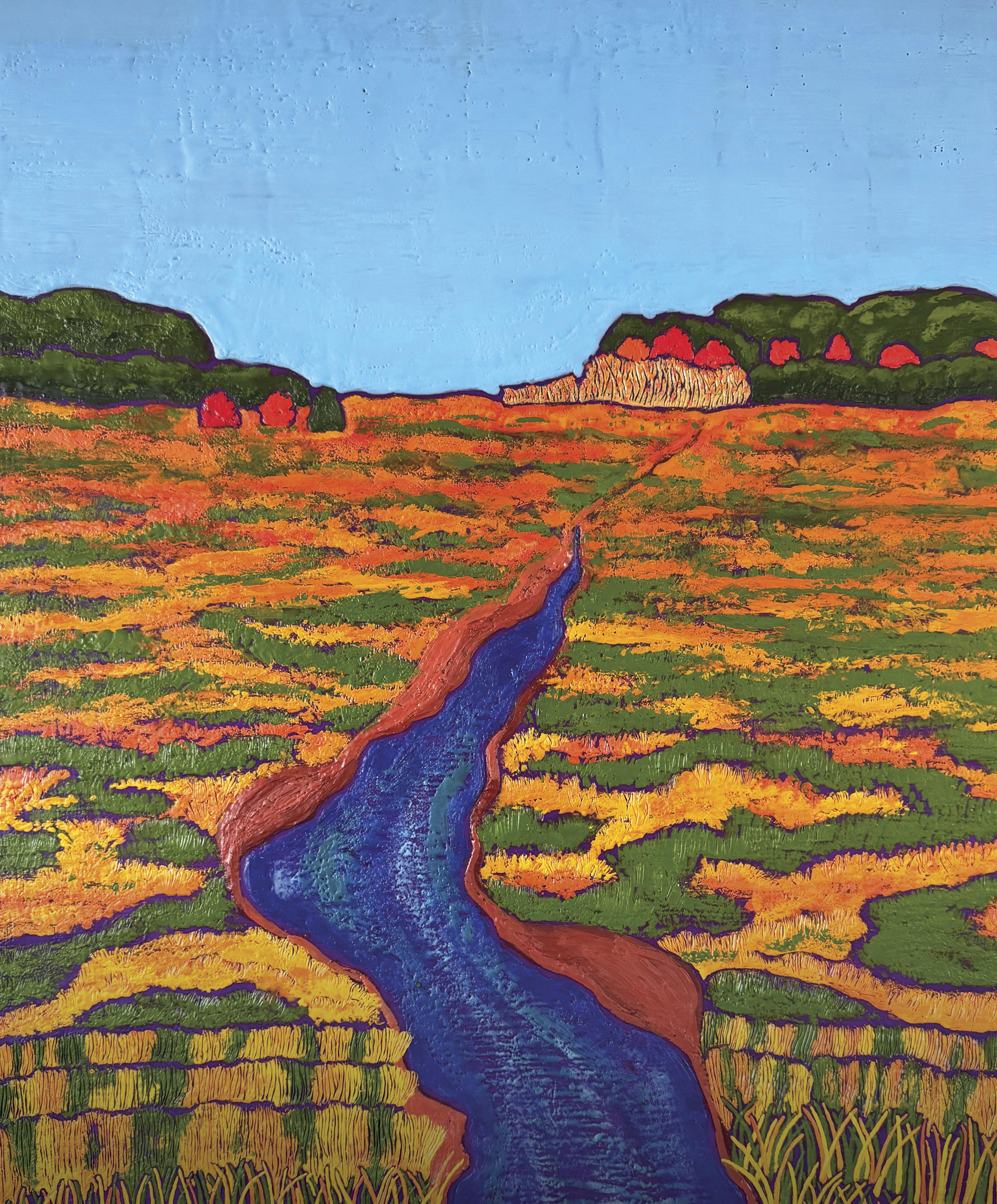
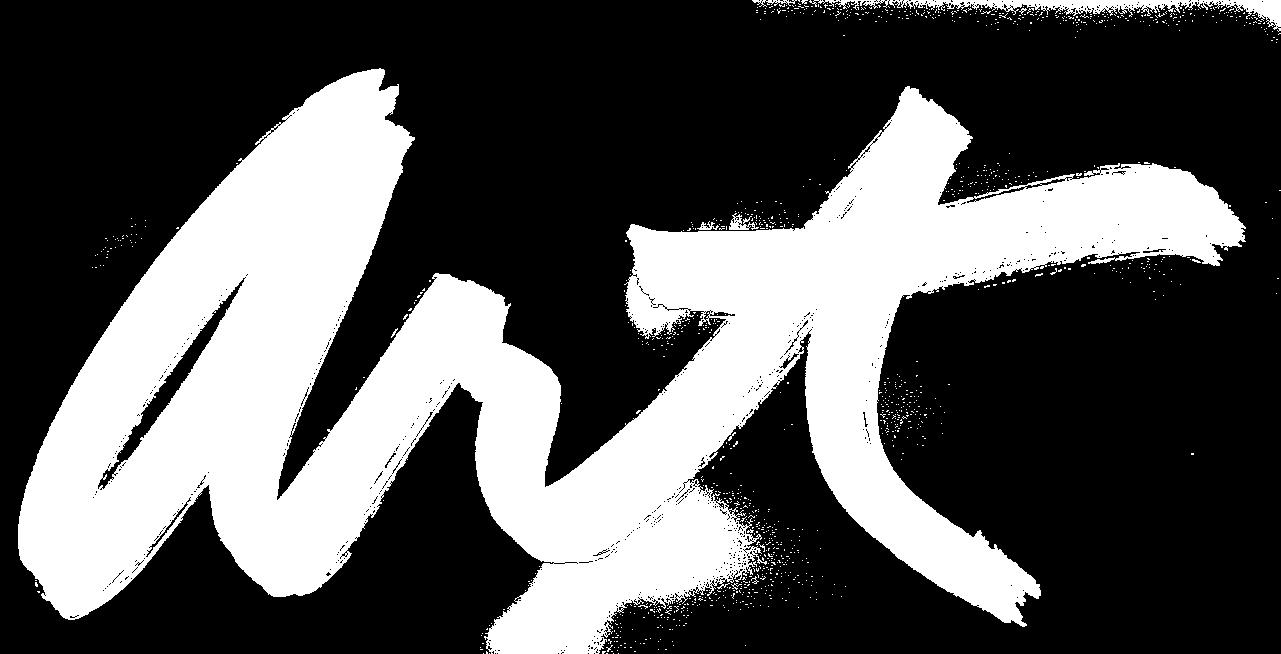



SEPTEMBER 11–DECEMBER 13, 2025
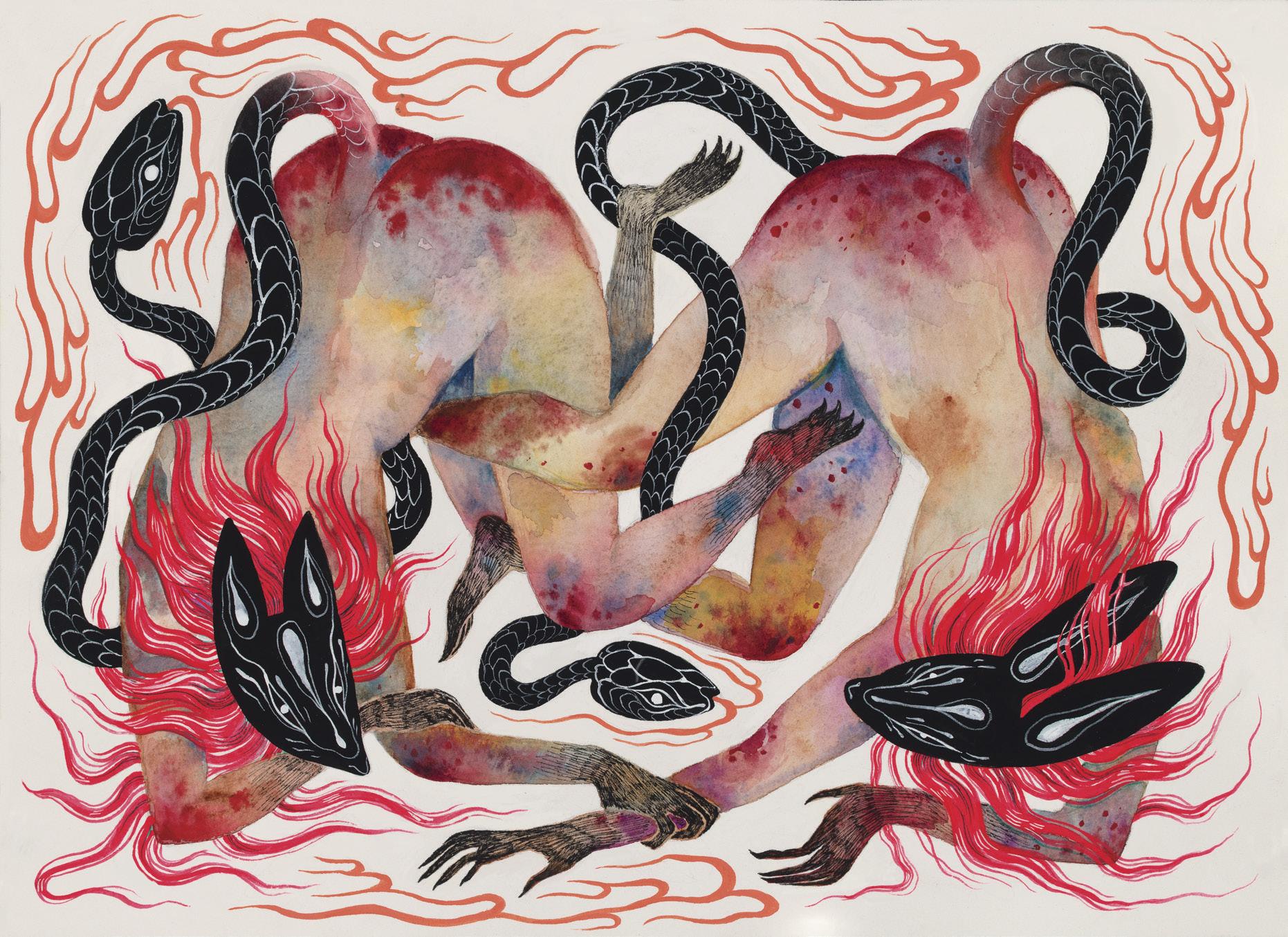



CONTEMPORARY ART AND CULTURE
“What art offers is space, a certain breathing room for the spirit.” — JOHN UPDIKE
PUBLISHER Tim Montgomery
PUBLISHER Rita A. Fucillo
INTERIM EDITOR Rita A. Fucillo
WRITERS THIS ISSUE B. Amore, Charles Bonenti, Cynthia Close, Autumn Duke, Paige Farrell, Rita A. Fucillo, Stacy Grossman, Loren King, Carl Little, Jennifer Mancuso, Emily Avery-Miller, Susan Saccoccia, Eve O. Schaub, Terri C Smith, Julianna Thibodeaux, Michael W. Zhang
EDITORIAL ASSISTANT Autumn Duke
ART DIRECTOR Lori Pedrick
ASSOCIATE ART DIRECTOR Scott Roberto
SENIOR ACCOUNT EXECUTIVE Susan Baker
VICE PRESIDENT, OPERATIONS Tyler J. Montgomery
CORPORATE COUNSEL Lenard B. Zide, Butters Brazilian LLP
SUBSCRIPTIONS artnewengland.com/subscribe
ADVERTISING (857) 366-8131
EDITORIAL (617) 259-1034
ADVERTISING E–MAIL advertising@artnewengland.com
CALENDAR E–MAIL calendar@artnewengland.com
EDITORIAL E–MAIL editorial@artnewengland.com
PRODUCTION E–MAIL production@artnewengland.com
FOUNDING PUBLISHERS Carla Munsat and Stephanie Adelman
SUBSCRIPTION $28.00 per year
NEWSSTAND $35.70 per year
Postmaster send address changes to address above.
artnewengland.com @artnewenglandmagazine
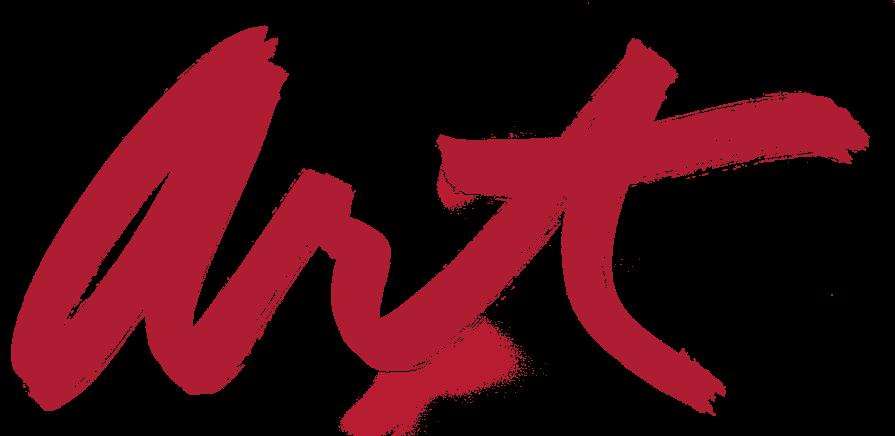

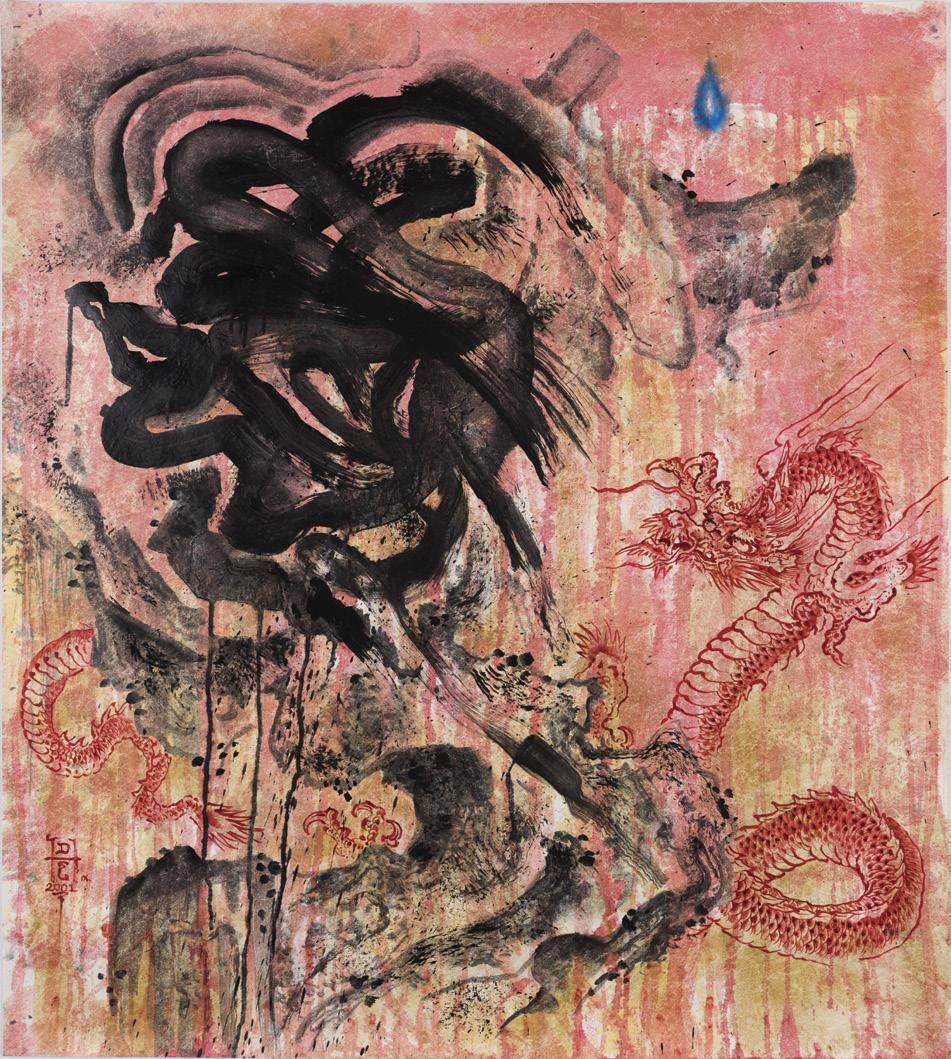
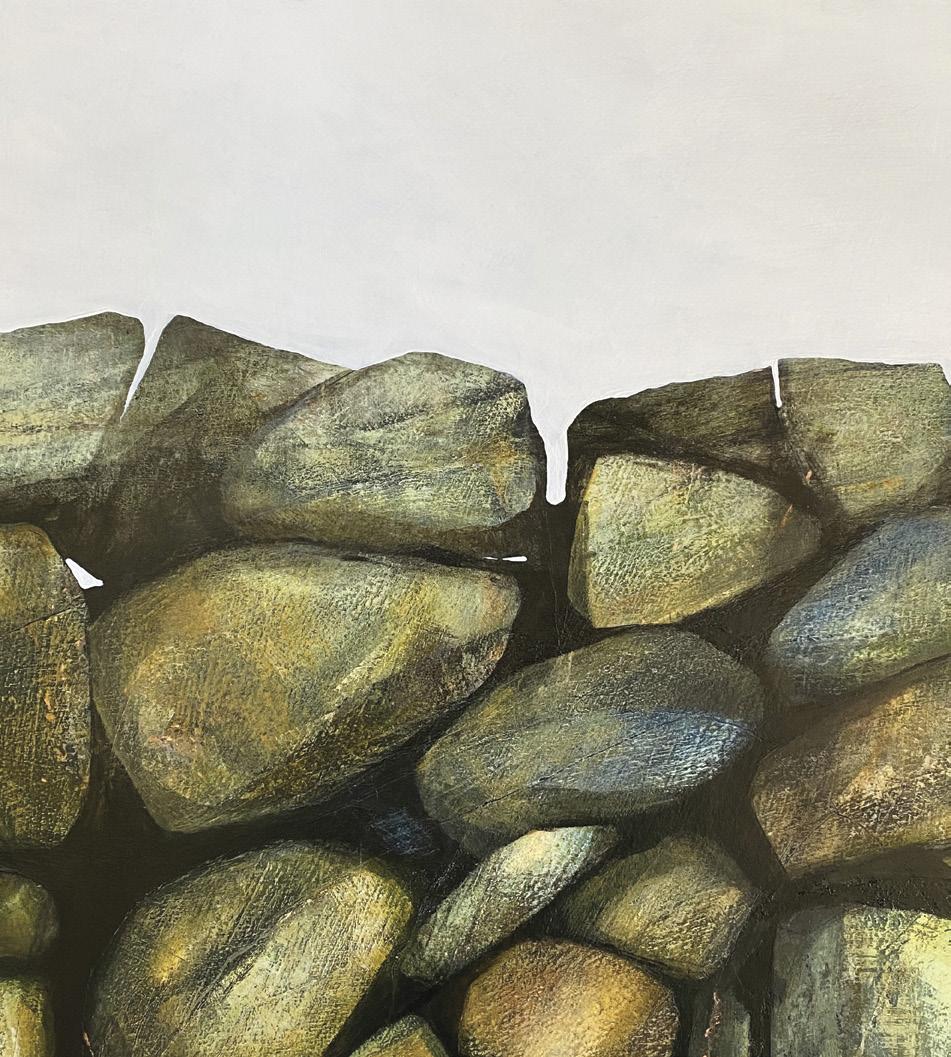
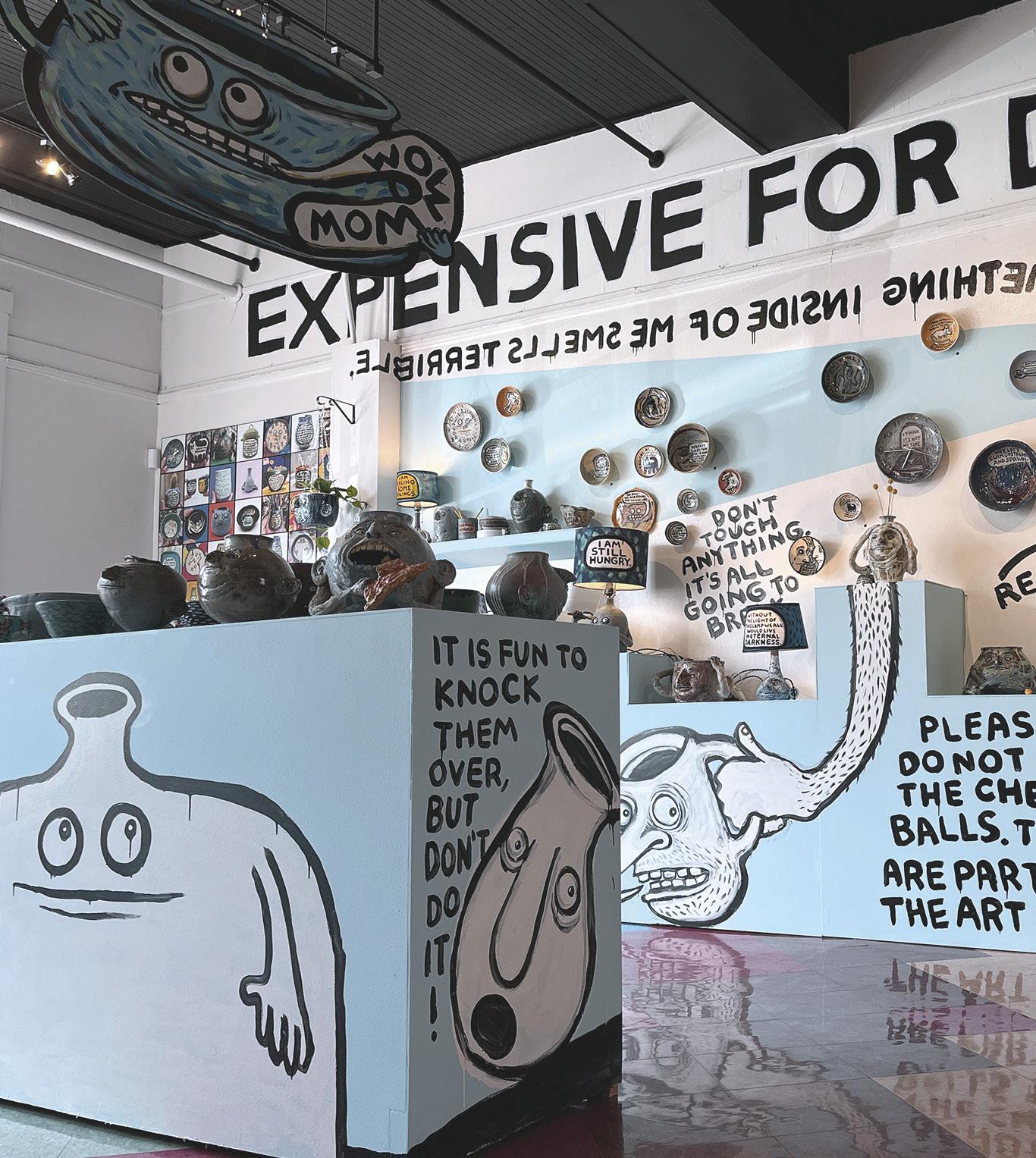

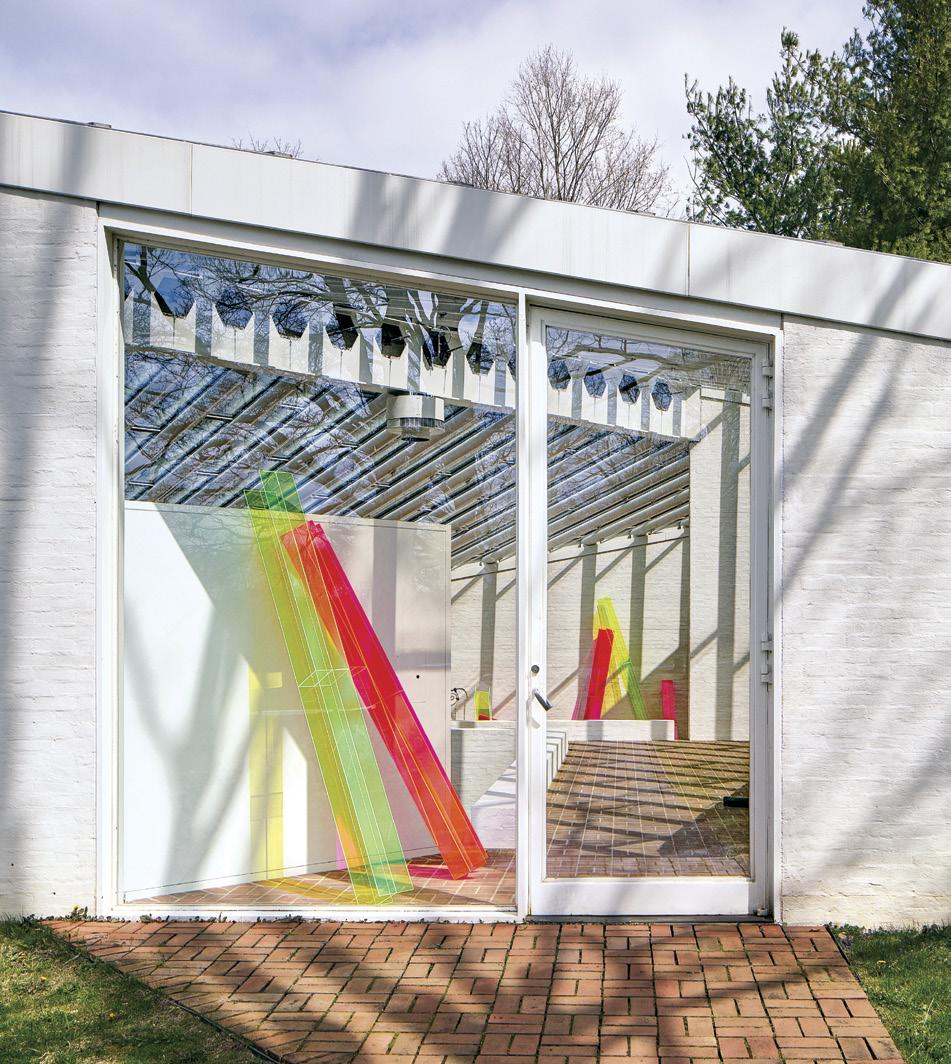
55 Jonathan Latiano by B. Amore
56 Anna Dibble: Answering Nature’s Call by Cynthia Close
58 Remembering Robert B. Stull by Jennifer Mancuso
61 A Journey to Distant Memories: O’Neil Scott by Carl Little
62 Celebrating 45 Years! FPAC Members Exhibition by B. Amore
65 Chris Gustin by Stacy Grossman
66 Holding, at the Kent, by Cynthia Close
67 Vermont Honors Its Own by Cynthia Close
60 Vietnam: Tradition Upended at Flinn Gallery at Greenwich Library in Greenwich by Julianna Thibodeaux
60 Barbara Kasten: Structure, Light, Land at The Glass House in New Canaan by Terri C Smith
63 I Became a Room: Tom Butler at Sarah Bouchard Gallery in Woolwich by Carl Little
63 Ralph Steadman: And Another Thing at Bates College Museum of Art in Lewiston by Carl Little
66 Finding Joy at Blue Door Gallery in York by Paige Farrell
64 BLKChip Gallery in Boston by Jennifer Mancuso
NEW HAMPSHIRE
67 Objects of Affirmation at Queerlective at Totally Tea + Coffee in Concord by Autumn Duke
67 All Paths Home, the lakes gallery at chi-lin, in Laconia, by Rita A. Fucillo
RHODE ISLAND
68 RISD Craft Fair at Rhode Island School of Design in Providence by Michael W. Zhang
68 Light and Stone: Darrell Petit and Sean Kernan at The Carving Studio & Sculpture Center in West Rutland by B. Amore
(14) Kathleen George, Meeting Of The Minds, 2023, acrylic paint and copper leaf on wood panel, 14 x 13". Courtesy of the artist. (28) Don Ed Hardy, Pluto, 2002, acrylic on archival synthetic paper, 34 x 38". Courtesy of the artist and Track 16 Gallery, Los Angeles. (34) Installation view of Cheap for fine art, expensive for dishes by Dave Zackin at Kishka Gallery. Courtesy of the gallery. (46) Will Kasso Condry of Juniper Creative, recipient of the 2025 Herb Lockwood Prize. Photo: Isora Lithgow Creations. (60) Barbara Kasten: Structure, Light, Land at The Glass House in New Canaan, CT. (61) O’Neil Scott, Fading Promises, 2025, oil on canvas, 72 x 60". Courtesy the artist and the Zillman Art Museum.
Compiled by Autumn Duke
(MA) Jennifer Chrzanowski is the new executive director of the Fuller Craft Museum. She stepped into the role on July 1. Chrzanowski most recently served as deputy director and interim director at the Academy Art Museum in Easton, Maryland. She previously served as founding director of DNJ Gallery in Los Angeles and operations manager at Augusta Museum of History. Chrzanowski earned her BFA in film, photography and electronic media from the University of Illinois at Chicago and is completing her master’s degree in photography from Columbia College in Chicago.
(MA) Patrice Maye has been named the new executive director of Artists for Humanity (AFH), following the departure of Anna Yu. Maye has worked with AFH before, serving as development director for sixteen years between 2001 and 2017. During that time, Maye oversaw AFH’s transition from employing 100 teens annually to 250, as well as fundraising efforts and other areas of growth in the organization.

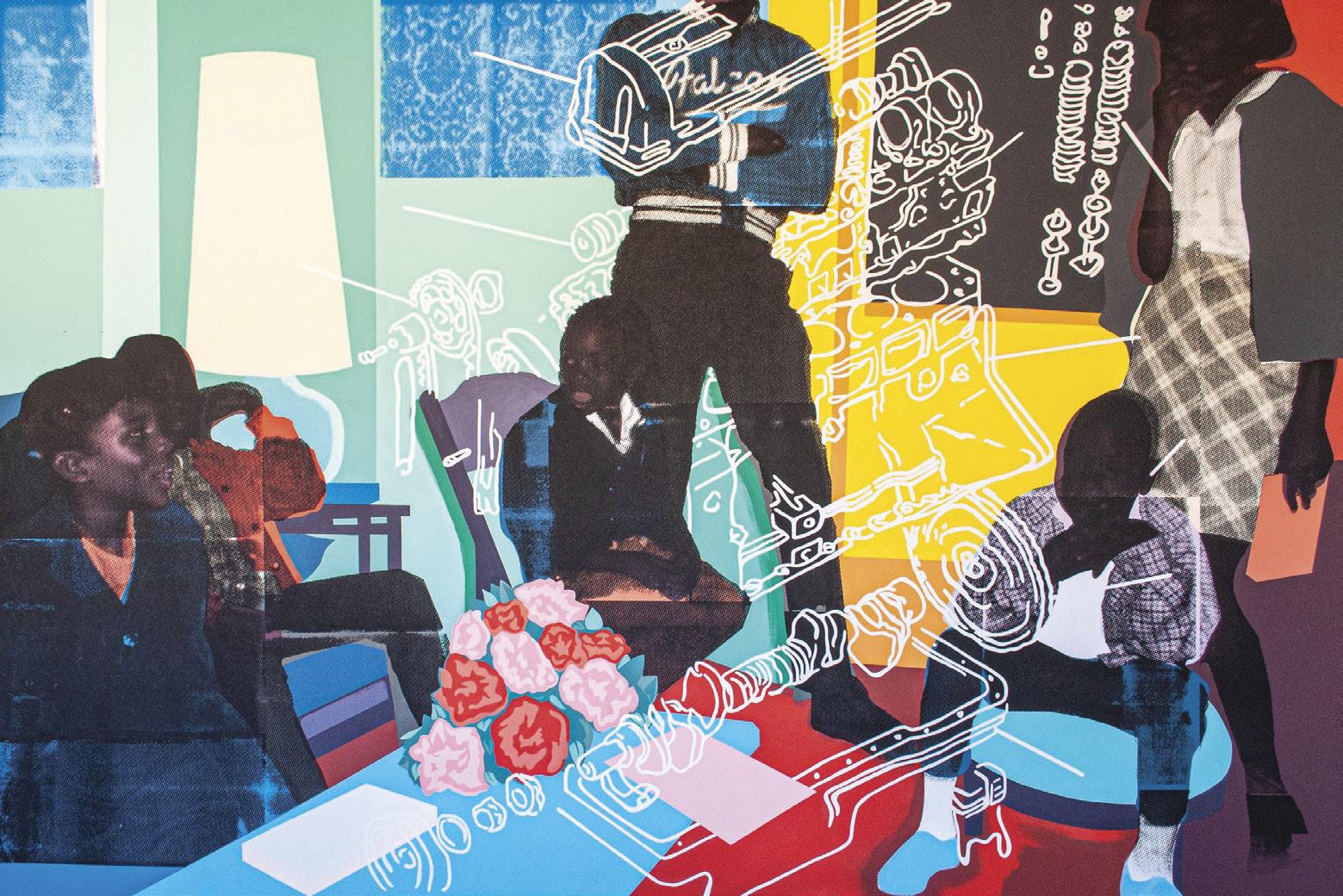
She has spent the interim eight years at South Shore Art Center, where she has continued to partner and collaborate with AFH. Maye begins her tenure on September 15.
(CT) NXTHVN announced the Cohort 07 Fellows. These artists and curators will participate in a ten-month intensive fellowship program from August 2025 to May 2026. Each fellow is paired with a New Haven public schools’ student with an interest in pursuing art or curation. The Cohort 07 Fellows are Sophia-Yemisi Adeyemo, Alexandra Bell, Tam Fay Coleman, Benita Nnachartam, Masud Olufani, Haejin Park, Chayse Sampy, Juanita Sunday and Kristopher Wright.
(MA) Mauro Marinelli is the 2025 Wheelwright Prize winner. The $100,000 Wheelwright Prize, administered by Harvard University, is given to those pursuing investigative approaches to contemporary architecture. Marinelli’s project, Topographies of Resistance: Architecture
and the Survival of Cultures, examines the role of architecture in sustaining and revitalizing rural mountainous regions. He compares contexts in the Alps, Andes and Himalayas. This prize will fund two years of travel for Marinelli between and among these three locations.
(MA & RI) Of the fifteen recipients of 2025
Joan Mitchell Fellowships, two hail from New England states. Cathy Della Lucia, born in South Korea and based in Massachusetts, builds multi-part sculptures made from wood, ceramics and digitally fabricated material that are designed to be pulled apart. Bob Dilworth, of Providence, Rhode Island, is painter who received the RI Pell Award for Excellence in the Arts in 2024. Joan Mitchell Fellowships provide awardees with $60,000 in direct funding distributed over five years, alongside professional development, peer engagement and network-building programs.
(ME) The Traditional Art Network (TAM), through Mayo Street Arts, provides tradi-
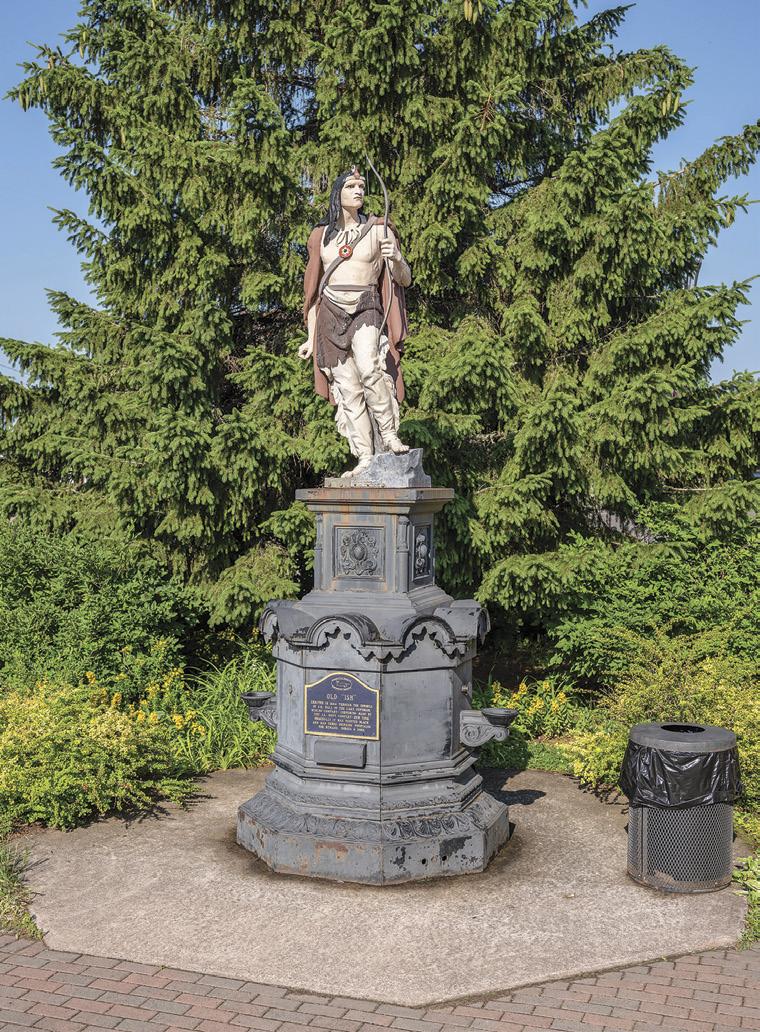
tional artists and artist groups in Maine with small grants up to $1,000 for specific projects and pursuits. This grant program is designed to create low barrier opportunities for first-time grant seekers. This season’s awardees are the Afghan Women Arts Group, Estony Azizi, Maryam Ghulan Hassan, Jawahar Joya Pashio, Zahira Sadat, Uwera Elyse, Apphia Kamanda Mpay, Watt Samaki Temple and one anonymous artist.
(VT) Mira Rosenthal and Suneela Mubayi are the 2026 ALTA Fellows at Vermont Studio Center (VSC). ALTA Fellowships at VSC are the result of a partnership between the American Literary Translators Association (ALTA) and Vermont Studio Center. The fully funded twoweek fellowships are awarded to two ALTA members annually. Rosenthal is an American poet and a mid-career translator of Polishlanguage writers. Mubayi is a gender-queer translator based between New York City and Oslo, Norway, who translates works between Arabic, English and Urdu.
(VT) Jonathan Gitelson has been named the fourth recipient of The Vermont Prize. The Vermont Prize is an annual award started and supported by the Brattleboro Museum & Art Center, Burlington City Arts, The Current and Hall Art Foundation to celebrate the best of visual art being made in Vermont today. The Prize comes with a $5,000 award as well as exposure from The Vermont Prize’s website and social media platforms. Gitelson has been making art in a variety of medium for more than twenty years. He is known for his use of sociological observation and humor to interrogate human nature and social constructs. Gitelson currently teaches art and design at Keene State College.

(MA) The W.E.B. DuBois Sculpture Project launched in May 2022, the result of a group of volunteers looking to commemorate the writer and activist in his birthplace of Great Barrington, Massachusetts. DuBois’ legacy as an intellectual and a pioneer of social justice began with his birth and early education in Great Barrington. A jury of gallerist and artist Lauren Clark of Lauren Clark Fine Art, writer and activist Delano Burrows and painter and sculptor Reginald Madison selected Richard Blake to create the bronze statue which was unveiled at Mason Library on July 19.
(MA) Danforth Art Museum and School received a bequest of $4,660,000 from the estate of artist, trustee and longtime patron Susan Litowitz. It is the largest gift in Danforth’s fifty-year history. The money will be used to create three endowed funds supporting four areas of growth: operations and programming in the Litowitz Family Gallery, educational program-
ming, marketing and community engagement and financial aid for adult art students.
(MA) Olivier Meslay is stepping down from his role as Hardymon Director of the Clark Art Institute after ten years at the Clark. Meslay announced his intention to leave in July 2026. He will return to his native France with his wife, art historian Laure de Margerie, where they will continue their academic and curatorial pursuits. “We came to the United States with a deep interest in learning about American museums and how they work, which is very different from the French system,” said Meslay. “We have seen so much of this country and met so many wonderful people. We will leave the Clark with incredibly warm memories and deep gratitude for the opportunities and experiences we shared here.”
(MA) Rockport Music’s Shalin Liu Performance Center will be closed from December 22, 2025, to mid-February 2026 for interior renova-
tion. It has been fifteen years since the performance center first opened. The renovation is led by Boston-based architecture firm Hacin. Highlights of the renovation plans include improved patron amenities, a redesigned green room for musicians and artists, and a reimagined reception hall.

(MA) The French Library celebrates its eightieth anniversary this year. The non-profit hosts a collection of more than 32,000 French volumes, language classes, cultural events and gastronomy held across Greater Boston and at its flagship Back Bay location. “We are much more than a place where you borrow books. We are a cultural space, an educational space, a haven where our community share their passion for la France et la Francophonie,” said president and executive director Barbara Bouquegneau. Programming for this year has a historical focus in honor of the anniversary.
(MA) Harvard Art Museums has been gifted Light-Relief (1960), a large-scale sculpture by Heinz Mack, from the recently established Mack Foundation. It is the first public gift by the Foundation. The sculpture has entered the collection of the Busch-Reisinger Museum, one of Harvard Art Museums’ three constituent museums, and will be on display beginning October 25 in the Level 1 galleries. The Busch-Reisinger Museum considers all modes and periods of art from central and northern Europe, with a focus on German-speaking countries.
(MA) The Rotch-Jones-Duff House & Garden Museum (RJD) celebrates its fortieth anniversary this year. On September 18, RJD will host celebrations including guest speaker Anne B. Brendle, first board president and former executive director of RJD. The house, an 1834 Greek Revival mansion first build for whaling merchant William Rotch, Jr., is a registered National Historic Landmark. It chronicles 150 years of New Bedford and the lives of the Rotch, Jones and Duff families and their domestic staff.
Compiled by Autumn Duke
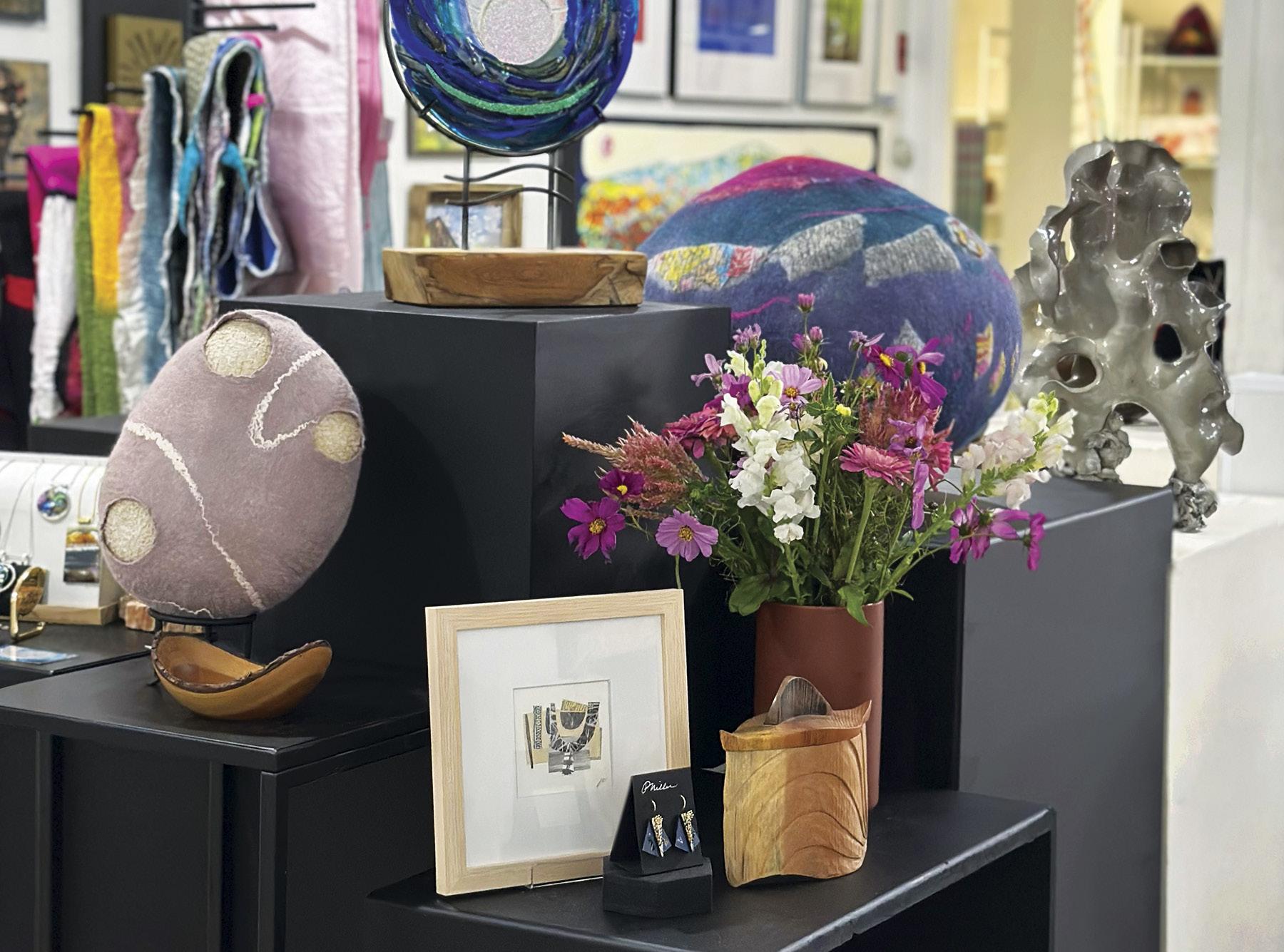
(NH) Blue Fern Artists Collective opened a new exhibition space. Blue Fern Artists Collective Gallery will operate under a mission to provide community-building opportunities for local artists and offer retail art in various mediums and price ranges. Blue Fern also announced a partnership with MAXT Makerspace, with collaboration plans on the horizon, and will show art made at MAXT in the new gallery. The Gallery is located at 40B Main Street in Peterborough.
(NH) The lakes gallery at chi-lin in Laconia reopened in August after a period of unexpected closure. The Lakes Region Chamber of Commerce will hold a ribbon cutting celebration on September 16 in honor of the reopening. The gallery opened with The Grace of Nature’s August, open through September 7, and will continue with All Paths Home featuring the work of Kelly Blake, Gay Freeborn, Nancy Freeborn, Cheryl Kimball and Anne McMillan.
(MA) Art Nook Gallery moved to a brand-new location central to downtown Rockport. The new location at 52 Bearskin Neck is spacious and boasts ocean views on both sides. The gallery opened in this space with sales on select prints and other merchandise and held a grand opening party in July to celebrate the move. Art Nook Gallery shows the work of gallery owner and artist Kathleen Miller as well as painter Stefan Mierz and artist and educator Larry Martin-Bittman.
(MA) The Storefront Gallery is an innovative project by Holyoke Art and the City of Holyoke designed to bring art and community to downtown Holyoke. Storefront Gallery transforms High Street into a walkable outdoor art experience through a large-scale installation of selected works of art in storefront windows. Nine artists were chosen from a competitive open call in early 2025. Works were installed and unveiled on July 30 with an inaugural celebration.


I’ve been thinking a lot lately about envelopes. What they are. Who they are and where we find them. Safe bubbles and spaces where we escape to… for peace and quiet, contemplation, distraction or solace. Envelopes are sacred spaces. And the need for envelopes seems to be greater these days. Notice how they are mostly arts-related. We resort to literature, music, theater, dance, museums and, of course, galleries. In thinking about this year’s annual Gallery Issue, I felt it was time to expand the concept of galleries and how we view and visit them. They are more than sacred spaces. They hold more than art. They hold our voices, our empathy and our self-expression. They provide a safe place to gather, engage in conversation, question things. If you do nothing more this fall, visit as many as you can and thank a gallerist. Thank them for existing, for staying the course, for filling their walls and spaces with hope and rage and
exasperation and beauty. For giving their artists breathing room. For maintaining their envelope for us. Here is the Alternative Spaces Issue.
Envelopes can be people, too, or even a magazine. As we watch some of our most treasured envelopes being threatened, altered, or erased—the Smithsonian, the Kennedy Center, NPR, PBS, Stephen Colbert—I think it’s time to be ever more grateful for the ones we still have and to find ways to support them. This is our responsibility. Art New England is one of my envelopes and as much as I’d like to be perfectly punctual, there are speed bumps and financial pressures in the art world that make it challenging to do so. And yet, I am so grateful to publish this platform, this precious envelope, for the voices and intelligence and the profound empathy and understanding it conveys through the words of my writers and the art we celebrate.
I invite you all to wander through the myriad
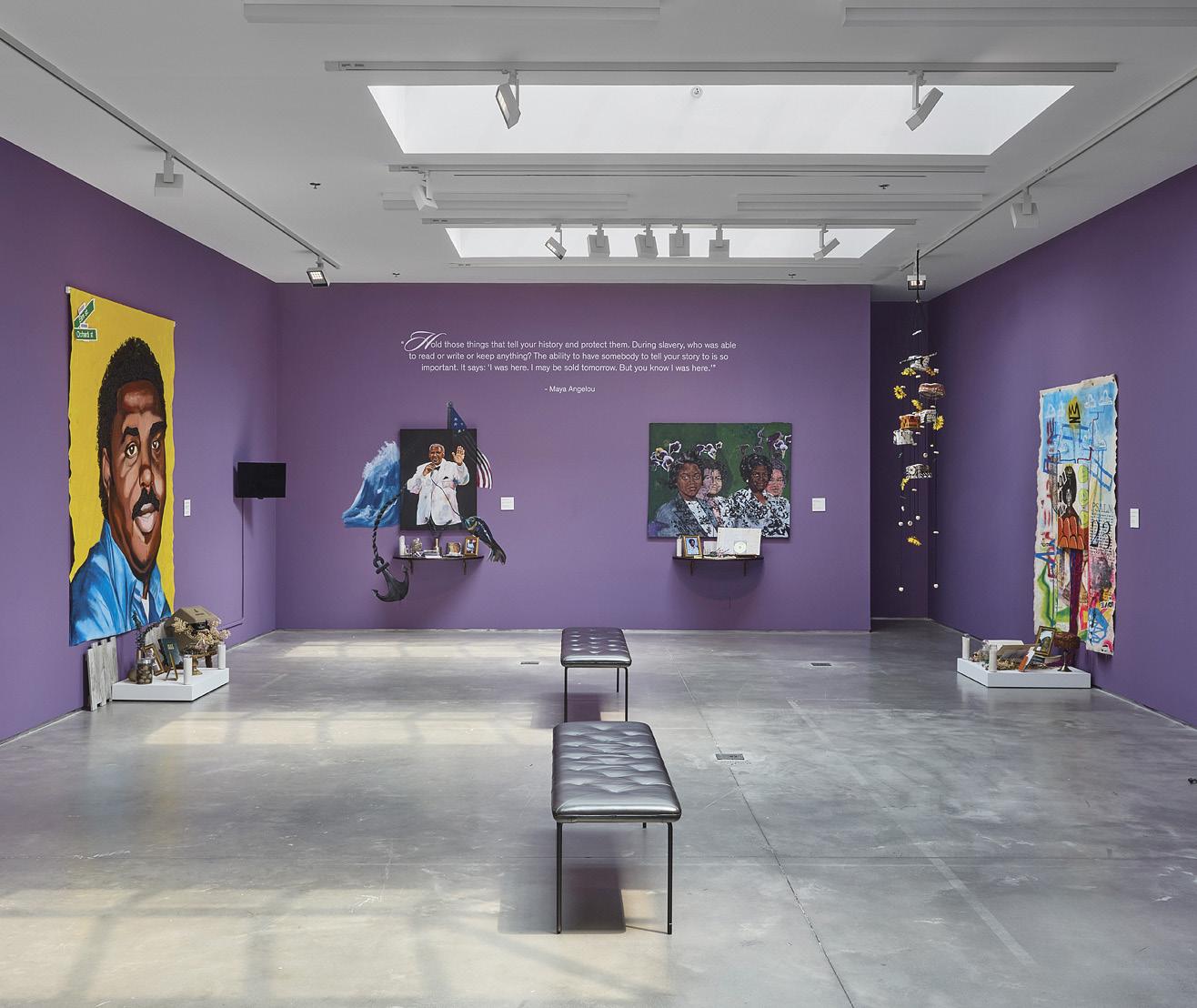
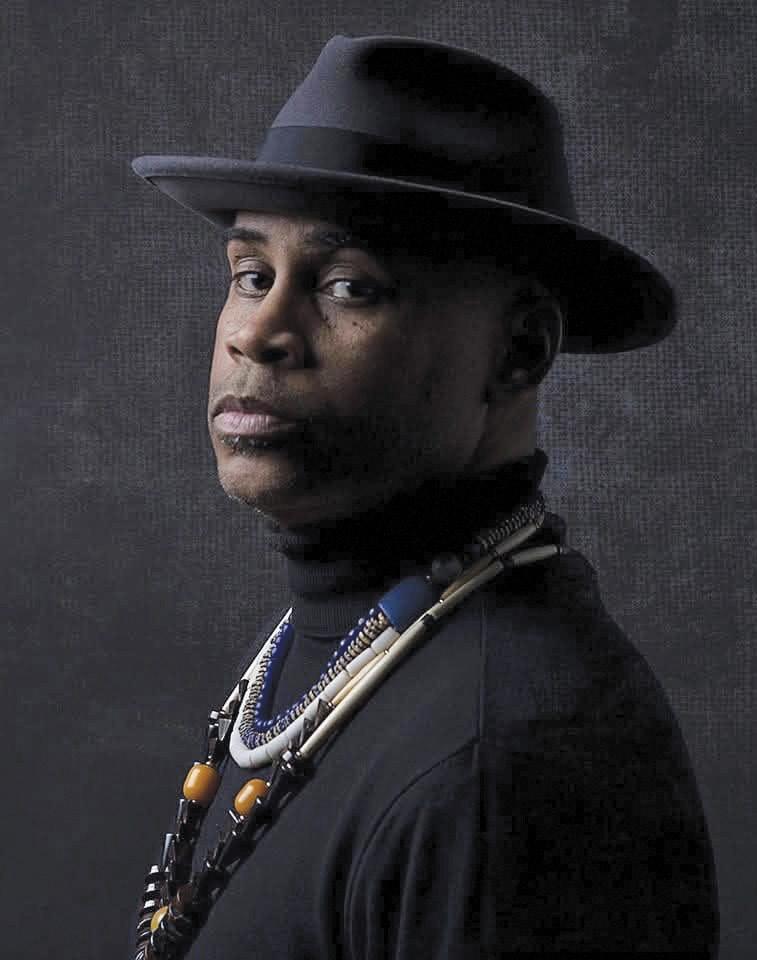
of envelopes within these pages and explore people and art and learn about what’s happening this season. Autumn Duke and Paige Farrell delve into extraordinary alternative spaces, many with women at the helm. Farrell also takes us into the musical landscape of composer and educator Howard Frazin. Eve Schaub takes us into haunted (?) spaces through a personal experience. Loren King helps us understand the fascinating and often under-appreciated art of set design. If not for these masters, the envelopes we depend upon on screen would not exist. Susan Saccoccia prepares us for the upcoming theater season by highlighting six shows and introducing us to Dawn Meredith Simmons, the new artistic director of SpeakEasy Stage, and Maurice Emmanuel Parent, the new producing artistic director of Front Porch Arts Collective (where he and Simmons had been colleagues for a decade). Jennifer Mancuso honors the legacy of graffiti writer Rob Stull in a beautiful memoriam as B Amore pays tribute to forty-five years of the Fort Point Arts Collective. And, of course, there is more.
This magazine is more than its issue date. Art is non-linear; time feels non-linear these days. Remember the 2016 film Arrival? It’s an envelope for me. The film teaches us that communication and empathy are key to our survival, and that embracing life, all aspects happy and horrible, is the only way forward for humanity. The film uses the alien’s non-linear language to show how a different way of perceiving time can lead to understanding the interconnectedness of our existence. It’s a
beautiful film, sharing a powerful message that we all need to sit with now. We are all facing challenges, personally and professionally. Let’s be grateful for the work within these pages, the freedom of expression we still possess, the journalistic freedom we still honor and celebrate. Not everyone enjoys these freedoms.
Let’s be grateful we can take a walk along the marshes of Cape Ann, MA, through the cover image by Maine artist Marcia Crumley. “The painting is titled October Marsh,” says Crumley. “The painting itself is loosely based on a photo I took of Fox Creek in Ipswich, MA, while driving to Crane Beach last fall. I grew up riding my bike past, and paddling in, coastal marshes in Massachusetts, and I live near two marshes now (Spurwink and Scarborough). This painting isn’t about a particular marsh, but the calming rhythms of all coastal marshes and the brilliant multi-colored grasses of autumn.”
“In these anxious times,” she continues, “it’s important to seek out and celebrate moments of joy. Finding Joy [currently at Blue Door Gallery, see page 64] is about recognizing the delight and wonder found in simple, often unexpected, places. These paintings celebrate those times when the beauty of the natural world suddenly stops you in your tracks: being mesmerized by a starry night sky, noticing how
the brilliant oranges and golds of autumn foliage pop against the deep blue sky, or watching a kaleidoscope of monarch butterflies as they pass through on their annual migration. My painting process is defined by layering. Each piece contains up to 15-20 strata of pigmented wax…The highly textured surfaces of these encaustic paintings invite viewers to spend more time with them. I like the artist’s hand to be visible in my work, and the longer you spend looking at these paintings, the more you see–subtle gestures, hidden textures, and even ‘mistakes’ that I’ve decided to leave in...”
Crumley creates a beautiful envelope, a trusted path, and an ideal cover to inspire opening these pages. I am grateful for each page, for each reader, for each advertiser. For each voice represented, for each word chosen by these incredible writers. We are in troubled waters politically yet this issue reminds us of our safety in togetherness, the grace and empathy within the art world and the envelope of hope.
In gratitude,

Rita A. Fucillo Publisher
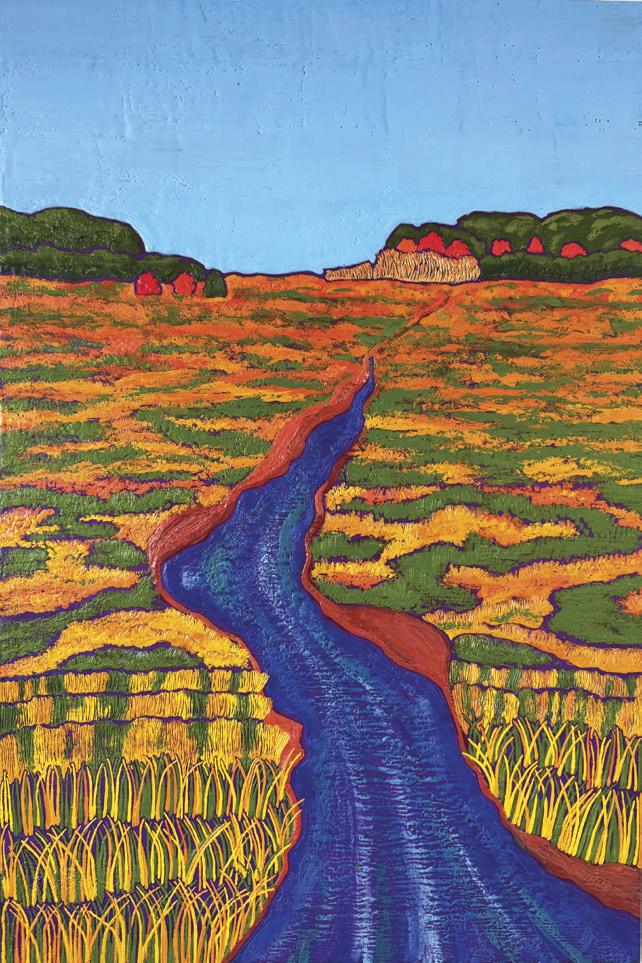
ON THE COVER:
Marcia Crumley, October Marsh, February 2025, encaustic on panel, 36 x 24". Courtesy of the artist.
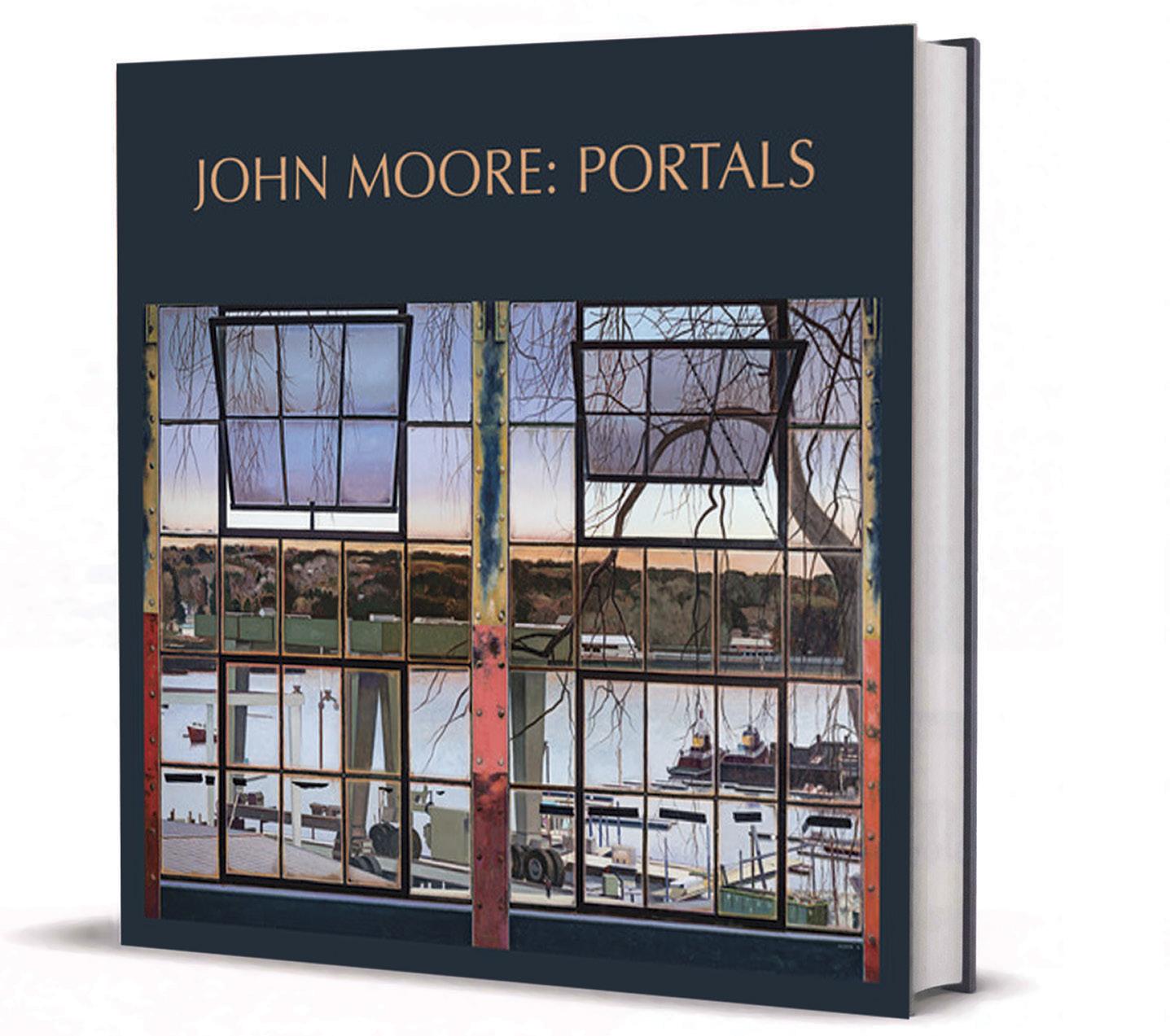
“… [Moore] transforms industrial settings, or what remains once industry moves away, into paradigms of a formal Apollonian order. The paintings are remarkable for their visual acuity, masterful technique … and highly refined aestheticism. The artist is an elegant host in scruffy precincts.” — Robert Berlind Brooklyn Rail
John Moore: Portals
Edited by Carl Little with contributions by Christina Kee, Suzette McAvoy, John R. Stomberg, Rosanna Warren
Poems by Vincent Katz, Rosanna Warren, John Yau, Geoffrey Young
Published by Marshall Wilkes Publishers
Hardback and Jacket, 144 pages 11 x 11 inches
82 Color Plates and Illustrations
ISBN: 978–0–9839670–8–8
Price: $60 US
Distributed by National Book Network: PH 800-462-6420
By Carl Little
Walking to Samuel Gelber’s barn studio behind his home in Morrill, Maine, in mid-June you pass flower and vegetable gardens and pass close to willow trees, part of a flourishing environment made greener by recent rains. Gelber made the 71-acre former farm his seasonal home in 1965, in response to his wife Blanche Lilienblum’s demand that they never spend a summer in Brooklyn (he taught at Brooklyn College for many years).
At one point, thanks to a small inheritance from his sister, Gelber added onto the barn, keeping its bones and beams while extending the space beyond the original footprint. The extra square footage includes a storeroom jam-packed with years of work that has been carefully organized by his son, Noah, a celebrated ballet dancer and choreographer. Gelber is proud of this “catalogue” of his work, which visiting curators have admired.
Gelber’s painting studio is just inside the front of the barn, some of the last remaining available space. Boards nailed to the walls at various heights allow him to work on different-sized and -shaped canvases, some of them huge. “I go to my painting and I paint,” he told me.
For the past several years, every few days Gelber has been sending out a progress shot of his latest abstract floral painting, which he calls “bouquabstraqs”—abstract bouquets. His recipients, which include family, fellow artists and acquaintances, delight in following the evolution of each canvas, from simple skeletal outline to brilliant finale, at which point the artist provides a title.
his surroundings, including an apple orchard, a local quarry and other motifs, these brilliant bouquets are improvised—no photos, no still life set-up—“free-painted,” he announced proudly, adding, “They’re organized out of my experience.”
Gelber credits growing up in a working class immigrant family—his Polish father was a furrier—for his sense of responsibility to share his work. It made sense to him to let his process “out,” not to hide behind a wall. While dangerous—“you don’t know what will happen,” he said—he felt this part of his process was important. “Every artist should take chances,” he asserted.
Gelber has another studio on Manhattan’s upper West Side. He paints in the apartment’s living room, which is also filled with canvases. “It’s a gallery,” he says, “Noah has hung paintings in every room, on every wall.”

connection to the natural world. As he wrote in an essay in the Maine Arts Journal during the COVID-19 pandemic, “Nature is the same and different from day to day, and I have observed its in-between space for many seasons.”
Recently, Gelber started a series of small watercolors marked by geometric shapes and negative space, some of them bringing to mind stain-glass windows. The watercolors were inspired by lilies of the valley, which grow in profusion around his home. They were a favorite flower of Gelber’s wife, who died in 2014.

So, on July 8, 2025, Gelber shared Bouquabstraq Green, an oil on linen. From its first appearance on June 5, the lively composition had grown more complex and dynamic, the gestural lines and shapes swirling and twisting across the surface. While his earlier work responded to
Gelber is one of two living artists—the other is fellow Maine-based painter Sharon Yates— featured in Alan Gussow’s landmark A Sense of Place: The Artist and the American Land, 1972. His painting in that book, Orchard II, 1969, represents a personal breakthrough he discusses to this day, that moment when he began to read the geometry of trees. He has moved on to other subjects but not without bearing that deep
During our interview in June, the 96-year-old painter mused, “I keep painting, I keep surviving.” To underscore his commitment to making art, Gelber pointed to the yellow work gloves that rest on the chairs in his barn studio. It’s a message he’s been repeating, to himself and the world, for over 40 years: “Don’t sit on your hands.”
[You can learn more about Gelber’s life in an interview conducted by the Maine Memory Network. His painting Quarry #2 is featured in “Quarries: Muse and Material” at the Monson Arts Gallery (through October).]
Carl Little edited the monograph John Moore: Portals (Marshall Wilkes). He lives and writes on Mount Desert Island.
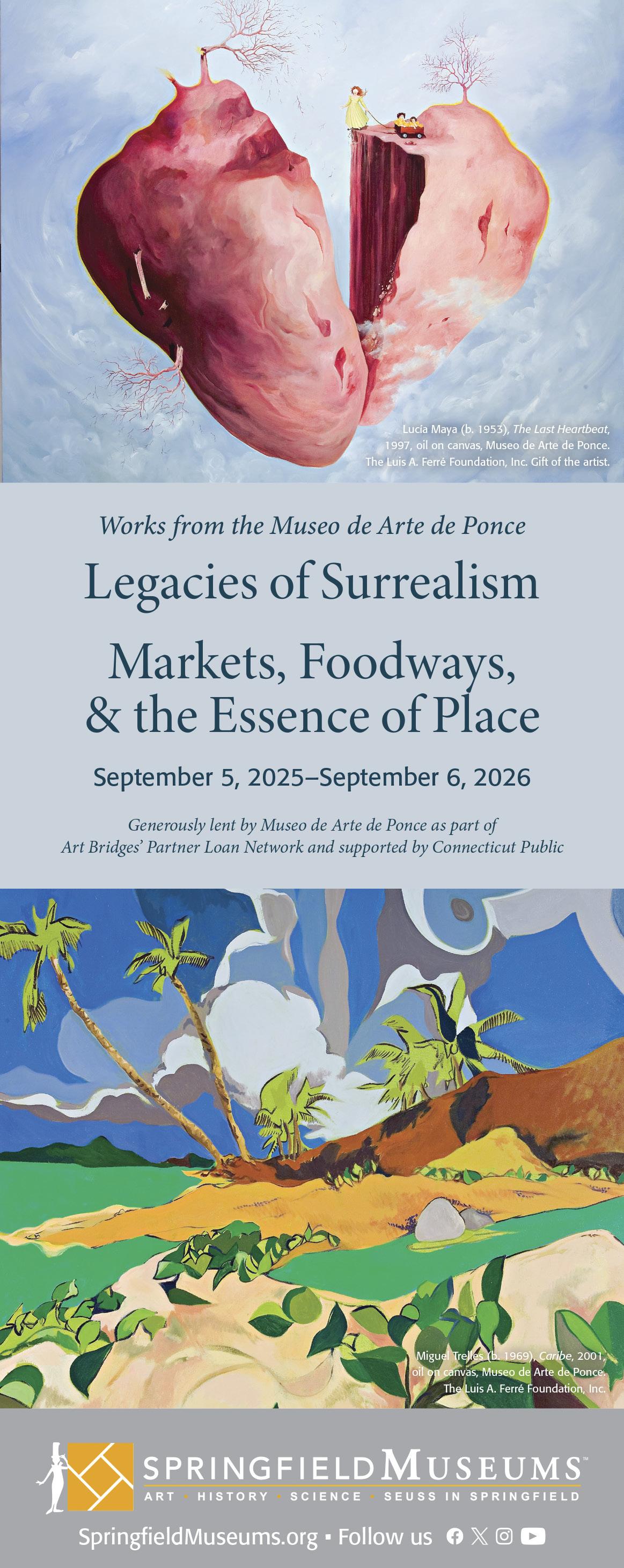
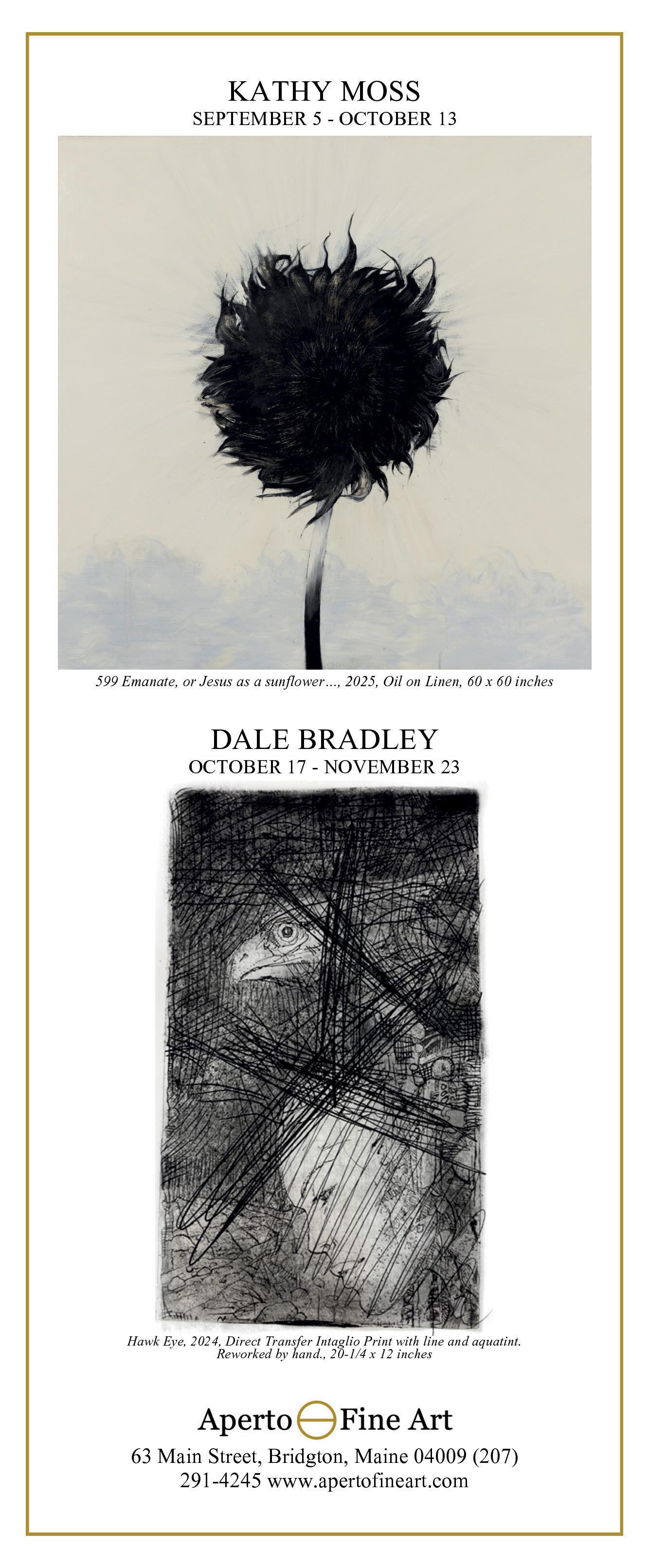
By Paige Farrell
If you are going to be extraordinary, you can’t worry about the mustard you don’t have in the fridge. —Mary
Oliver
Kathleen George is passionate about art, and social justice. A graduate of Gordon College, George is a gifted artist and a registered nurse. Hers is a life of two worlds running alongside one another and coming together. Both life paths are her sustenance.
“Art-making has always been a stabilizing force in my emotional core,” George states. “Art winds in and out of all my experiences, giving voice and image to the things I need to say. Art has given me the ability to tolerate and celebrate my individual human aloneness, and this is a great gift. Throughout my life, I have turned to painting as a way to relax, to give and receive, to grieve, to express, and to feel whole. My studio space is so familiar, transformative. My arm and eye begin to feel more like spirit, and I travel to some other place. The movements of my body, like my mind, become a dance. ”
George works as a registered nurse at the Barbara McInnis House, on Albany Street in Boston. A medical respite facility for the homeless, it is operated by the Boston Health Care for the Homeless Program. “We specialize in addiction treatment. Yes, the job is hard. As a nurse, I get to know the person, and it is heartbreaking. The work has opened the world for me in a very different way than I had ever experienced.” George pauses, then shares with a quiet intensity, “There are moments of beauty, there is community, people sitting together, sharing. The vulnerability. It is good work.”
“Every day I work at McInnis, I am in contact with real human beings who have undergone suffering. The work keeps me grounded. It is humbling, and I need it.” George takes pause, “I have to do the work. It is just. These people deserve someone to care about them. In the rest of their lives they have been rejected. I feel they deserve to be cared about, and for. I believe it in my bones and that is why I devote a part of my life to my work as a nurse.”
George shares her home, undergoing a beautiful renovation, with her husband Max and son Will. Her studio is in her home. “My happiest, most alive, my most fully integrated self is when I
make art, and I don’t mind if I’m ‘failing’ in the art because always it resolves. I take so much pleasure in putting the color on the board, etching the shape, whatever is happening in my mind, it is very life giving. I need it like water and food. Art takes me into this world, this place, removed from the ‘mustard’, the emails, dishes, housework.”
George has exhibited extensively as a painter. Over the past two years she has explored new materials, with a process using copper leaf and acrylics to create rich, textured paintings resulting in the Copper Abstract Series. “Through the process of layering and carving the paintings
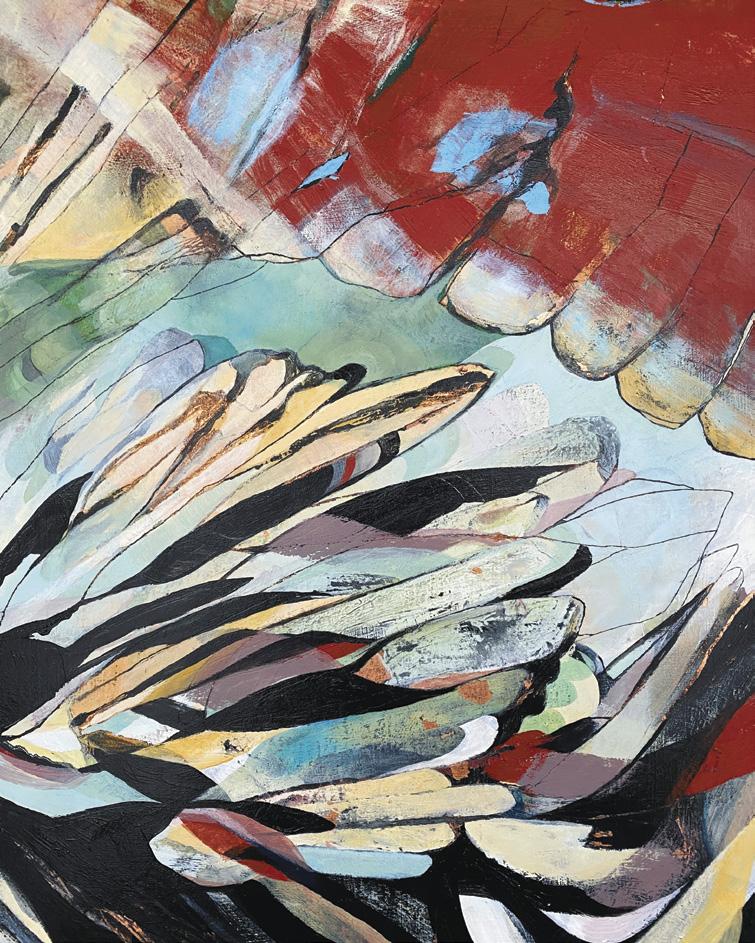
with a screwdriver and an electric sander, I incorporated copper leaf into artwork in a way I had never seen before.” She also taught herself to make handmade inks from foraged materials for The Terroir Project.
“The concept of terroir, the terroir of a person’s life; I liked the process of starting with a memory, going to the place, foraging. Then came distillation, heating, soaking and grinding.
I loved the alchemy of it all, the research. At first I was curious, and then it morphed into a very personal journey, revisiting places of great significance in my life, and making a memory into something physical, instead of it being only in my mind. All the aspects that are in each ink

are created from memory, and they become artifacts telling the story of a person’s life. In this case it’s in color, an ingredient to make the memory familiar.” With the inks, George then made drawings on Yupo paper.
“The ink is surprising; the ink on the paper, doesn’t behave like paint. I am confident with paint, but ink? It was shocking,” George laughs. “Yellow becomes red, the pH changes, I didn’t know what to expect with the ink, and this was so fun. When it dries, it is again completely unpredictable! Very different from acrylic painting.”
Reflecting on where she is right now, George states, “My husband Max and I have a beautiful partnership, he is so accepting. I am so grateful for him. He prepares a place for me when I need ten hours—he can do the mustard! I could not do what I am doing at all without him. He understands the need for deep, real space. The sense of grounding comes from this. As an artist, you need space, sometimes you need to push people away. But I am also a mother and a partner, and I am grateful for my job as an RN because it keeps me firmly rooted in reality. My art is central, and a solitary practice, but I very much need people, too.”
George’s upcoming exhibits: Regimes of Truth: Art, Power and The Making of Reality, at TAG gallery in Boston. Opening reception September 14, 2025. Rooted and Grounded, at Gallery Twist in Lexington. Opening reception September 20, 2025.
Paige Farrell is a regular contributor to Art New England, a fine wine consultant, and a ceramicist. Farrell lives on Cape Ann.
kathleengeorgeart.com
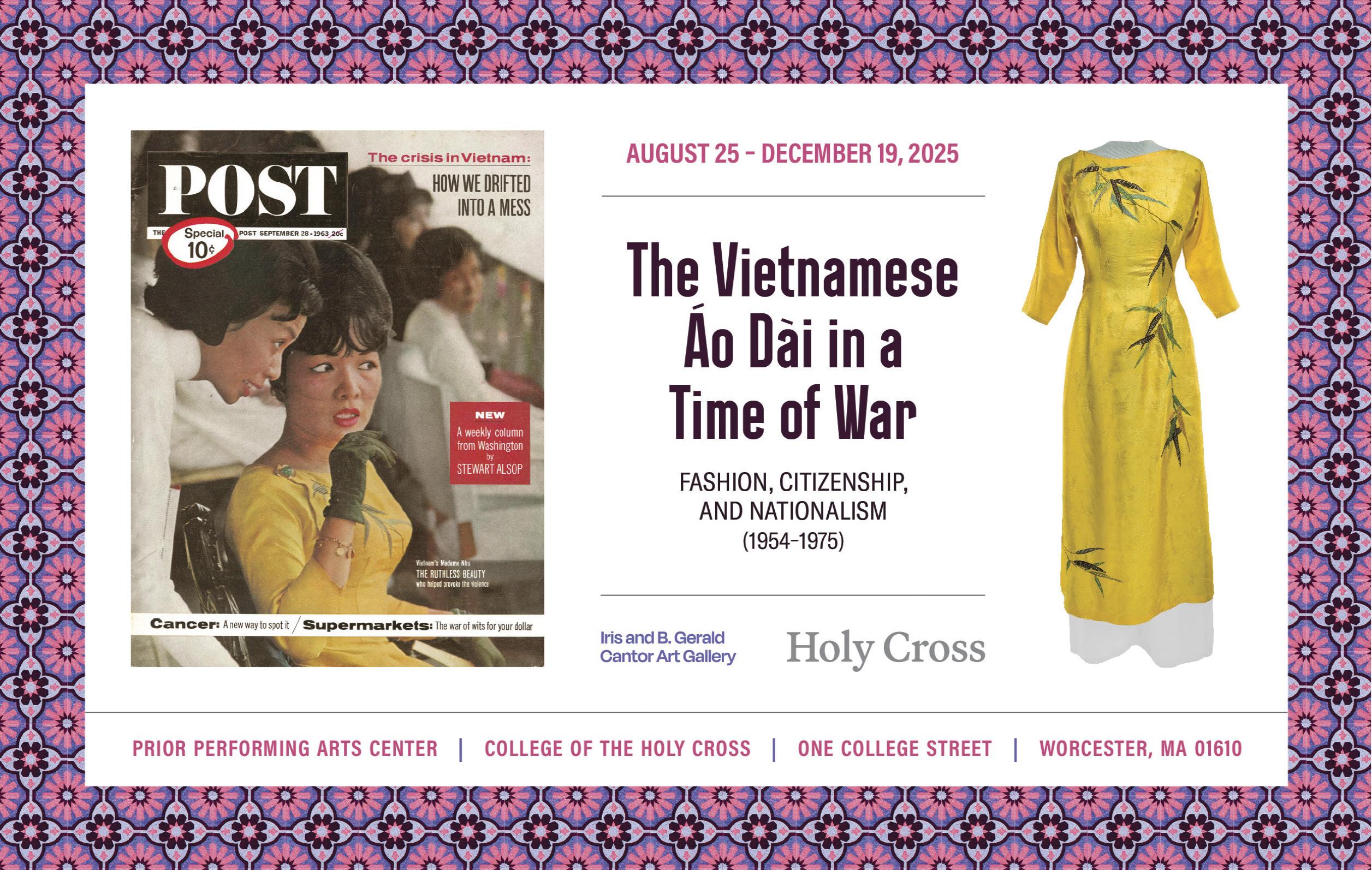



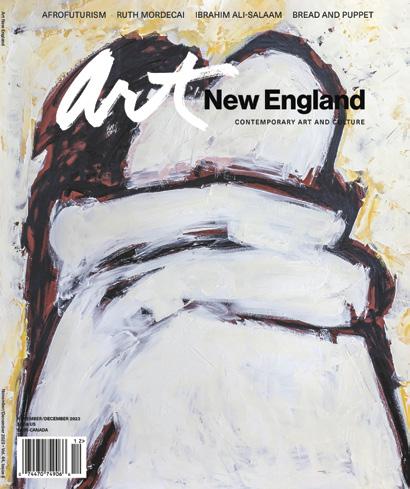

By Susan Saccoccia
Two of Greater Boston’s leading theater artists, Dawn Meredith Simmons and Maurice Emmanuel Parent, have recently moved into new roles. Their transitions promise yet more of the adventurous, award-winning productions they have been known for in their work with theater companies throughout the region as well as through their decade together as co-founders and co-producing artistic directors of the Front Porch Arts Collective. Founded in 2016, the Porch is Boston’s premiere Black theater company committed to advancing racial equity through theater.
On July 1, Simmons became artistic director of the SpeakEasy Stage Company, succeeding Paul Daigneault, its founder and producing artistic director. From its start 35 years ago with 40-seat productions, SpeakEasy has grown into a major force in Boston’s cultural life as a champion of diverse and emerging voices and the power of theater to advance social change.
At the same time, Parent became the producing artistic director of the Porch. True to its name, which evokes a communal gathering place welcoming to all, the Porch strives to increase equity, diversity and inclusion in Greater Boston theaters both onstage and behind-the-scenes through its productions and partnerships. Earning critical acclaim while bringing new talents and stories into the spotlight, during its first decade the Porch and its co-producing partners and artists have received eighteen Elliot Norton Awards.
Frequent collaborators, SpeakEasy and the Porch are nonprofit theater companies and both run robust training programs for early-career artists. SpeakEasy presents its shows at the Stanford Calderwood Pavilion at the Boston Center for the Arts. The Porch stages its productions at the Modern Theatre in Boston as well as in the venues of its co-producing partners. Their joint productions will continue and their most recent one of Jordan E. Cooper’s play “Ain’t No Mo,’” won the 2025 Outstanding Play (mid-size theater) Elliot Norton Award.
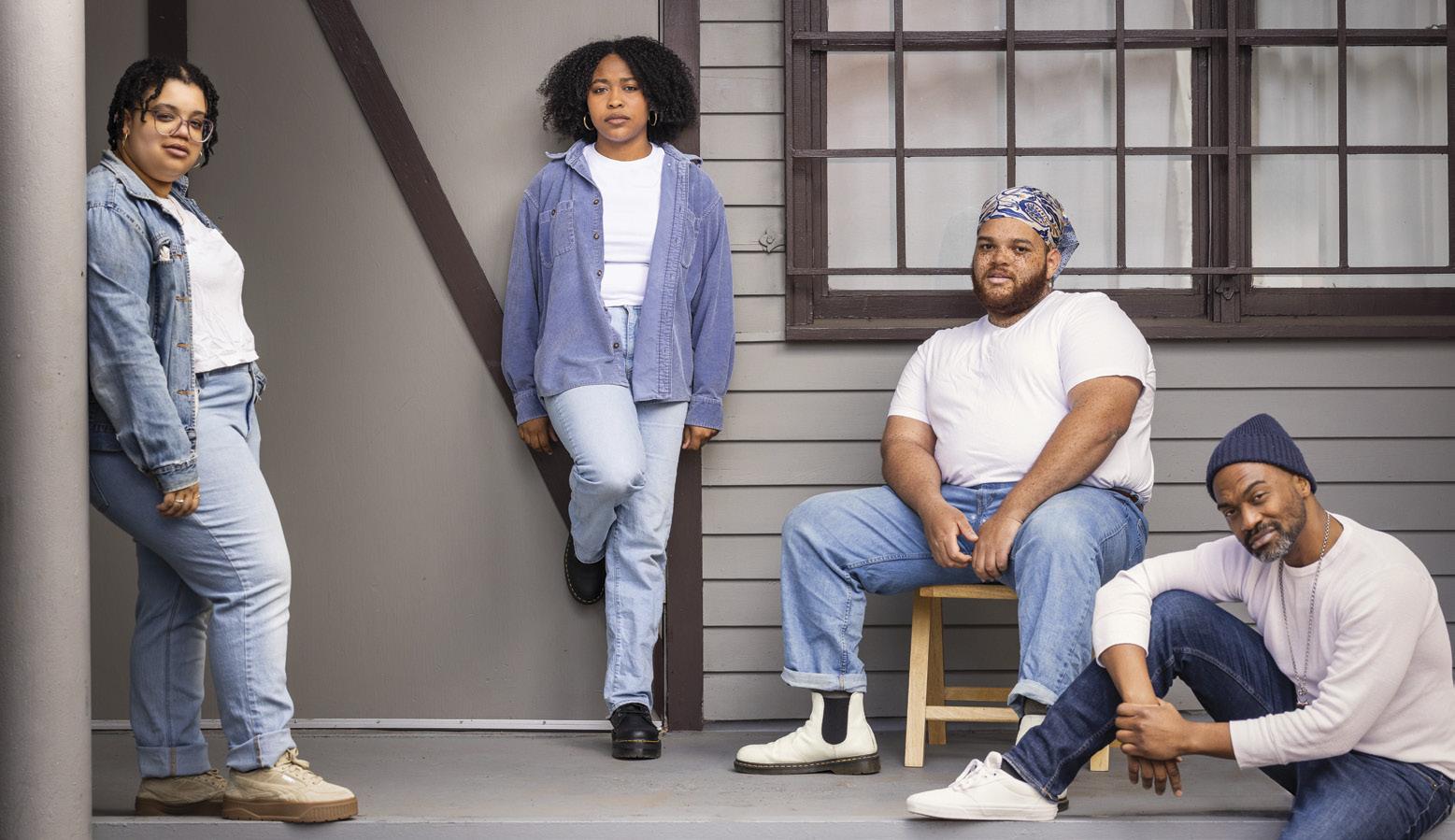
“Vibrant theater is thought-provoking and inspiring, takes risks, and honors what theater does best, which is to create a community instantaneously,” says Parent. “Each live performance invites people to join in.”
For Parent, theater has been a source of community from the start. “As a kid, acting was the only thing I liked,” says Parent. “I loved pretending to be other people. In doing plays, I found community and made friends.”
Moving from New York to Boston in 2011, recalls Parent, “I found real family here. In New York, theater was a solitary pursuit—I’d audition, fly out to do a show and return in six weeks.”
Parent is an award-winning actor, director and educator and his connections in Greater Boston are multiple and run deep. He has taught in Boston public schools and is Professor of Practice in the Tufts University Department of Theater, Dance and Performance Studies. “Porch people—artists, supporters and audiences—depend on me and I enjoy that,” says Parent. “I have students too and I really
enjoy that work as well. We’re figuring out how the Porch can become a presence on campus.”
When he and Simmons founded the Porch, they found a receptive theater community.
“Other companies saw our new Black theater company as important for this town,” says Parent. “They helped us establish ourselves.’”
Partnerships have been key to the Porch’s success. “From the start, we rejected the impulse to work in a silo,” says Parent, “and we decided to not take on too much too soon. Financially, we wanted to be smart and build things step by step.”
During its first few years, the Porch was in residence at Central Square Theater in Cambridge.
“We shared their vision that there should be more theaters here run by people of color,” says Central Square Theater executive director Catherine Carr Kelly. “Dawn and Maurice were already very well-respected theater artists when
they founded the Porch. They had time to understand what was needed, so their residency was super helpful to us. We learned a lot and I think they learned a lot from us. Their residency was extremely useful to both companies.”
The Porch’s relationships have been person-to-person as well as among companies. “During our 2019 season, Sharmarke Yusuf, then a recent Boston Conservatory graduate, was performing in ‘Three Musketeers.’ After the show, he told us that he’d injured himself. Dawn goes with him to the emergency room where she meets his mom, Carline Jean-Baptiste. Since then, Carline has come to every Porch show and she joined our strategic planning committee. Sharmarke, now an award-winning actor, and Bobby Cius, the actor who replaced him in ‘Three Musketeers,’ were both in our 2023 Huntington co-production of ‘K-I-S-S-I-N-G.’”
Parent regards the company’s abiding partnerships as a source of strength in pursuing its ambitious goals.
“After ten years, any company needs to reassess itself,” says Parent. “As we prepare for the tenth anniversary of the Porch in 2026, we’ll conduct a strategic planning process. And the size of our board needs to expand as we advance to the next level.
“Our original dream is for the Porch to become one of the largest, longest running, continuously producing Black theater companies in the nation,” says Parent. “It’s in our DNA to build collaboratively, and what gives me hope that we will achieve our goals is the people we get to work with and how they feel after working with us. We’ve created something that people both on and off stage enjoy being part of. And our wonderful donors have stayed with us through these trying times.”
Actors’ Shakespeare Project (ASP) is among the many companies Parent has worked with as an actor and director. “Maurice is a phenomenal theater artist and also an inspiring leader,” says ASP artistic director Christopher Edwards. “He adores the city and works hard to help raise all boats. He truly cares about the Boston theater community, its heart and soul and culture. He’s got a really wonderful truth and honesty about him as a person and as an artist.
“Dawn too is in high demand as a director and she’s also renowned as a leader working to make Boston a better theater town and advance equity and diversity in the artists being hired and the narratives being told. There is a gentleness and kindness in all she does and in every show Dawn directs you feel a generosity of spirit, love and joy.”
Like Parent, Simmons finds her career as a theater artist offers rewards not available elsewhere.
“The idea of a life in the theater is irresistible, coupled with a high tolerance for pain,” says
“In this moment, for me it’s variety, curiosity, wonder, discomfort, comfort, joy, adventure, and open mind, and most importantly, a desire to experience something new.”
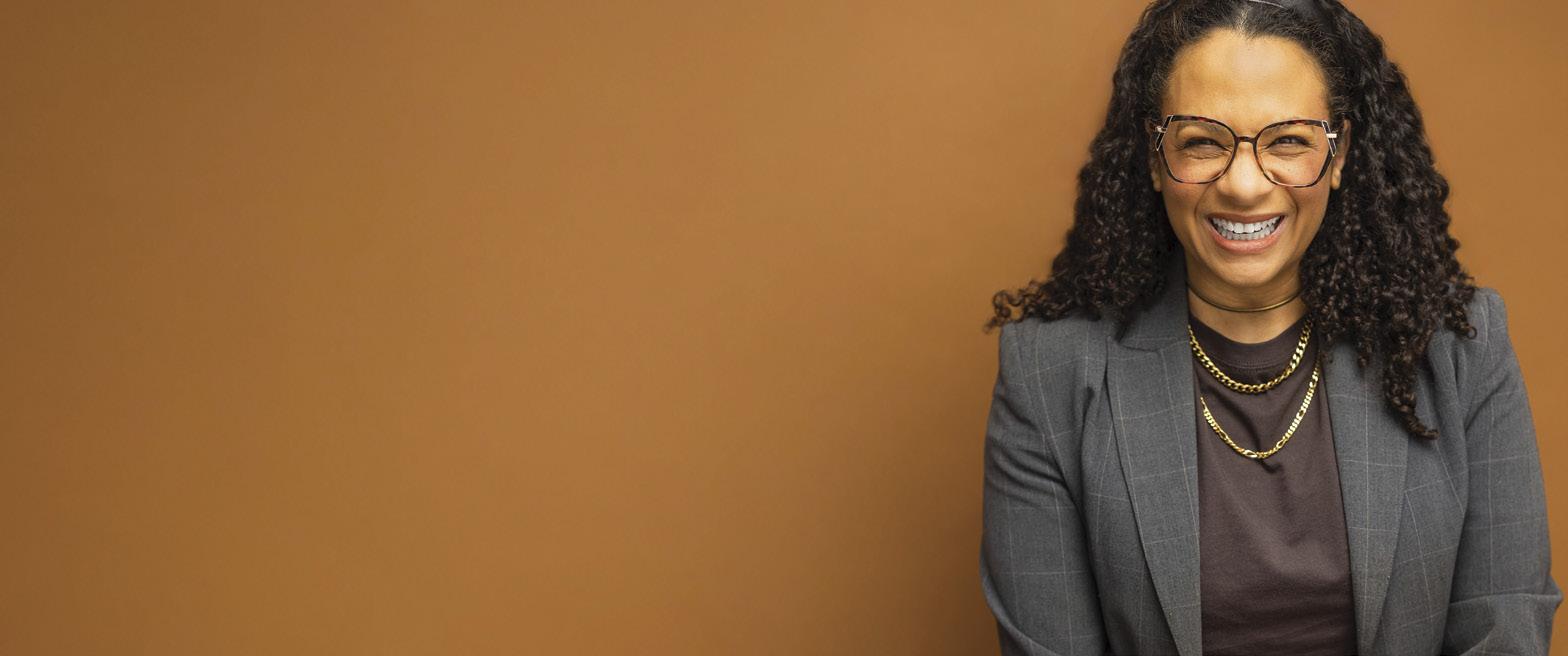
Simmons. “I’ve been able to weather a lot. I get to create entire worlds and walk in someone else’s shoes. People spend countless hours trying to get into someone else’s head. I get to explore our psyches in the most visceral ways and if you take my hand I can take you with me.”
An award-winning director, producer, playwright, administrator and cultural consultant, Simmons is also an educator. Her higher education faculty appointments include, most recently, the 2024/25 Monan Professorship in Theatre Arts at Boston College.
Noting that what makes for vibrant theater changes with the times, Simmons says, “In this moment, for me it’s variety, curiosity, wonder, discomfort, comfort, joy, adventure, and open mind, and most importantly, a desire to experience something new.”
Simmons arrived in Boston from Buffalo in the ’90s to study playwrighting with Kate Snodgrass, professor of the practice of playwriting at Boston University. While honing her playwriting craft, says Simmons, with Snodgrass “I also came to understand the differences between commercial theater and more artistic theater, and consider where my play was going to land—what kind of life it could actually have. Kate got me thinking about the business of making theater.”
Back then, Simmons found hundreds of theater companies of all sizes in Boston and shows for every taste. “There were lots of opportunities and so much to choose from,” sats Simmons. “It was a delicious smorgasbord.”
Simmons recalls with pride staging her plays “Zombie Double Feature” and “Smile” for the New Exhibition Room, the fringe theater company she founded in 2008 with M. Nora Long, as well as directing a 2012 production of the Ginger Lazarus play “The Embryos” for Fresh Ink Theatre.
From 2018 to 2021, Simmons served as executive director of StageSource, a nonprofit that focused on workforce and sector improvement in New England theater. “I feel its absence every day,” says Simmons. “There’s nothing that keeps us connected as a community in the same way.”
In the wake of StageSource, Boston Foundation Director of Arts and Creativity Catherine T.
Morris is working with Simmons and Parent and other creative sector leaders to build what she describes as “an ecosystem of support for artists of color throughout New England.” Morris, the founder of the Boston Art & Music Soul (BAMS) Fest, says “Dawn and Maurice are civic leaders as well as theater artists. They advocate for the arts as a resource to elevate all sectors.”
Simmons finds that connections are more important than ever to ensure the vitality of theater as an art and as a business.
“The Porch was born out of collaboration,” says Simmons. “Over ten years, the Porch has garnered critical acclaim and become synonymous with excellent, ambitious work, creativity and community building. We leveraged collaboration for our success and the success of our partners, infusing excitement and joy in the companies that worked with us.”
Simmons envisions a future for SpeakEasy Stage that builds on its strong foundation. “This company has an incredible track record of doing brilliant, hard, exciting, challenging work that is joyful and beautiful and poetic,” says Simmons. “SpeakEasy and the people who come to see its shows have the desire to experience something new. They want joy, they want discomfort. They are curious. They want to explore. They want to be at the cutting edge of art. So it’s our job to figure out what that is.”
What form can theater take and how to sustain it, questions she explored in the 90s with Snodgrass, need fresh answers now.
“Everybody is trying to figure out a new producing model,” says Simmons. “What is the total experience of a show? What makes it special when we walk in the door? How does it engage people on and off stage and in the audience? And how do you build a production in a way that’s sustainable? Theater can be a place where people find community. We’re riffing on that idea and figuring out what it looks like for us.”
Susan Saccoccia is a recipient of NEA Arts Journalism Fellowships in dance, theater, and music. She reviews visual and performing arts in the U.S. and overseas for regional and national publications.
By Susan Saccoccia
Greater Boston theater companies begin their 2025–26 seasons in September. Their website calendars abound with productions likely to draw return subscribers as well as new audiences into the region’s small, mid-size and large theaters. Here is a sampling of upcoming productions that promise a memorable experience of live theater.
Primary Trust
September 12–October 11 SpeakEasy Stage Company
Directed by Dawn M. Simmons, the SpeakEasy’s new artistic director, “Primary Trust” is a Pulitzer Prize-winning play by Eboni Booth that explores how small acts of kindness can change and maybe save a life. Its protagonist, Kenneth, works at a bookstore and spends his evenings at the local tiki bar.
But when he’s suddenly laid off, his carefully ordered world begins to shift—pushing him into unexpected friendships, unlikely courage, and a life he never imagined.
Our Town
September 19–October 19
Lyric Stage Boston
This production of Thornton Wilder’s classic portrayal of life in a small American town is directed by Courtney O’Connor, the producing artistic director of Lyric Stage Boston. O’Connor finds, in this timeless story of the grace in daily life, a celebration of community as we can find it in a big city such as Boston, where for decades, live productions by homegrown theater

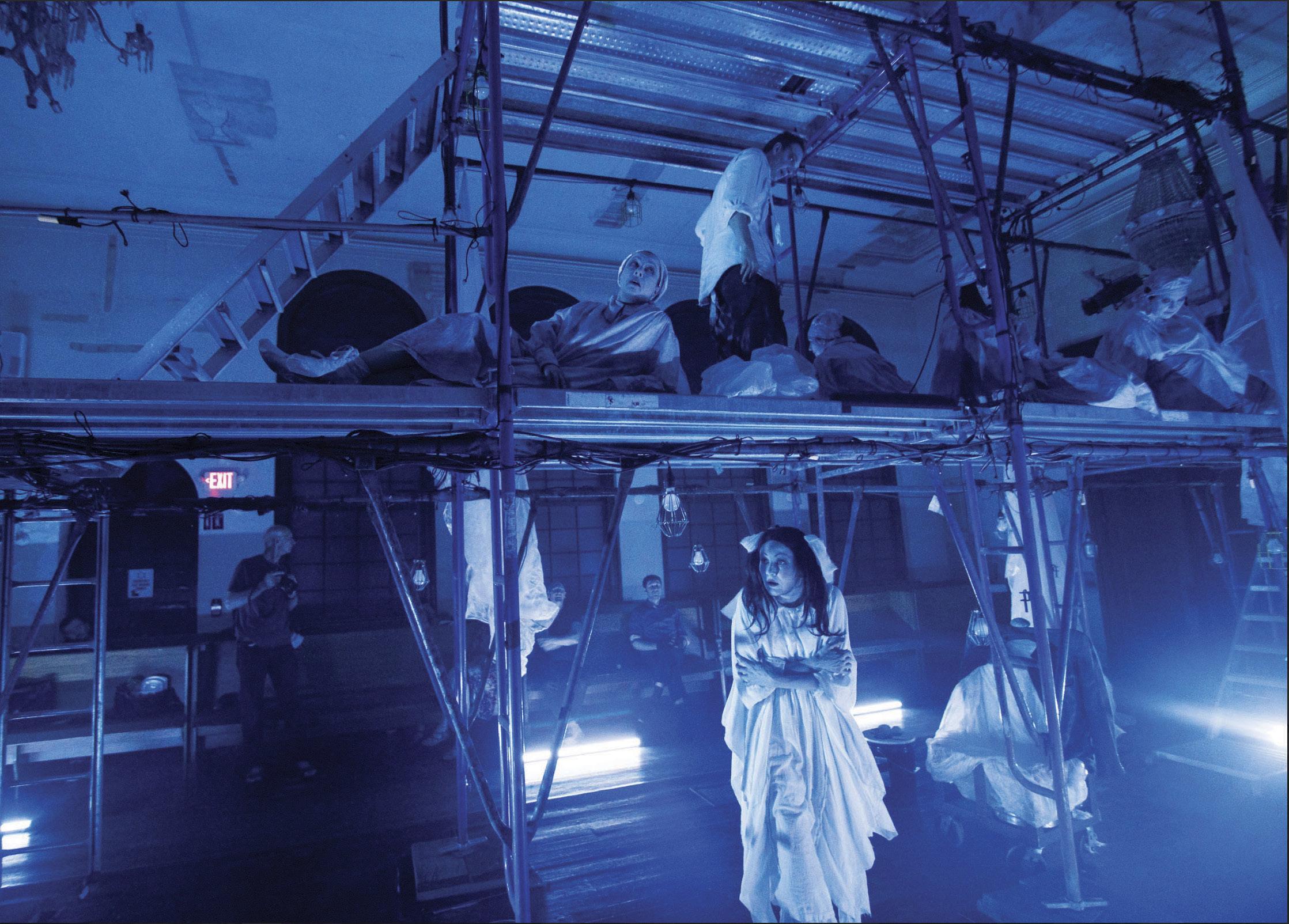
companies have fostered ties with and among audiences. “We meet every play where we are in the moment,” says O’Connor, “and see it anew. This play is not a sentimental period piece. It’s a primal scream to recognize and appreciate the beauty of life.”
October 2–26
Actors’ Shakespeare Project
Directed by ASP artistic director Christopher V. Edwards with distinguished Boston actor Omar Robinson in the title role, this contemporary rendition of “Macbeth” unfolds during the Cold War. “It looks at the idea of mind control,” says Edwards, “with Macbeth and Lady Macbeth as pawns in a secret government experiment.” Presenting Macbeth’s struggle for power at any cost as a tale for our times, this high-octane production, performed at the Mosesian Center for the Arts in Watertown, follows the Macbeths as they stop at nothing to grasp the throne and immerse their subjects

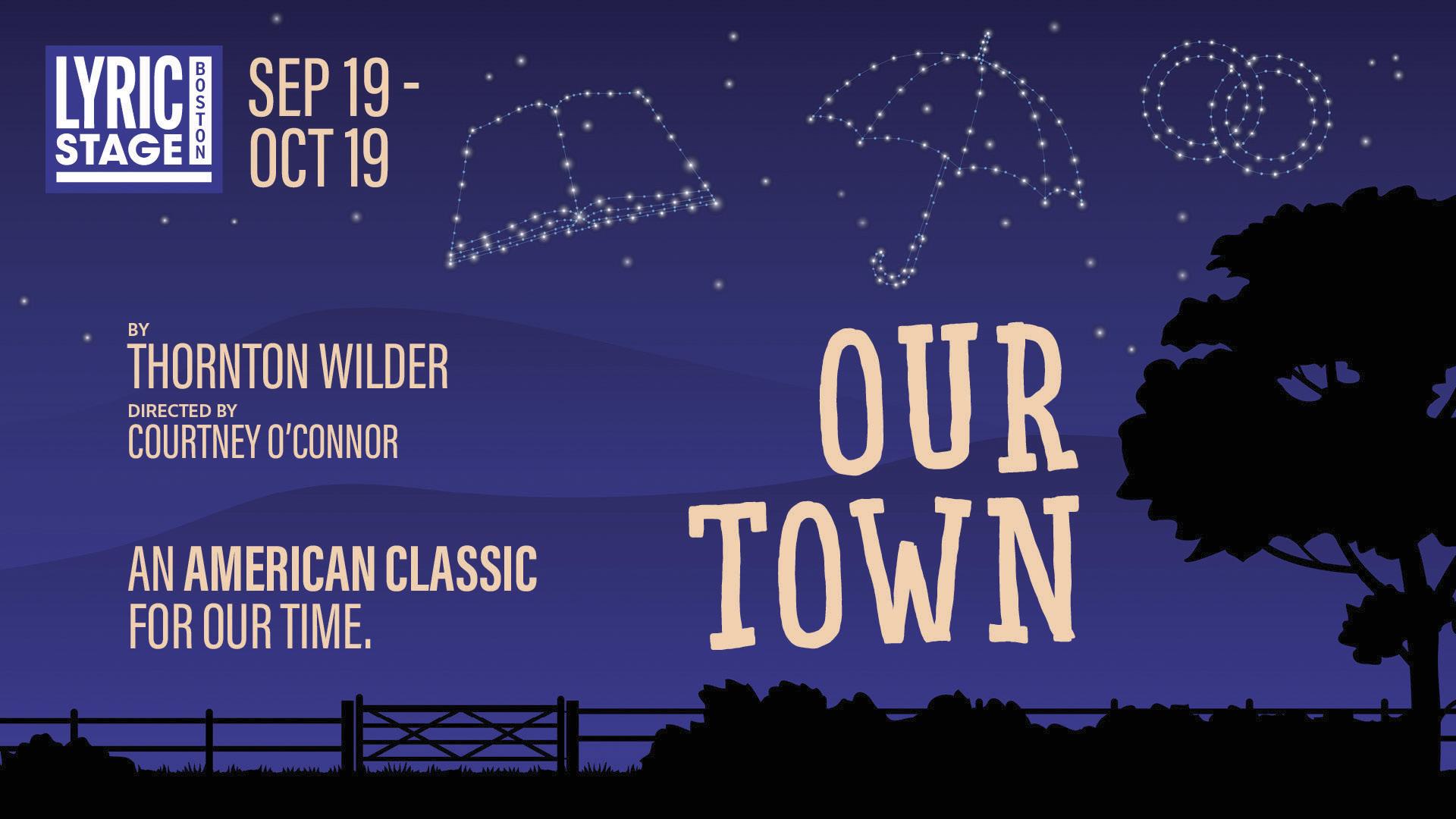
in an alternative reality of lies (couldn’t happen here). But these would-be despots slowly learn who is really pulling the strings.
Verdi’s Macbeth
October 10–12
Boston Lyric Opera
The Boston Lyric Opera sets Macbeth’s story to music by opening its season with Giuseppe Verdi’s operatic version of “Macbeth.”
Performed at the Emerson Colonial Theatre with an orchestra conducted by BLO music director David Angus, this production is directed by Steven Maler, the founding artistic director of Commonwealth Shakespeare Company, which has been staging award-winning productions of Free Shakespeare on the Boston Common for three decades. Norman Garrett performs the title role and Alexandra LoBianco is Lady Macbeth in this dark drama about unbridled ambition.
The Dybbuk Between Two Worlds
October 30–November 16
Arlekin Players Theatre
Arlekin Players Theatre, a small Needham-based theater company, first gained international fame with its Russian-language plays and later earned rave reviews for Off-Broadway and Boston stagings of novel productions featuring such luminaries as Mikhail Baryshnikov and Jessica Hecht. This reimagining of an ancient Yiddish folktale is directed by Igor Golyak, Arlekin’s artistic director. Its sold-out US premiere, staged at the Vilna Shul-Boston Center for Jewish Culture, a historic synagogue on Beacon Hill, won the 2025 Eliott Norton Award for Outstanding Play (small theater). This site-specific production returns to the Vilna Shul for an extended run.
Summer 1976
November 6–30
Central Square Theater
In a progressive Ohio college town, a faculty babysitting co-op brings together Diana, a fiercely iconoclastic artist, and Alice, a free-spirited yet naive young housewife. Written by Pulitzer Prize recipient David Auburn (“Proof”) and directed by renowned Boston theater artist Paula Plum, the play is a witty and poignant exploration of their growing friendship and how their bond triggers memories and life-changing moments.
Front Porch Arts Collective & ArtsEmerson
March 21–April 4
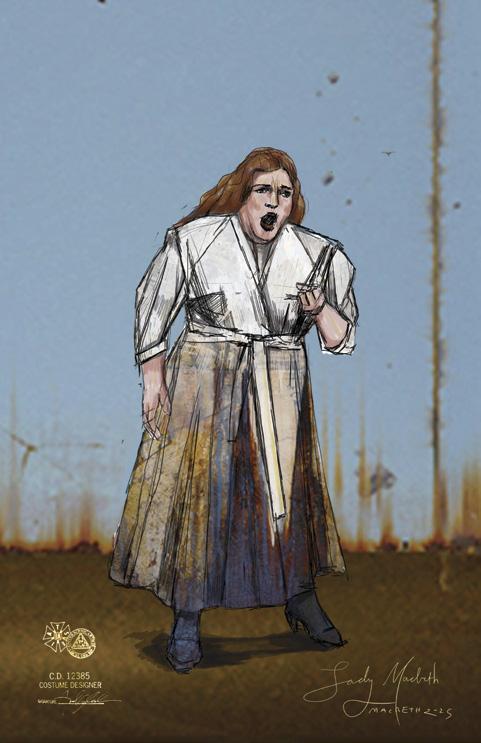
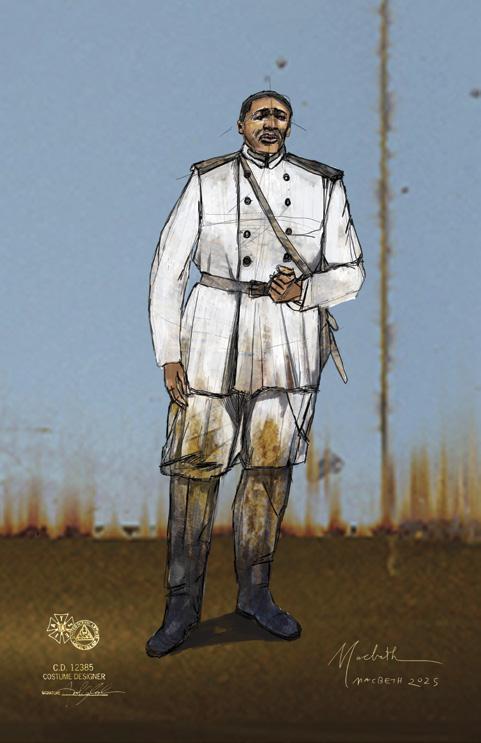
May 26–June 28
American Repertory Theater
irected by Dawn M. Simmons, “In Old Age” is the eighth play in Mfoniso Udofia’s “Ufot Family Cycle,” a nine-play series about multiple generations of an African family building a new life in Massachusetts. The cycle is being presented in its entirety over two years by a host of Greater Boston theater companies. Staged at Emerson Paramount Center, this production comes to ArtsEmerson in partnership with Front Porch Arts Collective. Family matriarch Abasiama Ufot, still living in the house of her now deceased husband, befriends Azell Abernathy, a soft-spoken, church-going carpenter. As their connection grows, Abasiama comes to a deeper understanding of love and begins yet another journey in her life.
ART will present the world premiere of this new musical, an adaptation of the 2010 Academy Award-nominated film Black Swan. Bringing this psychological thriller to life on stage, Tony Award winner Sonya Tayeh directs and choreographs a bold retelling of the story with a book by Guggenheim Fellow Jen Silverman and a score by Obie Award winner Dave Malloy. As driven ballerina Nina fights for the lead role in Swan Lake, she begins to unravel in this haunting exploration of ambition, rivalry, and the cost of perfection.
Susan Saccoccia is a recipient of NEA Arts Journalism Fellowships in dance, theater, and music. She reviews visual and performing arts in the U.S. and overseas for regional and national publications.
By Carl Little
The opening wall text for In the Shadow of the Eagle at the Abbe Museum in Bar Harbor (through October 2026) starts with these words: “As the United States commemorates its Semiquincentennial, marking 250 years since its founding, the Wabanaki people reflect on a history that predates the nation by thousands of years. Through the eyes of the eagle, we remember our past, honor our resilience, and reaffirm our enduring presence.”
The show’s title is borrowed from Penobscot writer Donna Loring’s 2008 memoir of being a tribal representative in the Maine legislature and the challenges she faced as an Indigenous woman seeking change. Loring joined the museum’s curatorial team and historian Dr. Darren Ranco (Penobscot) and Virginia Museum of Fine Arts Curator Siera Hyte (Cherokee) in selecting the work for the exhibition.
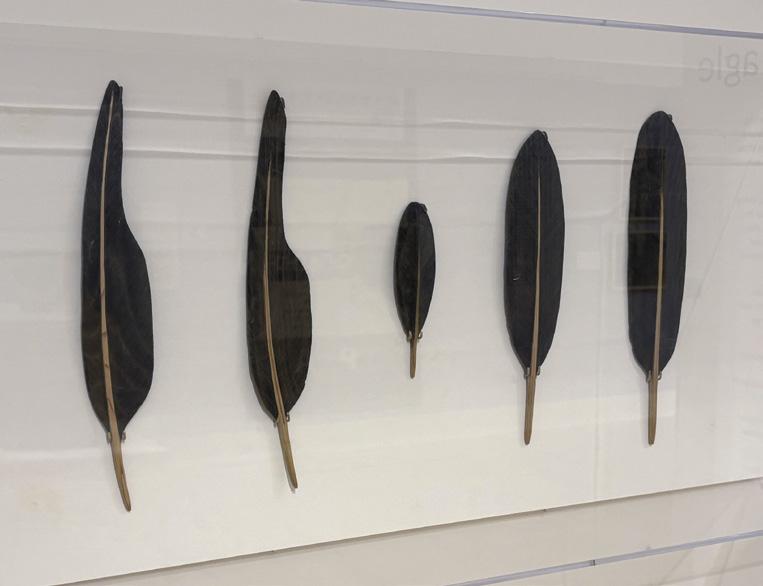

The museum commissioned several works for the show, including Penobscot James Eric Francis, Sr.’s CIRCA 6/20/1775. The title’s date refers to the day before Penobscot Chief Joseph Orono met with George Washington in Watertown, MA, to commit his Wabanaki warriors
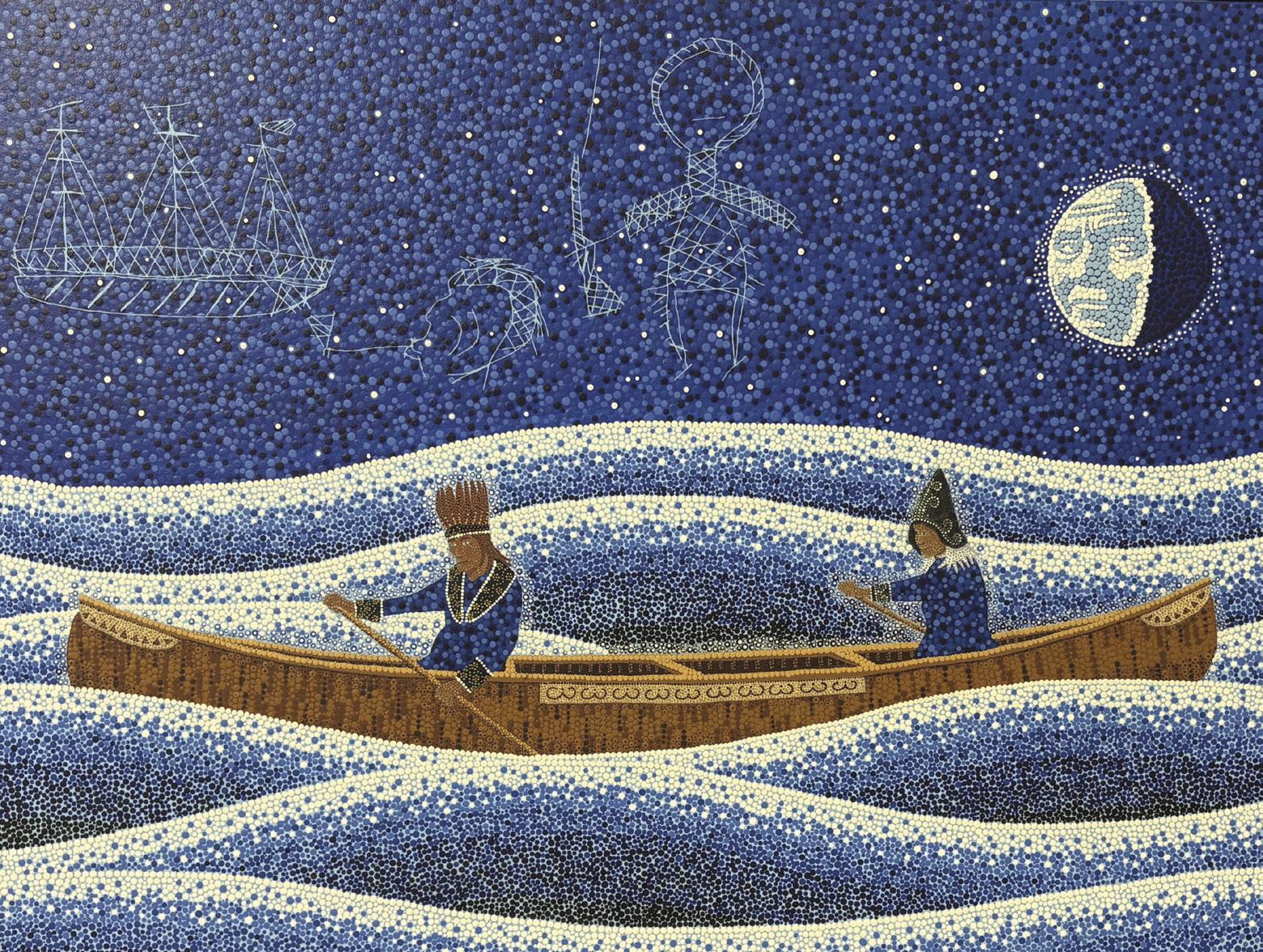
Above: Emma Hassencahl-Perley (Wolastoqey/Maliseet from Neqotkuk/Tobique First Nation), thank you for your service, 2025, cotton and glass beads. Left: Rick Love (Penobscot), Eagle Feathers, 2025, cedar. Below: James Eric Francis, Sr. (Penobscot, b. 1969), CIRCA 6/20/1775, 2025, acrylic on canvas. Opposite, from left: Maria Girourad (Penobscot), Eagle Catching the Alewife, 2024, acrylic on canvas. On loan from Donna Loring. Tim Shay (Penobscot), Circle of Relations, ca. 2002, granite and marble. All photos courtesy of Abbe Museum.
to the Continental Army. In the painting, Chief Orono accompanied by a Penobscot Clan Mother paddles a birchbark canoe. Francis’s colors and pointillist-like dots of paint, observes Hyte, communicate “a sense of connectivity between each of the painting’s elements.” Other commissioned artists include Caleb Hoffman (Cherokee), Geo Soctomah Neptune (Passamaquoddy), and Lokotah Sanborn (Penobscot Descent).
The exhibition mixes past and present. One example: two small sculptures by Penobscot Tim Shay rest on an arrangement of stone implements made by Wabanaki people between 6,000 BP and 1600 CE. As Aaron Miller, Abbe’s curator of exhibits and collections, notes, the sculptures “call out to this past, [Shay’s] ancestors, and an unfathomably deep connection to this place.”
Themes of the show include military service and treaties. Emma Hassencahl-Perley addresses these topics in thank you for your service and Ahtolimiye (she keeps praying). The former features an M64 field jacket decorated with Wolastoqey motifs, which reference the artist’s grandmother, Hart Perley, a political activist and community leader, but also the Red Power movement of the 1960s–1990s. Elsewhere in the museum, Wabanaki veterans, including Loring,
are honored in a special touch-screen presentation.
To create her Ahtolimiye (she keeps praying), Hassencahl-Perley shredded a copy of Canada’s brutal 1876 Indian Act and wove it into a Jingle Dress inspired by her great-grandmother Emma Hassencahl-Perley’s ribbon work. According to Hyte, the Indian Act made it illegal for Indigenous people “to own property, hire lawyers, leave their reserves without obtaining a pass from an ‘Indian Agent,’ or gather in groups larger than three.” It also banned Indigenous regalia, a fact that adds power to the dress on display.

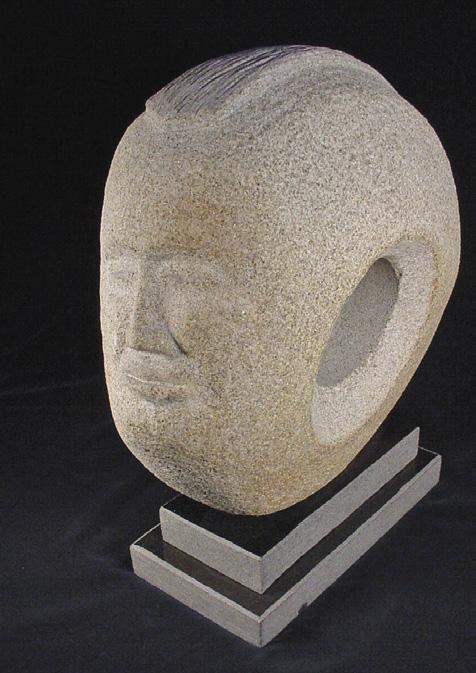
The exhibition includes a number of exquisite examples of basketmaking by Passamaquoddy craft artists Clara Neptune Keezer (1930–2016), Theresa Neptune Gardner, Doris Chapman, Eric Otter Bacon and Diane Campbell, joined by Fred Tomah (Maliseet, 1951–2018), G. Peter Jemison (Seneca) and Caleb Hoffman (Cherokee/Penobscot Descendant).
Eagles are represented in the show through actual feathers from Loring’s collection, each
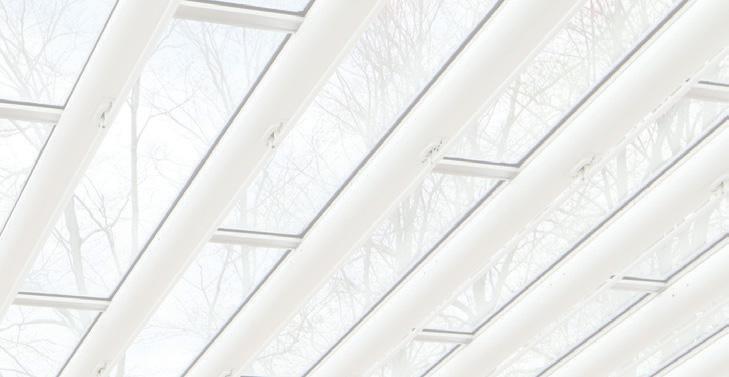

one tied to a milestone in her life, and a group of stunning cedar feathers carved by Penobscot Rick Love. The majestic bird also appears in Maria Girourad’s painting Eagle Catching the Alewife
As we mark the 250th anniversary of America, this exhibition encourages us to recognize and honor the ongoing legacy and vision of this nation’s first people. Once again, the Abbe Museum amplifies a message of art and resistance.
[Also on view at the museum: Mi’kmaw Tepgunsejig—13 Moons Full Suite by Jordan Bennett (through October 2025), stunning giclée prints by this Mi’kmaq artist along with
objects and images by other Mi’kmaq artists past and present, including exquisite quillwork by Ingrid Brooks, Vicki Sanipass, Margaret Pelletier, and Melissa Peter Paul; a recently acquired beadwork piece, the extraordinary The Land That Claims Us, by Melcolm Beaulieu, a member of the Metepenagiag Mi’kmaq Nation from Fredericton, New Brunswick; and art created by Passamaquoddy, Penobscot, Maliseet, and Mi’kmaq students from pre-K through high school in collaboration with Maine Indian Education and the Boys & Girls Club of Border Towns. The latter show is available on the museum’s website, www. abbemuseum.org.]
Carl Little’s most recent books are the monograph John Moore: Portals and Blanket of the Night: Poems. He curated “Quarries: Muse and Material” for the Monson Arts Gallery (through October).
abbemuseum.org


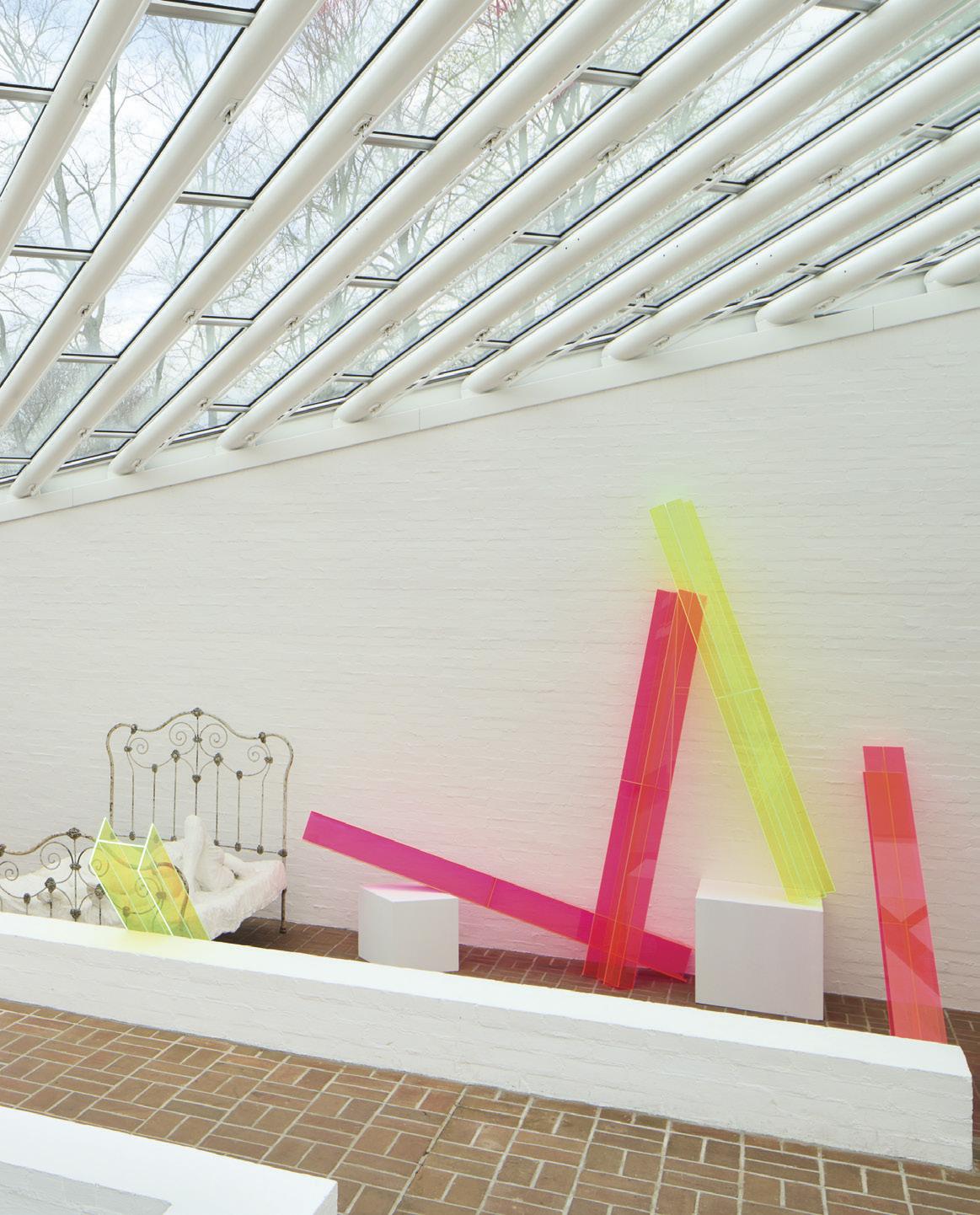

By Carl Little
In this centenary year of Cabot Lyford’s birth, the Portsmouth Historical Society has mounted a retrospective that includes a wide range of sculpture and an assortment of watercolors, a sampling that highlights his versatility and vision. From Tenements, a 1945–46 batik crayon abstraction made on Army-issue tent canvas, to a mahogany relief of a goose from 2003, the work in the show attests to an artist continually exploring new territory. The setting for the show is fitting: the greater New Hampshire seacoast area boasts a number of Lyford’s best-known public pieces, including the extraordinary 1975 My Mother the Wind, sited on a causeway on Four Tree Island in Portsmouth. Commissioned for the Bicentennial, the sculpture made from Australian granite carries the inscription, “For those who sailed here to find a new life.” As the historical society’s executive director Emma Stratton notes in the catalogue, that’s a message that remains ever
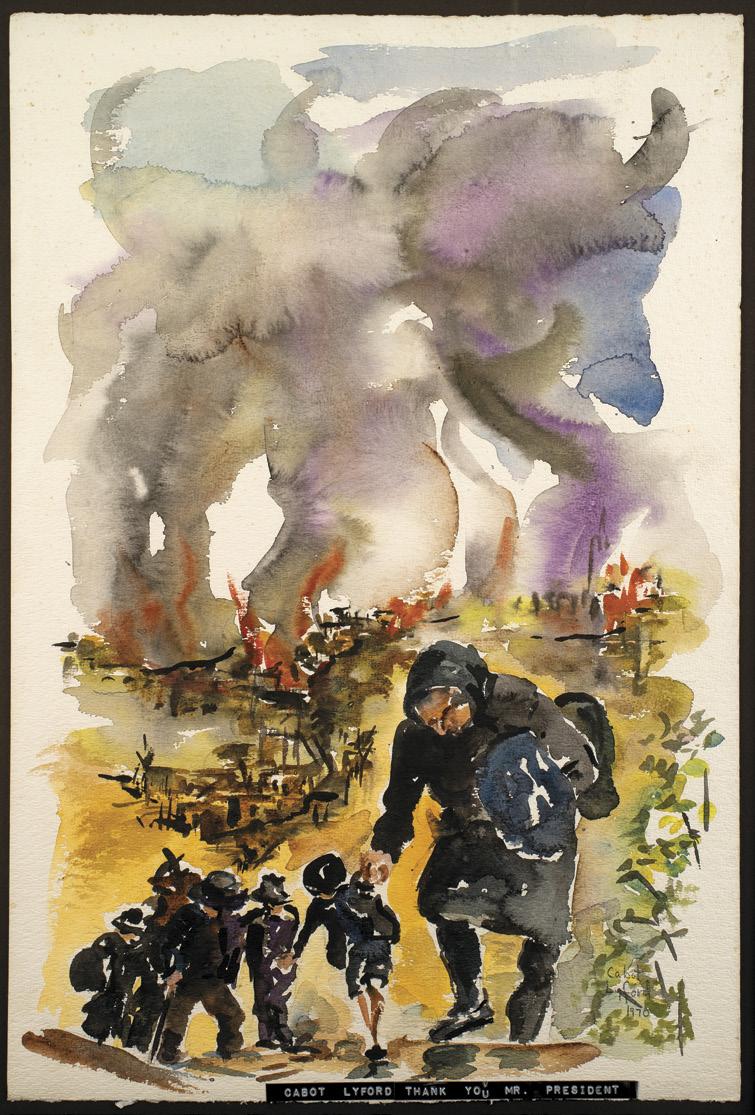
relevant in light of the current perils of immigrants in this country.
In a 1974 interview, Lyford made a connection between his two favorite mediums, granite and watercolor. Unlike soapstone, marble or oil paint, “You do them and leave them,” he said, adding “You can’t mess around, alter and adjust with ease.”
Lyford’s sculptural subjects ranged from whales and mermaids to roosters and a moth. The shy visage of a girl half hidden by her hair in Seventeen, 1972, made from a beach stone, brought to mind lines from that song “At Seventeen” by Janis Ian, “To those of us who knew the pain / Of valentines that never came.”

Curator Rachel Walls, who manages Lyford’s estate, provides biography. After serving in the Philippines during World War II, the Pennsylvania-born Lyford returned to his studies at Cornell, changing his major from architecture to fine arts. In 1947 he attended the year-old Skowhegan School of Painting and Sculpture where, with the encouragement of Charles Cutler and William Zorach, he embraced sculpture as a creative pursuit. His granite Torso from that year, included in the show, attests to his ability to bring female form out of stone.
Lyford spent years in television, producing and directing shows in New York City and then Cambridge, Massachusetts, and Durham, New Hampshire, working for educational stations in the latter locales. In 1963, he switched gears in order to return to his first love, joining the faculty at Phillips Exeter Academy where he taught for twenty-three years and ran the Lamont Gallery.
Lyford was part of a brilliant cohort of sculptors active in Maine in the second half of the last century. One thinks of, among others, Bernard Langlais, Clark Fitz-Gerald, Robert Laurent,
Edwin Gamble, Steve Lindsay, William Muir, Lise Bécu and Jane Wasey. All of them sought to make figure and form out of their materials, be it in metal, wood or stone.
The accompanying catalogue includes testimony from Lyford’s daughter, Julia, sons Thaddeus and Matthew, and jazz drummer Peter Moutis, a student of his at Philipps Exeter. Reflecting on her father’s sense of social justice, Julia Lyford Lane recalled how he “walked his talk, facilitating protests and gatherings out of his concern for our future—my future.”
A watercolor from 1970, Thank You, Mr. President, shows figures fleeing a burning village. The title is a pointed rebuke of Richard Nixon whose handling of the Vietnam War led to countless deaths and vast destruction. In a similar manner the 1990 Remembrance or Thanks, Exxon takes aim at those responsible for the devastation of the 1989 oil spill in Alaska’s Prince William Sound. The bird in black granite is a beautiful victim.
When videographer Deborah Vendetti (and this writer) visited Lyford’s studio in New Harbor to interview him some twenty years ago, he came across as the consummate sculptor, strong and committed to his materials. That said, he mentioned the wear and tear of his chosen art form, a common complaint of direct carvers who wield hammer and chisel in their mission to bring rock to life. This exhibition goes a long way toward reaffirming Lyford’s special place in the pantheon of New England artists.
Carl Little is the author most recently of Blanket of the Night: Poems (Deerbrook Editions) and the monograph John Moore: Portals (Marshall Wilkes).
portsmouthhistory.org
Through November 2, 2025

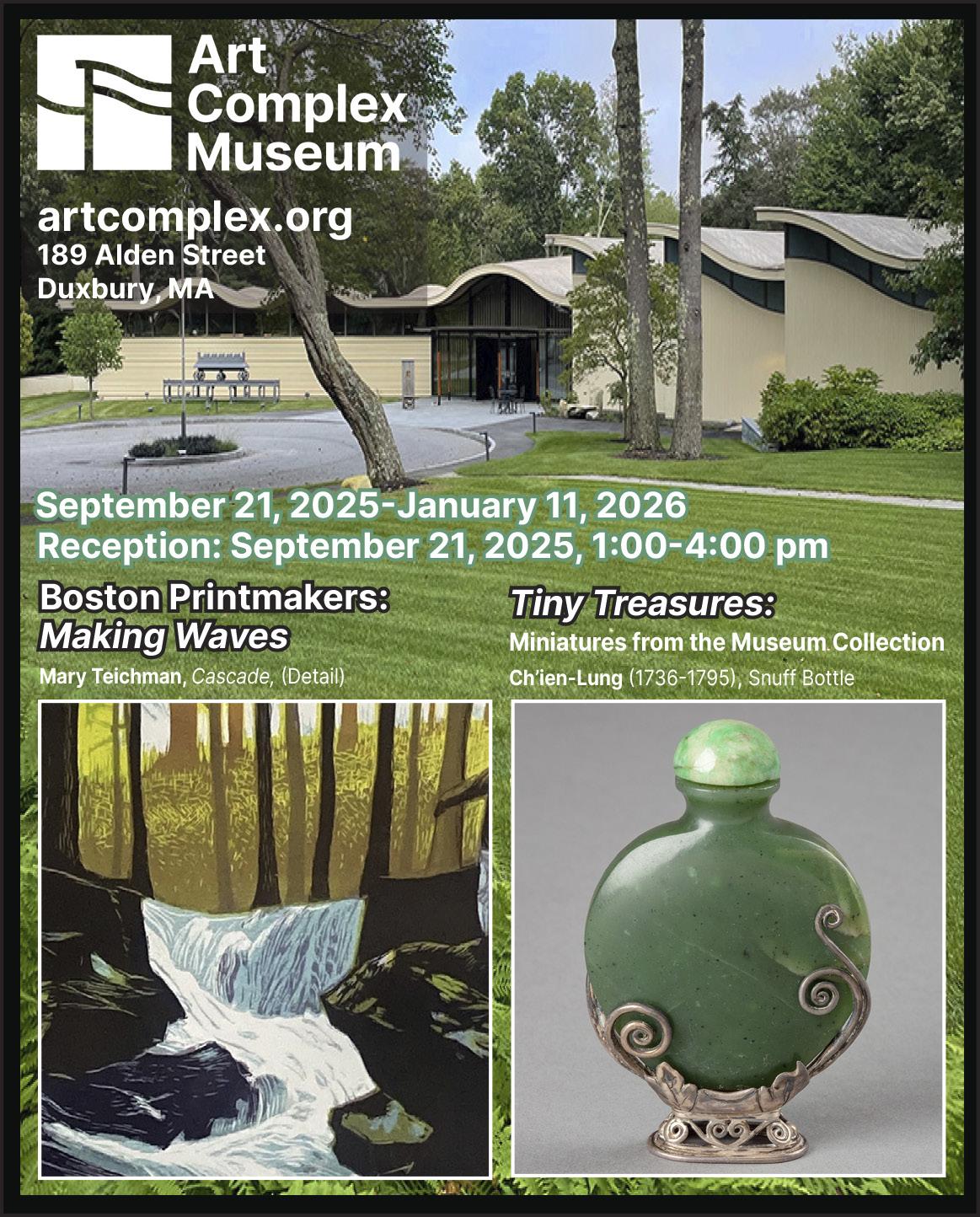

By Eve O. Schaub
It was a chilly spring day when my husband and I set out to travel back in time. We had selected a rental home with no swimming pool, no home theater, no pirate theme. Instead, our dream get-away was a dusty old house whose construction predated such modern amenities as electricity and indoor plumbing. Having packed up the car, we were on our way to the oldest Airbnb I’d ever seen: the William Haskell House in Gloucester, Massachusetts, built around 1680.
The attraction was two-fold: my husband and I are nerdy lovers of history, but we are also artists. We were working on a new body of work, entitled The Nothing There Is, which took as its starting point the paradox of the number zero: a symbol, standing in for that which does not exist. We were looking for a new and evocative backdrop in which to create our mixed-media photographic artworks, which frequently feature me as a figure in the scene. And this time capsule of a house—lovely, strange, haunting— looked perfect
When we arrived at the house, we were surprised and a little disappointed to find it nestled in a suburban neighborhood, surrounded by other homes. Something about the online photographs—depicting low ceilings and plaster walls, wide brick hearths and woven baskets—had played a subtle trick on us, and we had conjured a fantasy of colonial living that included a surrounding early American wilderness to match it.
But upon entering the house everything changed. Crossing the threshold was stepping through a portal and everything felt different. It smelled different too, like dried flowers and must, and really, really, old wood. Outside, the chill in the air had been countered by the bright sunshine, yet inside it felt clammy and dark.
Upon closer examination, the strangeness of the place increased. The layout was labyrinthine and seemed to make no particular sense: a “closet” upstairs opened to reveal a tiny bathroom (one of the few modern concessions), an uneven staircase emptied into a bedroom
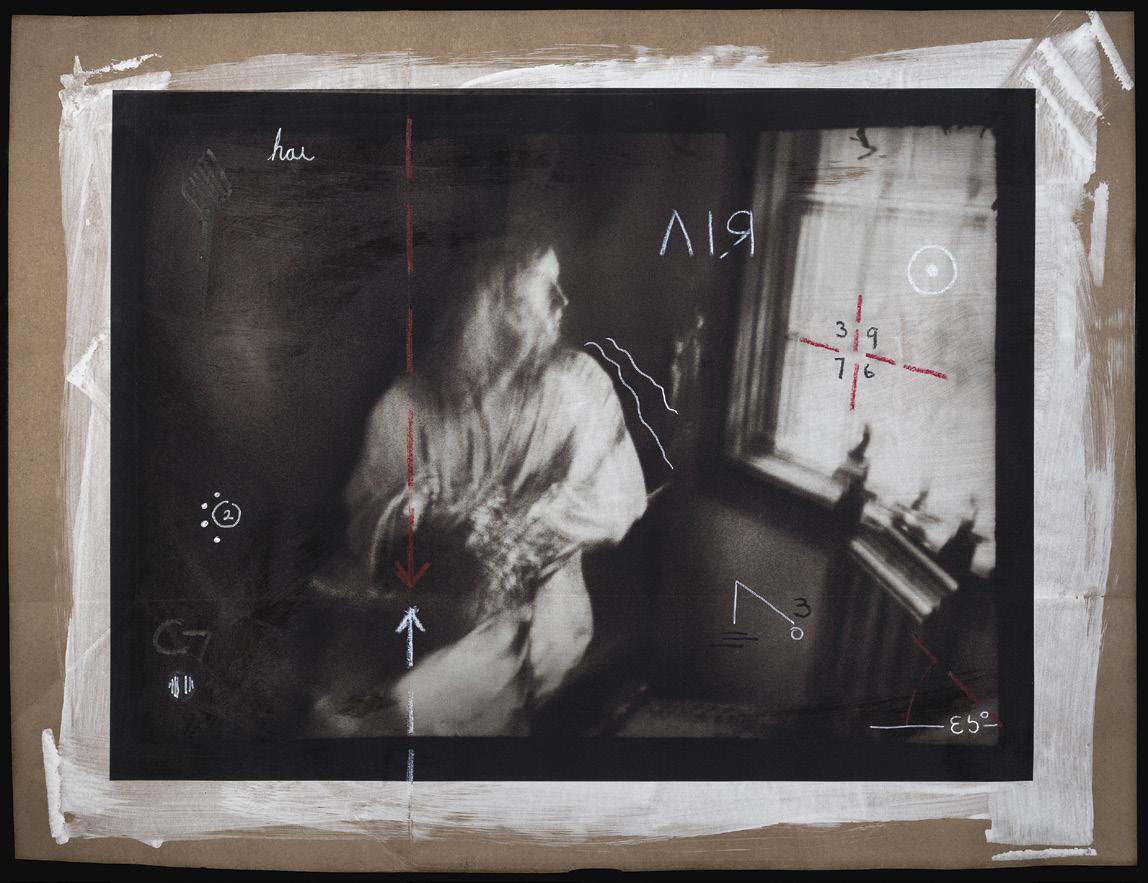
unceremoniously, another bedroom sprouted oddly off the colonial kitchen. We wandered about, exclaiming at the strange antique tools and postulating as to which architectural additions had been made when. It felt like we were staying overnight in a museum and had been given permission to touch all the exhibits.
We wondered: could we have an actual fire in the enormous historic hearth fireplace? As a matter of fact, for a small fee we absolutely could. Sitting by the hearth light that night with my knitting, leaning closer so I could make out stitches with the help of a nearby candle, I was struck by the utter stillness of the house. It was serene. It felt lonely and beautiful. It was as close to 1680 as I imagine I will ever get.
At same the time I noticed that the William Haskell House had what I can only call a feeling about it. A presence. As we went about our days, photographing in the house, I had the sense of not just being transported to the past, but also to a place filled with the stories of human lives, elation and pain, birth and death.

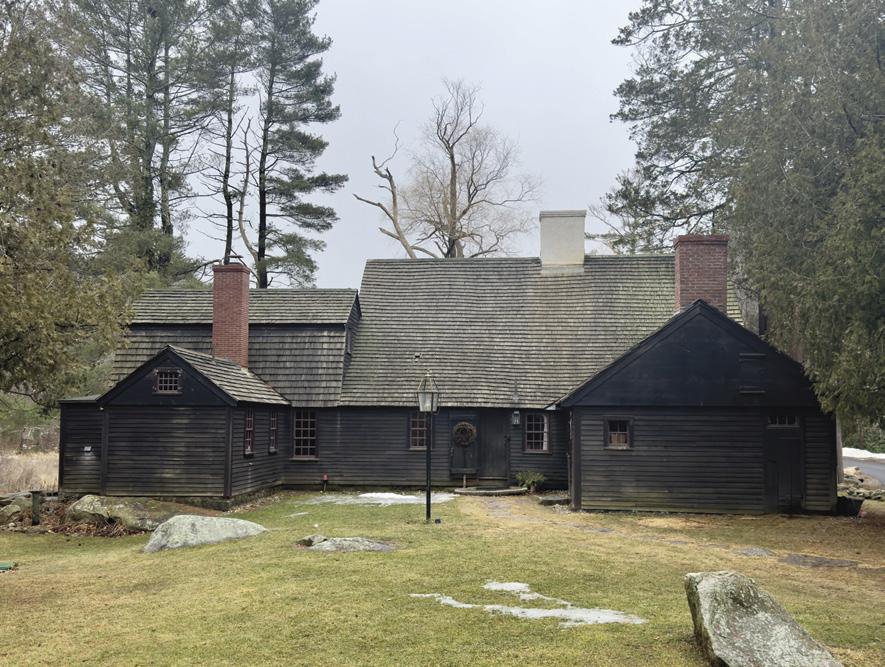

It felt… full. As I stood still for the camera, I felt a strange duality: I was myself, but I also felt those women who had come before me.
Then that night a strange thing happened. Outside the wind had picked up and the house was making the noises that very old houses make. I awoke to a sound like someone rapping deliberately on a door, but it subsided, and I persuaded myself to go back to sleep. In the morning my husband turned to me and asked if I remembered him waking up in the middle of the night. No, I hadn’t.
reportedly, the inhabitants of the Haskell House had no connection to the Salem Witch Trials, though being only sixteen miles away, they must have known about it. I tried to imagine the fear and hysteria such events must have induced.
In the new artworks that Steve and I are making, we draw cryptic symbols in wax and pigment: arrows, compass-like grids, numbers, and letters; the colors we employ are the symbolic hues from fairy tales: red as roses, black as ebony, white as snow. The idea is to conjure the crossing of boundaries: between presence and
Was that what it was that I was feeling? A reverberation of the past, all those many lives? Or… just the power of suggestion? I imagined all the home’s previous inhabitants, dozens or perhaps even hundreds of people all existing in the house at once, packed in as shadows, or echoes, overlapping one another.
He had been awakened suddenly by a creaking that surely was the wind in the ancient house timbers but sounded like a cracking human voice. A woman screeching: “CRAAAA-DLE.”
He had bolted straight up in bed. “My legs couldn’t stop shaking!” he said. “You put your hand on my back and told me to go back to sleep.”
“I did?” I had no memory of any of this, which was good, because otherwise I’m quite sure I would have spent the rest of the night in the car.
It occurred to me that visiting the past is all fun and games until someone encounters a ghost.
Don’t get me wrong. I’m not a person who believes in the paranormal. But, as I thought about the “voice” the next day, it wasn’t lost on me that we were really quite close to Salem, Massachusetts, and that the home in which we were staying dated to the time period of the famed Witch Trials. So, of course, I looked it up:
absence, between void and possibility. We are meditating on the human search for significance—bewitching, elusive, spiritual.
So, as it turned out, it was altogether fitting that we found ourselves exploring the psychic space of the late seventeenth century. Reading the website of the Salem Witch Museum, I was reminded that “magic” at that time was very real, in the sense that people regularly sought to influence the world around them through ritual, folk wisdom and storytelling. Protecting one’s home, curing the sick, and predicting the future were all reasons to turn to such magical forces, despite such practices being discouraged by the church. In fact, in 1692 when the first two girls in Salem became “bewitched,” a “witch cake” incorporating the girls’ urine was prepared and fed to a dog in an attempt to undo the spell.
Associating such practices with the devil was a way for the Puritans to make sense of those who used symbolic language, folk wisdom, and ritual. Put another way, both the Puri-

tans and the practitioners of magic were trying to control an uncontrollable and frightening world, in which strange, inexplicable things happened all the time.
Which makes me wonder: Are we not doing the very same thing 300 years later? Is the making of our art yet another magic ritual, another symbolic story, trying to make sense out of an often nonsensical world?
Our work explores the image as a vessel, resonant with meaning: that which is understood, yet also that which may never be fully understood. Like hieroglyphics before the discovery of the Rosetta Stone, a visual language may be both potent and obscure, representing a paradoxical multiplicity of meaning. This theme, I realized, was echoed in the vessel of the William Haskell House itself. The house was the ultimate palimpsest.
Was that what I was feeling? A reverberation of the past, all those many lives? Or… just the power of suggestion? I imagined all the home’s previous inhabitants, dozens or perhaps even hundreds of people all existing in the house at once, packed in as shadows, or echoes, overlapping one another. I still don’t believe in ghosts, but now I do wonder: is it possible for a house to hold history in ways we don’t understand?
The largest bedroom in the William Haskell House is on the first floor and has a wide brick hearth of its own. Close by sits one of many period antiques in the house, a boxy colonial-era cradle. As I passed it on the day we left, I must confess, I gave it a rather wide berth.
Eve O. Schaub is an author and artist living in Vermont. She makes artworks with her husband under the name EveNSteve. Her most recent project is growing a dress in her backyard, which you can follow on IG or FB: @eveoschaub
By Charles Bonenti
After word went out last spring that the Trump administration intended to cut the National Endowment for the Arts from the federal budget, a wave of NEA notices swept the country. Applicants were told their grants were withdrawn or terminated, even if already approved or spent, because the projects did not reflect “the nation’s rich artistic heritage and creativity as prioritized by the President.”
Established in 1965 as an independent federal agency, the NEA reportedly awarded more than $163 million in grants in 2024 out of a budget of $207 million.
The shock wave left hundreds of cultural organizations, nationally known or not, scrambling to cover the shortfalls.
Among big names in New England, the Clark Art Institute in Williamstown reportedly lost $30,000 for an outdoor sculpture exhibition featuring six international artists. The show opened anyway as the Clark sought private donations to make up the difference.
Mass MoCA in North Adams saw $50,000 for a massive installation by a queer artist withheld after the money was already spent. It was appealed.

Jacob’s Pillow in Becket lost a $70,000 grant for dance presentations in its Doris Duke Theater rebuilt after a disastrous 2020 fire. Artistic director Pamela Tatge told reporters in May that the season would go on.
By far the greatest burden fell on hundreds of community theaters, orchestras, art centers, cinemas, arts-education organizations, and small publishers that make up the majority of the NEA’s beneficiaries. Projects in New England ranged from a play about teens in public housing and music programs for youth to a Salvadoran adaptation of Hamlet. Only a few presenters responded to interview requests.
The Eliot School of Fine and Applied Arts in Boston had already hired an artist-in-residence to teach career skills to a dozen selected students over the summer when word came that its $25,000 NEA grant had been rescinded.
Headmaster Scott Evans filed an appeal, but by mid July said he’d heard nothing back.
To cover the shortfall, he said money was pulled out of the operating budget and donors to the annual spring appeal were asked to give more. The drive raised $37,000.
Looking ahead, Evans expects federal funds for the arts will continue to disappear as resources go elsewhere. He anticipates a strategic realignment of his staff to implement planned giving, secure more grants, and boost gifts from existing donors. With the school marking its 350th anniversary in 2026, he is counting on the celebration to bring higher visibility to its mission and needs.
Quick thinking and persistence played roles in restoring a $23,000 NEA grant for apprenticeships offered by the Maine Crafts Association. The organization sponsors programs to connect artists with one another and advance individual studio and business practices.
Notified in January that the grant approved last November was frozen, even though apprenticeships were to begin in March, executive director Whitney Gill successfully sought an “emergency grant” from another funder to bridge the gap. Then she became “a squeaky wheel” sending messages weekly and getting no response.
When interviewed in June, she excitedly reported that the NEA grant came through.
“It was never canceled, but stayed in limbo,” she said, and apprenticeships began as planned.
Ashleigh Gordon, artistic director of the Boston-based Castle of Our Skins organization that celebrates Black artistry through music, said: “We received a $120,500 ArtsHere capacity-building grant that, over two years, was to support strategic planning, program evaluation, accessibility training with a local disability consultant, and staffing needs.”
“Half of the grant,” she explained, “was remitted already in FY25 ($60,250). The remaining amount, as well as the ArtsHere program, has been cancelled.
“We are moving forward with the strategic plan,” she went on, “re-evaluating our timeline for the remaining capacity-building work and engaging other funding partners to help strategize next steps.”
Castle of Our Skins is also a co-producer, with designer Daniel Callahan and the Arnold Arboretum of Harvard University, of the MassQ Ball, an outdoor, family-friendly event celebrating the diversity of Boston’s communities of color. Last held in 2022, it was already scheduled at the Arboretum for October 4 this year when a $20,000 NEA grant application was canceled.
The sum, about 15 percent of the total $130,000 budget for the event, was more than
recovered, Gordon said, through a crowd fundraising campaign that brought in $20,150.
Long term, she went on, “We’ve reached out to several organizations, both for- and nonprofit, including local banks, media outlets, foundations and churches. Our plan is to keep reaching out.”
By far the greatest burden fell on hundreds of community theaters, orchestras, art centers, cinemas, arts-education organizations, and small publishers that make up the majority of the NEA’s beneficiaries.
Beyond private resources, city and state governments continue to support the arts. Massachusetts, for example, appropriated $27 million for arts and culture for FY26. And the federal
outlook may change with future presidential and congressional elections.
For individual artists whose paths forward may seem lonely and ambiguous, Assets for Artists, a North Adams-based nonprofit that provided invaluable assistance for this report, offers training in professional and financial skills to help New England artists advance their creative practices.
“A4A now serves over 1,000 New England-based artists per year and is poised to take its work to even greater scale in the coming years,” said director Blair Benjamin.
MassQ Ball co-sponsor Callahan concluded optimistically saying: “I’m beginning to see this de-funding as less of a threat and more of an opportunity, a chance to prove to ourselves, and each other, that even in the face of budget cuts, divisive policy and cultural erasure, we the people still have the power to come together to co-imagine and co-create a better world.”
At press time, word came that the U.S. House and Senate were working to replenish funding for the NEA as long as grant applicants abided by the guidelines established by the president. Stay tuned.
Charles Bonenti is a freelance art and architecture critic who lives in Lenox, MA.

On view August 30–November 29, 2025
Explores how photography plays a pivotal role in bridging the personal and political, offering a lens through which kinship can be recognized, claimed, and contested.

Guanyu Xu, RR-0821201005012021, 2021, archival pigment print; Canson Platine paper. Purchased through the Elizabeth and David C. Lowenstein ’67 Fund; 2025.1.1. Image courtesy Yancey Richardson Gallery. © Guanyu Xu 徐冠宇 hoodmuseum.dartmouth.edu
By Emily Avery-Miller
The title Human Marks: Tattooing in Contemporary Art is aptly deceptive. Start to unpack those simple terms and they quickly open up an expansive and complex realm of possibilities. Similarly, the practice of inscribing flesh with ink only scratches the surface of what this 8th International Distinguished Artists Symposium and Exhibition (IDASE) at Hartford Art School is about, and why it is so apt for revival of IDASE after an eleven year hiatus. In this moment of simultaneous pain and potential, tattoo artists are literally redrawing the lines that have bounded aesthetic and cultural norms; they’re mapping the way to an expansive, inclusive, and liberated future, in their studios and on our skin.
The mark of tattooing on human history is a self-inflicted one, and thus by definition it covers
the span and scope of our existence, taking on all of the shades and shapes of what humans can do to each other: the most sacred care and the most traumatic pain.
The initial inspiration for Human Marks started locally and recently, as curator Carrie Cushman saw tattoos and tattooing showing up at Hartford Art School, on students’ skin and on their resumes. She saw a tapestry of designs meandering the halls, and discovered that many people were matriculating in art school with the explicit intent to develop their tattoo design portfolios.
The physical presence and professional influence of tattooing in a fine arts institution runs counter to stereotypes and taboos that prevailed in the previous few decades, at least among a Judeo-Christian, white culture in the U.S. For example, from the 1960s to 1990s, at the time that some of the artists in the show were beginning their careers and/or pursuing art school degrees, tattooing was outright banned in New York City. As recently as 1999, the American Civil Liberties Union of Massachusetts brought—and won—a case challenging a state law that made it a crime for anyone other than a physician to give tattoos. According to the ACLU of Massachusetts, at the heart of the decision was Judge Rouse’s assertion that “the act of creating expressive material ‘is intrinsically part of the expressive content of the art.’”
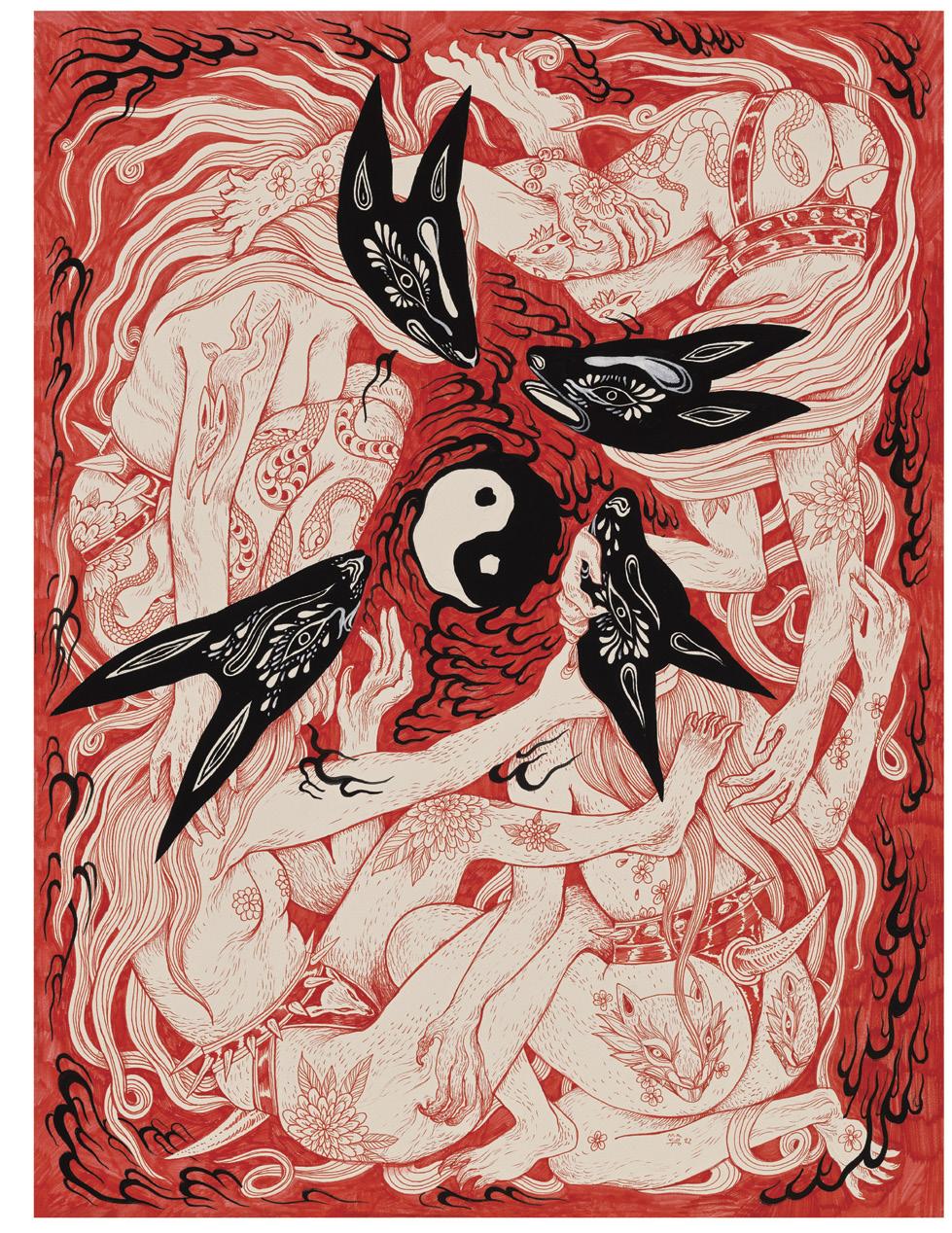
Tattooing is art. Human Marks features some artists who are considered pioneers of that now-popular assertion. Don Ed Hardy, for example, famously initiated publications, exhibitions and public conversations that helped bring tattooing into the realms of the critical art world in the U.S. and beyond. Over the decades since, an increasingly diverse and
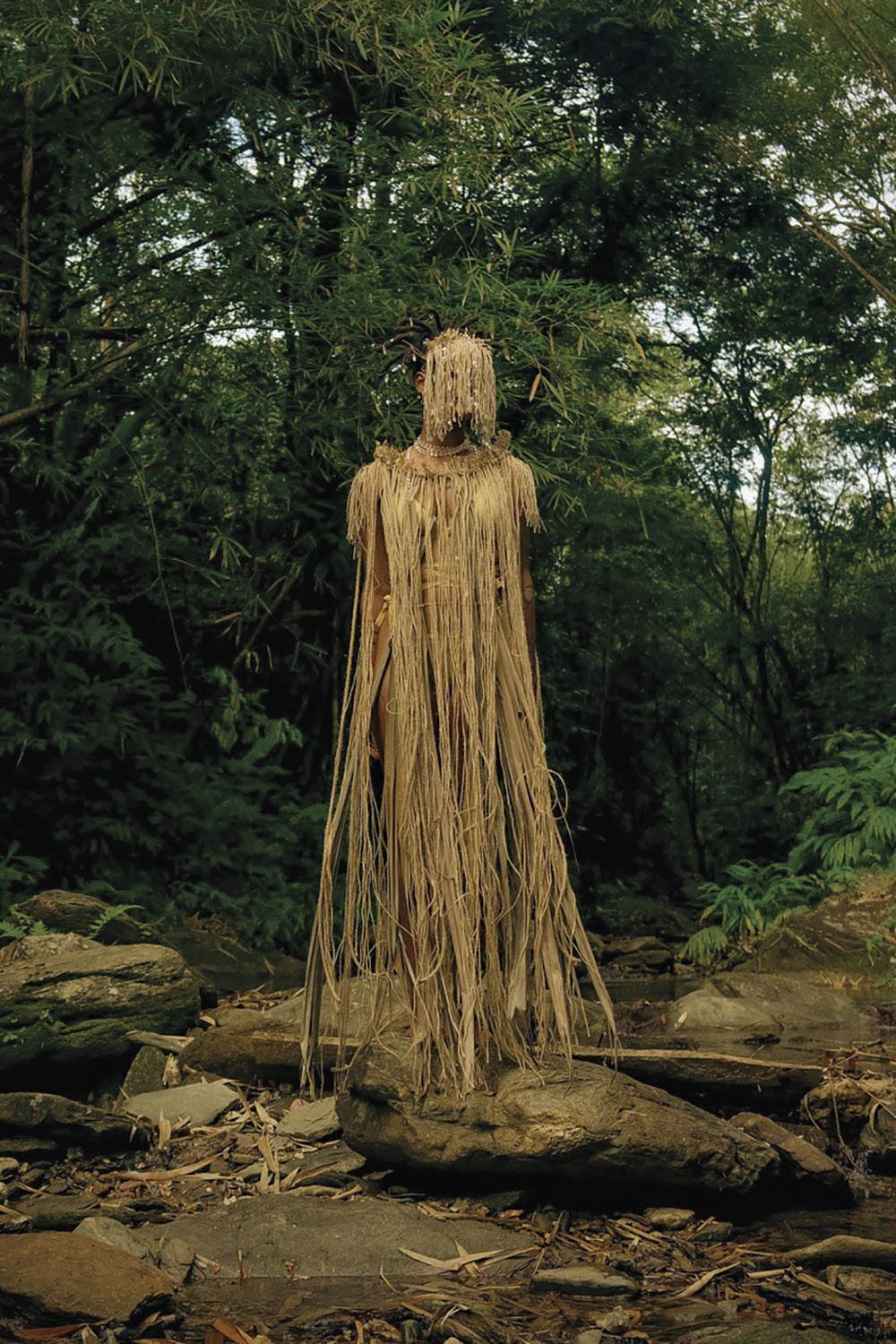
Above: Gesiye, Now That I’m a River: Shapeshifting, 2023, inkjet print, 11 x 17". Courtesy of the artist. Left: Makoto Chi, A Prayer for Vengeance and Surrender, 2022, ink and gouache on paper, 24 x 18". Courtesy of the artist.
amplified chorus of voices have echoed the vast creative and social importance of tattooing. The door has opened for artists and critics to move beyond legal and aesthetic debate about whether there is art in tattooing and to enter a much more expansive and rich celebration of where and how tattooing shows up in art.
Human Marks is devoted to fostering and developing that conversation. It includes a book with profiles of 15 featured artists from around the world, plus interviews and essays; a symposium slate of interactive, public art events; and of course, galleries full of artwork representing a full spectrum of technical and conceptual approaches.
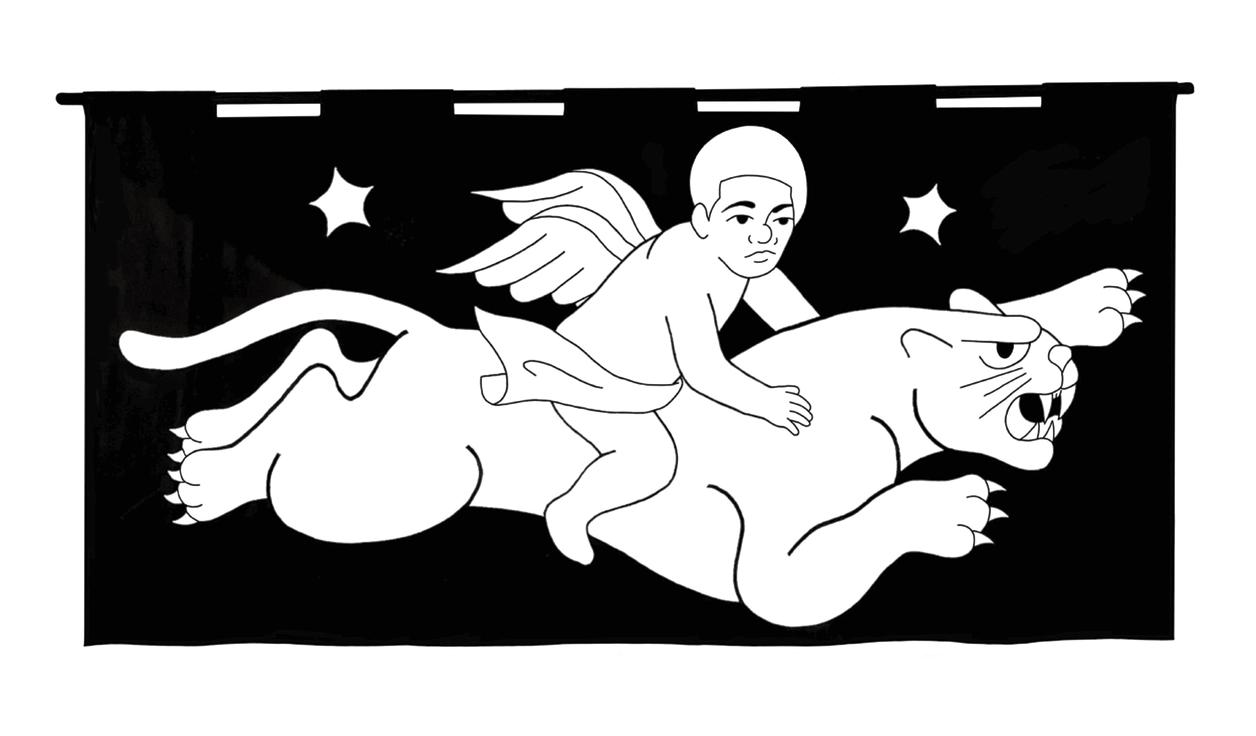
Evan Paul English’s Collected Memory I (2025), one of six pieces commissioned for the show, is a rainbow unto itself. The five-by-four-foot quilt is a brilliant colorful collage made from the paper towels that he uses to wipe blood and ink from people’s skin during a tattooing session. In English’s words, “The work draws on the visual language of patchwork quilting, invoking associations with domesticity, community, and the history of the AIDS crisis.” It’s also a vivid homage to how deeply and also viscerally his clients, whom he referred to in an interview as “patrons,” contribute to English’s creative practice. The quilt, and many of the designs he inks, literally would not exist without them.
English also makes studio work that does not directly incorporate or represent tattooing, although motifs and techniques, like floral patterns and domestic materials, definitely appear in both. For other featured artists, the influence of tattoo in their practices takes on forms as varied as the designs they ink. Most note that these influences change intensity and shape over time.
Jayna Won, for example, is a well-known figure in contemporary tattoo culture as the co-founder of Angel Kisses in Los Angeles, a tattoo studio with a prominent role in the QPOC community. According to her artist profile for the show, Won started tattooing in order to help pay for art school, and it turned out to be a financially and creatively fruitful pathway for her. She’s recognized for iconic, sought-after tattoo designs such as renderings of women’s hairstyles, but she highlights that she also values art created purely for the sake of expression. Her multimedia experiments, such as UV-sensitive dye on acrylic film, display how her artistic curiosity takes on many forms.
All of the artists in the show display this multimodal fluency. Kaur Alia Ahmed, a Torontobased artist, created sky/harp (2024), in which they translated a film of their brother speedskating to drawn glyphs; a percussion soundtrack with prose, printed on vellum and glass sculpture. Like a tattoo, each piece is a negotiation of curves and space; each recapitulates according to its specific medium the gesture and punctuation of a body in motion. Tamara Santibañez’s

Upon all the apparatus (2023) also sculpts a story of bodies, and the forms and forces they resist and submit. The materials list suggests toughness: stamped leather, chains. At the same time, it conveys delicacy, malleability and vulnerability. Chains are hard to break yet they twist and bend. The rectangles, stamped with roses that echo an iconic tattoo design, remind one that even the most rugged leather is actually flesh that will inevitably be changed by pressure, light, oils, and heat.
Such deep awareness of and confrontation with temporality is another technical and conceptual throughline of Human Marks. In the nostalgic patterns and reclaimed materials, the mysterious distortions of photo transfer, the ethereality of scents and sounds, and the spontaneity of live performance, the Human Marks collection lays bare what those devoted to tattoo art know: nothing is forever, not even a tattoo.
These artists work on mortal canvases. Their designs are subject to complex biological processes, autonomous movement, cognitive intention and spontaneous emotion. Ink fades. Skin sags. Images can be rendered unrecognizable by lasers or clothing or more layers of ink. Not in spite of, but rather because of this variability and impermanence, each tattoo embodies a moment of mutual trust, vulnerability and creativity.
Many of the artists talk about that moment as an “encounter,” which might also be an apt label for Human Marks, and the active exchange that the project encompasses. The book that curator Carrie Cushman edited for the show, for example, includes profiles, interviews and essays that invite the audience into dialogue with the artists. Cushman also opted for an open Q&A in the gallery rather than a lecture. Panel discussion sessions grew out of the powerful relationships at the heart of Human Marks, such as a conversation with exhibiting artist Makoto Chi and Fiona Smith, a trans woman who chose tattooing as part of her transition.
The galleries awaken multi-sensory attention. One installation is built from a live performance piece, “Realigned Possession,” which was reenvisioned for the symposium by Miller Robinson and Creighton Baxter. The “meditation on queer uses of the body” explores relationships and connections through the objects used in the performance. Participants can also witness Lyric Shen’s water transfer printing, and breathe sample whiffs of Ciara Havishya’s olfactory recreation of Japanese sumi ink. Of course, tattoos and tattooing are included in the programming, with a live tattooing demonstration featuring three Hartford Art School alumni artists.
There is unique potency in the literal embodiment of a creative moment. Artists are forever pursuing ways to capture the impact that humans have on each other, rendering the lines that connect us all—in story, paint, glass, thread and ink. To wear these marks, and to witness them, is to understand how closely we hold each other in everything we do. Human marks are everywhere, waiting to be revealed.
Emily Avery-Miller is an essayist, freelance critic, and writing professor at Northeastern University.
Human Marks: Tattooing in Contemporary Art Joseloff Gallery, Hartford Art School, University of Hartford Hartford, CT hartford.edu
September 11–December 13, 2025
By Paige Farrell
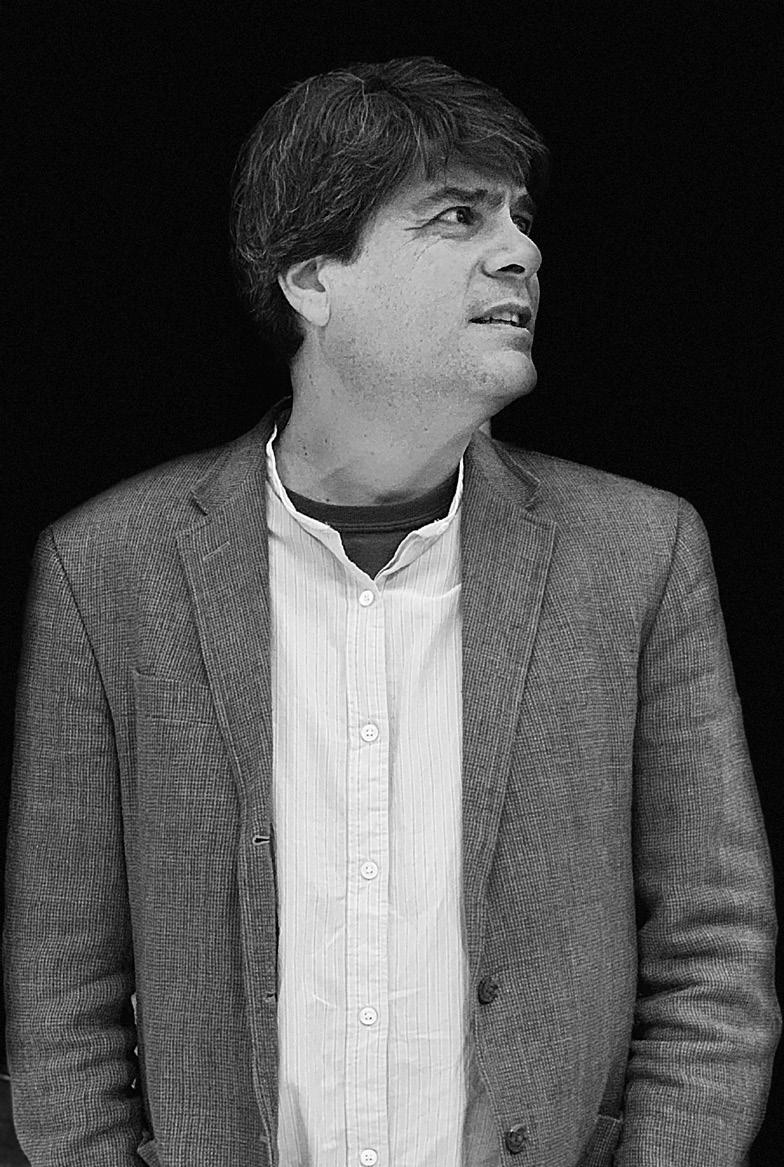
“Just keep that rhythm Give everything you got
It don’t mean a thing If it ain’t got that swing”
—Duke Ellington
Howard Frazin, based in Somerville, MA, exudes a compelling charisma, much like Ellington did. Originally from Chicago, he studied at the University of Michigan, the New England Conservatory of Music, and received a Master of Music degree in music composition from the University of Minnesota. He has taught at Longy School of Music, the New England Conservatory of Music, Roxbury Latin School, and Harvard University. For decades, and since early in his career, he has been hired for multiple commissions, been featured at notable music festivals, and is the recipient of numerous awards, scholarships and grants.
Frazin is prolific, and a respected, gifted composer. As a teacher he has an aptitude and avidity for capturing the essence, and heart of the matter.
Former student, colleague and friend, Benjamin Pesetsky has written:
“Howie has a way of looking beyond the page, anticipating where the music could go, recognizing what is present and what is missing, and pushing the student in that direction until they end up with a complete piece that is probably better than they thought they could write. He is almost preternaturally sensitive to dramatic structures and musical form—and he understands that at different points in the creative process (or in creative life) it’s necessary to look at different scales, from the big picture down to the fine details. He never loses the forest for the trees, and oftentimes helps students avoid that pitfall for themselves.”
As Frazin states, “The crux of my whole teaching agenda is to create a context, and search for teachable moments, a ‘circular curriculum.’ You have to be patient and very vigilant, observing for the possibility of a teachable moment. Material is revisited again and again allowing for the contin-
ued possibility of emotional engagement. I try to help my students become more consciously aware of their own creative process. I work to cultivate in them a resonant sense of expressive self and help them find the tools to articulate that understanding.”
Frazin continues. “I try to help my students distinguish clearly between the different elements of the creative process so that they will be able to reasonably assess their ability to effectively act on their expressive intentions. It is my responsibility to help students understand how they think—to help them cultivate their own voice.”
His teaching methodology is analogous to his work as a composer, “My responsibility is to cultivate my own voice and the story it is trying to tell. Fundamentally, composition, from a practitioner’s perspective, is about process, more specifically about the creative process. What is at the core of the creative process is a dialogue between one’s conscious and unconscious, and through this dialogue one seeks to articulate the resonance of a particular expressive moment framed in time and space.”
He champions the responsibility artists have to society, writing in an article in the Boston Globe entitled “The Arts in Our Lives: An Enduring Beacon in a Complex World,” “artists have the ability and moral obligation to serve as facilitators for emotional argument and to create the resonant environments where such personal and social reflection can take place. There is no more effective cultural tool than the arts for doing this.” Written in 2009, Frazin’s statement rings ever more necessary today.
Erudite, whether in conversation or on the page, Frazin is able to breath emotional depth into the analytics of his métier.
“Music is something much like howling is for wolves—a group activity initiated by social animals expressly to create group coherence,” Frazin wrote, in his reflection “Inside Music and the Collective Breath.” “Looking more deeply, music for humans seems to come in two basic kinds: music that people move to, and music that people are moved by. The first,” he writes, “is directly related to dance and other forms of social physical movement. This is music with an overt beat of some kind, intended to get a group of listeners physically moving together as one. Most popular music seems to serve this kind of function. You might call it Outside Music.”
“The other kind of music articulates an overt expressive affect or emotional progression intended to get a group of listeners simultaneously feeling as one. This is music related to a kind of communal meditation historically connected to various religious rituals. A good deal of classical music seems to serve this kind of function. You might call it Inside Music.”

Frazin states, “What is important about that, is that sometimes you consciously need to be aware of what you are doing and sometimes you don’t. You have to do your homework to put yourself in a position where you can be in the moment and respond. It takes a long time to get there.”
Frazin founded WordSong, a “concert format focused on public conversation around intuitive musical understanding, which seeks to reconnect musicians and audiences through shared, active, artistic experiences,” with fellow composer Tom Schnauber in 2008. WordSong is a collaboration between artist and audience, and is described thus:
“Initially, we all read a given poem and listeners give their reactions. Then performers play composers’ settings of the poem; and then listeners, composers, and performers have an open conversation about what we all just heard and felt: a dialogue reflecting various points of view and what they all have in common.
“Together, we discover how a single, familiar text can inspire a variety of thoughts and feelings; we explore our perspectives and yours and how they are represented in the various meldings of words, ideas, and music. A WordSong Forum is all about communal reflection on multiplicity: multiple settings, multiple hearings, multiple meanings.”
It is important to note that Frazin has a kind, affable heart. At the end of the day, people are important to him, gregarious sustenance, a necessity for the solitary hours spent composing. Conversation is a best friend, as well the festival
of cooking, shared dinners. On end, he can retell tall tales of elaborate tables set spontaneously in celebration of life, composition and song. He is also funny, a characteristic trait that ebbs and flows with his quite exceptional intelligence.
One of Frazin’s earliest memories is relayed with photographic precision demonstrated by an almost tactile reflection, and paints a terrific telling of who he would come to be:
“When I was a little kid living in Chicago, at the age of maybe three years old, my aunt and uncle had an apartment on the south side of Chicago. I remember waking from a nap in a room at the end of a hallway, and walking down the hallway. I came upon a piano,” Frazin laughs and the requisite crinkle around his eyes at the memory lingers. Told with great humorous affect, it is clear as he speaks, that he is right there in that moment, decades ago, pantomiming the physicality, embodying the emotional resonance—and its influence. His smile says it all. “It was a monster piano, with a lamp next to it. Living rooms back in the day, were off limits to children. But I got up, walked down the hall, hoisted myself up on the bench, and wiggled my fingers. It was as if this phantom rose up, this emotional thing, like a puppet in the dark. Playing with raw emotion.”
Paige Farrell is a regular contributor to Art New England, a fine wine consultant, and a ceramicist. Farrell lives on Cape Ann.
howardfrazin.com
Compiled by Autumn Duke

1. Lecture
Civil War Soldiers’ Quilts
September 16, 6:30 p.m.
Civil War soldiers’ quilts are rare, with only twenty known to exist. Lecturer Pamela Weeks, Binney Family Curator of the New England Quilt Museum and author of Civil War Quilts, has studied most in person. This illustrated lecture explores the origins of the U.S. Sanitary Commission, the roles of women on the home front and as
nurses during the Civil War, and the stories of fourteen actual quilts.
Salisbury Historical Society, Salisbury Heights Old Baptist Meeting House, 651 Turnpike Rd., Salisbury, NH, nhhumanities.org
2. Film
African Film + Art Festival
September 17–25
The African Film + Art Festival returns to Providence for the sixth consecutive year. This festival aims to celebrate, educate and promote cross-cultural dialogue between the many diverse communities
in the city. The event highlights contemporary films and filmmakers from Africa and the African diaspora as well as traditional art, music and culture from the same communities.
PVD World Music, Providence, RI, pvdworldmusic.com
3. Festival
Haverhill Art Walk September 27, 2–6 p.m.
This community event occurs in June and September annually. Highlighting both local businesses and underutilized outdoor spaces,
the combination indoor/outdoor festival boasts an artist market, plein air painting, poetry, solo and group exhibitions, live demonstrations and musical performances from local musicians.
Creative Haverhill, downtown Haverhill, MA, creativehaverhill.org
4. Poetry
Lampshade Poets Open Mic
September 18, 6–7:30 p.m.
The Lampshade poetry group was founded in 2012 by poet David Celone. Two original Lampshaders, Janet Watton and Deb Ahlen,
resume readings at Junction Arts & Media (JAM). This open mic is open to all group members as well as any poet interested in reading one to two original poems. Readers can elect to be videoed for JAM’s community access station and YouTube station. Attendees are asked to RSVP online for seating purposes.
Junction Arts & Media, 5 S. Main St., White River Junction, VT, uvjam.org
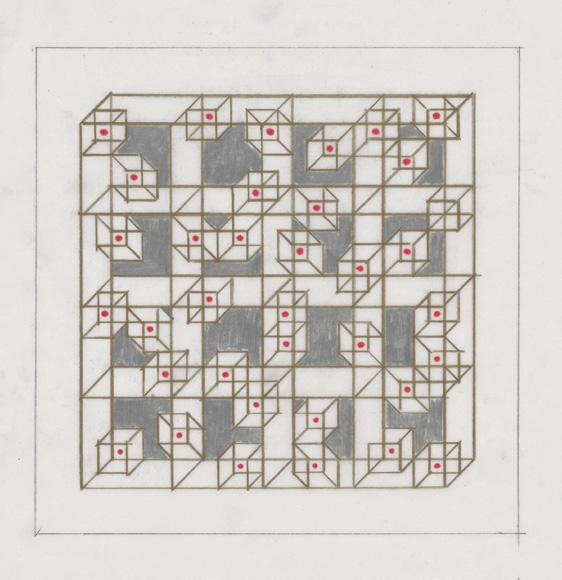
5. Lecture
Sketching Understanding –Drawing as a Way of Thinking
September 26, 12:30–1 p.m.
Join Harvard philosophy lecturer Remei Capdevila Werning at the Harvard Art Museums. Capdevila Werning discusses how the physical act of drawing can be a powerful mode of thinking. Hear from the perspective of a non-art discipline while strolling the galleries of the Harvard Art Museums.
Harvard Art Museums, 32 Quincy St., Cambridge, MA, harvardartmuseums.org
6. Poetry
Timothy Muskat
September 28, 4 p.m.
Poet Timothy Muskat reads a selection of poems from more than four decades of what he refers to as “poem-work.” Each poem read circles the notion of “home.” This theme is in relation to the concurrent exhibition All Paths Home at the lakes gallery, which is housed in an 1800s-renovated farm house and which stands among curated Asian gardens.
The lakes gallery at chi-lin, 135 Eastman Rd., Laconia, NH, thelakesgallery.com
7. Literary
New Hampshire Book Festival
October 3 & 4
Over fifty nationally recognized authors in a variety of genres attend this annual literary festival in downtown Concord. Events include live presentations, panels, book signings and more. The festival is free and open to all, although certain events are ticketed. More information can be found online. With food vendors and writers from adult, young adult and children’s literature, there is something for everyone.
New Hampshire Book Festival, Concord, NH, nhbookfestival.org
8. Poetry
Open Hearts Open Mic
October 6, 7–9 p.m.
Open Hearts Open Mic occurs on the first Monday of every month. It is organized and hosted by Kacy Fallon, an adjunct faculty member at Endicott College who earned her MFA in Creative Writing from San Francisco State University. A true open mic, participants are encouraged to bring poems, stories, monologues, songs, jokes, visual art and craft talks.
Mainely Makers, 3 Warren’s Way, Kennebunk, ME, mainelymakers.com
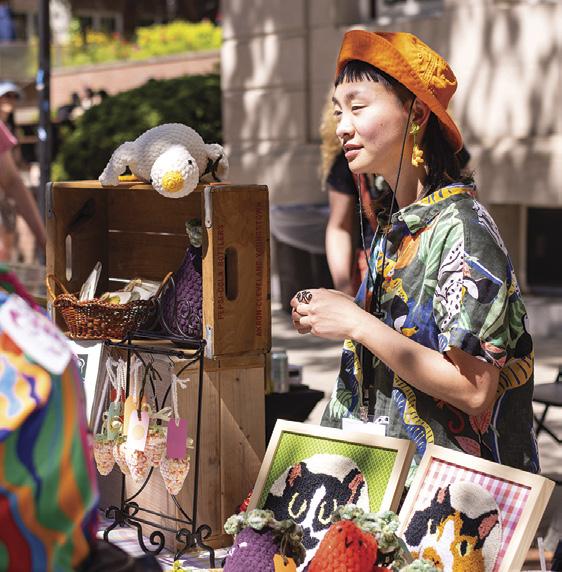
9. Festival
RISD Craft Fall 2025
October 11, 10 a.m.–4 p.m.
This event showcases eighty-six artists and craftspeople in the Rhode Island School of Design’s craft community. Artist vendors offer apparel, accessories, ceramics, fine art, glassware, home goods,
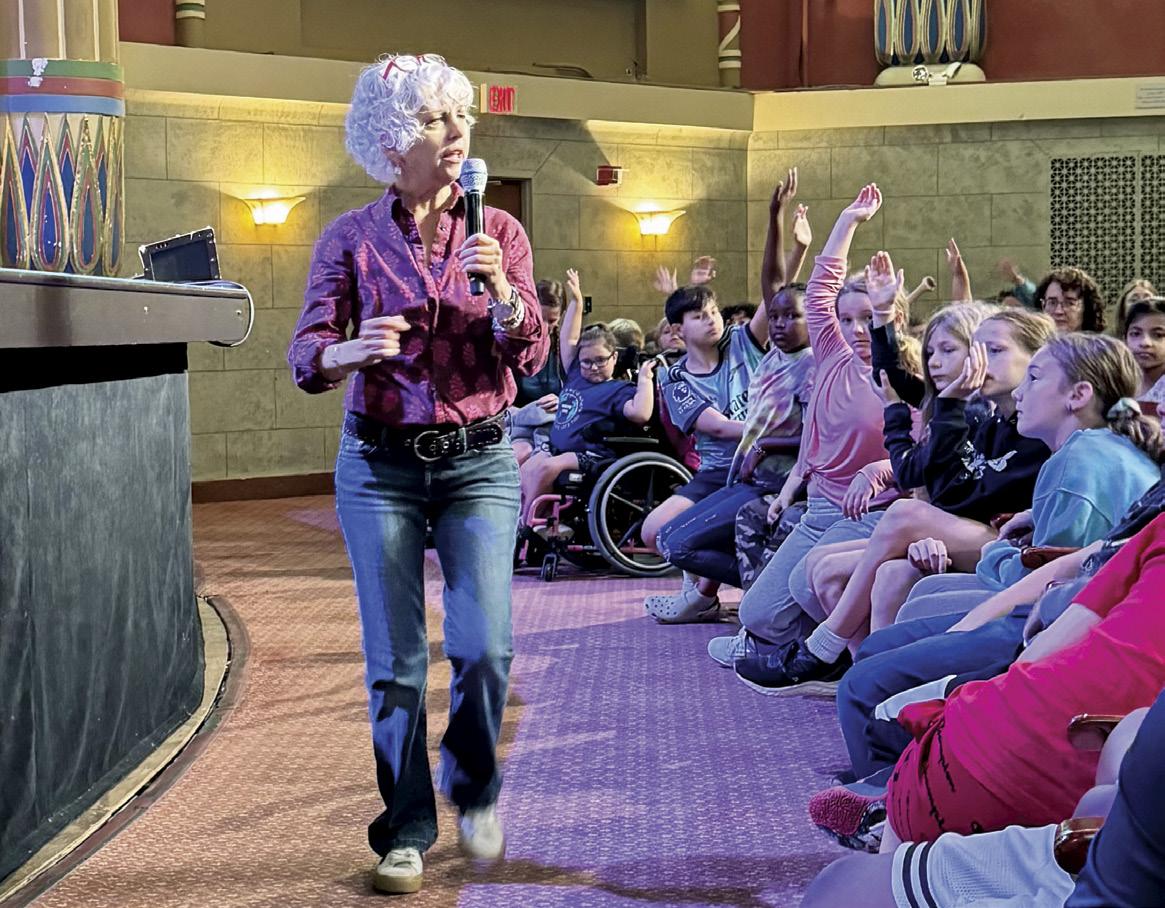
book art, jewelry, photography, stationery and paper works, textiles and more. Admission is free and open to all.
Rhode Island School of Design, Benefit St., Providence, RI, risdcraft.com
10. Literary
Brattleboro Literary Festival
October 17–19
Brattleboro Literary Festival is an annual three-day literary festival founded in 2002. The ever-growing event remains free and open to the public. Events include panel discussions, author talks, readings, signings and more, with plenty of opportunities for attendees to meet and query their favorite visiting authors. Attending writers include poet and fiction writer Ocean Vuong, poet Martin Espada and author Adam Plunkett. The full schedule is available online.
Brattleboro Literary Festival, Brattleboro, VT, brattleborolitfest.org
11. Artist Meet Roslindale Open Studios
October 18 & 19, 11 a.m.–5 p.m.
Artists sell and show art and crafts at more than thirty locations around the Roslindale neighborhood including group sites, local businesses and home studios. Work featured includes paintings, drawings, photography, ceramics, textiles, jewelry, metal and mixed media. Artists also conduct hands-on demonstrations, orchestrate kids’
art projects and offer live musical performances.
The Substation, 4228 Washington St., Boston, MA, thesubstation.space
12. Workshop
String Art Program
October 23, 5:30–8 p.m. Artist Vanessa Fasanella leads this program for artists ages twelve and up. Participants learn to make string art using wooden boards, colored string, nails and a hammer. Learning artists are advised to bring their own patterns or pictures for inspiration and will leave with a hangable piece of art and a reusable pattern to create more works on their own.
Torrington Library, 12 Daycoeton Place, Torrington, CT, torringtonlibrary.org
13. Art Making
Create Your Own Jordan
Bennett-Style Moon
October 30, 12–2 p.m. Mi’kmaw Tepgunsejig: 13 Moons Full Suite features the colorful prints of Mi’kmaq artist Jordan Bennett, whose work is inspired by porcupine quill work and petroglyph depictions of stars, with each print representing a moon in the Mi’kmaq year. Attendees to this event create their own art inspired by his work using collage and mixed media methods, foam sheets, paper, crayons and markers. Abbe Museum, 26 Mt. Desert St., Bar Harbor, ME, abbemuseum.org
BY AUTUMN DUKE
As more and more news floods in of funding shutdowns and unreasonable capitulations being asked of major art and culture institutions across the country, it can feel overwhelming. Many have expressed a sense of powerlessness, of not knowing where to go when the spaces they relied on are going or gone. This writer does not have an answer for that. What this writer does have is a belief that now more than ever it is of the utmost importance to come together in our local communities, to support our grassroots arts and culture hubs, and to show up for the artists, curators and collaborators who are putting themselves on the line to continue making and showcasing their art. Here is a slim selection of the kinds of spaces likely growing in your own backyard. Reach out. Find out what you can do to water these weeds, and you may just find yourself with a bountiful garden.
Holyoke, MA
Holyoke is a historically diverse community and, as is so often the case, a historically underserved community. Rather than relying on aid that may never come from above, the people of Holyoke have been working to rebuild infrastructure and recapture the artistic imaginations of their friends and neighbors. Enter Holyoke Art. This nonprofit organization is young, founded just two years ago, but thriving. Holyoke Art runs two brickand-mortar institutions downtown: The ARTery, a storefront featuring the work of over one hundred local artists and makers, and the Print Shop, a makerspace offering practical resources and training for artists, makers and community members.
Now, Holyoke Art has taken it a step further with the Storefront Gallery. The Storefront Gallery is a project which, rather than trying to bring the public into art spaces, brings art into public spaces. The windows of a vacant storefront next to the ARTery have been transformed into a public exhibition space that is “free, accessible, and visible to anyone walking down the street,” according to executive director Kathy McKean. “The Storefront Gallery is a celebration of how art can reimagine challenges as opportunities and turn public space into something more vibrant, inclusive, and alive.”

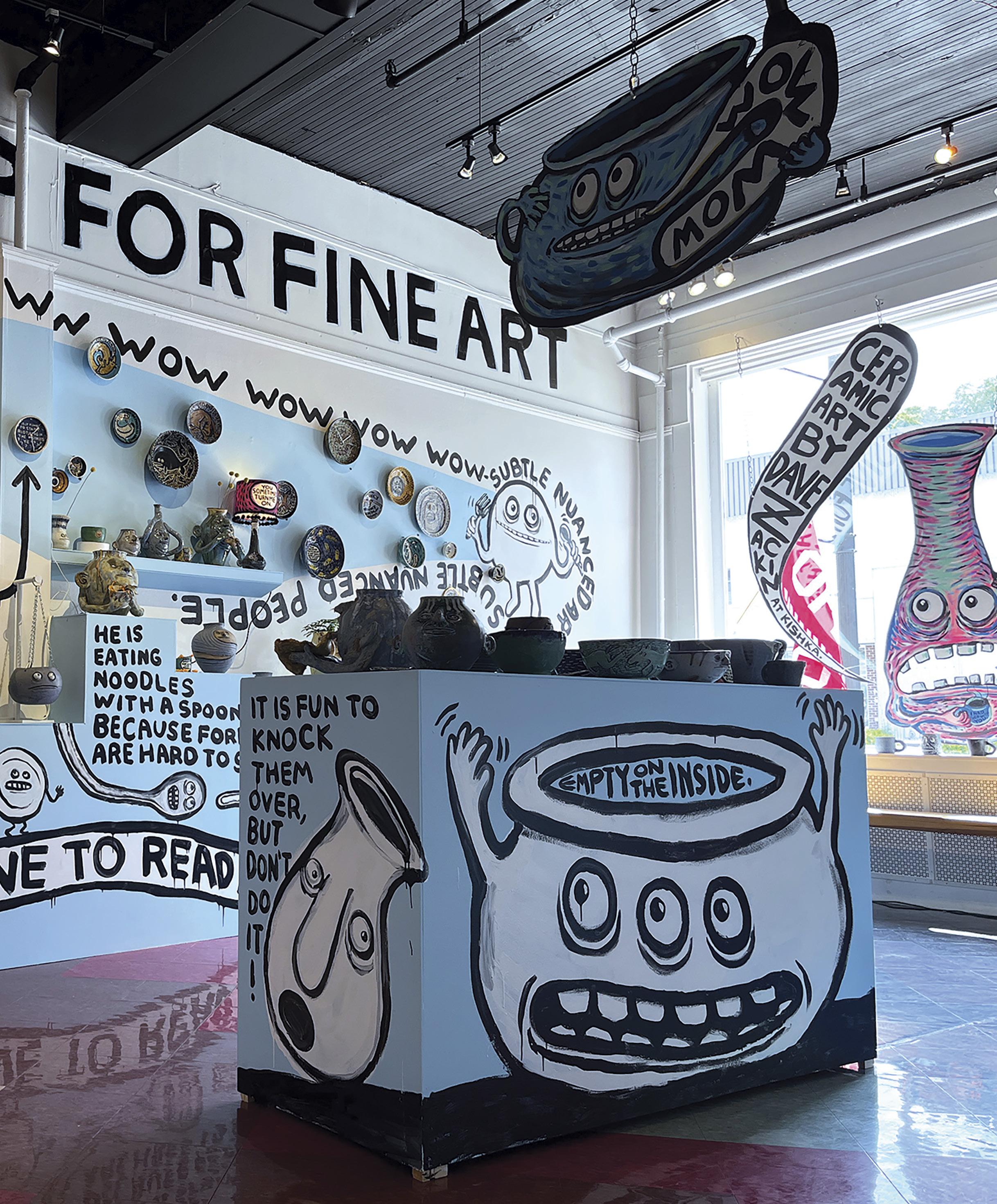
Production for this project was done almost entirely in Holyoke, with prints being made at the Print Shop. McKean spoke of the importance of owning and controlling the means of production, a fact which allowed Holyoke Art to stretch their budget and offer a $500 stipend to participating artists. The project was made possible in part with support from Mass Cultural Council and Holyoke Local Cultural Council.
McKean also spoke of the impact this project had not just on the audience and artists, but on the community at large. A restaurant adjacent to the Storefront Gallery reported an immediate uptick in sales around the opening reception event. Property owners elsewhere in the city have asked about having art put up in their windows. A small change to a downtown storefront, and the ripple effects can be felt throughout an entire community.
Great Barrington, MA
Musician and activist Arlo Guthrie founded The Guthrie Center in 1991 to honor the legacy of his parents, Woody Guthrie and Marjorie Mazia-Guthrie. In the more than thirty years since then, The Guthrie Center has continued to serve as a cultural hub, music venue and community center from its home in the historic Old Trinity Church. This deconsecrated church was once the home of Alice and Ray Brock, friends of Arlo Guthrie, and the setting for his hit song “Alice’s Restaurant” and the eponymous film which followed. The Center is currently run by Annie Guthrie, executive director, and Shivadas “Mo” Guthrie, director.
According to Mo Guthrie, Arlo had “a vision that this would be a place for folks to gather, where people of all different backgrounds, it didn’t matter who you were, it didn’t matter where you came from, the church was your space as well, to gather for musical, spiritual, cultural and community exchange.” Every Wednesday, the Center holds a community lunch, feeding anyone who shows up for free. The Berkshire Center for Justice holds a concurrent free legal clinic during these lunches. In addition, the Center has a musical instrument lending library open those days, giving access to musical self-expression for all. The first Sunday of each month sees Praise Sunday, a nondenominational, interfaith spiritual connection hour.
Building off the legacy of folk music that Woody and Arlo Guthrie established, The Guthrie Center routinely brings in musicians for free or pay-whatyou-can performances. These musical acts run the gamut from small, local musicians to nationally renowned folk artists. Matt Axton, son of country musician Hoyt Axton, will perform on September 19. The following day,


the Center is hosting Old Number One at Fifty, a celebration of Guy Clark in collaboration with the Guy Clark Foundation, which supports new and emerging musical artists.
On Thanksgiving Day, the Center will host its annual Feed Everyone Thanksgiving Dinner, which is free with reservations. Looking further into the future, the Center will hold its annual Walk to Massacre Huntington’s Disease on May 17, which raises both awareness and funds to defeat the disease which claimed Woody Guthrie’s life.
When thinking of alternative spaces for art, one might not immediately think of their local kombucha brewery (the first in the state). Yet, Auspicious Brew combines herbalist beverages, bar drinks, art on consignment, live music, and an active space for the LGBTQ+ community to gather and celebrate. Founder and owner Helen Leavitt’s original plan was to build a space to sell her home-brewed kombucha, where people could benefit from her farming and herbalist background and enjoy a quiet place to chat and come together.
Artists have been a part of Auspicious Brew from early in the company’s history. In 2021, as Leavitt was trying to draw more people into the space, she had the idea to host a pop-up consignment shop for the holidays. It was meant to last from late November to early January. Instead, a wide variety of art, from handcrafted jewelry, to digitally rendered stickers, books on Romani fortune telling, ceramic mugs and magnets, prints, paintings and more, can be found and purchased at the bar to this day.
In addition, Auspicious Brew hosts regular Sunday craft and art pop-ups, with local makers and artisans tabling inside or out, and occasional maker’s markets for special occasions such as the Summer Solstice. Performance art plays a large part in Auspicious Brew’s event cycles, as well, with open mics, karaoke, poetry, live bands, drag shows and more filling most evenings.
Leavitt shared that people tell her, “I come here by myself, and I wouldn’t ever go anywhere by myself. I feel comfortable hanging my bag on the hook here, and I don’t think twice about it.” These testimonies show that this space is indeed one of community and safety, something that can only be made possible through the open collaboration of owners, staff and visitors. With a major expansion on the horizon in 2026, Leavitt expressed the continued

need for such collaboration. “We absolutely need the support of people who are interested, want to collaborate, love herbal beverages, like to show up, spread the word, come to our events, stuff like that.”
Hartford, VT
On the website for Main Street Museum, its history is described like this: “In 1992 a small museum opened its doors, and immediately attracted a broad cross-section of Vermont and New Hampshire’s citizenry: academics, art professionals, musicians, politicians, journalists, the under-employed, the inveterate ne’er-do-wells, and even the quite ordinary.” This wry, tongue-in-cheek tone mixed with a genuine mission to bring together all kinds of people in the Upper Valley sums up the general vibe of Main Street Museum.
Part public venue, part oddities museum, the space is as unique as can be. The Museum hosts free movies on Tuesdays, “Piano Night” on Fridays (the piano in question being a 1930s Aeolian Player Piano), and a wide multitude of concerts, festivals, poetry readings and more. Every two months, the Museum displays a different local artist’s work. Nine-year volunteer Joie Finley said, “We have described our venue as between the garage and the tour for musicians and between the spare room and the Met for artists.”
On September 13 and 14, Main Street Museum will host their annual DIY music festival What Doth Rumble featuring thirty-four bands and solo artists, more than fifteen vendors, workshops and more. The twenty-third annual GORY DAZE event will be held on November 1. This Halloween-themed day of fun and music is kid-friendly, with an adults-only Evening Ball to follow at the opera house.
Main Street Museum is a nonprofit entirely staffed by volunteers. It is run on local donations, receives no state or federal funding, and yet is dedicated to maintaining free and accessible events for all. Further, Main Street Museum is always looking for the next collaboration, the next opportunity. Those with ideas they would like to see come to fruition are encouraged to reach out and discover what their community organization can do for them.
White River Junction, VT
Kishka Gallery & Library was founded by Ben Finer and his partner Bevan Dunbar in 2021. They had experience running a small museum prior to the pandemic, and were looking for a new creative outlet, “an interesting project, a way to bring some energy and creativity to this area.” Finer saw that the Upper Valley had many institutions built around regional art. The Hood Museum of Art’s proximity meant that the niche of internationally
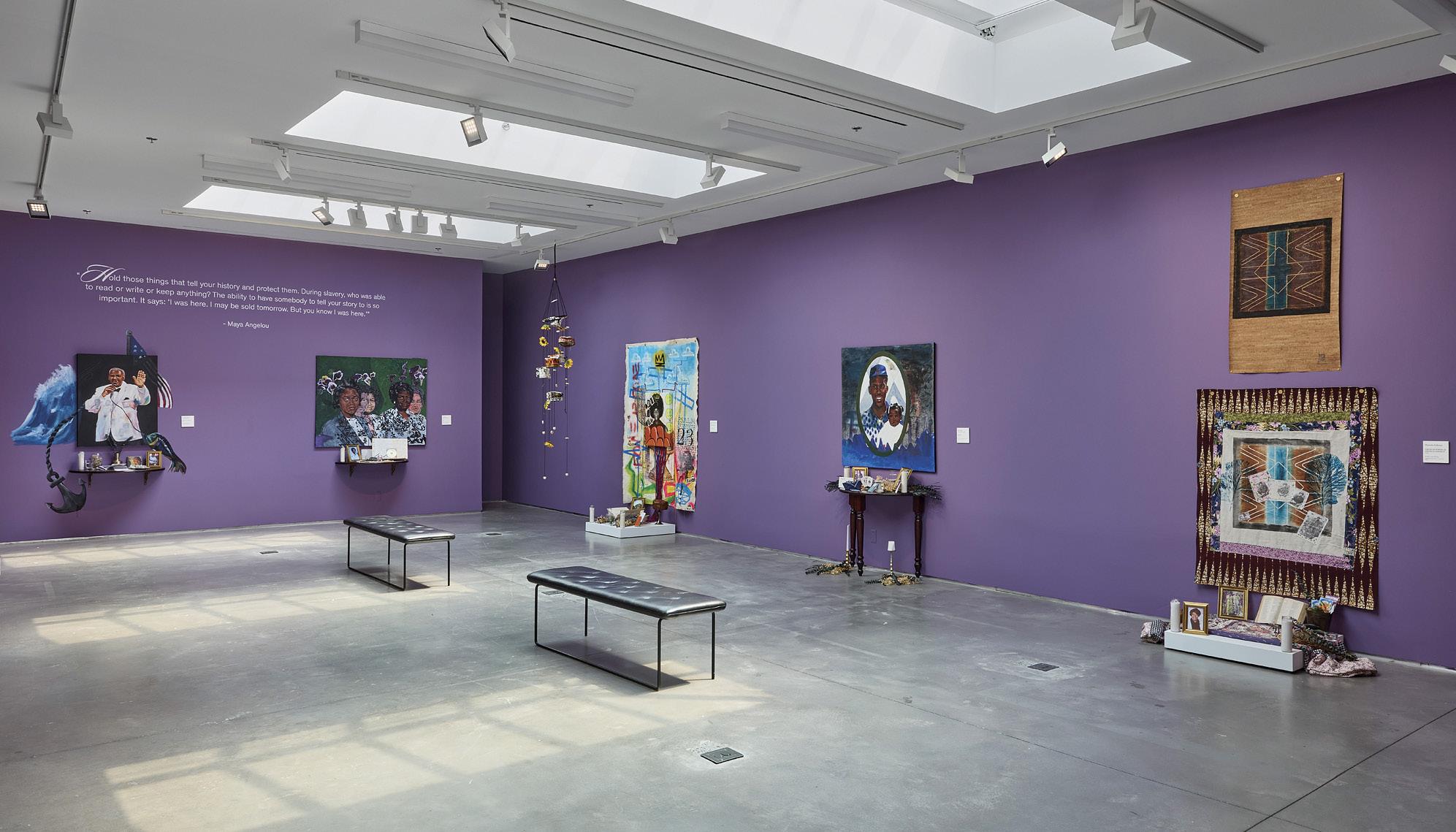
recognized and historical artists had been filled, as well. What was missing, it would seem, were those artists in the middle. Finer started Kishka to engage in contemporary art, contemporary art subjects and contemporary art conversations, and bring those into this tight-knit community.
Kishka has offered a range of mediums from traditional sculpture, drawing and painting to puppet shows, performance art, avant garde work and drag shows. Anything that could be considered part of the contemporary art scene is considered for Kishka’s exhibitions. The gallery is free and open to all, as are all events. Some may require RSVPs so that the gallery can anticipate space and seating needs, but every event or show is accessible to every member of the community. Dave Zackin’s Cheap for Art, Expensive for Dishes features ceramics that sit somewhere between sculpture and functional objects and is on view through September 20. From October 3 to November 1, An Ever Changing View shows Yen Yen Chou’s unique, whimsical wall sculptures and drawings. Kishka shows monthly museum-quality exhibitions.
Kishka holds roughly 1,000 art books spanning art history and contemporary art. Books can be taken out for free just like any lending library. In this way, Kishka is able not just to show visitors examples of active contemporary art, but to educate, as well. Finer spoke to the act of exploration through reading physical books. “You can only Google something if you know what to Google, whereas books don’t have that. You can come to a book with no pre-knowledge and just pick it up off the shelf and suddenly discover something.” The gallery boasts a cozy, library-like atmosphere that encourages long stays, and a three-year-old “chiweenie” named Knish to welcome visitors.
NXTHVN
New Haven, CT
NXTHVN is a nonprofit arts organization which was founded in New Haven by Titus Kaphar, who continues to serve as president, and Jason Price, who serves as chairman of the board. NXTHVN’s focus is on providing space, resources and opportunities to emerging artists, curators and entre-
preneurs in the surrounding community. It is a relatively new organization, opening its creative campus in the Dixwell neighborhood six years ago in 2019.
One of NXTHVN’s most important programs is the year-long Fellowship Program, which recently welcomed the Cohort 07 group of fellows. These fellowships, offered to both practicing visual artists and curators, provide participating fellows with individual mentorship as well as broader professional development opportunities focused on administrative and theoretical aspects of the profession. Part of another key program, NXTHVN provides paid art apprenticeships for New Haven-based high school students with an interest in pursuing careers in art or curation. These students are paired with NXTHVN fellows to allow an exchange of ideas on both sides.
Beyond uplifting and supporting emerging and early career artists and curators, NXTHVN aims to “collaborate with emerging businesses as an incubator to nurture cultural and capital value in the neighborhood,” according to Marissa Del Toro, assistant director of programs and exhibitions. Del Toro is also an alumnus of NXTHVN’s Fellowship Program, as a curatorial fellow from Cohort 03.
NXHVN is also a physical exhibition space where visitors gather and experience innovative art. On view through November 23, Reverence: An Archival Altar New Haven was guest curated by Arvia D. Walker. Walker is “a New Haven-based artist and curator that celebrates the unique stories of the everyday person held as the ‘greats and giants’ within the local Black community of New Haven,” said Del Toro. On October 2, interested and registered participants can create artworks to honor loved ones in their own families, including a phototransfer onto a printed canvas. On October 25, exhibiting artists for Reverence and participating families share stories and insights into the works on display.
Autumn Duke is a writer and editorial assistant for Art New England living and working in New Hampshire. They write fiction and creative nonfiction as well as editorial work and are currently enrolled in the MFA in Writing program at the University of New Hampshire.

BY LOREN KING
Of the many artistic and technical components that contribute to the making of a film, production design is, to put it simplistically, the most visual. A film’s production designer heads the entire art department including sets and props. Whether the project is a blockbuster or a low budget indie, the production designer is tasked with creating that elusive “look” of the film and translating the director’s “vision” into visuals.
If those visuals tickle the eye, scorch the heart, and linger in your consciousness long after the credits roll, you can thank the production designer whose job is to immerse the filmgoer into a world, whether in the past, present, or future.
Production designer Inbal Weinberg, whose many credits include Martin McDonagh’s Three Billboards Outside Ebbing, Missouri (2017) and Pedro Almodovar’s The Room Next Door (2024), is fond of a quote from legendary production designer Richard Sylbert whose numerous credits include such 1960s and ’70s screen classics as The Graduate, Chinatown and Rosemary’s Baby. In Sylbert’s words, “Designing a film is like painting a landscape in a hurricane.”
“I think of that quote constantly; it is so beautifully said. It’s a profound way to express what we do and how it connects to art,” says Weinberg, who just completed production on director Derek Cianfrance’s crime comedy-drama Roofman, slated for release in October. “A complaint often raised with production designers, like other ‘below the line’ [artisans], is that we feel often that our work when successful is invisible. People don’t understand what we do. Production design is hard to explain to people; most know that a cinematographer uses a camera or a costume designer gets clothes on the actors. Production design is more abstract [because] it involves so many kinds of skills; you put on many hats. Even within the industry, people don’t understand what we do. We run a very complex department that often has hundreds of people in it. It’s a mini-universe.”
dedicated to mutual support through sharing knowledge, encouragement and experience. After a first-ever gathering of designers in 2022 that generated “so much success, goodwill, gratitude, excitement and inspiration about our profession,” says Weinberg, the organizers “wanted to expand and involve more of the public.” The collective then launched International Production Design Week, a celebration of the work of the art department for film and TV in countries around the world.
The initiative takes place this year from October 17–26 worldwide with events in person and online. The program will include panels, workshops, screenings, masterclasses, guided tours, set visits and social gatherings and it will be open to filmmakers, industry collaborators, students and the general public (see the website at the end of this story).

For that reason, Weinberg and production designer Kalina Ivanov founded the Production Designers Collective, a group of more than 1,100 colleagues
“Part of Production Design Week is for us to share work we’re doing and to welcome the industry and the public. We’re opening the door to the art department and helping people understand our process and advocate for ourselves in the industry,” says Weinberg.
“The film industry has been in crisis for a few years; more [productions] are shooting abroad because of tax incentives. So it’s important to have conversations and exchange information about working in other countries.”
The issues and challenges facing production designers transcend regions, genres and budgets. “Coming up in the indie world and knowing people from our collective, the amount of work is not necessarily connected to the budget level,” says Weinberg. “It’s the same struggle when the budget is five dollars as it is for the designer of Wicked. It’s just a different scale. The comforting part is we all seem to struggle with the same issues. The problem is the gap between the dream and the resources.”
Ivanov says that when she and Weinberg a decade ago “hatched a plan of organizing designers from all over the world,” the global scope was intentional. “We are both foreigners; Inbal is from Israel and I am from Bulgaria. Originally we both worked in New York and had this hunger for an exchange of ideas … We decided with the collective that there would be no fees, no
awards; we didn’t want to do a festival and screen movies. We started two years ago with a gathering and it went so brilliantly that we found ourselves with a baby.”
Ivanov and Weinberg represent the typical backgrounds of most production designers. “I went to art school,” says Weinberg. “Our entire film industry is a hub for misfits so there are a lot of different backgrounds in our profession but production designers usually come from theater set design or art or architecture. We draw inspiration from art; a lot of designers think like artists.”
Ivanov came to production design from a theater background. In 1979, she and her family fled communist Bulgaria for New York where Ivanov ended up studying at New York University’s theater design program. “Bulgaria doesn’t have much cinema to speak of, but I loved theater so much. Little by little, I fell in love with film and went as a graduate student to NYU’s film program.”
After meeting Jonathan Demme in film school, she was hired as a storyboard artist—creating detailed renderings of individual shot sequences—for Demme’s 1991 horror classic The Silence of the Lambs. After that, “I was hooked,” says Ivanov who credits Demme as a mentor and still storyboards her designs.
Ivanov has gone on to a genre-spanning career that includes her Emmy Award-winning production design for HBO’s Grey Gardens (2009). Most recently she earned an Emmy nomination for the 2024 TV miniseries The Penguin with Colin Farrell. “I could spend an hour talking about The Penguin and all the layers to the [production design] such as the forty pounds of dirt we put on the street to create a mess,” she says.
Ivanov spoke over the phone from Boston where she’s currently scouting locations in Lynn and Braintree, among others, in preparation for designing Stephen Chbosky’s new film, Little Men, set to begin shooting in September.


Little Men is Ivanov’s second film with Chbosky after 2017’s Wonder. (Coincidentally, Weinberg was the production designer on Chbosky’s 2012 acclaimed debut, The Perks of Being a Wallflower, based on his own novel.) Ivanov’s robust resume also includes two films with George Clooney. “We shot The Tender Bar at New England Studios in Devens during COVID. We built the bar and the interior of the house and the exteriors we matched perfectly. It was a tremendous experience. George Clooney is so kind; I wish everyone was like that. So when he asked me to work on The Boys in the Boat, I said, ‘Are you kidding me? Absolutely!’ We tried to bring [the shoot] to Boston and I scouted other places but finally we decided on London. It’s an American story but that’s my job: to make England look like America,” she says.
“Every script is different with something in particular that attracts me,” she says. “Little Miss Sunshine is a naturalistic movie, done superbly by two artists who are a couple [Jonathan Dayton and Valerie Faris]. They cared a lot about composition and color. There was a lot of discussion about the van and the particular shade of yellow that needed to be like sunflower.”
Like Weinberg and many production designers, Ivanov takes inspiration from paintings when contemplating visuals for a new project. “For Little Men, even though it’s super naturalistic, I looked at [German painter] Gerhard Richter and his portraits of young people,” says Ivanov. “I always find a painter I like and incorporate it into the work which helps translate my understanding of the characters into visual images.”
Weinberg, who’s made four films with Cianfrance, says forming a creative bond with a trusted director makes sense. Not only is the shared shorthand invaluable given time and budget constrictions but a comfort level is crucial on sets that are inherently stressful and demanding.
“You are in the trenches and develop a camaraderie. It’s sad when it’s over so, on an emotional level, you want to reunite and reconnect. On a professional level, there’s never enough time and it usually takes awhile to establish rapport. You must make serious decisions; that takes energy and time and often you don’t get it right until the end. So having a head start is so valuable.”
Based on a true story that happened in North Carolina, where the film was shot, Roofman stars Channing Tatum as a convict who escapes and hides in a Toys R Us. “We had to recreate the [store], a huge challenge, and there was not enough money,” says Weinberg. “I’m proud of the film and I’m psyched to share our insane process of recreating the toy store as it was in 2003 or 2004 when these events took place. The toys had to be specific to that time. We did an insane amount of research and I think we got most of it right.”
The idea of a global conference, with events and panels taking place in, among other cities, Athens, Mexico City, Vancouver, Atlanta, Los Angeles and Bogota, helps designers “advocate for ourselves and build solidarity,” says Weinberg. “It’s inclusive and expansive … We notice large gaps in structures of industries, between established and smaller communities, so advice from experienced designers working under different conditions can be eye-opening to certain communities. If you feel you’re out there without a compass, hearing from [others] about more structured environments and better practices elevates the entire profession. It’s about bringing everybody up.”
For more information go to www.productiondesignweek.org
Entertainment journalist Loren King writes for many regional and national outlets. She is a member and past president of the Boston Society of Film Critics and a reviewing member of the Alliance of Women Film Journalists.
BY PAIGE FARRELL
“Loveliest of trees, the cherry now Is hung with bloom along the bough, And stands about the woodland ride Wearing white for Eastertide.
Now, of my threescore years and ten, Twenty will not come again, And take from seventy springs a score, It only leaves me fifty more.
And since to look at things in bloom Fifty springs are little room, About the woodlands I will go To see the cherry hung with snow.”
—A.E. Housman, “Loveliest of Trees”
Could we agree with Housman, that time is fleeting? Now more than ever we need art and artist to raise voice and bar, and unite within and beyond their communities. It is time to embrace beauty, grace, poise and verve. Three New England women gallerists are doing just this, pushing beyond the boundaries of tradition with their spaces, in search of a greater good, championing inclusivity, collaboration, and ingenuity.
JANICE SANTINI
Blue Door, York, ME blue-door-gallery.square.site @blue_doorgallery
Janice Santini is the owner, curator, and designer of Blue Door Gallery. An exhibiting artist over the years, her paintings express her love for “clouds, landscapes, and pops
of spontaneous joy.” She is passionate about bringing art, healing and happiness to people through the energy of creation and collaboration. Hers is a thoughtful presence.
“I have always wanted to have a gallery, and my husband is a chiropractor. We knew we wanted to have a shared space that would offer art and holistic healing together. When we discovered the property, a house and adjacent barn, we knew this was it, and that it needed work,” Santini says with a smile. With the help of family, they took on the restoration. It was a very conscious, thoughtful process.
As Santini shares, “When we raised the barn, we discovered a well, a wishing well we named the ‘Well of Forgiveness’, hiding under an old floor. We designed a glass cover over the twenty foot well with a light submerged within. It is part of history and the Underground Railroad.”
About Twin Farms, Santinti shares, “It was a high profile establishment, and there is a fine art, interacting with guests who are very discerning. It takes a certain grace and patience, and the ability to thoughtfully anticipate every need, and juggle multiple moving parts.” Being welcoming and well versed, with an acute awareness for when to step into the background while still observing is key to running a successful gallery. Santini has accomplished this.
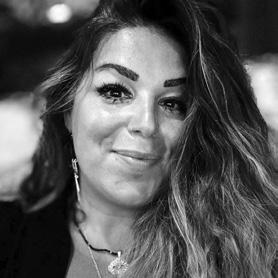
They also kept the blue door in honor of the integrity of what’s come before them. A tranquil energy pervades the gallery, hung salon style. The gallery opened in 2023, and is comprised of several rooms. The adjacent house is home to a selection of holistic healing practices, including her husband’s chiropractic office.
An exhibiting artist since graduating from art school in 2000, Santini had an opportunity to be the first artist in residence, in 2004, at the coveted Twin Farms, a resort and spa, and Relais & Chateau property, in Barnard, Vermont. The experience left an impact. Blue Door resonates with a confluence of art, healing and hospitality.
“Both the gallery and the healing business have taken off,” Santini states. “I feel incredibly blessed. I love what I do. I believe we manifest the things we really care about. Manifestation is huge. We have choices, and I choose positivity, and gratitude. I think it is important as a gallerist, curator and as a woman that you stay on task.
I have a responsibility to the artists who exhibit here.”
She continues, “When you make the artist feel that they are important and appreciated, it really does change the path of the gallery significantly. I take that seriously. It is a lot of work for an artist, a leap of faith sometimes, and we don’t know if work is going to sell. Making an artist feel appreciated is so important. I am always willing to give my self and my heart to my artists to help them succeed—an important key for our success, besides a powerful show, is how we treat our artists.”
“The artists who exhibit at the gallery, they have found their way to us. There is a connection, something I can’t explain except to say that they are simply meant to be here. For example,
covered well discovered after lifting
1856
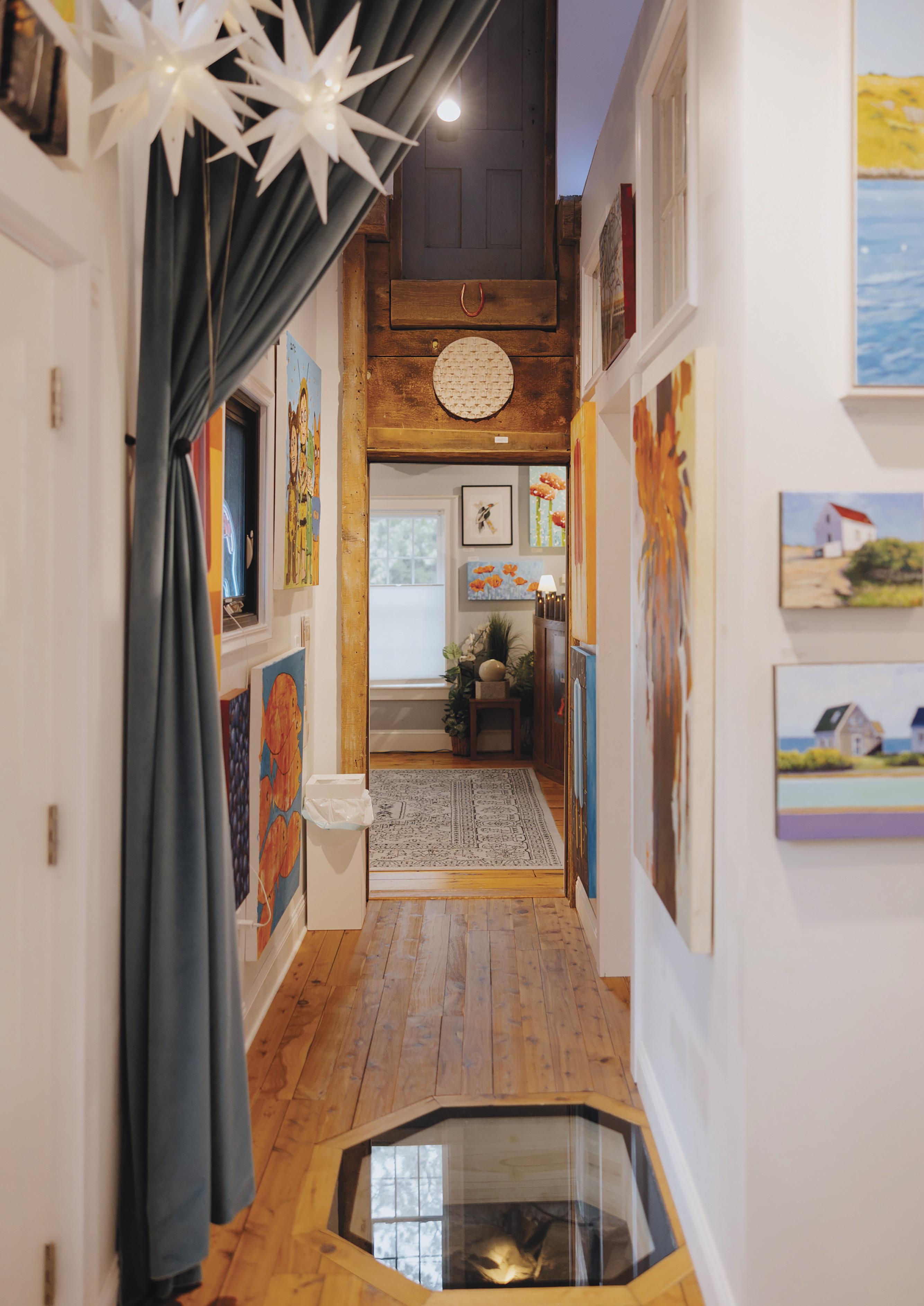
20
The blue door above the hallway was also discovered in remodeling hence the name of the
The hallway connects the barn to the main house where the gallery invites the viewer between the two spaces.

painter Marcia Crumley, just a gorgeous colorist, presents Finding Joy in September. It is hard not to smile when you look at her work.”
Maintaining the gallery is a collaborative venture. “I have a friend and prolific painter, Forrest Elliot, who helps me hang the shows. We hung his first show together. He is the King of Color. We connected right away. We create a dialogue together, and make sure the paintings are talking together. My husband helps too. He works every show, he does whatever it takes! He is incredibly supportive in making this dream happen.”
Santini enthuses that while receptions are very busy, with music and visitors from near and far, the question of how to bring people in on a daily basis requires creative thinking and strategizing. “I plan events that aren’t just about the artwork. They are about making you feel creative, feel good. We have had meditation events, an annual summer soirée, food trucks. Anything that helps people think outside the box, and feel a part of what is happening here.”
Reflecting on the here and now, Santini states, “Big institutions are closing. Small galleries need to continue to exist with a broad sweep of inclusivity. It is imperative that we keep going and continue to provide the environment for the artist to succeed, which carries over into the community, making it a positive for everybody, including me.”
Finding Joy, an exhibition by painter Marcia Crumley, previews on page 64.
Sidle House, Freeport, ME sidlehouse.com @sidlehousemaine
Maddy Vertenten opened Sidle House, an exhibition and performance space comprised of several “gallery spaces,” in her 100-year-old barn, a.k.a. “Big

Beauty” in Freeport, Maine, during the summer of 2023. The original spark of this idea came while visiting New Mexico and Georgia O’Keeffe’s Abiquiu home in the early 2000s.
“I loved the idea of bringing people together in an interactive, inclusive space. My role is to promote the artists and create community around art. My mantra is ‘do the thing’, do the thing, not because it’s ‘right’ or ‘hard’ or in the right order… just stay with the intention without criticizing.” A thoughtful pause ensues. “When we get to our fifties, time doesn’t seem so endless anymore. I feel more generous, grateful for connecting people, eager to turn the spotlight on others. I am excited to help illuminate other people.”
Sidle House often reaches beyond the notion of a traditional art gallery, an evolution that excites Vertenten as much as it does the community. It is the perfect venue for music, and as a violinist, having music resonate from the barn is extra special. “The acoustics in the barn are great,” she notes. “Last fall, I had a guest curator and he played five different acts; wild electronic music, ambient and super progressive. It was awesome and the community loved it.”
Also, Vertenten shares enthusiastically, the founder of the Seguinland Institute, which offers a gap year program, “The Good Life,” reached out to her asking to bring a group of students to Sidle House. “Their program offers young people an immersive opportunity to set aside a season to explore the good life. The program engages the whole person: body, mind and soul. They help young people understand that career paths aren’t always linear. No phones were permitted, no cameras… and they were so inquisitive. It was rewarding for me to see Sidle House used as space of experiential learning.”
In early fall, Sidle House will host two exhibits in tandem.
Diaphanous, an all female exhibition featuring artists Natalie Nelson, Aidan Fraser, and Quinn Evans, “explores the strength found in female friendship. Using a wide range of media, their work speaks to the unspoken bond between women; a space where inspiration moves freely, shaped by authenticity, resistance, and the simple yet radical act of being seen together. Through their collaboration, they reveal how vulnerability, when shared, becomes resilience, and how mutual care gives rise to quiet empowerment.”
Playing through, is a solo exhibition of works by painter Steve Sunenblick. The artist’s approach is “a give and take with color, form, space and line. Sometimes with an initial idea—but never a fixed one controlling where the painting goes.
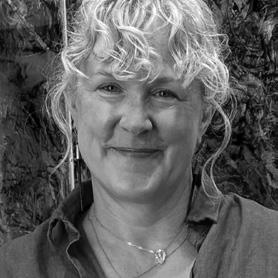
Painting takes me to a private place,” Sunenblick writes, where he can “drift, revel, and respond spontaneously, expressively, deliberately, always searching and adjusting for the feeling evoked in me.”
Vertenten learned of the “One-Day Choir” in NYC—a pop-up choir experience where people of all skill levels can join for a few hours to learn and sing a song together, in an inclusive environment, with a focus on community, connection, and enjoying the process of making music together, regardless of experience. Inspired, she contacted the director of the Maine Gay Men’s Chorus, and will host their “One-Day Choir” retreat off-site, while the Diaphanous and
Playing through events take place at the barn.
“I am continuously inspired in a myriad of ways since starting Sidle House. And I feel that the art world is going through change, with both artistic expression and art collection geared toward life enhancement. Now more than ever, we have to foster community, and turn to the arts for sustenance and transformation. It is certainly my hope for Sidle House: art and experience that makes one’s life better.”
Mad River Valley Arts, Waitsfield, VT madrivervalleyarts.org
@madarts802
Sam Talbot-Kelly is the executive director of Mad River Valley Arts, located along the Mad River, in Waitsfield, VT. Mad Arts is a non-profit gallery space whose mission is to “share diverse exhibition experiences through contemporary visual arts, and interdisciplinary design.” The belief at Mad Arts is the understanding that “art supports the agency to create story, a sense of belonging, and is a means to synchronize with the natural world, and the social responsibility of linking art to people, to balance voices and open multiple perspectives.”
“Art is a conduit for vibrant discourse and collective empowerment,” shares Talbot-Kelly. “Each of our exhibits is an opportunity to invite conversations, build memories, and contribute to a larger conversation around the importance of art, and to support what’s happening at Mad Arts and in the community.”
In addition to her post, Talbot-Kelly is a contemporary, experimental artist. For the last ten years she has been engaged in garment design, illustration, and mechanical installation. She is also a passionate art educator, who takes the approach of anti-disciplinary creative thinking. She believes art education goes beyond school doors, much as an art practice goes beyond the studio and self interest.
“As both the executive director of Mad Arts, and as an educator, I engage as though I am in my studio, harnessing discipline and vision, and connecting with the community. Shared thinking, objectivity, inquiry, collective collaboration is key.”
“Art needs to make an impact,” Talbot-Kelly states. “When I write grants, I have to show that there will be an impact, and that means taking an anthropological approach. I engage the community and source inspiration through artists, asking, ‘what are you thinking about, what is important, how can we collaborate?’”
Talbot-Kelly formed the Mad Collective as an anti-disciplinary group that explores and experiments artistically with social/cultural/psy-
chological/philosophical/sci-fi/tech phenomena. “We are essentially a lab. Our first show is slated for October, and is titled Stardust It is an exhibition about The Quantum World (science and technology), and the world of uncertainty. One can’t really talk about where a quantum object is, we can only talk about where we might find it. Yet, our seemingly solid reality is built upon this tiny world of possibilities. It is about our identity; ‘What are we made of?’ We aren’t just cells… we are physical waves.”

while engaging with scales from the unimaginable tiny, to the infinitely large. We see this as a way to engage with the community and encourage dialogue, and promote Mad Arts.”
Five artists will participate. It will be a multi-media installation that “looks at the behavior of photons, particles and mysterious patterns of quantum phenomena. It inspires us to think about the magic of the quantum fundamental basis to reality and asks us to be curious about where the human species is going. Artists will present their interpretation of the immaterial
Talbot-Kelly cares deeply about the social values of art, and art as a vehicle for change. “When artists are in our exhibitions, we are creating stories together. They get feedback, and inspiration. With community, we are shaping culture, thinking about what is significant and what needs to be addressed. Today, it is essential to think about impact and the greater good of all, and how we at Mad Arts can integrate our individual and collective perspectives and insights for betterment.”
Paige Farrell is a regular contributor to Art New England, a fine wine consultant, and a ceramicist. Farrell lives on Cape Ann.
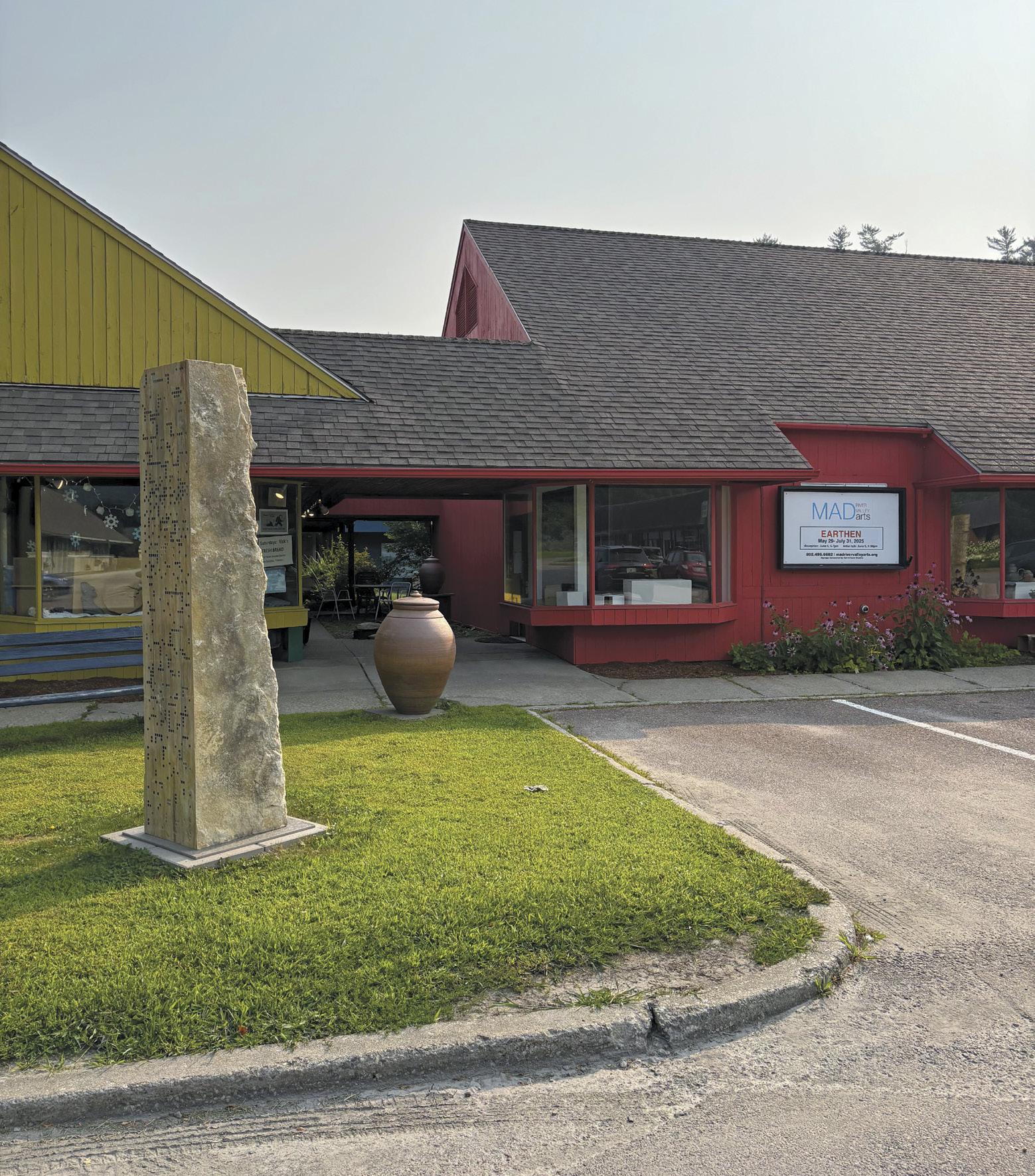
BY CYNTHIA CLOSE
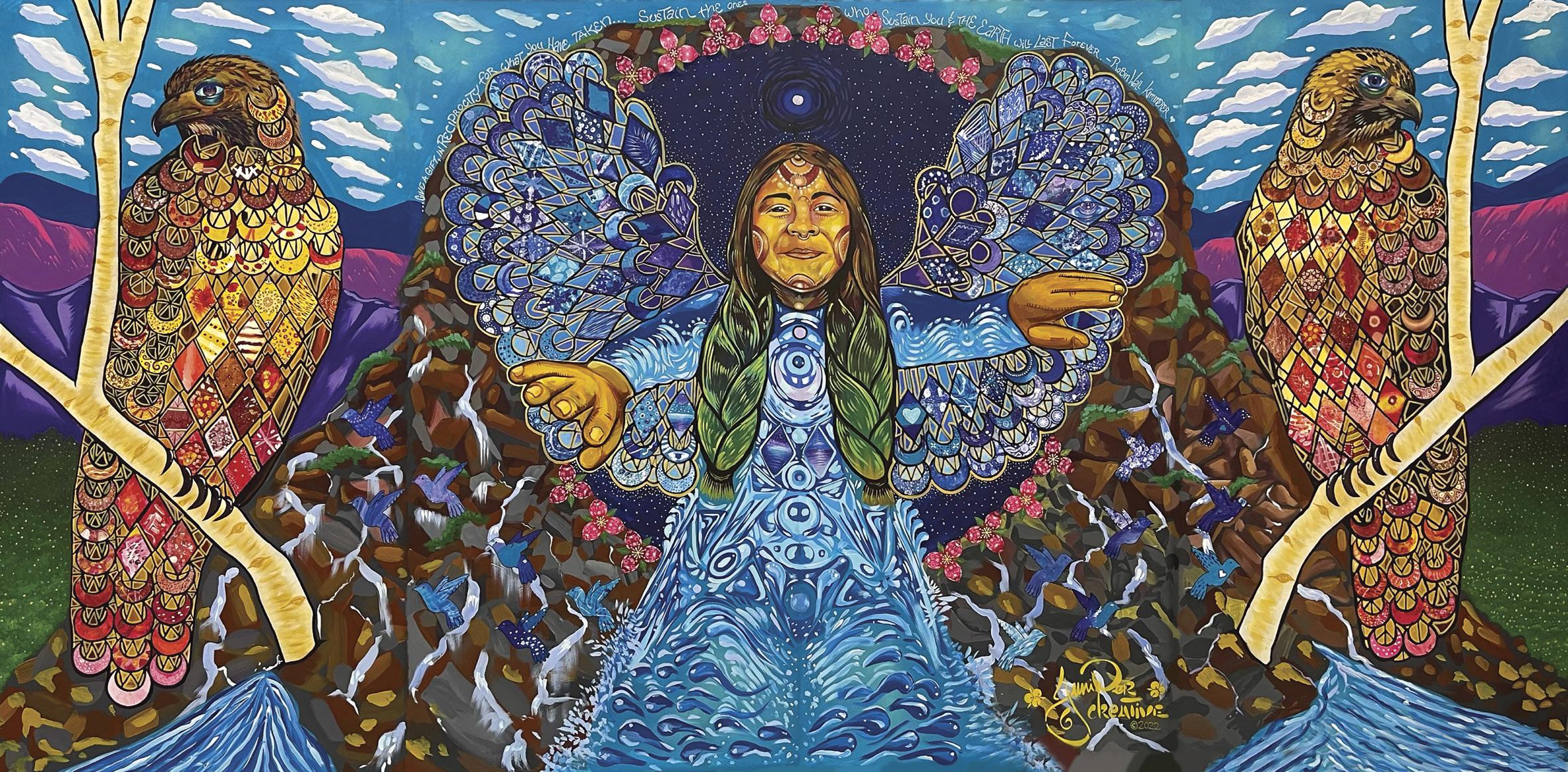
While the arts have been attacked both politically and economically on the federal level, Vermont resists the pressure to acquiesce. This summer yielded a bonanza of awards recognizing the power of the arts to survive while other systems fail. Major honors were sponsored by nonprofit Vermont organizations and were doled out to deserving Vermont artists in several disciplines providing a light of hope and inspiration that unbridled creativity still finds fertile ground in Vermont.
On June 28, 2025 a small crowd gathered in the second-floor gallery of Burlington City Arts (BCA) for a ceremony announcing the winner of this year’s Herb Lockwood Prize. This was the twelfth year that Todd Lockwood has sponsored the prize to honor the creative spirit and entrepreneurial achievements of his brother, Herb, whose talents as a composer, cartoonist, and woodworker was felt long after his death in 1987.
As with several other high level international awards, there is no application process for the Herb Lockwood Prize. Nominations in visual arts, music, writing, drama, dance, film, and fine woodworking are provided by anonymous arts advisors located throughout Vermont and honorees do not know they are being considered until they learn they have won. The criteria is simple.
the Governor’s Arts Award), Keep Abortion Legal, City Hall, New York City, 1994, silver gelatin photograph, 16 x 20". Courtesy of the artist. The 2025 recipient of The Vermont Prize, Jonathan Gitelson. Courtesy of the artist.
The artist’s work must demonstrate a high level of artistic achievement, coupled with originality, innovation, and imagination. The recipient must also have a record of community engagement. An ability to inspire others is a key factor and this year’s recipient, the forty-seven-year-old Afro-futurist painter, graffiti scholar and educator Will Kasso Condry has spent his entire career doing just that.
In his speech Condry described receiving the phone call telling him he had won the $10,000 prize, “After I got over the initial shock, the first thing that comes to me is that I don’t do this alone.” He then invited his wife and business partner, Jennifer Herrera Condry, to stand next to him as he talked about his creative journey and how he came to Vermont. “I’m a very urban
Black guy known for graffiti art, street art, and painting murals on abandoned buildings without permission. Why would I come to Vermont?”
Kasso Condry developed an interest in graffiti at a young age, 11 years old. He started painting large murals while studying fine art and illustration at the College of New Jersey. “When I was in college mural art was not an accepted practice.” While in New Jersey he founded SAGE Coalition, a nonprofit arts collective that created outdoor murals on abandoned buildings. In 2012, his niece, who was a student at Middlebury College, told her uncle “you need to come to Vermont.” It only took one visit and Kasso Condry admits, “I was hooked. It’s also the place I met my future wife.” This became a multifaceted love story that wove together his love of art with his love for creating community, and finding his life partner.
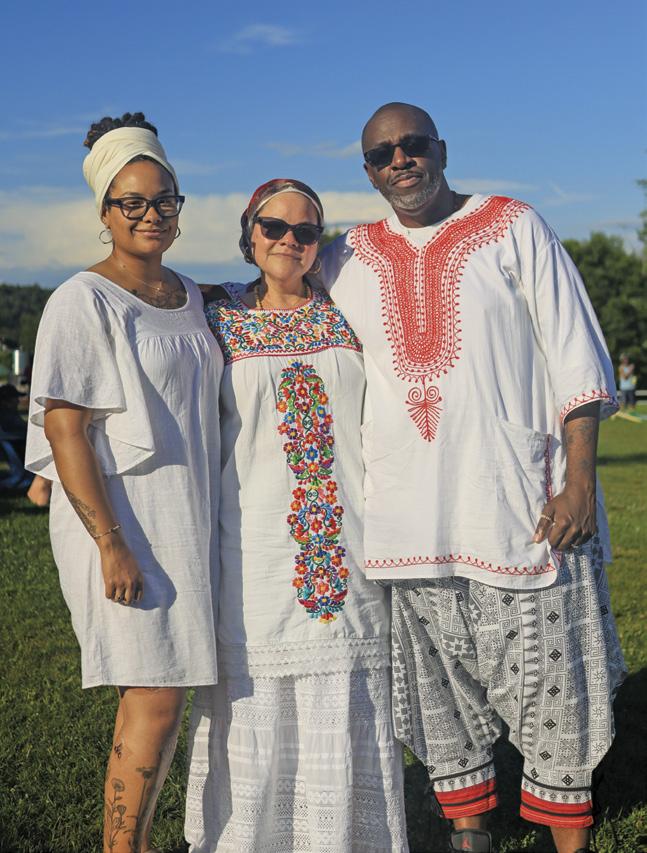
Kasso Condry has been an artist-in-residence and instructor at the University of Vermont, Princeton University, and Middlebury College. In 2017, he and Herrera married and founded Juniper Creative Arts in 2020, described on their website as “spearheading collaborative public arts initiatives inspired by Hip-Hop culture and the mystical, natural world.” Their most recent project, a mural at Manchester Elementary School completed this past June with local youths, explodes with the energy and color typical of the work that first caught the attention of Todd Lockwood and fellow committee members. This win for Kasso Condry came on the heels of the Vermont Prize, based solely on artistic excellence without the community component. He won that $5,000 award in 2022.
Now in its fourth iteration, the process surrounding the awarding of the Vermont Prize is not a secret. It was established when the leaders of the Brattleboro Museum & Art Center, Burlington City Arts, The Current in Stowe, and the Hall Art Foundation in Reading got together to recognize the achievements of one Vermont artist. This year, the directors and curators at those organizations—Sarah Freeman, Heather Ferrell, Rachel Moore and Maryse Brand, respectively—selected the winner. They were joined by guest juror Denise Markonish, the former chief curator at MASS MoCA in North Adams, MA, who in June became chief curator at the Madison Square Park Conservancy in New York City. Brattleboro multimedia/conceptual artist Jonathan Gitelson (b.1975) was this year’s winner.
Gitelson earned a BA in Literature and Photography from Vermont’s Marlboro College and an MFA in Photography from Columbia College, Chicago, IL. He is currently a professor of art and design at Keene State College in New Hampshire. His work is difficult to categorize and usually involves some form of photography, research, and social commentary. “The one connecting thing,” he said in an interview for Vermont’s newspaper 7Days, “is an interest in the minutiae of everyday life.” Gitelson has exhibited internationally and has a long list of awards and artist residency programs.
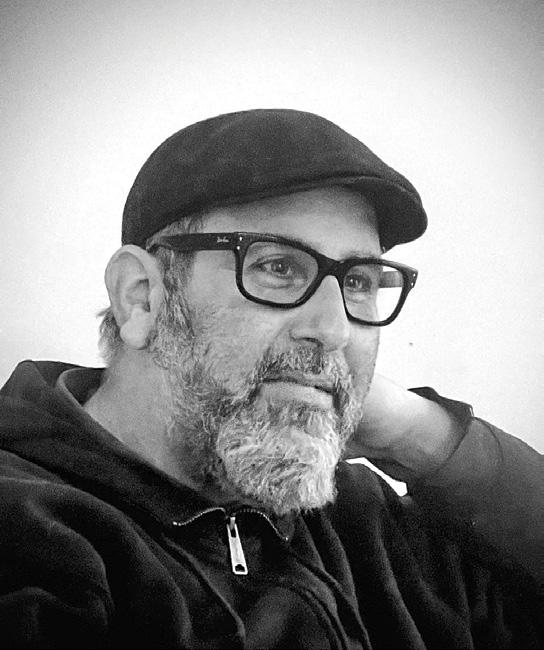
Capping the 2025 Vermont awards season was the July announcement by the Vermont Arts Council of the state’s longest running award program in the arts. Founded in 1967 the Governor’s Arts Awards have recognized outstanding individuals and organizations for their contributions to the arts in Vermont. Acclaimed photographer Dona
Ann McAdams of Sandgate, a 2025 recipient of the Governor’s Award for Excellence in the Arts, has been shooting photos for more than a half-century, with her work having been exhibited in the Museum of Modern Art, the Whitney Museum of American Art and La Primavera Fotographica in Barcelona. Since 1983, she has been bringing cameras and photography equipment into small, underserved communities, setting up community darkrooms, and teaching people how to shoot, process and develop their film to document their lives.
Additional Governors awardees include executive director Sue Higby of Studio Place Arts (SPA) in Barre. Higby has been a community leader for over two decades and is largely credited for the cultural revitalization of Barre. In 2025, SPA celebrates its Silver Anniversary. Higby is the recipient of the 2025 Walter Cerf Medal for Outstanding Achievement in the Arts.
Troy Wunderle of Chester, is this year’s recipient of the Ellen McCulloch-Lovell Award in Arts Education. A former director of clowning for the Ringling Bros. and Barnum & Bailey Circus and as director of Vermont’s Circus Smirkus, he has spent nearly three decades teaching circus arts to more than 115,000 students. Since 2007 he has been spreading circus magic through his performance-based company, Wunderle’s Big Top Adventures. Zon Estastes of Guilford, VT, has balanced, politics and activism, with a career as a music educator. He was chosen as this year’s recipient of the Margaret L. (Peggy)

Kannenstine Award for Arts Advocacy. For nearly twenty years, he worked as a cellist and conductor, teaching and coaching at the Brattleboro Music Center and at Amherst, Dartmouth and Keene State colleges.
The last of the 2025 Governors awards, the Arthur Williams Award for Meritorious Service in the Arts, brings us full circle. The award went to Will Kasso Condry, Jennifer Herrera Condry and Alexa Herrera Condry—known collectively as Juniper Creative in Brandon. Through camps, workshops, speaking engagements and public murals—more than forty of which decorate public schools and buildings throughout the state—the Condry family has made an impact on what they call “creative placemaking” making art that “honors and celebrates the lives and stories of the African Diaspora” thereby building a sense of community and belonging. Vermont’s recognition of these talented artists ensures that we will all have a little more of that in our lives.
Cynthia Close is contributing editor for Documentary Magazine and writes regularly for Art New England and several other publications.

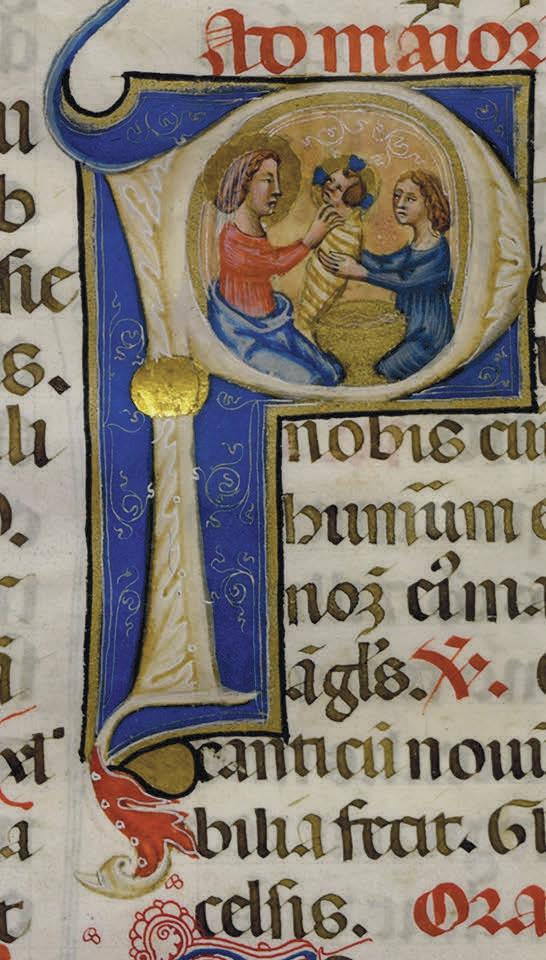




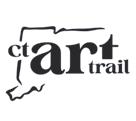
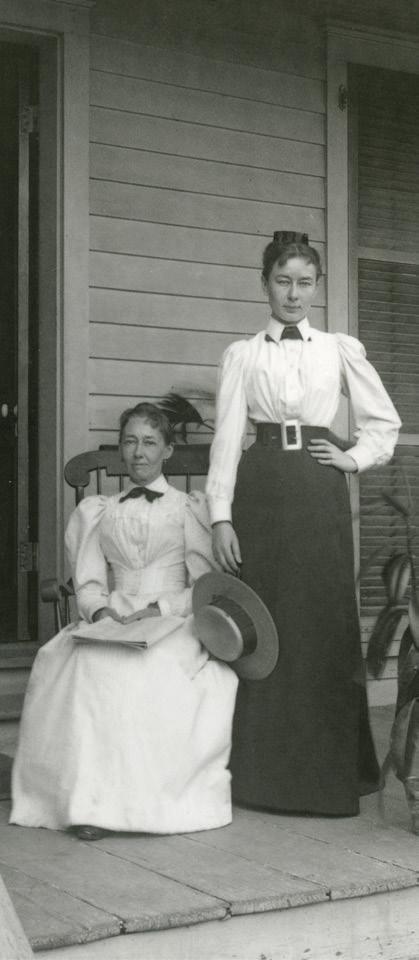

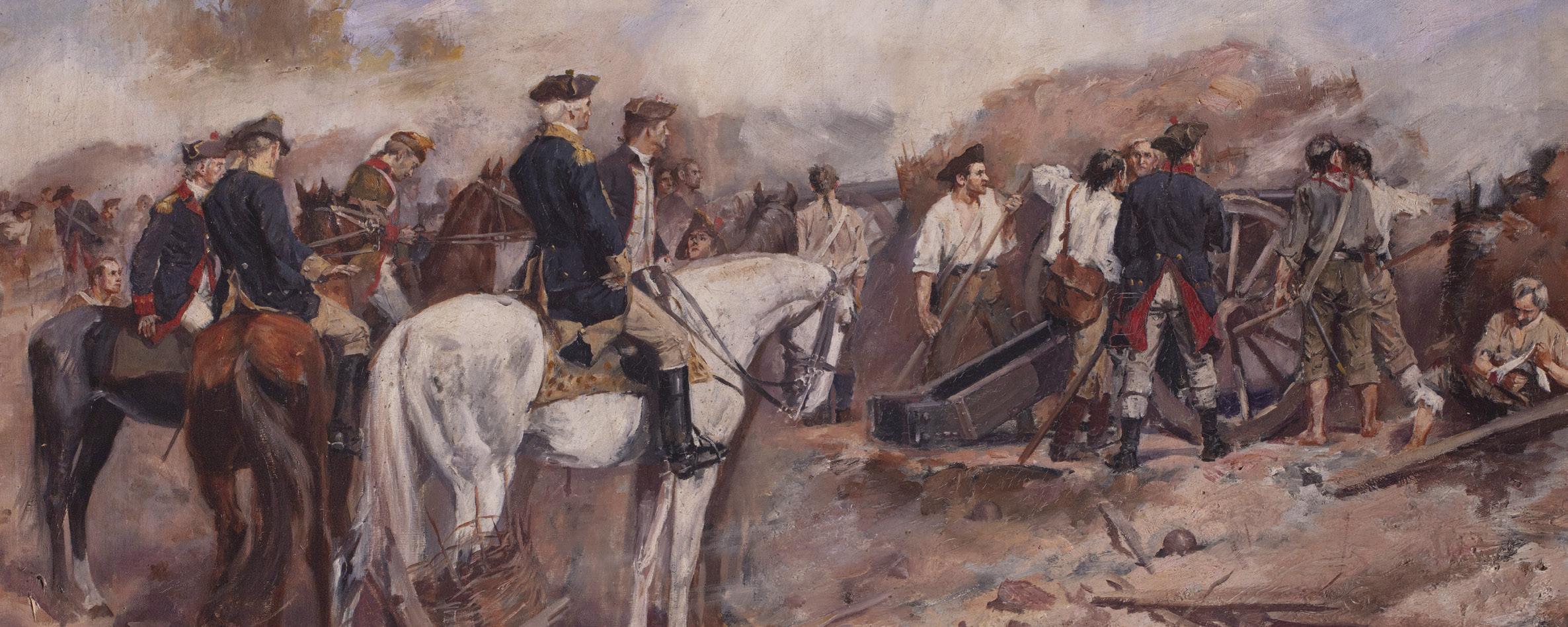


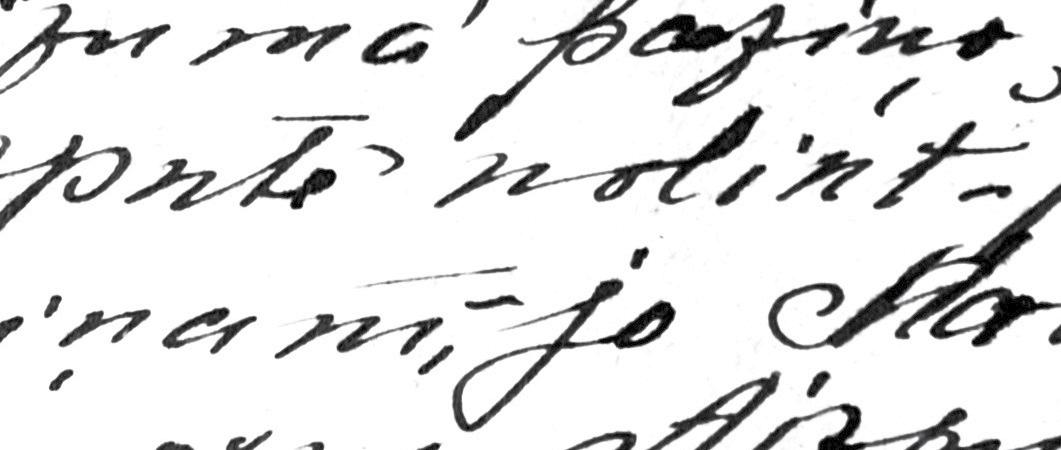







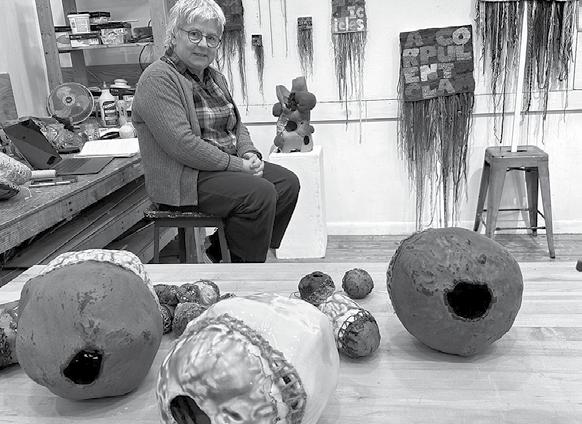
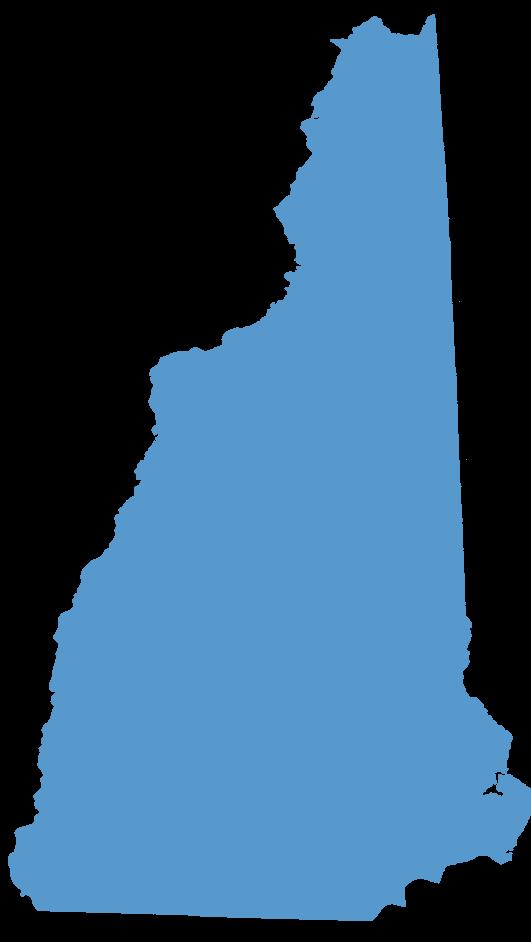

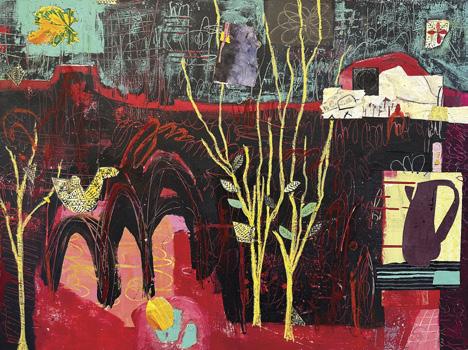
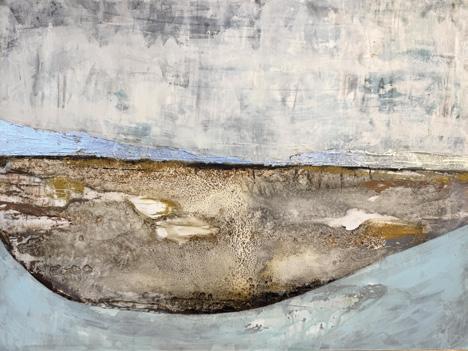


College of Visual and Performing Arts University of Massachusetts Dartmouth 285 Old Westport Road Dartmouth, MA 02747 (508) 999-9295
cvpainfo@umassd.edu umassd.edu/cvpa
CVPA, The College of Visual and Performing Arts, is a comprehensive arts college with Bachelor’s and Master’s programs that include studies in art + design, art education, art history, and music.

Danforth Art School at Framingham State University 14 Vernon Street, Floor 3 Framingham, MA 01701 (508) 215-5116
danforthartschool@framingham.edu danforth.framingham.edu
Danforth Art School offers exceptional art classes for all ages and experience levels. Featuring several innovative workshops, weekly study in many media, including open studio life drawing for adults. New toddler class in addition to fun, museum-focused fine art classes for children in grades K–12.
Fuller Craft Museum
455 Oak Street
Brockton, MA 02301 (508) 588-6000 x126
cbest@fullercraft.org fullercraft.org/classes
Find the Maker in you at Fuller Craft Museum! The Museum offers a wide variety of craft media classes, including a full suite of ceramics courses. They’re pleased to offer scholarships to increase access to arts education. Register (and apply for a scholarship) online, or email Charlie Best, Learning Programs Coordinator at cbest@fullercraft.org with any questions.
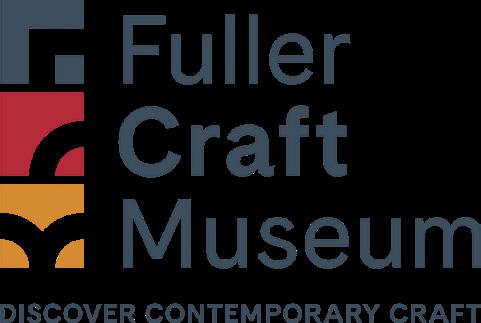
Montserrat College of Art 23 Essex Street Beverly, MA 01915 (978) 921-4242
communications@montserrat.edu montserrat.edu
Montserrat is an independent college of visual art, design, and art education offering the Bachelor of Fine Arts degree in 12 concentrations; year-round, lifelong learning for teen, youth, and adults; and several free, public galleries.

North Bennet Street School
150 North Street Boston, MA 02109 (617) 227-0155 info@nbss.edu nbss.edu/CE
Elevate your art, or explore an entirely new discipline. NBSS offers intensive, hands-on training and an inspiring community. Beginner through advanced classes in bookbinding, jewelry making, furniture making, carpentry, and musical instruments. Located in Boston’s historic North End.

Truro Center for the Arts at Castle Hill & Edgewood Farm 10 Meetinghouse Road P.O. Box 756
Truro, MA 02666 (508) 349-7511
info@castlehill.org castlehill.org
Truro Center for the Arts offers events and workshops in art, writing, and much more in an idyllic Cape Cod setting. Workshops include painting, printmaking, ceramics, sculpture, photography, fiber, culinary arts, and kids programming. Castle Hill also offers Artist Residencies.
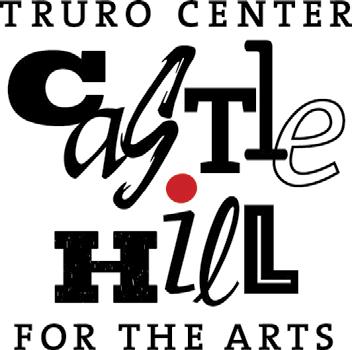
Watermark Press Printmaking Studio
Contact: Martha Jeffrey Galuszka 30 Arbor Street #205 Hartford, CT 06106 (860) 930-5491
watermarkprs@aol.com watermarkprs.com
A premier fine art studio specializing in chemical-free processes custom tailored to your printmaking interests. Etching press: monotype, intaglio, drypoint, carborundum, solar plate, pronto plates; Vandercook: relief, monotype and polymer letterpress. Private lessons, flexible schedules, and free press time.

UPCOMING DEADLINE for Guide to Art Schools and Workshops
November/December 2025 Space Reservation: September 26, 2025 Materials Due: October 3, 2025 The Guide to Art Schools and Workshops also appears online at artnewengland.com
Kenny Cole
41 West Main Street Monroe, ME (207) 322-5243
kennycoleartist@gmail.com kennycole.com
Vein Men, 2025, acrylic on canvas, 80 x 62".

SUSTAINABLE FURNISHINGS & FINE ART
11B West Main St., Wellfleet, MA (508) 214-0538
gallery@jeffsoderbergh.com
See website for their RI studio/gallery location jeffsoderbergh.com
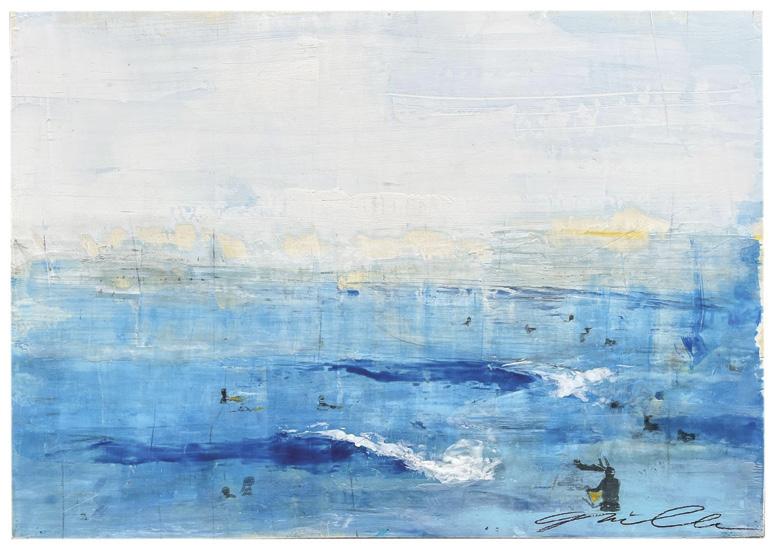
Susan M. Wadsworth
P. O. Box 225, 22 Mountain Road, Rindge, NH (603) 801-6746
susan.wadsworth@gmail.com susanwadsworthworksonpaper.com instagram.com/susanwadsworth.art facebook.com/susan.wadsworth.37
Visit her studio October 11–13 for the Fall Foliage Art Studio Tour: fallfoliageartstudiotour.com/rindge-artists.html
Beals Island, Maine, 2025, pastel, pencil, and ink on paper, 11 x 14”.

Spring View through
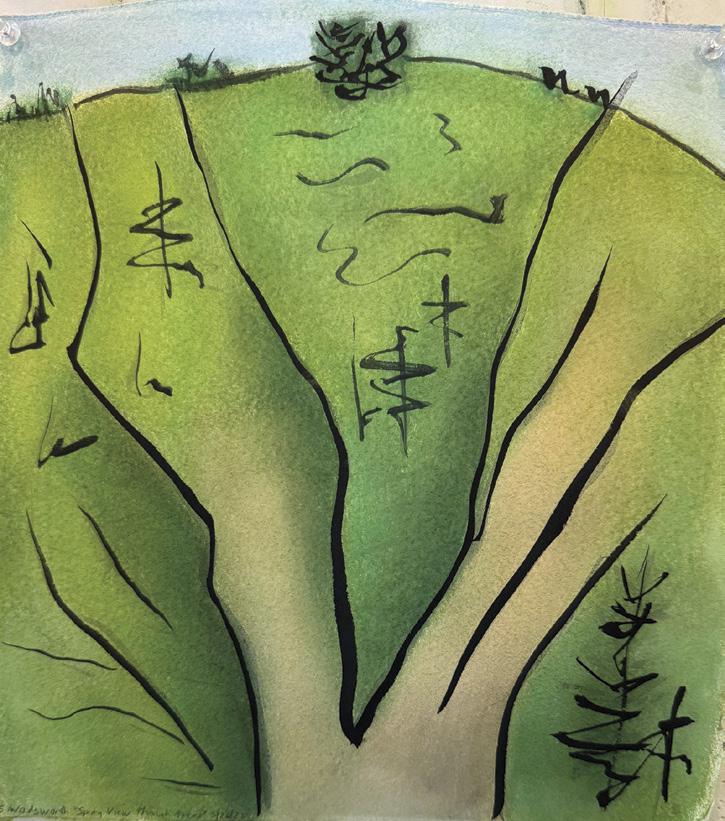


Marcia Crumley
joyful, layered landscapes
Blue Door Gallery, York, ME
Edgewater Gallery, Middlebury, VT
Galaray House, Lexington, MA
Candita Clayton Gallery, East Greenwich, RI (617) 794-6497 instagram.com/marciacrumleyart facebook.com/marciacrumleyart marciacrumleyart.com
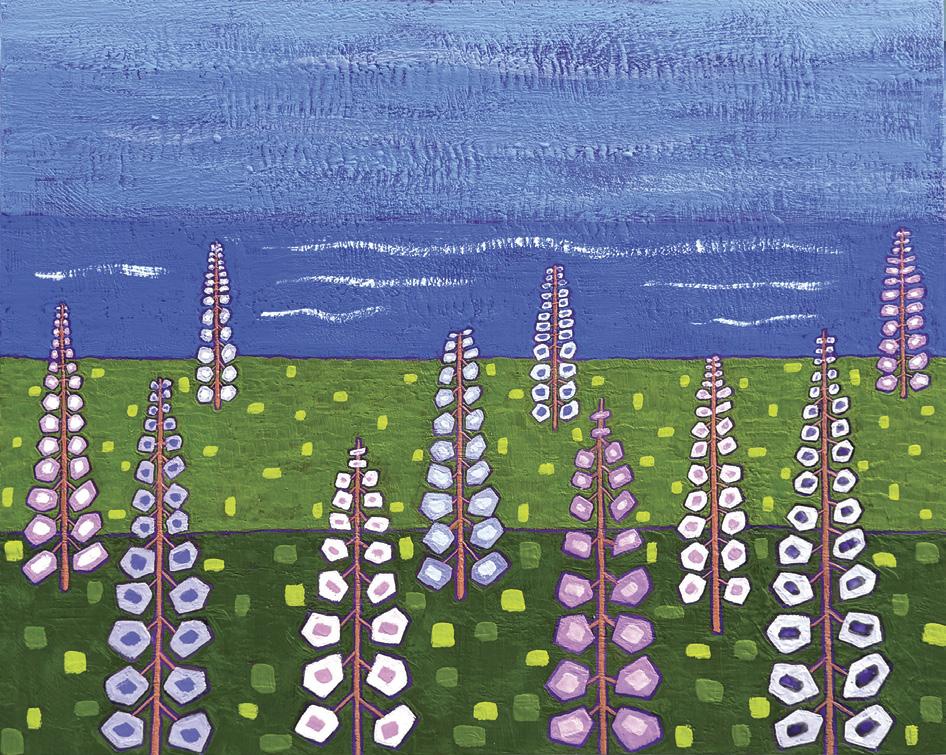
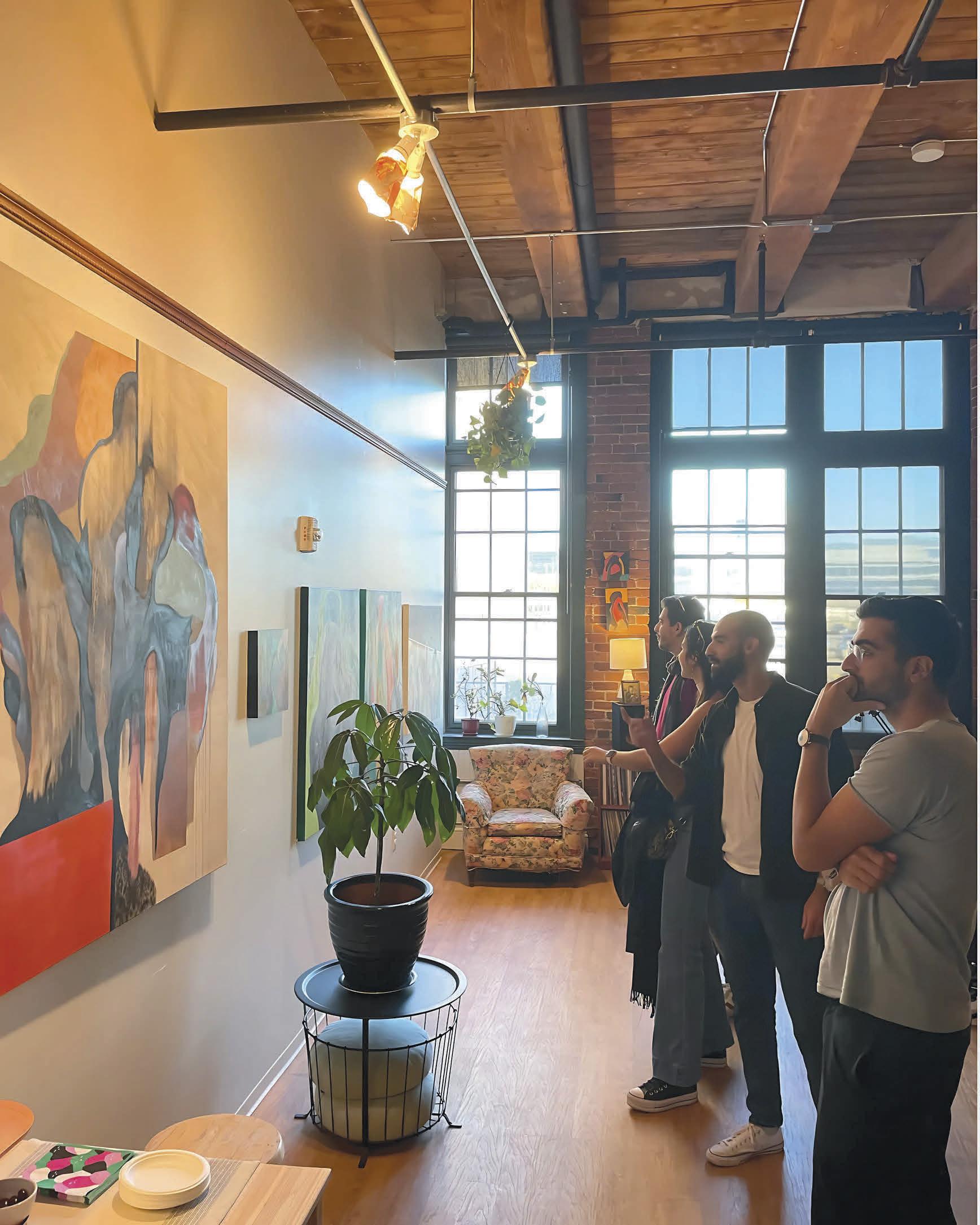
Gayle Morrow Emotions in Glass Sandwich, MA (508) 246-6246 emotionsinglass@gmail.com @myemotionsinglass


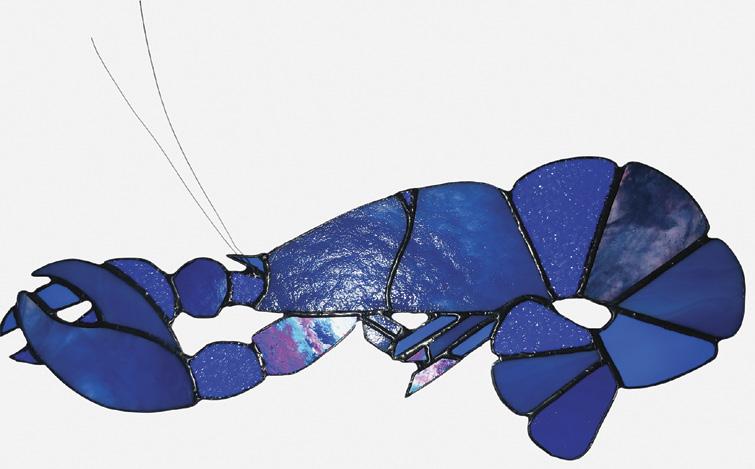

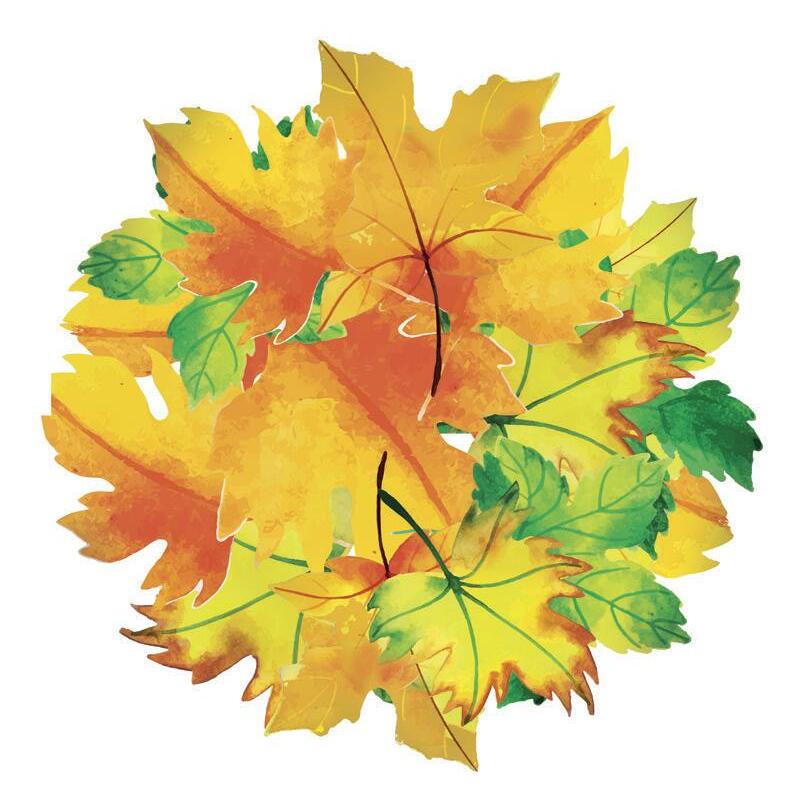
October 12–14 ~ 10 am – 5 pm
A vast array of mediums and styles, and an intimate setting to chat with world-class artists in their element.
This self-guided tour takes you through breathtaking fall landscapes and picturesque towns of the Monadnock Region in Southern New Hampshire. Studios open Oct 12– 14, Saturday, Sunday, & Monday.

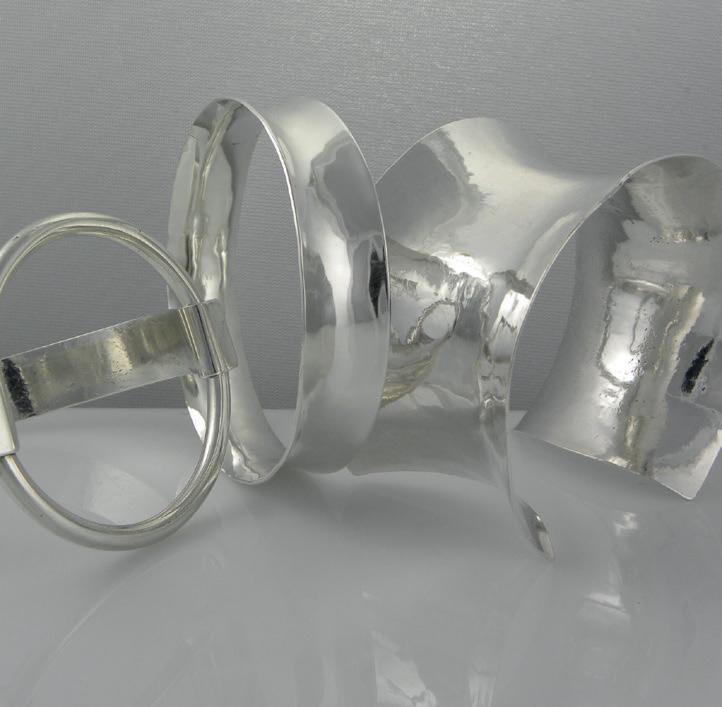
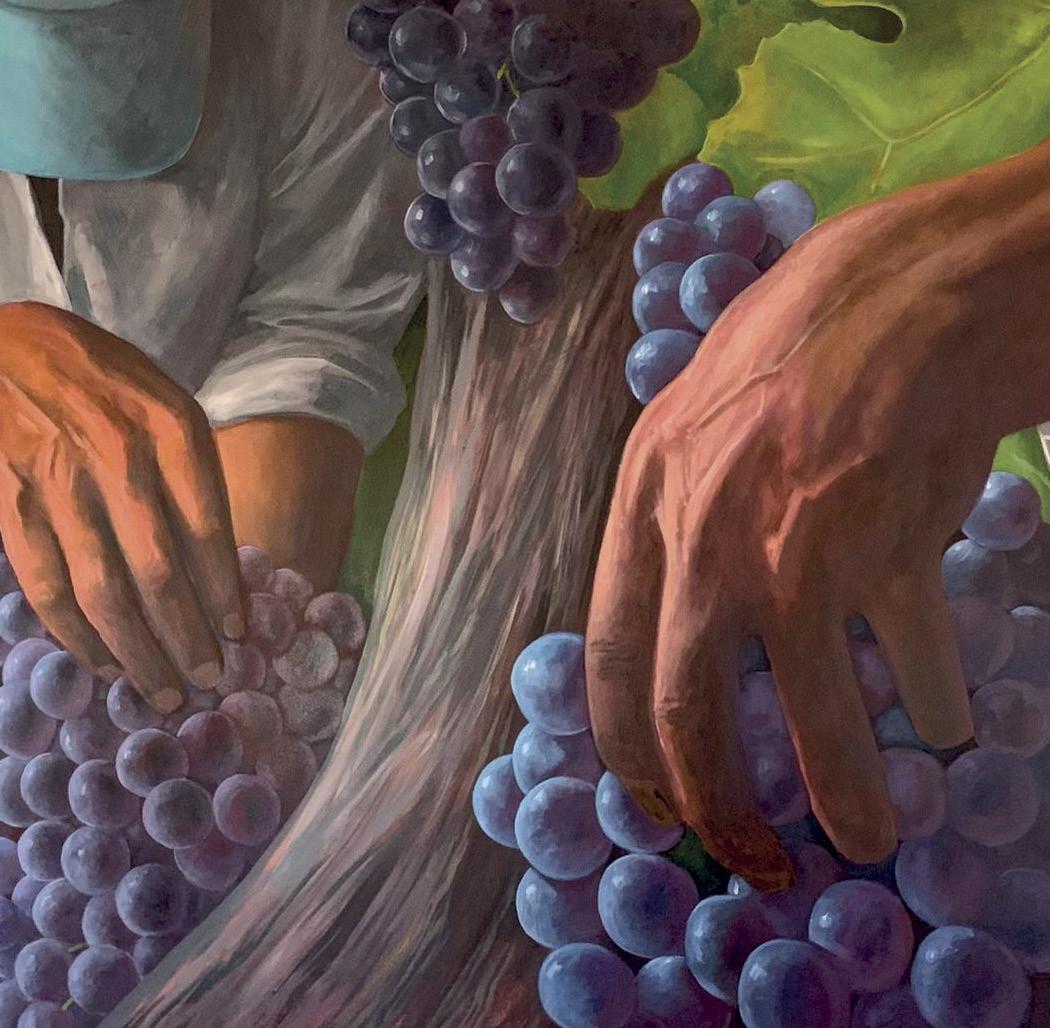
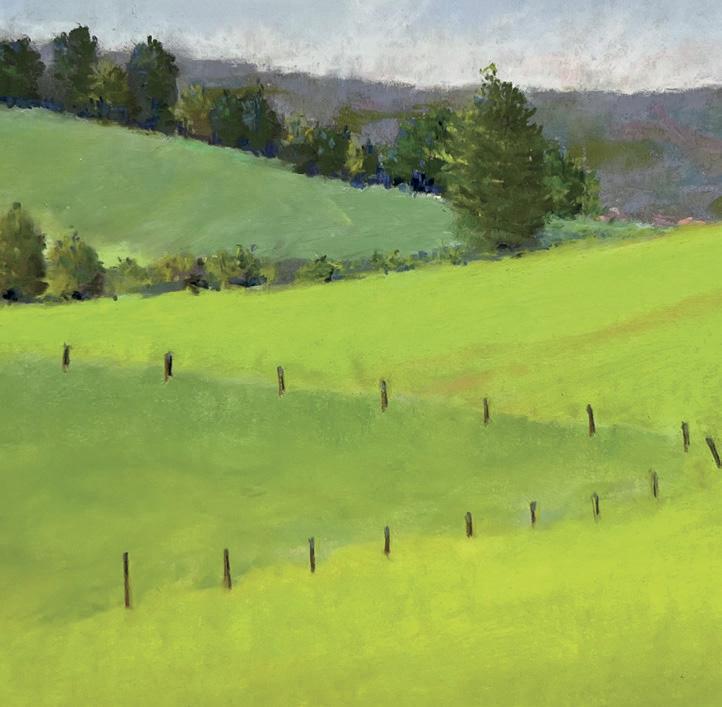

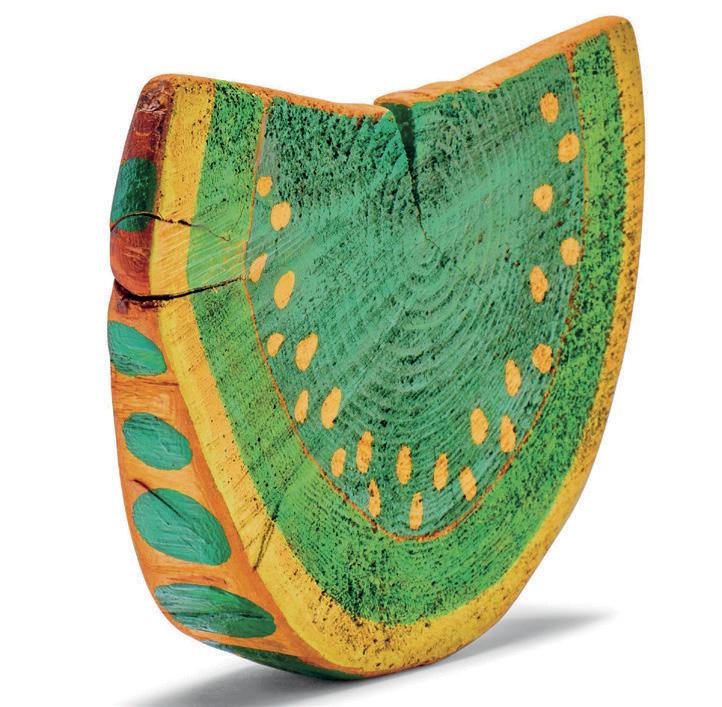
By B. Amore
Entering Jonathan Latiano’s space at Miller Street Studios in Somerville, MA, one is immediately struck by the scale of the space itself with its nearly twenty-foot ceilings and concrete floor. The central area is open. Tools, stored materials and works in progress are generally on the walls, and on a couple of tables. One is struck by how organized everything is, packed efficiently right up to the rafters.
Inquiring about an object on the work table—bones of a polar bear paw, over a foot tall. Latiano shows this writer its place on a fifteen foot skeleton suspended on the wall, a work in progress carved and constructed of Styrofoam painted white. To the right is a mass of black foam angular protrusions. The whole is still very much in an evolutionary phase.
The majority of Latiano’s work is large scale, often room-size installations that exist for the duration of an exhibit and are dissembled when the show is over. All of the elements are saved, often recycled into other installations. The
principle subject, often an extinct species, has been carefully configured in a minimalist but expressive form, and given a new “temporary” life in the present. In Love to the Letter and the Letters Spelled Death, (Boston Sculptors Gallery, 2022), he fabricated a massive white rhino atop a mountain of hand-cut black foam.
Charcoal drawings fill a section of wall, often containing dark circles or areas of lined repetitive rhythmical forms, multi-hued in subtle shades of grey to deep black. The drawings are often a way that Latiano clarifies his ideas, even over a period of years, as he ponders the connections between art and science, life and extinction, and our perception of scale through the lens of human scale. He credits early trips with his parents to various museums, in particular the Philadelphia Academy of Natural Sciences, with lifelong inspiration.
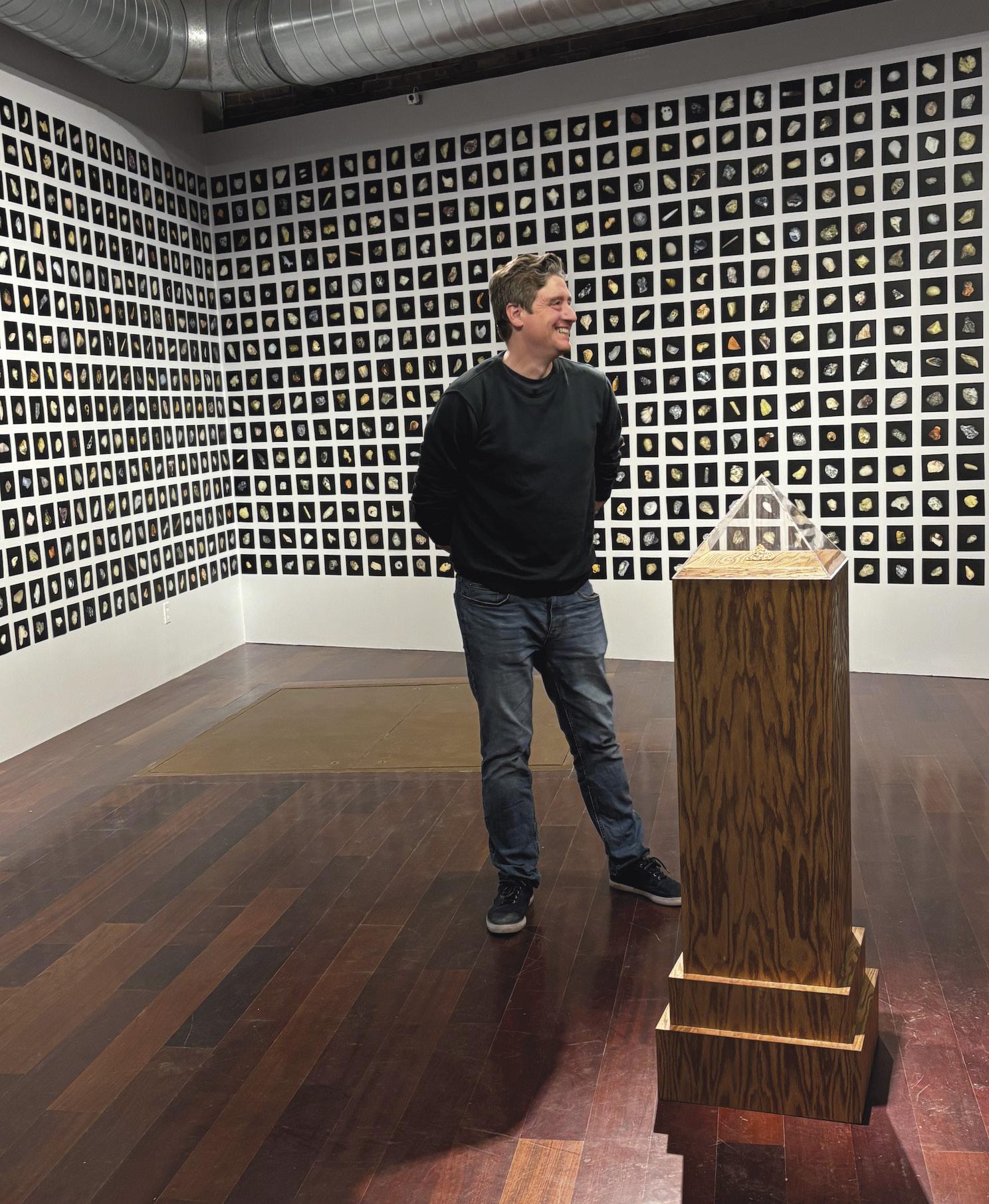
His most recent installation, Scaling a Pyramid, filled the entire rear gallery of Boston Sculptors in March 2025 and was recently re-installed at Chimaera Gallery in Pennsylvania. Latiano presents microscopic color photographs of 2,238 grains of sand in grid formation around the walls of the gallery. In the center is a pedestal supporting a tiny twoinch sandcastle pyramid built of coral sand, scaled at 1:5,761 the size of the Great Pyramid of Giza, which he chose because of its iconic relationship to scale. Latiano feels that the only way to understand the correlation is to abstract it. A newly published book, Scaling a Pyramid, is a part of the work itself as it allowed Latiano to capture the ideas behind the project, the collaborations and the processes that went into its creation over a period of 2½ years. Scaling a Pyramid is massive yet in an entirely different way than former installations. When visiting the island of Jamaica in 2014, Latiano became aware

of the fact that the coral sand beach that he was walking on had a very different consistency than the fine grained sand he was accustomed to. Upon further inspection, he realized that it was made up of tiny fragments of coral shells, bone, etc. Fascinated, he filled a soda bottle and preserved it in his studio. Each photograph of a miniscule grain is a revelation of an element that is potentially millions of years old. Latiano says, “They represent the enormity of the earth’s geological history, its complexity, and our own intertwined spatial relationship to it.”
Latiano is director of the Studio Arts Program at Merrimack College where he encourages the same spirit of active investigation and experimentation in his students. His attitude of continual question, concern, and care for humanity and the environment, is evident in all of his work. Latiano’s interest in ephemerality and mutability of life is reminiscent of the Buddhist tenet of impermanence, a basic fact of our lives but one which many people have difficulty accepting. His works on extinct species are a poignant reminder of how fleeting our journey on this earth is.
To be made more keenly aware of this through a work of art may assist us in attaining a deeper understanding of ourselves as part of the cosmos—a very different perspective than the day to day concentrations that usually fill our minds. We are each like one grain of sand, a small part of the whole. The bliss of this consciousness of interconnectedness is the profound gift of Latiano’s art.
B. Amore is an artist, writer and founder of the Carving Studio and Sculpture Center in Vermont. Awards include Fulbright and Mellon Fellowships, public art commissions in U.S. and Japan.
jonathanlatiano.com
By Cynthia Close
I
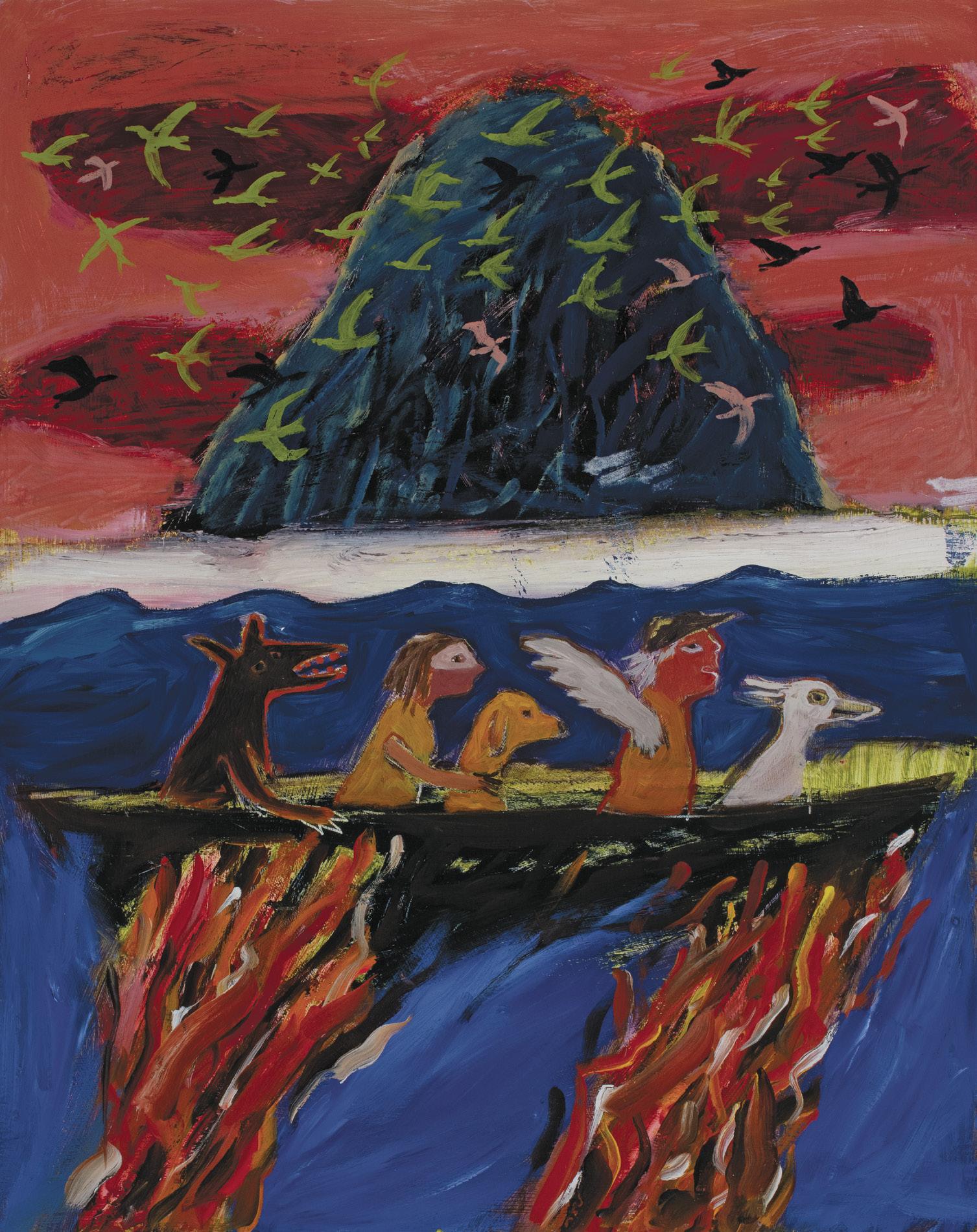
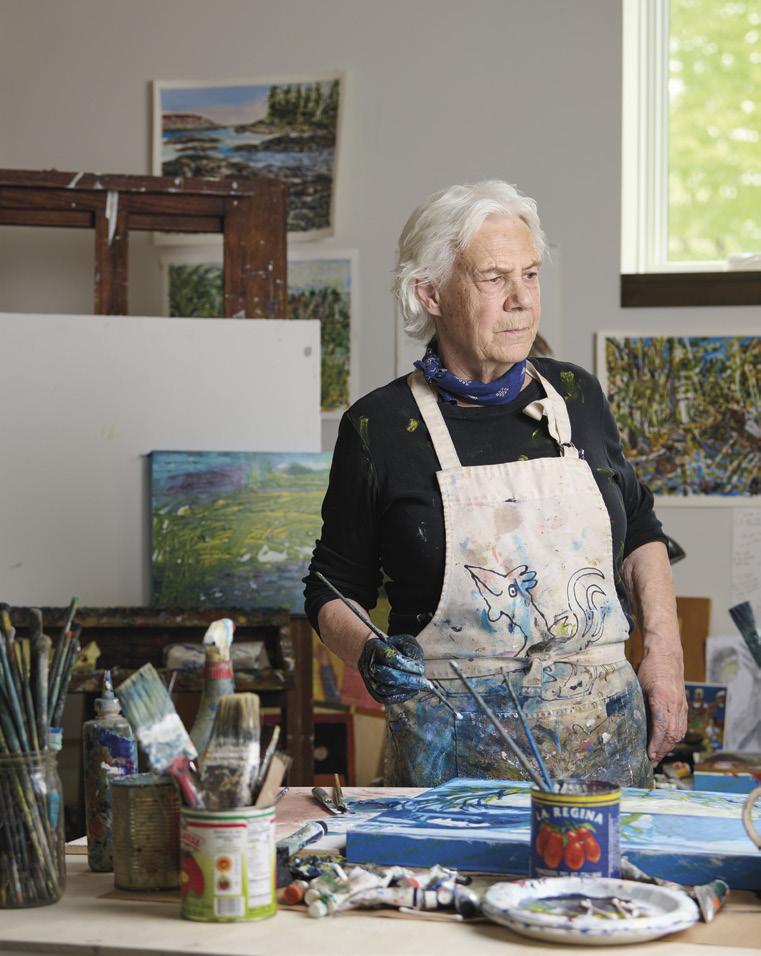
Fearlessness is a required character trait for anyone who pursues a career and a life as an artist. As a ten-year-old whose curiosity led her to climb inside a beaver den to see what it was all about, Anna Dibble exhibited that kind of fearlessness. This event was also evidence of a deep interest in the natural world and an awareness of the creatures that inhabited that world which now has infiltrated Dibble’s choice of subject matter. Decades since exploring that beaver’s domain, this quintessential New England artist and native Vermonter now has the time and energy to devote herself full-time to painting in her Maine studio.
The oldest of four children born into a creative family in rural Vermont, Dibble attended a one room schoolhouse. In those days kids were expected to entertain themselves, roaming around outside most of the time, unsupervised, usually only coming home to eat and sleep. This sense of freedom in nature that Dibble experienced also honed her observational skills and her intuitive approach to decision making. Although she studied art at various times at Parsons, The New School, The Boston Museum School, Vermont Studio Center and Pittsburgh Art Institute, she identifies as a “self-taught” artist, a description that she prefers rather than naïve, or outsider, which at a cursory glance is where her deceptively innocent, almost childlike depictions of critters and figures flitting about in the wild might seem to fit.
During an interview in May 2025 with this writer, Dibble modestly confessed, “I’m a college dropout. I couldn’t deal with school.” Dibble’s independent approach, avoiding the trappings of academic degrees and other honorifics reflects a generational pattern. She comes from a family of self-taught, yet successful, professional artists. Her father, Thomas Reilly Dibble, was a painter

who studied at the Art Students League and also ran a picture framing shop. Her grandfather was a cartoonist and landscape painter. Besides birthing and raising four children, her mother was a pianist, which contributed to Dibble’s ability to read and write music. It was after WWII and her parents were living in New York City where they surrounded themselves with a rich coterie of creative artists, musicians and writers. After they moved to Vermont seeking a better environment to raise a family they continued to host their creative city friends like sculptor Lothar Wuerslin, printmaker/sculptor George Nama, and painter Paul Stopforth, all of whom had an influence on the young Dibble.
Dibble’s innate creativity extended into the fields of writing, set design and music. When she was in her 20s, she made her living writing, drawing cartoons and doing paste-up for a local newspaper, The Manchester Journal. At the age of 29 she found herself in California. While there she connected with a guy who was involved with the burgeoning field of animation. Dibble managed to find jobs with some of the best commercial and independent animators of the day working for Disney, Marvel, Hanna Barbera, Murakami-Wolf and others. This was in a time when animation was very much a labor intensive, hands-on endeavor. She also completed ventures in music composition and set design for the Children’s Television Workshop, the creators of Sesame Street.
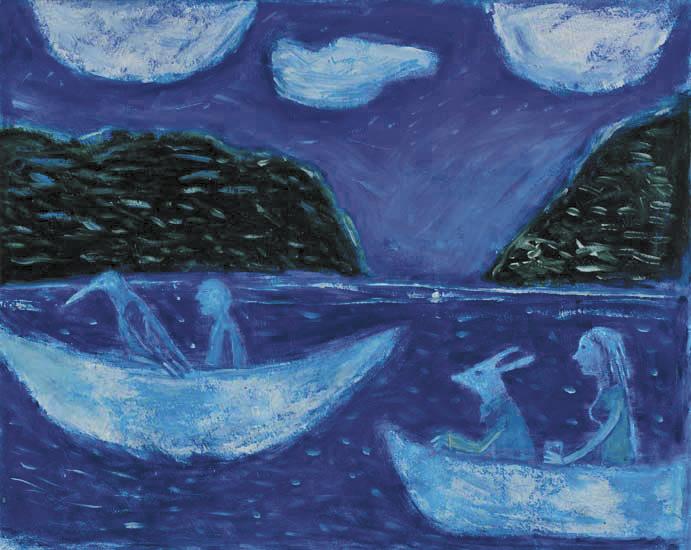
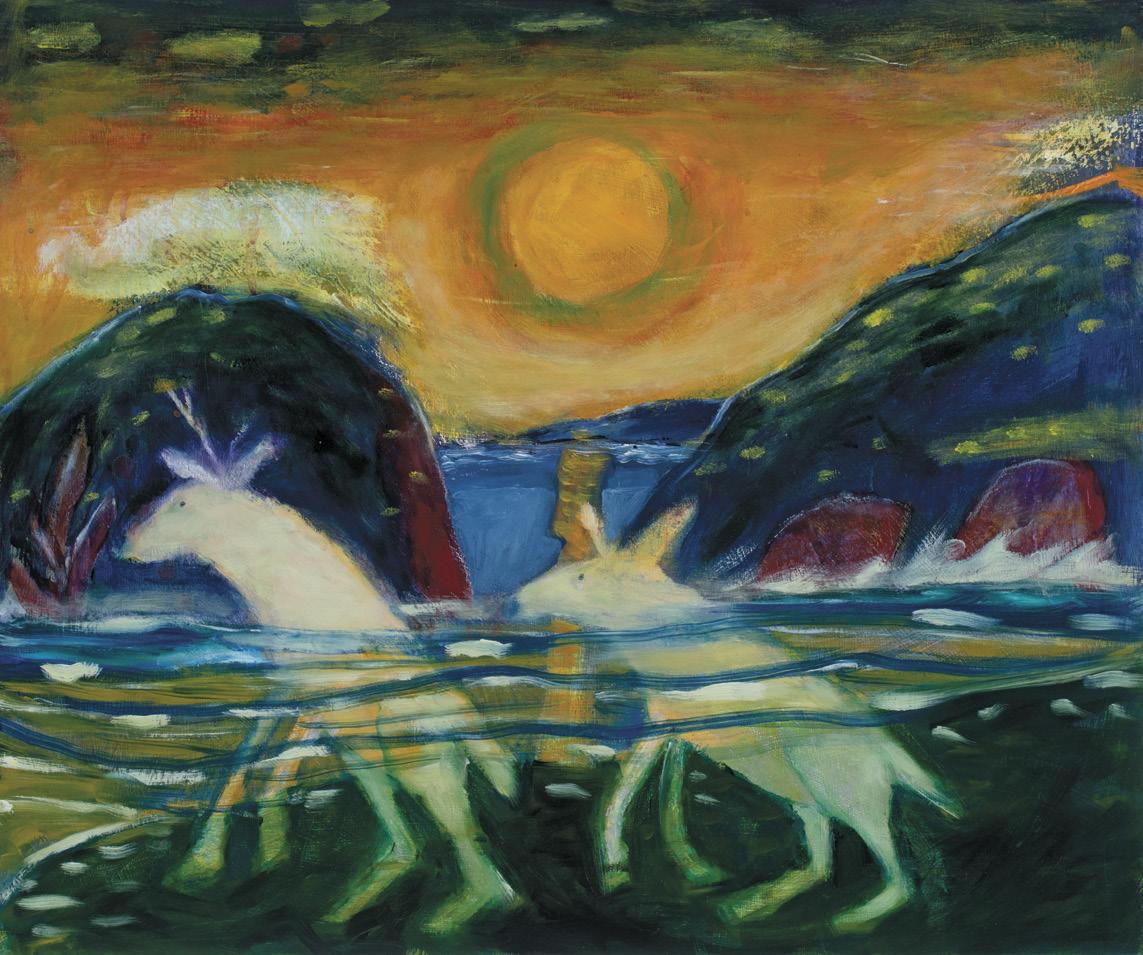
In 2018 Dibble founded and directed a multi-year collaborative public art/ocean science initiative: The Gulf of Maine Ecology Arts Project, focusing on the changes in biodiversity in the Gulf due to climate change and human impact. The central piece was a massive sculpture installation featuring an artist-student-built right whale and other endangered marine animals made from recycled, re-purposed materials. The project culminated in two exhibitions, the first in 2021 at Bigelow Laboratory of Ocean Science, Boothbay, Maine, and lastly, SeaChange: Darkness & Light in the Gulf of Maine at Maine Maritime Museum in Bath, ending in January 2024. The project was an all-consuming endeavor directly related to themes that are central to Dibble’s painting. With that large public facing project behind her Dibble explains, “Now is the best time of life… I live in a small house near Portland, ME, and can focus full-time on my art.” Although her experience of the natural world fuels her work, she says, “I’m a studio painter. I don’t paint en plein air. It comes out of my head. I go up to the studio about 9 am and paint for several hours. I work on gessoed wood panels, and I’ll start at a time. I do a lot of drawing. The painting process involves a lot of layering… Images evolve intuitively. My landscapes tell stories.”
Although relatively modest in size, Dibble’s
Above: Such Stuff as Dreams are Made On, 2024, oil on panel, 16 x 20". Golden Slumbers, 2024, oil on panel, 20 x 24". Below: Of the Shadows Deep, 2023, oil on panel, 30 x 40". Opposite, from top: A portrait of Anna Dibble in her studio in North Freeport, ME. Photo: Winky Lewis. Natural Forces, 2024, oil on panel, 16 x 20". Artworks courtesy of the artist.
landscape stories pack a punch. Their energy is reminiscent of another independently-minded New England painter and essayist, Marsden Hartley (1877–1943). Powerful color contrasts, flattened forms pushing forward in robust compositions along with whimsical figures battling the elements, are frequently found when surveying Dibble’s work. Humans and animals share boats navigating rough blue seas as violent red and yellow rain pummels them. Dibble is one of those rare painters to take on the challenge of capturing the mystery of night and succeeding. Her whimsy is enmeshed in dread.
Anna Dibble’s paintings have been featured in solo, group, and invitational exhibitions in museums, cultural centers, and galleries throughout New England and New York for over forty years. Summer 2025 was also a busy one for Dibble. The Cynthia Winings Gallery in Blue Hill, Maine has represented Dibble’s work for nine years and hosted a solo exhibition for Dibble this summer. Dibble enjoyed a joint show a joint show of her paintings with artist Katherine Bradford at the Caldbeck Gallery in Rockland.
Cynthia Close is contributing editor for Documentary Magazine and writes regularly for Art New England and several other publications.
annadibble.com
By Jennifer Mancuso

Visionary Robert B. Stull passed away in April 2025 at the age of 58, after a private battle with cancer. Stull, a Boston native is remembered as an accomplished illustrator, graphic designer, educator, and mentor.
The illustrator was born to prominent Boston architect Donald Stull. One of the first Black architectural firms in the country, Stull and Lee Associates would play an instrumental role in the development of Boston after the initial location of I-93 was modified due to community activism. Designs included the award winning Ruggles Station, Roxbury Community College, and the Southwest Corridor, a four-mile bike path from Forest Hills Station to Copley Square Shopping Center. In addition to his father, the younger Stull was influenced by his late paternal uncle, artist Robert J. Stull, one of the first professors in the Black Studies department at Ohio State University and his late maternal uncle,
artist Mahler B. Ryder, founding member of the Studio Museum in Harlem and faculty member at Rhode Island School of Design.
With this creative DNA, the youngest Stull was pulled into the culture shift of the 80s with Hip-Hop and graffiti. “I felt like we had command over the whole city,” Stull said in a 2024 Art New England interview. The five-part series AEROSOL reunited nine former graffiti writers to reflect on their careers in the city that ignited their creative pathways. “To see [graffiti] evolve here in Boston as a community, what these guys are doing is truly amazing stuff,” the artist had said of his AEROSOL brotherhood. “It’s like they took what was there and expanded on it.” Collaborator Thomas “Kwest” Burns met Stull as a young writer and brought him into the project. “We connected like any team of superheroes,” says Burns. “We were born into it.”
A graduate of the Museum School, the artist
was determined at an early age to illustrate the superheroes of his youth. “What he contributed to the Marvel Universe was something,” says actor Naheem Garcia. “Not everyone from [Boston] had these opportunities,” Garcia says. Stull would go on to work for every major comic publisher including being a member of the original Tello’s creative team. While cartoons were widely used in graffiti, for his urban fraternity, Stull’s crossover into comics was transcendental. “First of all,” remembers Chepe Leña, friend and fellow AEROSOL contributor, “there’s a Boston cat who draws Spiderman professionally? How many people can you say that about from here? That alone speaks loud about his talent and on top of that, his commitment.”
As one of the Isabella Stewart Gardner Museum’s Salon Luminaries in the 2019/2020 cohort, Stull was representing former graffiti writers in a way they could not have imagined in their youth.
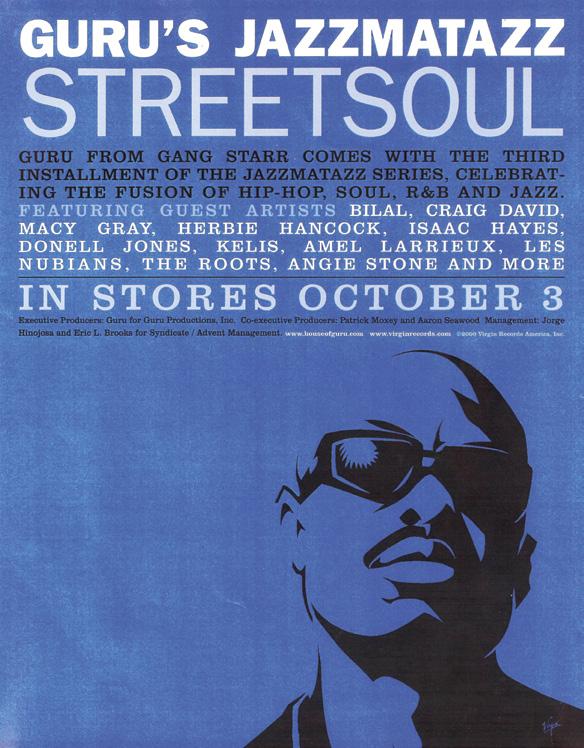

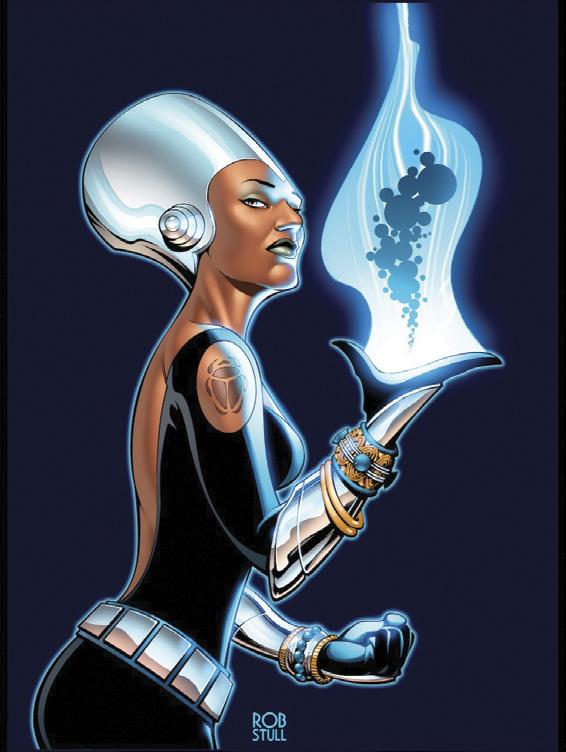
“The thing about Rob was that he was one of the first guys to break through and be recognized by the larger arts community. Even though he’s doing this renegade style, he goes on to work for Marvel, for DC Comics…. And he gives us the idea that, wait, we can do it too,” says Dart Adams, author and historian.
Later Stull’s love of Hip-Hop would again collide with his artistry when he was invited to design for Geechi Suede, Dinco D, and the late rapper Guru as well as brands including Timberland and Converse. He created and curated the exhibition Sequential Art: The Next Step which traveled for ten years and displayed Black comic book artists in a place of prominence within the industry. In 2020, as one of the artists-in-residence at the Museum of Fine Arts, Boston, Stull was the first Black and first Bostonian to design the banners to hang during the exhibit, Writing the Future: Basquiat and the Hip-Hop Generation. The banners were tribute portraits of subway graffiti’s early pioneers: Basquiat, FUTURA, Lady Pink, and Rammellzee, penned in Stull’s signature style. To represent the past, present, and future, Stull included a self-portrait with a likeness of ProBlak as canvases.

A joint comic book and mural were part of the project. Legendary graffiti writers, such as FUTURA, would be guests of the exhibit and for two graffiti kids from Boston, it would be a moment that defied even their dreams. “He penned a path to have our styles and our voices heard and to have that honor to share space with him in a moment that was a part of the city’s history,” says ProBlak. “I don’t have the words.”
To demystify the industry, Stull went on to mentor other creatives interested in illustration. Artist and clothing designer, Jacob Leidolf was one of Stull’s mentees with whom he worked on the album Pinky Ring Espresso. “It’s part of this Hip-Hop culture,” says Leidolf. “To be part of an intergenerational supportive community, to work with each other and make it a better place than it was when we showed up, I think Rob did that, for sure,” says the younger artist. Stull carried the term “big brother” to many successors in the local art scene. “In that way, he was a mentor for so many people and there are a whole lot of us who are carrying that spirit forward,” says Leidolf. Just a few years younger, Burns also looked up to Stull. “He’s dearly missed,” says Burns. “His willingness to share information made the art world feel safer. He was a great asset in that regard.”
Before his passing, Stull directed much of his energy towards legacy. As a companion to the AEROSOL series, Boston’s Graffiti DNA, its Origin, and Evolution exhibited the participating artists at South End’s ShowUp Gallery and Seaport’s BLK Chip Gallery in winter 2025. “We realize that Rob was part of a continuum because his dad was an architect who creates these [buildings] that we see every day and it peppers how we see the world,” says Adams. A lifelong resident of the South End where many of the elder Stull’s buildings are concentrated, Adams sees similarities in the artistic legacy of father and son. “They were impacting the neighborhood and the community in two different ways.”
Even though the career of an illustrator is lived in the shadows, Stull’s story continues to
impress his childhood friends. “Looking at his catalogue, he did some amazing professional work,” says Leña. “Then learning, he is the one who wrote ‘NOTE’, in our [graffiti] days, was wild,” he says. While Stull’s work has been viewed widely, comic book artists themselves are not as well-known. It is the nature of their craft. “Do you capture the art or the person? Cause it’s the person we really care about,” says Leña.
Leña and others are determined to keep Stull’s legacy alive through their work. “Our last documented conversation, was really our first,” says ProBlak. “When I look back, he was leaving me instructions of what to do moving forward. [Rob] was like, this is what we started together, and I was with you to assure we put this footprint in the sand. Now, you have to keep going.”
In February, Stull's last public appearance would be an artist talk discussing the things he loved: Hip-hop and graffiti. “I parlayed graffiti into a professional art career, but I always acknowledged my starting point, and I always look back,” said Stull. “It’s sort of like in the spirit of Sankofa—you move forward by acknowledging your past and where you come from.”
A Celebration of Life is planned for Stull on Friday, October 17, 2025 at The Strand Theatre in Boston. Visit the artist’s website for details.
Jennifer Mancuso holds her MFA in writing from the New Hampshire Institute of Art. The writer is completing a set of novels based on her experience growing up biracial while passing.
robstull.com/art/
Flinn Gallery at Greenwich Library, Greenwich, CT • flinngallery.org • September 18-November 12, 2025
Sand, cardboard, paint, lacquer derived from the sap of the Rhus Succedanea tree, handmade Do paper… these are just a few of the materials deployed by the nine Vietnamese contemporary artists whose work comprises Vietnam: Tradition Upended opening at the Flinn Gallery in the Greenwich Library in September. The exhibition is the culmination of a series of fortuitous connections that brought together its three curators—Debra Fram and Barbara Richards from the Flinn and Suzanne Lecht, director of Art Vietnam Gallery, in Hanoi, who is considered a leading expert on Vietnamese contemporary art. Marking the 50-year anniversary of the end of the Vietnam War, this exhibition isn’t meant as a commentary of any kind on that war—instead, it celebrates the profound growth and change in the country as reflected in the work of these artists.
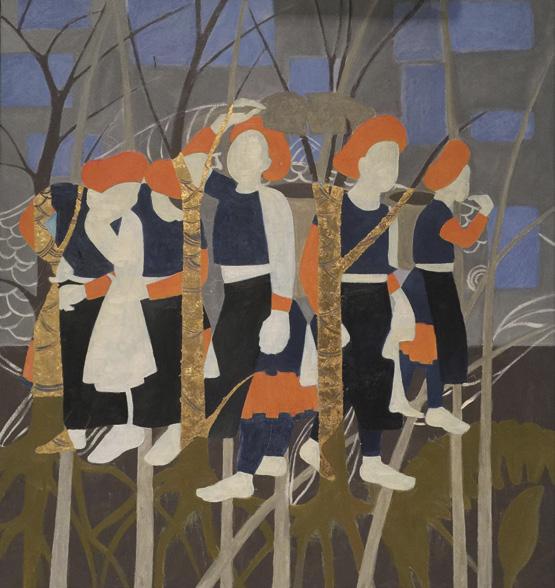
When Lecht started her gallery in Hanoi in 1994, not long after moving to Vietnam and being introduced to the pioneering Gang of Five, her goal was to “work with these amazing artists who make this beautiful work… and create a bridge of reconciliation between America and Vietnam… that had nothing to do with the war. It was about moving forward and
REVIEW: CONNECTICUT
recognizing the strengths of both countries.” That goal continues to this day and informs the ideas behind Tradition Upended.
As Lecht explains, “We wanted to show artists that were doing really unique work, and in particular, artists that took materials, thoughts, ideas, and concepts that were uniquely Vietnamese… yet transforming them into some kind of universal idea.” One of these artists is Ha Tri, one of the Gang of Five, who co-curator Richards describes as “one of the trailblazers who opened the door for international recognition for contemporary artists in Vietnam.” As Lecht puts it, “The concept of the exhibition was all about transforming nations, transforming people, transforming materials, transforming concepts.” Co-curator Fram adds, “That’s how we should be looking at other cultures, other people, and the rest of the world; because that’s how we can come together through understanding.”
The nine artists include Nguyen Cam, Ha Tri Hieu, Le Thua Tien, Dinh Thi Tham Poong, Vu Kim Thu, Pham Van Tuan, Vo Tran Chau, Le Thuy, and Antonius-Tin Bui. (Note: Artists Antonius-Tin Bui and Vu Kim Thu will be giving an artist talk on September 20 at the Flinn.) —Julianna Thibodeaux
The Glass House, New Canaan, CT • theglasshouse.org • Through December 15, 2025
As part of its programming, the Glass House periodically invites artists to respond to its site, and the current iteration of this features Chicago-based artist Barbara Kasten. The earliest works on view are her iconic 1980s Polaroids, which hang in the Brick House reading room (redesigned in the same era). In the larger photograph, Architectural Site 15, Kasten transformed the Whitney using colored gels and mirrors that collapse “the boundaries between the building’s stark angular exterior and its interior circular light fixtures.”1 Nearby, two more Polaroids feature reflective and translucent geometric objects Kasten arranged in her studio to form constructivist compositions. In the Painting Gallery, florescent digital prints from 2019 and 2023 flank the entryway, harmoniously cohabiting with Frank Stella’s paintings. Straddling past and present, Kasten’s reworking of Sideways Corner (2016)—cube seats in primary colors and a video that animates them—playfully converses with Da Monsta’s curved walls.
Kasten also created site-specific projects for the exhibition. In the Brick House, five blue and white abstract cyanotypes interpret the skylights’ interplay of the light and shadow. At The Glass House, colorful Plexiglass forms sit nested on the glass table, joining it in reflecting the surrounding
1. Quote is from The Glass House produced document “Artwork Texts.”
2. Barbara Kasten in “Chicago”—Season 8 | 2016, Art21 channel on YouTube.
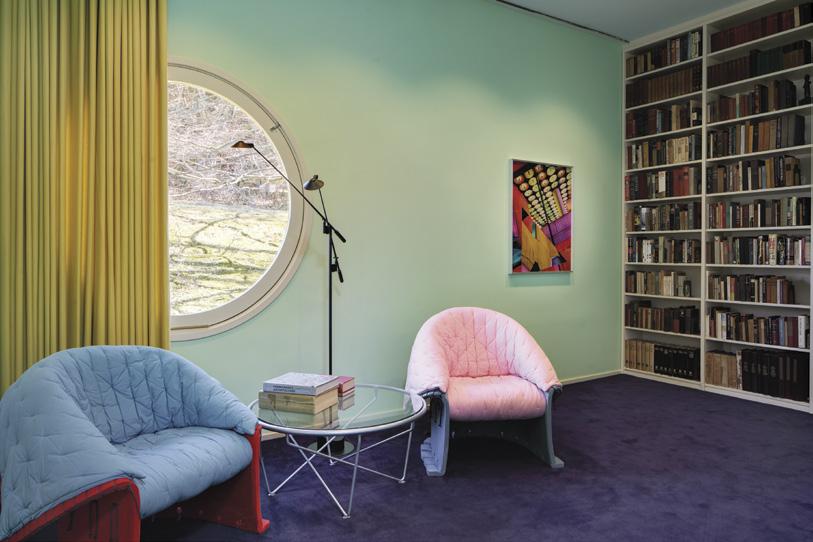
room and tree canopy. With Infiltration, large-scale, fluorescent Plexiglass sculptures modeled after The Glass House’s steel beams are positioned in the landscape and populate the Sculpture Building, leaning amongst the permanent collection and casting pink, orange, and yellow light onto its white walls.
The artist’s appreciation for architecture and the Bauhaus as well as her decades-long career (some of which overlaps with Johnson’s) make her a perfect fit here. In 2016, Kasten shared, “I like the idea of questioning….We should be able to look at what’s happening around us and find other ways of looking at it and find other means of interpretation.”2 Many moments of Structure, Light and Land echo this ethos: a bright green Plexiglass “beam” winks from lush ferns; cyanotypes interpret the skylights above while also invoking land artist Nancy Holt’s Sun Tunnels (1973–1976); and Polaroids reside in an uncannily perfect marriage with the reading room’s lime walls, purple carpet, and felt chairs—as though Johnson commissioned the images decades ago, yet they only just arrived. — Terri C Smith
Zillman Art Museum, Bangor, ME • zam.maine.edu • Through September 6, 2025
Entering painter O’Neil
Scott’s first museum exhibition one encounters the monumental Just Out of Reach, a diptych that takes up most of the opening wall. Two young women are seated in a black rubber raft, one of them paddling, the other holding what might be a cup of tea in a kind of gesture of offering while butterflies flutter in front her, one of them partially obscuring her face. The landscape is desert—a cactus stands behind the raft—and mountain range marked by glaciers and looming peaks.
In an allegorical sense, these sisterly figures, calm and focused, might represent youth facing an uncertain future that includes climate upheaval and threats to the natural world. They are one with their lifeboat, “just out of reach” of a threatening environment. Rendered in Scott’s high-polished realist style, the scene carries the weight of generations on the move.

are often hidden within the pursuit of a dream.”
Another kind of raft—a stack of round rubber inner tubes—appears in the foreground of Failing Promises. This simple flotation device plays off against a brightly lit cruise ship that forms the backdrop to a woman staring out at us with a mix of curiosity and knowingness (someone on Scott’s Instagram remarked on her resemblance to actress DeWanda Wise). In the painting, the artist sought to, in his words, capture “the tension between the bright lights of ambition and the shadows of sacrifice that
The shifts of imagery in the painting are disorienting in a highly engaging manner. As Scott told Peter Sparber in a 2024 interview on Artblog, he looks to Renaissance painters who “compiled” images that allow for different readings over time. “There’s an overall idea and focus,” he noted, “but within each work there are layers you can peel back.”
In that same interview, Scott talked about one of the show’s most compelling pieces, In Case of Emergency. “This is my mom’s church,” he explained, “but it’s reflective of me, of when I was growing up.” He mentioned attending an afterschool program at the Salvation Army where he was taught the Bible.
The painting comes at you in many ways, through gesture, visage and comportment, and by way of a blend of real and abstract elements. The standing figure with raised arms might be the preacher or someone in an ecstasy of spirit. The congregation includes an elderly woman in bonnet pursing her lips, children looking on, parishioners (one of them wearing a COVID mask) bowing their heads in prayer. A great blue heron is shown in mid-flight, a surreal touch in the middle of this consecrated scene. Is it a soul in flight? The spirit of the natural world?
Each of the ten oil paintings in the show speak to Scott’s powers of representation and emotional resonance. Protect Our Protect Her depicts a man bearing a girl in a blue dress in his arms, a look of concern and determination in his face. The Day I Became Vegan, painted in tones of gray, shows a young girl with half smile clutching a chicken.
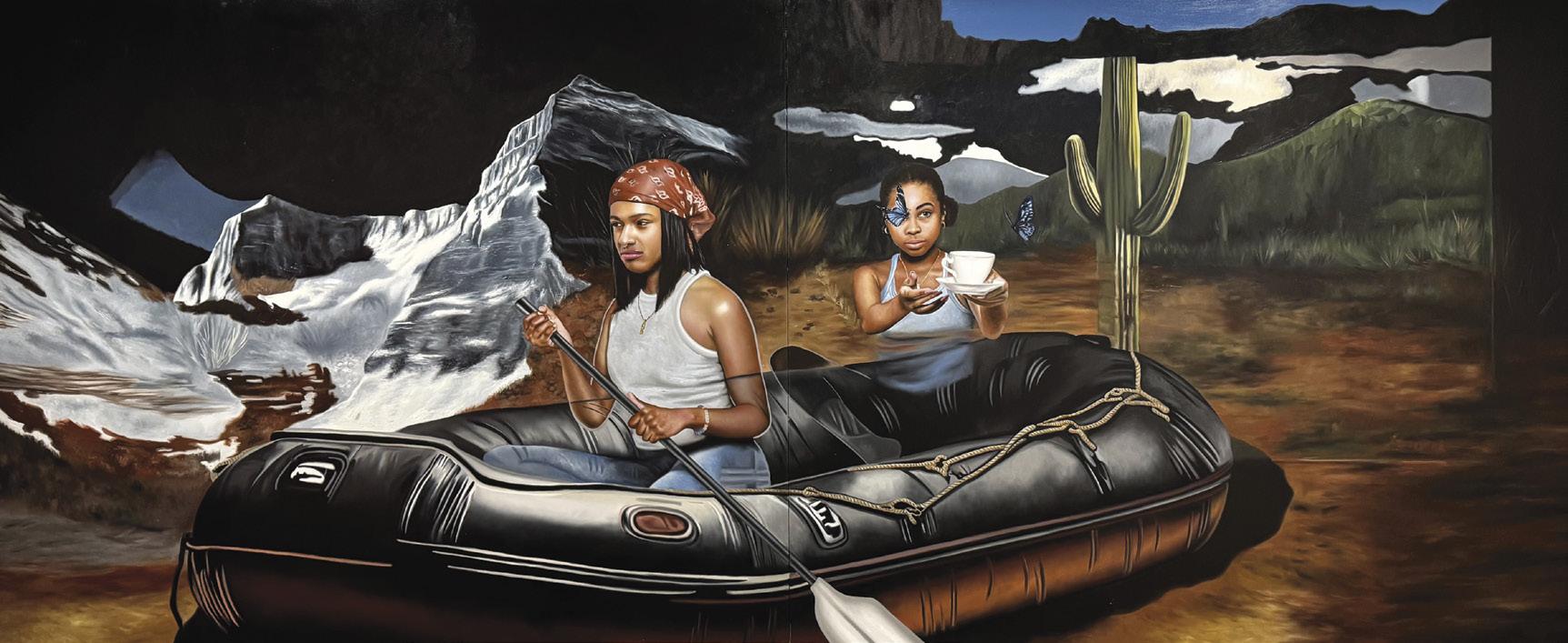
A resident of West Chester, PA, Scott was born and grew up in Spanish Town on the island of Jamaica. He went to Syracuse University on a football scholarship then earned an MBA at the University of Delaware, all the while thinking about making art. Inspired by figurative realists Bo Bartlett, Vincent Desiderio and others, he studied with Kerry Dunn and Nelson Shanks in Philadelphia. When Provincetown gallerist Carolyn Kramer expressed interest in a self-portrait, he was off to the races. Every painting in A Journey to Distant Memories, the artist notes, “functions as a kind of self-portrait, even the ones without a figure.” In light of this statement, these powerful paintings pull us back in for another, longer look of admiration and amazement. —Carl Little
The Fort Point Arts Community (FPAC) is one of the most vital art forces in Massachusetts. In the mid 1970s, hundreds of artists moved to the largely abandoned warehouse buildings of Fort Point in the South Boston waterfront. In 1980, the neighborhood held its first Open Studios and formed FPAC as a non-profit dedicated to preserving studio space in the district. Several limited equity artist co-ops and live-work rentals have been developed since then.
This celebratory exhibition in FPAC’s spacious Sleeper Street Gallery features forty-six artists from the community. Jessica Burko’s Overreach features two reclaimed wooden drawers hung on the wall. An outstretched arm reaches from one into the other. Encaustic medium enhances the sense of mystery. The body doesn’t seem to fit into its prescribed role, always wanting more.
Bruce Rogovin and Freda Shapiro’s works share a floral focus. Rogovin’s Flowers, 2024, exquisitely painted in oil feature red dahlias in full bloom in a glossy turquoise vase. The eye journeys around the painting, discovering more with each deeper look. Shapiro’s Transition, a gouache on paper, shares a completely different mood—rounded rose-colored blossoms past their prime. The expressionistic strokes emphasize the transience of the moment, a metaphor for a basic fact of our lives.
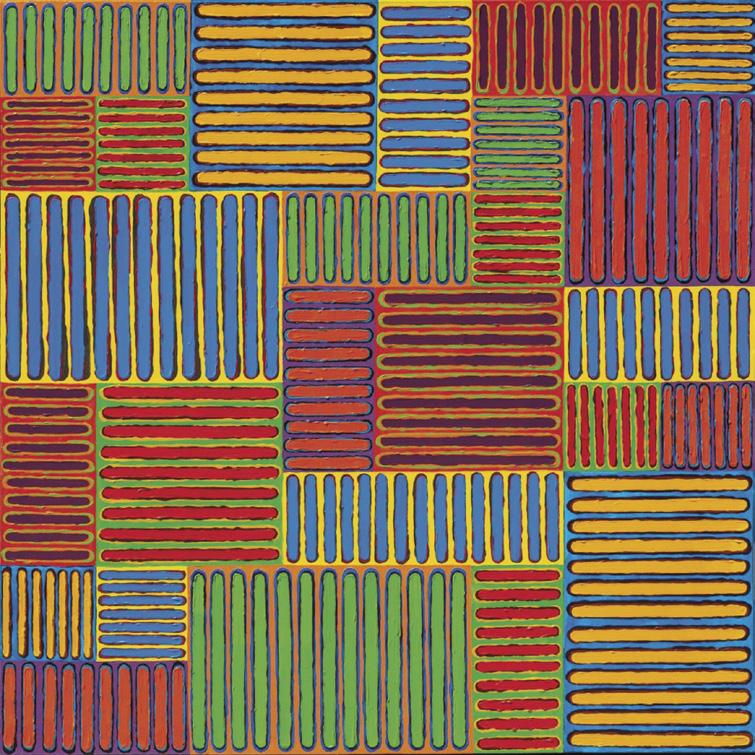
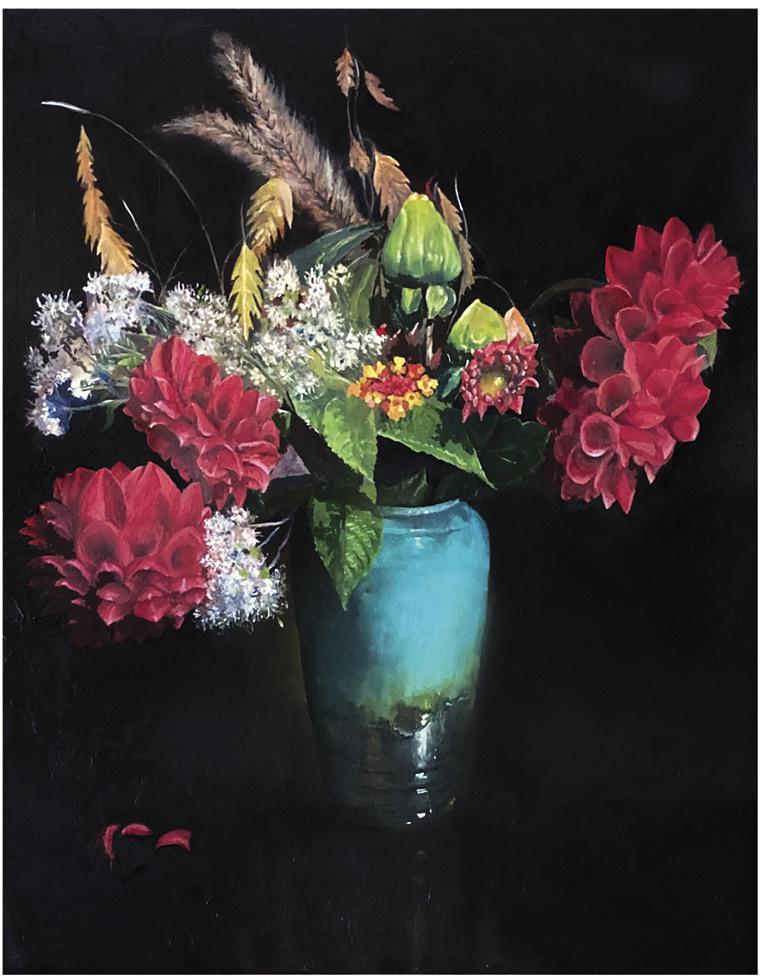
Jungle Fever by Michael Bourque, a lively multicolored acrylic painting features various sized rectangles composed of lines of color. Within the “restrained” format, a dynamic expressive energy pops through.
Dorothea Van Camp’s Rhapsody in P+ B, in shades of lavender, blue-grey and black is a subtle expansive surreal screenprint which feels
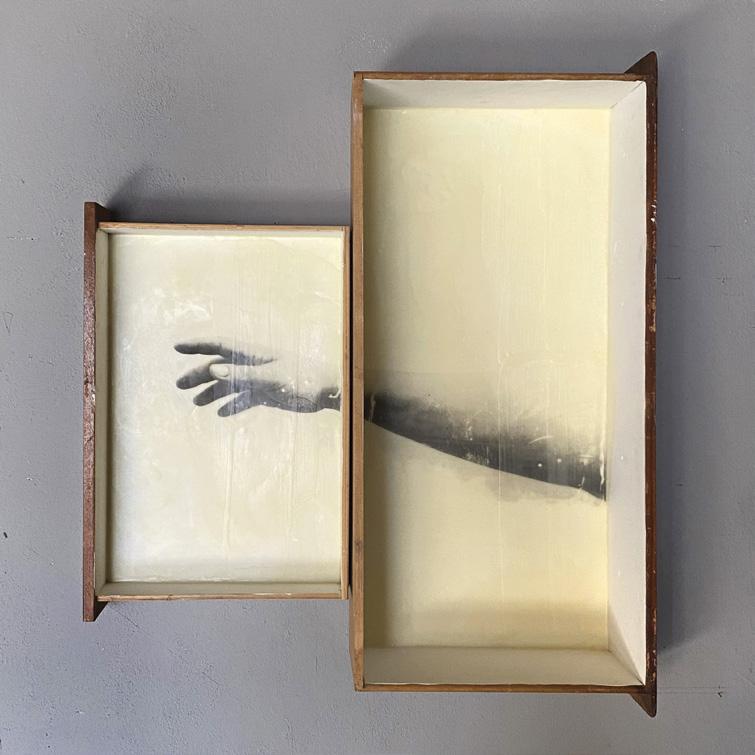
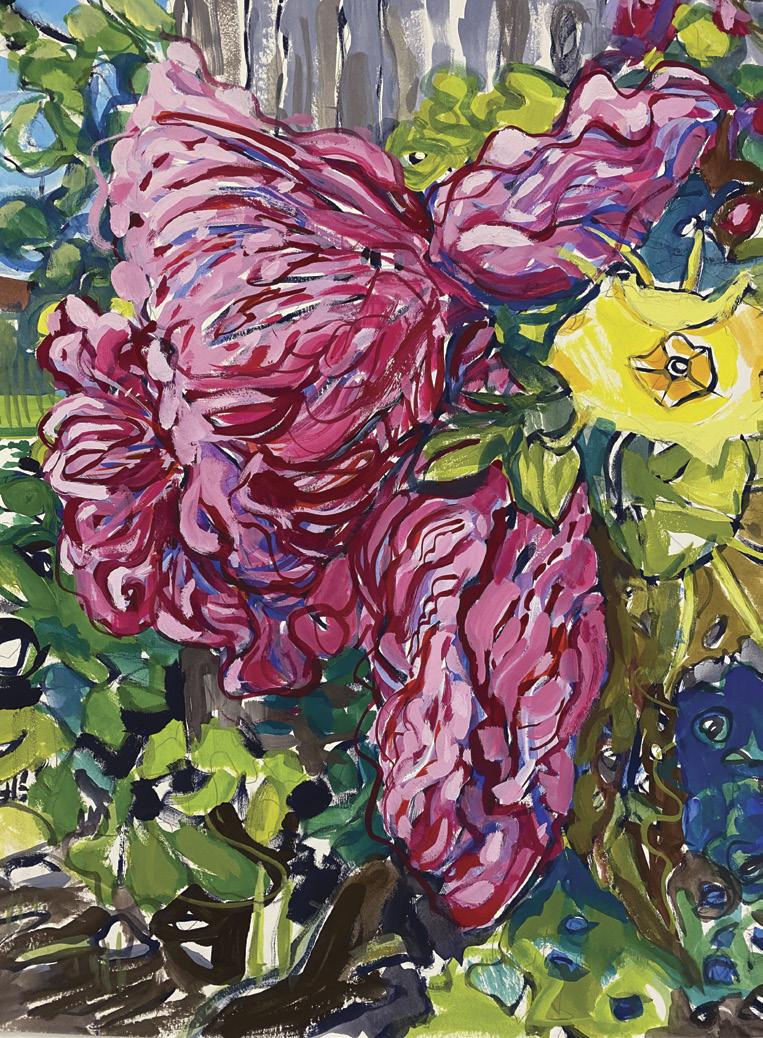
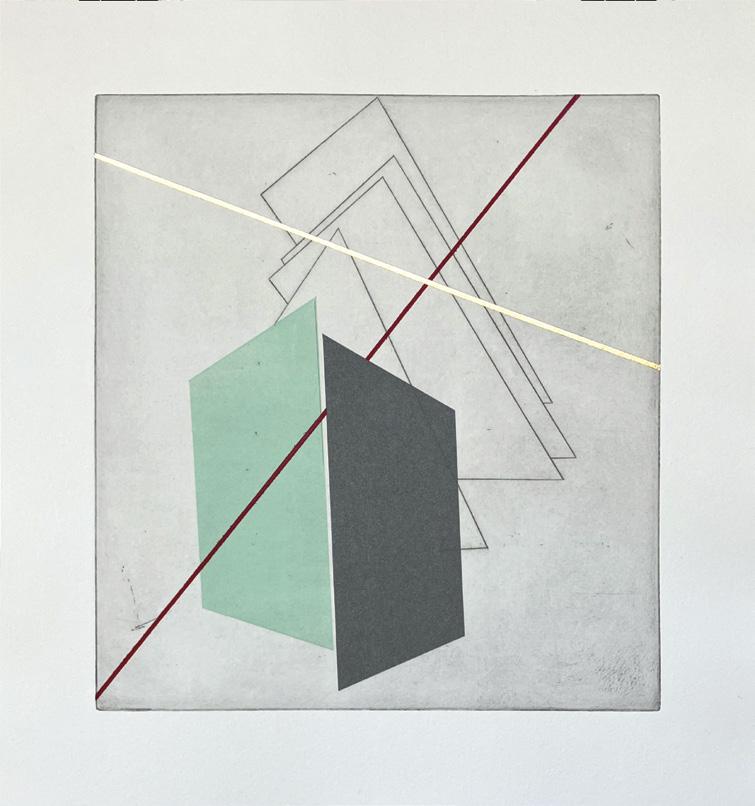
very emotive. She incorporates vector based computer drawings into the screen printing process. The gestural elements of delicate lines stretch the space of the work beyond its physical borders and excites the imagination.
Chiatura-green grey+ red by Lara Loutrel, an intaglio print, is a minimalist exploration of geometric forms highlighted with gold leaf. Inspired by the cable lines that criss-cross Chiatura, a mining town in the country of Georgia, her work is a fitting symbol in this excellent group exhibition of FPAC artists where the intersections and connections that nourish this multigenerational and cultural community are on full display. —B. Amore
Sarah Bouchard Gallery, Woolwich, ME • sarahbouchardgallery.com
• Through September 21, 2025
Of the work that came out of COVID, Tom Butler’s “Drawing Room” series is among the most memorable and felt. Writing about these red pencil and ink drawings in an essay “I Became a Room” in the Maine Arts Journal, the British-born, Maine- and London-based artist describes how these interiors brought his “feelings of solitude and uncertainty to eerie and uncanny ‘life’” and offered some cathartic relief in the midst of lockdown.
Known for the compulsive nature of his art—one previous body of work featured more than a thousand cabinet card paintings and collages worthy of Max Ernst— Butler ended up making more than 400 pieces, 80 or so of which are on view here. To underscore the isolation that brought on this work, the gallery set up a 4-by-4-by-8-foot room for its installation.
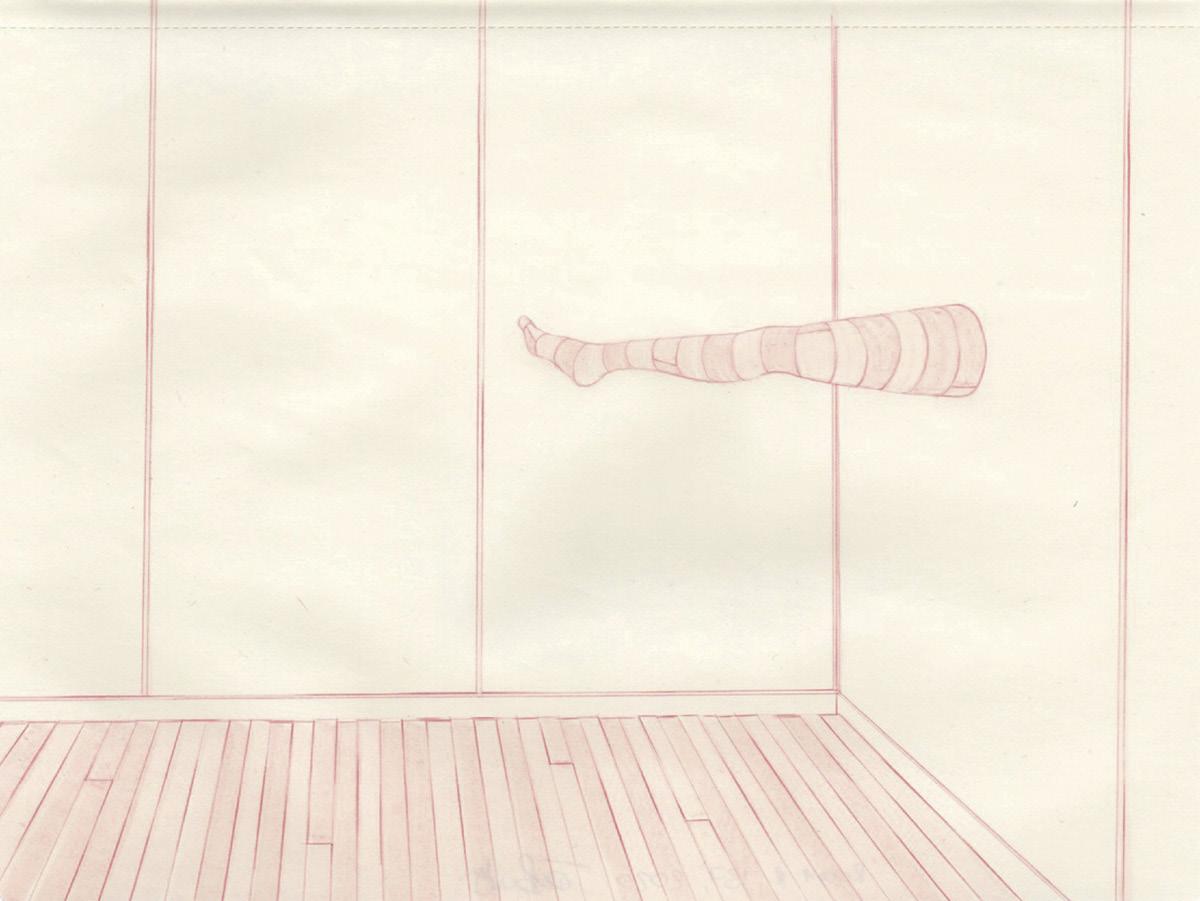
The work is divided into categories: large rooms, medium rooms, cabinet rooms, etc. Some drawings, like the “Border Room” pieces, are rendered in a tight linear manner, not architectural exactly, but more like delicate
REVIEW: MAINE
studies of paneling, often angular.
In the “Medium Room” group Butler deconstructs the space, showing gaps, holes and sectional splinters. These images at once disconcert and offer comfort—as if we were witnessing the collapse of an enclosure but also means of egress.
Pattern reigns in the “Large Room” pieces, sometimes marquetry-like as in Large Room 11. On occasion Butler will add a touch of the surreal: in Room 139 a banded leg protrudes from a wall. Pairs of feet appear here and there, peeking, so to speak, from under walls.
Several drawings feature folding screens, some them with hangers attached—a bit of the domestic to relieve the sense of being walled in. Butler worked in a small guest room “on a tiny pink Victorian vanity.”
“Now we have entered another stage of profound uncertainty, and I feel that creeping sense of anxiety returning, albeit with a different shape,” Butler notes in a statement for the show, adding, “Once again, the rooms of my mind feel precious and charged, if cracked and faded a little at the edges, but still resoundingly safe.” His are rooms with a point of view. —Carl Little
Bates College Museum of Art , Lewiston, ME • bates.edu/museum • Through October 11, 2025
In a recent Substack posting on the subject of “Law and Order,” novelist and poet Baron Wormser wrote, “The delusion is that the society is in charge when, in truth, the mania is in charge and the society is acting out whatever psycho-drama—fear and loathing being a large one—speaks to the particular moment.” Wormser’s words are a perfect fit for the work of the British artist Ralph Steadman who has used his brilliant artistry to highlight that mania and those psycho-dramas and render, through what are perhaps his best-known images, the fear and loathing that accompanied a national political trauma.
This traveling show of nearly 150 objects—ink, charcoal and crayon drawings, doctored photocopies and photographs, collages, etc.—offer the full span of Steadman’s oeuvre from studies of an iguanodon skeleton, ca. 1958, to the label for Flying Dog Easy IPA, 2020. Throughout, the energy of his line and wit cast the world in darkly humorous ways.
Steadman’s caricatures of everyone from poet T. S. Eliot to “Nixon— Warts an’ All” are stunning distortions that nonetheless capture character. You might say he enjoys putting the “mean” in demeanor.
Steadman takes special pleasure in skewering stereotypes. His Great American Wine Slob, 1990, shows a man at a winery pipetting red in a wonderfully grotesque manner. The slob’s motto, per the artist’s accompanying text: “If I’m gonna taste it, I need a lot of it.”
The show features examples of Steadman’s illustrations, among them,
drawings for Alice in Wonderland, 1967, Treasure Island, 1985, and Fahrenheit 451, 2005. He has a special penchant for birds, including vultures, dodos, owls and flamingoes. These are not necessarily your birder’s feathered friends.
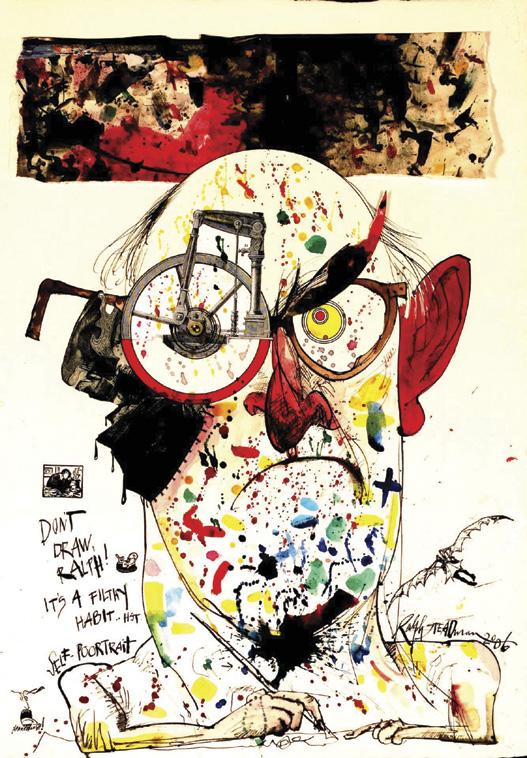
Self-Poortrait—Don’t Draw, Ralph! It’s a Filthy Habit—HST, 2006, ink and collage on paper, 23 x 14".
Ralph Steadman: And Another Thing includes a special bonus: Vintage Dr. Gonzo, a life-size bronze by Jud Bergeron based on Steadman’s drawings of journalist and collaborator Hunter S. Thompson, a group of which are featured in the show. The bespectacled and be-hatted man is caught in mid-stride, a briefcase dangling from his hand: on the way to the next story.
Likewise, Steadman is on his way to his next assignment, perhaps (hopefully) to unleash his Kraken pen on some of our current “leaders.” More power to him.
[Organized by the Ralph Steadman Art Collection, Ralph Steadman: And Another Thing was curated by Sadie Williams and Andrea Lee Harris. The show travels to the Barry Art Museum at Old Dominion University and will tour the West Coast through fall 2027.] —Carl Little
Blue Door Gallery, York, ME • blue-door-gallery.square.site • Through November 9, 2025
Marcia Crumley is a painter of joy and texture, whose landscapes are celebrations of color. She paints encaustic, using melted beeswax, mixed with pigment and resin. This process enables her to incorporate depth and texture into her work.
“I love the meditative processes of watching the wax melt, slowly building up layer upon layer of paint, fusing the layers with a blowtorch, and then carving into and scraping away the wax. I use pottery tools to create texture and patterns in my paintings, bringing me back full circle to my favorite childhood pastime of throwing pottery on a wheel. The layering and mark-making invite the viewer to look closely and spend a little time with the piece, hopefully providing them with the same sense of calm that creating the art provided me.”
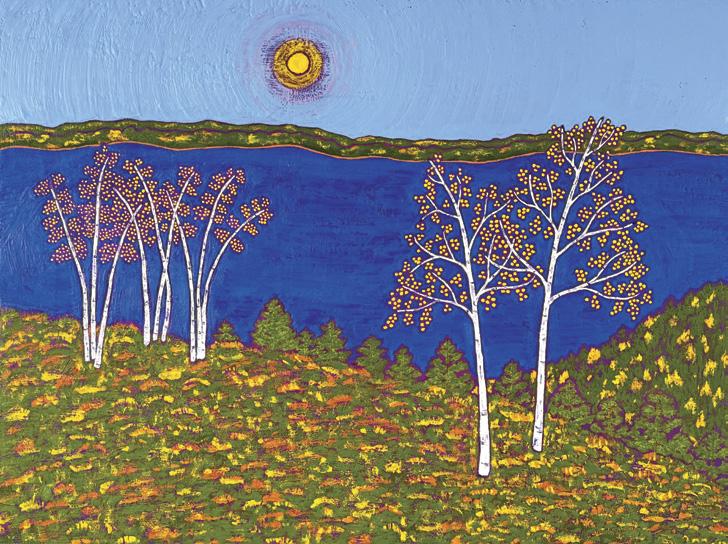
Crumley lives in Cape Elizabeth, ME, and retains a studio in Boston, MA. She graduated from Yale with a degree in economics, and followed a practical path until gradually accepting that she needed to follow her heart and devote her life’s work to being an artist.
“There comes a time in one’s life, when there isn’t time to do anything else but what you really want to do, that which brings you joy. I felt it was
OVERVIEW: MASSACHUSETTS
155 Seaport Boulevard, Boston, MA • blkchip.com
In spring of 2024, BLKChip Gallery arrived in the Seaport area of Boston, MA. The space solely features artists of color who retain all proceeds of their sales. In turn, the artists treat the space as a residency, working as a gallery sitter during their exhibition and contributing more social media content than traditional models.
The heavy retail location is mutually beneficial for patrons and exhibitors. The corner, ground level storefront with large windows attracts shoppers, diners, and hotel guests of the redeveloped Seaport neighborhood. Visitors may happen upon an exhibition on their way to brunch and leave having had a powerful connection with the artist which rarely occurs within traditional galleries.
imperative to honor it.” Crumley pauses, and continues, “If you come to your passion later in life, you have a lot more focus…when I was younger, in high school, I was drawn to pottery and writing. I didn’t paint, so when I found paint, I was pleasantly surprised that I had this talent. Discovering this world of working with color, was like discovering a different part of myself that I didn’t know was there.”
She started small, but was very focused, and with her devotion and love of painting, success began to find her. She writes a fascinating blog which helps with her own process and allows her to connect with others. She has found that people are interested in the artist’s process. She spends lots of time outdoors, drinking in the beauty of nature, watching the weather, the mountains, light, ever observing. “I take lots of photos,” Crumley notes, “But I don’t look at them so much, rather, I paint from memory, and think of how I felt.”
Several of her new paintings for an upcoming show at Blue Door Gallery in York, ME, are of night skies. Entranced by nature’s beauty, Crumley muses, “It is impossible to not be inspired by nature. How can you be outside at night and look up and not say ‘wow!’ —Paige Farrell
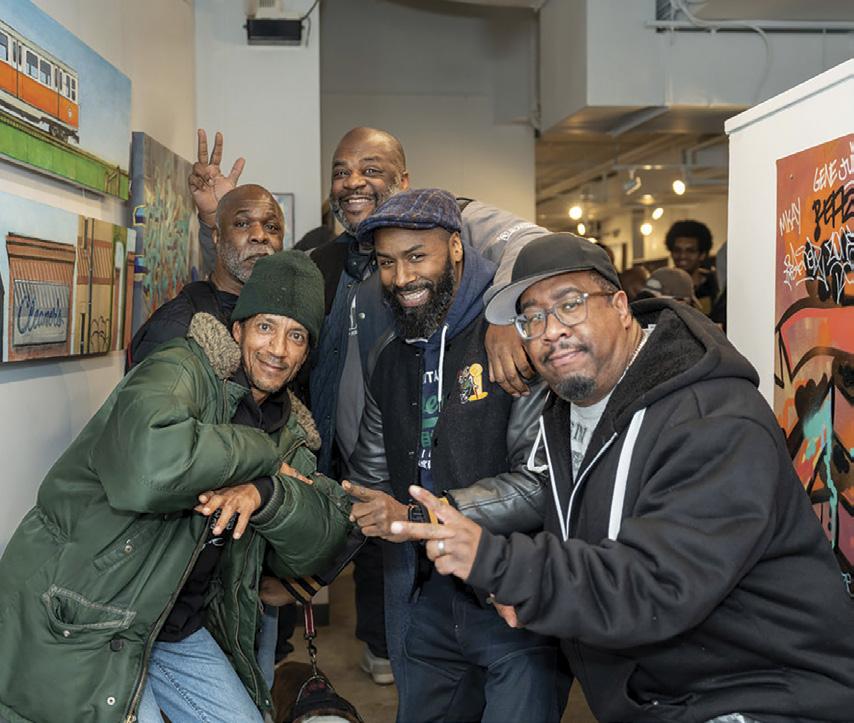
“BLK Chip Gallery is an incubation space for BIPOC artists who are mid to high level careers to build a collector base and host events that benefit both developing artists and a new community of art investors,” says Meclina Gomes, artist and volunteer. In partnership with Street Theory Collective, BLKChip is also inter-
ested in developing a new base of collectors by offering artwork at different price points. The space has featured the works of Gomes, ProBlak, photographer Moses Mitchell, and the artists of AEROSOL, a graffiti exhibition that ran in tandem with the Art New England series in 2024 and 2025. In December of last year, the South End retailer House of Culture held a pop-up shopping experience.
With programming and gallery rentals as additional pieces of the economic framework, BLKChip intends to diversify art spaces with both artists and operators. Moreover, it allows for creative professionals to develop skills while demystifying the business of selling art.
“As a curator and an artist, it has been a pleasure for me to work with BLKChip and understand the complexities of how to run the front end of a gallery and how the back end can utilize different types of business models,” says Gomes, who is preparing for her second solo show at BLK Chip Gallery in October. —Jennifer Mancuso
By Stacy Grossman
Off a quiet road in the coastal community of South Dartmouth, MA, is the art compound of master ceramicist, Chris Gustin. Among the acreage is an openair shed housing a massive hybrid anagama (a traditional Japanese kiln), a stand-alone intimate yet airy gallery structure, and a two story 8,000-square-foot renovated chicken coop. The coop hosts a finishing studio and loft on the second floor and a labyrinth of spaces on the first, containing a large-scale gas-fueled kiln, several smaller kilns, the artist’s bespoke glazes, worktables, bags of clay, drying shelves filled with tiles and vessels, and storage shelves hosting a plethora of supplies and equipment required for Gustin’s creations. The newest among them, Spirits, will be featured at the Lucy Lacoste Gallery in Concord, MA, September 13–October 12 in the exhibition, Wild Things. Chris Gustin grew up in Los Angeles. His parents were part owners of three ceramicware factories exposing the artist at a young age to a wealth of knowledge about ceramic production and factory management. Gustin ran one of the businesses for a year and a half at the age of eighteen. While he departed from the manufacturing side to explore a more personal, creative side, his origin story informed his career and inspired his work ethic. Gustin has a BFA from Kansas City Art Institute, an MFA from Alfred University in New York, and has been the recipient of fellowships and grants. He has also served on the faculty at Parsons Design Institute, Boston University and UMass Dartmouth, and his works have been exhibited both globally in prestigious private collections as well as museums, including the Smithsonian. Gustin is also a founder and board member of Watershed Center for Ceramic Arts in Newcastle, ME. At 73, he maintains a very full calendar for firing his
works: Gustin fires his traditional anagama twice a year, inviting artisans from around the country to bring their wares for a communal experience of loading the kiln, firing and stoking it, sharing meals, and exchanging ideas. The process takes weeks. He also remains engaged in the broader ceramic community, traveling the country to participate in other communal firings.
Gustin’s current artistic production feels like a culmination of this lifetime of dogged exploration, openness to experience, and creative evolution. Perched in his finished gallery space are sizeable–approximately four feet in height–closed form sculptures, the Spirits, that will be featured in the upcoming Lacoste exhibition. These objects gravitate between figurative and abstract creating a compelling visual tension. Lacoste describes the works as “anthropomorphic, cloudlike, galactic and otherworldly.” They have a lushness in shape and color that is achieved from meticulous pinch building, layering of glaze, and a deep knowledge of the chemical impact between clay, silica, wood, sodium and fire. Works can be fired either once or multiple times, until Gustin gets the “action” he wants from this alchemical process.

Spirit 2503 is a large, billowy form with head and limb-like shapes that protrude and seemingly melt atop the surface area. The artist relayed that he likes to think of the works as “large sacks with some kind of energy, stuff happening inside of them that’s trying to push out.” 2503 is primarily covered with a luminous, milky white glaze conjuring ethereal, ghostly qualities. A light sienna color spills over the form giving primordial ooze, amniotic fluid connotations. Spirit 2506 is a visual partner to 2503 in its varied and curious bulbous shape yet a counterbalance in terms of color and evocation. It’s sheathed in layers of earthen reds and muddy, brown hues
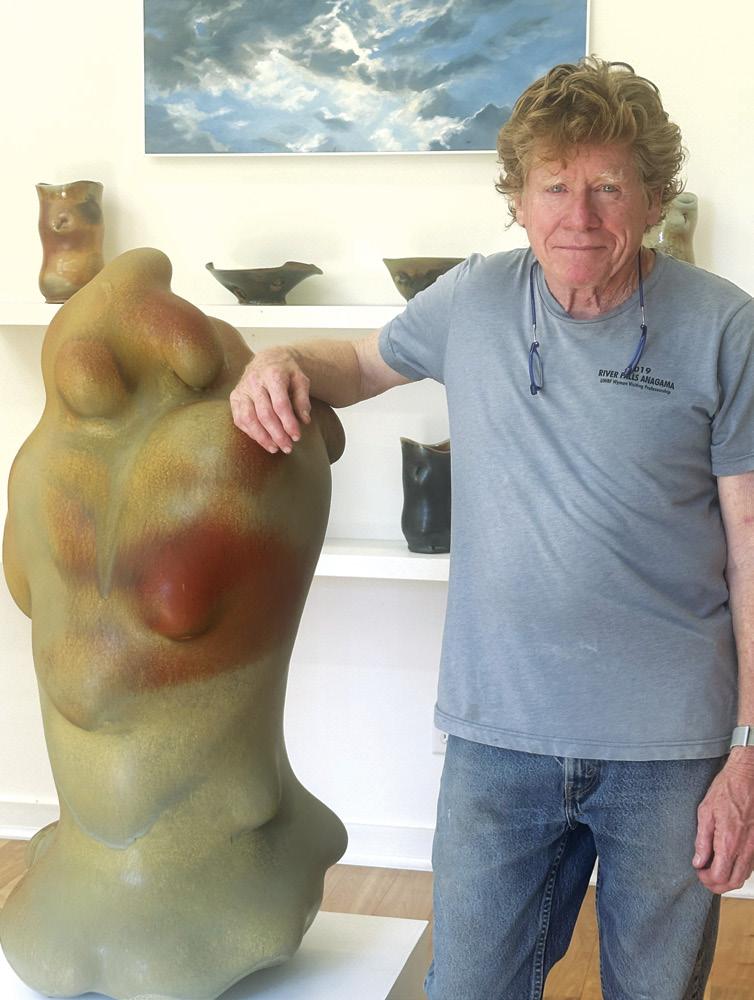
giving it a rooted, weighty feel. If 2503 is airy, conjuring notions of birth or emerging ghosts, 2506 is grounded and perhaps speaks to ideas about decay or returning to the soil. Spirit 2402 adds to the conversation of form with its own biomorphic folds and coloration of turquoise and charcoal that may reference deep-sea or deep space. The Spirits feel dynamic and interactive with one another which makes sense as Gustin makes these sculptures simultaneously, feeding off their unique energy to compel his creative output forward. The kinetic atmosphere among these works is captivating; you may impulsively want to touch them. Indeed, at a show in Michigan, guards were hired to shield the Spirits due to excessive fondling. You will also want to move among these works, and, as you do, like shapeshifting clouds, your movement will elicit new ideas about what they convey.
In a lecture Gustin gave at a retrospective of his work at the American Craft Museum of Art in 2014 he shared that his raison d’etre as an artist is to find a creative solution to the question, “How does figurative form give meaning to an object resonating with our memories, our histories?” In his Spirit series, it feels like Gustin has found his answer.
Stacy Grossman is an art historian and writer based outside of Boston and is particularly interested in art and education. In addition to writing, she has worked in museums, public schools and other non-profits developing art curriculum.
gustinceramics.com
By Cynthia Close
Art at the Kent, a highly anticipated annual exhibition held every September in the rural hamlet of Kents Corner, Calais, Vermont, never disappoints, and this year promises to live-up to those high standards. The fact that the three-person curatorial team; Cornelia (Nel) Emlen, Allyson Evans, and David Schütz, all of Calais, volunteer their time and that their careers fall outside the traditional trajectory of the museum/gallery world makes their accomplishment even more astounding. In a telephone conversation in mid-summer just prior to the announcement of this year’s theme and reveal of participating artists, Emlen described how they work together as a team. “One of the wonderful things, even when we disagree, we have learned to trust each other’s instincts.”
Those instincts come into play during the winter when they get together to decide on a theme, which always manages to be evocative and poetic. Holding: Mementos Kept, Memories Kindled is the choice for 2025. The description of the show in the press release reflects that poetry, so rather than paraphrase, it deserves to be quoted verbatim: “Holding – A favorite toy. Your first car. The view across the meadow on a foggy morning. Walking your beloved dog. Your mother’s handwriting. The baseball you caught at that Red Sox game when you were ten. Your sweetheart’s shirt. Objects, smells, music . . . they all spark memories. Between time and beyond place, memory may surprise us with its clarity or break our hearts when we can no longer access it. Art at the Kent’s 2025 exhibition, Holding: Mementos Kept, Memories Kindled, looks at memory, lost and found, vivid and fleeting, what we remember and what we forget. Life, after all, is in the details, and the works of 21 Vermont artists take a deep dive into a vast sea of recollections and bring them to the surface in myriad ways.” The collective magic experienced at the Kent
is in part contributed by the property itself. This contribution is fully acknowledged by the curators who embrace its raw state of preservation. The site with its labyrinthine rooms, creaking staircases, exposed lath wall textures and 19th-century landscape viewed from oversized, uninsulated windows, acts as the fourth curator, adding the visceral response to art that only being there, sharing the space, can evoke.
The property and buildings were originally owned by the Kent family who lived and built businesses there, forming the hub for this rural


are introducing several new ideas this year.
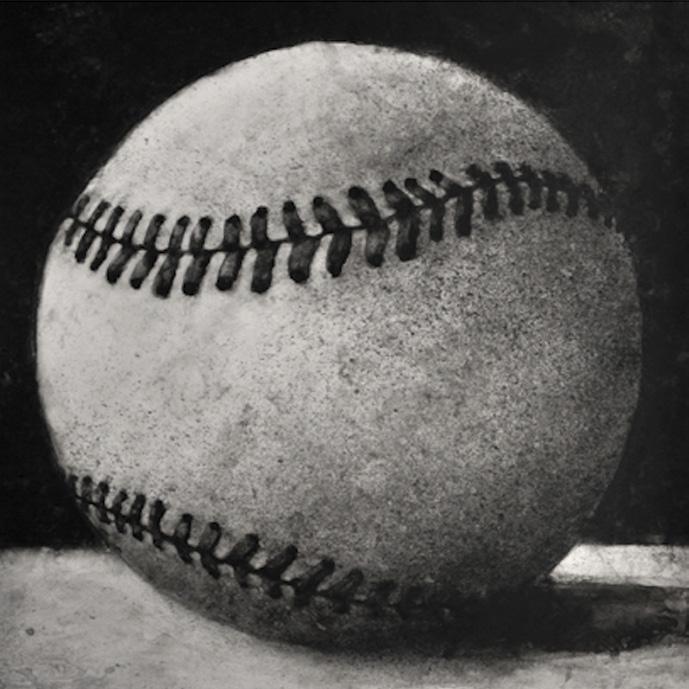
community. The oldest structure, an 1830s house, is flanked by a handsome brick Georgian-style hotel and tavern on one side and an 1854 general store on the other. In the 1940s, Louise Andrews Kent (1886–1969), a writer of nonfiction and children’s books, embarked on restoration and preservation of the family property to become a museum. She also served as a trustee to the Vermont Historical Society. The ownership of site was transferred to the Vermont Division for Historic Preservation in 1991.
Every aspect of this exhibition inspires wonder. Emlen reminded me that, “This is our 19th year doing this exhibition and we’ve never repeated an artist.” Considering that there are twenty-one artists being shown in this iteration and this writer was only familiar with the work of three was surprising. The wealth of talent in Vermont is inexhaustible. Emlen did say they
“We are doing a sort-of sidebar where we invited two artists back…” One of those artists, Kate Gridley, will be premiering her multi-media installation Witness Marks: Anatomy of a Memory, in which she explores how we make memories, how we store them, and how we retrieve them. “Also, we’ll be dedicating spaces to portraiture. There will be a gallery full of faces.” Portraiture seems like a natural to include in a show where capturing memories is a major theme. August Burns of North Middlesex and Elizabeth Fram of Waterbury are seasoned artists who focus on portraiture and are included in Holding. Both were discoveries for this writer.
Although the Kent is a prestigious exhibition to have on an artist’s resumé, Emlen admits, “I’ve hung work in more traditional spaces, and this is not for everyone. There has to be an acceptance and understanding that we’re going to place your work. You’re not going to place your work…We never know how it’s going to go but somehow it always comes together at the end.” There is no doubt the curatorial team will work their magic again this fall.
Cynthia Close is contributing editor for Documentary Magazine and writes regularly for Art New England and several other publications.
Holding: Mementos Kept, Memories Kindled The Kent Museum, Kents Corner, VT kentscorner.org; Through October 12, 2025
Queerlective at Totally Tea + Coffee in Concord, NH • queerlective.com • Through August 25, 2025
The exhibition description on Queerlective’s website asks these questions: “What does it mean to affirm your identity on your own terms? What memories, objects, or creative acts have helped you become more yourself?” Objects of Affirmation sees local artists answer these questions. The show is inspired by the Museum of Transology in the UK, a collection of objects that document transgender, non-binary and intersex lives through everyday objects and handwritten narratives.
In this vein, Objects of Affirmation features artists’ objects, artwork and photography alongside detailed informational placards which allow the artists to speak directly to viewers to tell their stories. Memorable pieces include a hand-painted tote bag that sits next to several pages of printed text detailing “the gossip” behind the bag, exploring a narrative of queer love, drama and self-exploration through dating mishaps.
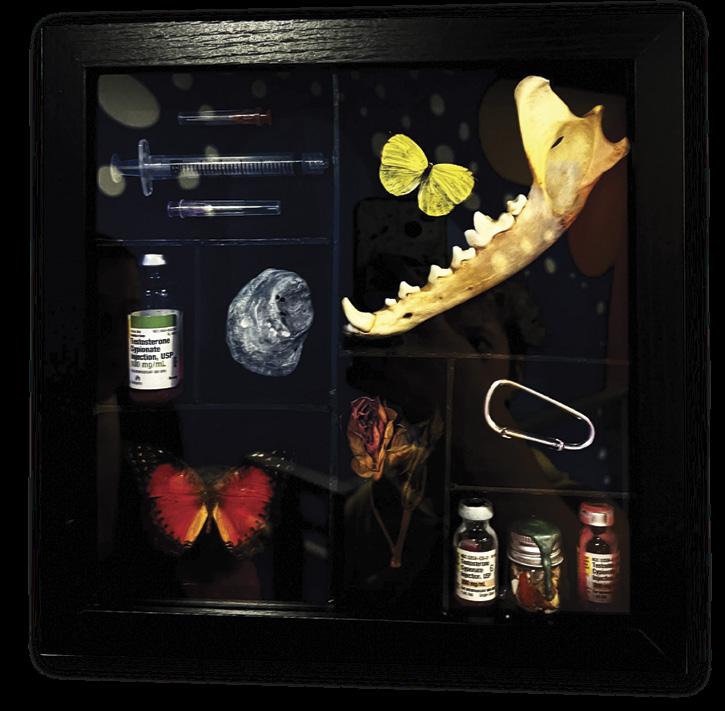
Another striking piece invokes a shadow box, with compartments holding hand-pinned butterflies, injection syringes and bottles of testosterone dripping with paint and wax. The invocation of a butterfly’s
REVIEW: NEW HAMPSHIRE
biological transformation places the transgender identity boldly within the scope of natural beauty. The use of testosterone hormone bottles and injection tools pulls back the curtain on the realities of hormone replacement and allows the viewer to see this intimate aspect of transition in a piece that feels deeply vulnerable.
While this exhibition has since closed, interested readers should keep their eyes on the space at Totally Tea + Coffee in Concord. Queerlective is an artists’ collective based in New Hampshire and dedicated to providing queer and gender expansive artists professional opportunities in the region. Starting this summer, Queerlective and Totally Tea + Coffee have entered a long-term partnership. The Concord location now hosts Queerlective’s retail pop-up upstairs at the cafe, where visitors can purchase zines, stickers, prints, t-shirts, tote bags and more directly from Queerlective artist members. More exhibitions will pop up in the space before long as this collaboration deepens and finds its footing. —Autumn Duke
lakes gallery at chi-lin, Laconia, NH • thelakesgallery.com • Opens September 16, 2025
The title All Paths Home implies one has left a “home” of some kind and is contemplating returning, or is already en route. It implies hopefulness, assuring us there is more than one way to get there. The exhibition speaks to this premise through the works of five empathic artists using their chosen creative paths to express what the journey means to them. Gay Freeborn works in oils; Anne McMillan is a book artist; Cheryl Kimball, a writer; Kelly Blake, a photographer; and Nancy Freeborn is a ceramist.
Blake shares, “I spent my childhood on this farm along with four generations before me. It is in my soul and it is solidly my place. When the evening light hits the big familiar beams or the clouds frame my little herd of horses, I just have to photograph it! This project has pushed the boundaries of my comfort zone. Time in the barn is normally quiet time to think and be present with my animals, but I hope people will enjoy a sense of peace and love…”

house I lived in for the last thirty-two years and the subsequent move into the house I grew up in... What I found through writing is that ‘home’ to me is not these physical buildings, but my dogs, the wildlife and the natural world all around me. Wherever I am.”
There is yet another layer to the title. After several months hiatus, artist and gallery owner Suzanne Lee has re-opened lakes at chi-lin. Lee, a gifted writer and calligrapher, is the consummate gallerist, having always found “home” amidst art. “Now that the gallery is back in our 1780 farmhouse surrounded by our peaceful Asian gardens, I have felt especially blessed... I have the luxury of uninterrupted time to work with artists, poets, photographers and craftsmen. The gallery itself is a little gem, the perfect size to work out the possibilities of a story. My sunny studio allows me to practice and share my love of calligraphy and nature studies. Best of all I can spend time with visitors and see the effect this magical space has on them.”
“I process events in my life and my emotional reaction to them through writing,” says Kimball. “This was the case with the recent move from the
A series of opening events are found on the gallery’s website.
—Rita A. Fucillo
Rhode Island School of Design, Providence, RI • risdcraft.com • RISD Craft: Fall 2025: Saturday, October 11, 10 a.m.–4 p.m.
Founded in 1877, the Rhode Island School of Design, commonly referred to as RISD, is one of the top art and design schools in the country. Many of the school’s graduates have embarked on successful careers and have become prominent artists, including Dale Chihuly, Shepard Fairey, Julie Mehretu, and Kara Walker, among many others.
On Saturday, October 11, members of the public will have an opportunity to purchase and collect artworks by current RISD students and alumni at RISD Craft: Fall. The fair will take place on Benefit Street as part of RISD Families Weekend, spanning two blocks between Waterman and Hopkins streets, and showcases the work of approximately 120 artists. Visitors can purchase original prints, ceramics, clothing, jewelry, designware, sculptural works, and unique multimedia pieces.

Many artists selected to participate in RISD Craft are chosen through a juried process, with a panel of RISD alumni and faculty evaluating ap-
plicants based on their originality and artistry. While the spring fair features alumni artists who are selectively chosen, the fall edition includes current students and recent graduates chosen by a lottery system. All art items for sale are personally designed and handcrafted by the artist or ethically outsourced.
For those unable to attend the fall fair, or eager to mark down additional opportunities to collect unique handmade pieces, the RISD Craft: Spring event next year will offer another chance to purchase artwork. The spring event takes place during Commencement and Reunion Weekend and coincides with other RISD programming—including free admission to the RISD Museum, which houses an impressive art and design collection spanning diverse cultures and historical periods. In past years, the weekend has also featured a WaterFire lighting, a transcendent event where fires are set on pyres on the water, illuminating the rivers that run through the heart of the city. —Michael W. Zhang
The Carving Studio & Sculpture Center, West Rutland, VT carvingstudio.org • Through October 30, 2025
Light and Stone is a unique exhibition featuring a revelatory dialogue between sculptor Darrell Petit and photographer Sean Kernan. Both are masters of their respective art who have been collaborating in an open-ended exploration of creative process for over twenty years. Kernan’s photographs go far beyond documentation and really capture the essence of Petit’s relationship to stone and sculpture. The combination of photographs and the actual sculptures becomes its own work of art, hence the exhibit and a published book, “Darrell Petit in Stone.”
Kernan’s photos range from images of Stony Creek quarry in Branford, Connecticut to highly complex pieces in well-known public sites, as well as smaller works. Petit’s relationship to the quarry goes back to 1990 when he first visited to inquire about executing an art idea and was hired to work in the quarry. This was his immersive baptism in stone. He eloquently writes about the intimacy of being “in the stone” and the effect on his consciousness.
Petit never left. He has continued to primarily work with the pink-grey earth-toned granite, as well as participating in international symposia in Japan, Germany, Ireland Norway and Egypt. Titles like Circle of Life, Continuum, Interdependent, Peace Element, speak to his interest in universal themes.
Notable large scale pieces in photographs include Event, at One Dalton,
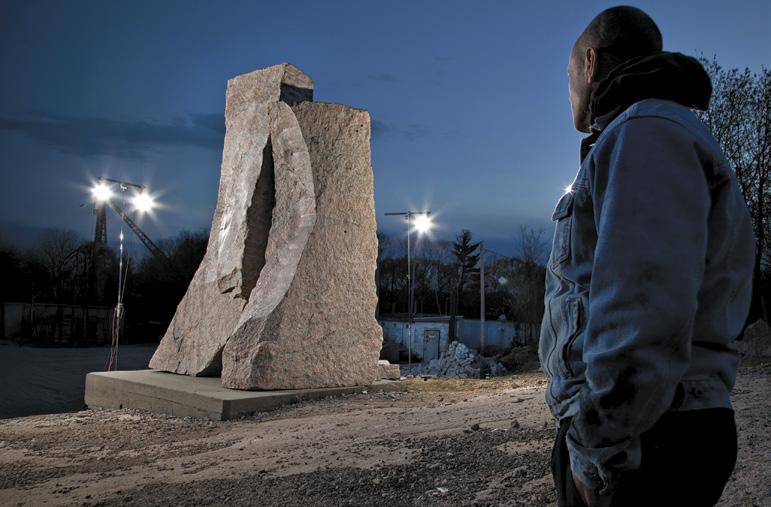
Boston which places three monolithic components in the midst of an urban landscape, Kiss, installed at Storm King, and Peace Element, in the A. Harris Stone Collection in Vermont. Petit’s more moderate sized works (1 foot–4 foot) in the gallery are striking, both in form and subject matter, often honoring traumatic incidents and transforming them into art.
In Kernan’s photographs, Petit, when present, is always seen in relation to the mass of the stone, with light and perspective as a primary elements. Petit’s subtle techniques are highlighted in a range of textures, from the roughest stone to fine, smooth surfaces.
Petit will often see a piece quarried and not work on it for years until the impulse forms out of the space of “unknowing” which is essential to the creative process. Kernan understood this intuitively, as he photographed the quarry, Petit at work, and the evolutionary process of creation, not knowing where this would all lead. Essentially, both artists deeply accept the mystery of the creative process and place their faith in the journey. This exhibition shares the “traces” of that journey. —B. Amore
While Vermont is dazzling all year long, there is something magical and mystical about the months bridging summer and winter. Trees transform into a wave of color across the state, sparking creativity and inspiration. You must visit Vermont this fall. Add an extra day to your long weekend, visit a few galleries and museums, bring home a piece of art, hike a new trail, and bask in the state’s unwavering hospitality. Art connects us to the land each other.
Leslie Fry—Winooski
Leslie Fry is an artist whose forty-eight-year career shows incredible diversity of style, media and method. Fry’s work has been widely exhibited and commissioned across the country and beyond. Her newest series of work, “Holding On,” focuses on the pedestal. Fry challenged herself to create the pedestal before or during creation of the work itself. Visit the artist’s sculpture garden next to her studio in Winooski, a tiny city with Vermont’s most diverse population. Fry’s work primarily centers the female figure, revising and revisiting historical depictions and replacing them with visuals of strength and freedom. The hedged garden integrates concrete and bronze sculptures with a flowering landscape, making it the perfect place to wander, relax and experience her art in a secluded setting. Leslie Fry’s studio is also open for viewing drawings, prints, and works in progress.

Mitchell-Giddings Fine Arts—Brattleboro Mitchell-Giddings Fine Arts, located at 181-183 Main Street, Brattleboro,VT, offers solo and group shows curated from approximately 35 artists, along with artist talks, workshops, poetry and literary readings. Owned and directed by artists Petria Mitchell and Jim Giddings, the gallery exhibits contemporary painting, prints, sculpture, glass and ceramics. Through October 26, master printmaker and painter, Dan Welden, showcases Haystack Crescendo, his latest series of “hybrid prints.” Scheduled October 24–26 is a three day printmaking workshop at Mitchell-Giddings with Dan Welden, with details to be provided. Early this summer, Welden completed an artist residency at Haystack Mountain School of Crafts, in Deer Isle, Maine. Arriving with a portfolio of beginning-state, black and white etchings, he created a new body of work—neither pure print nor painting—with the prints serving as the foundation for further image-making using acrylic, watercolor and crayon. (Image below: Dan Welden. Noisy Oyster, 2025, zinc etching w/ mixed media, 29.5 x 26.5").
Vermont Artisan Designs—Brattleboro
Vermont Artisan Designs, located on Brattleboro’s Main Street, has been listed as one of the top ten galleries in Vermont for more than fifty years. American-made craft and fine art is the focus of this expansive three-floor gallery. If visitors are looking for a good time to visit, live
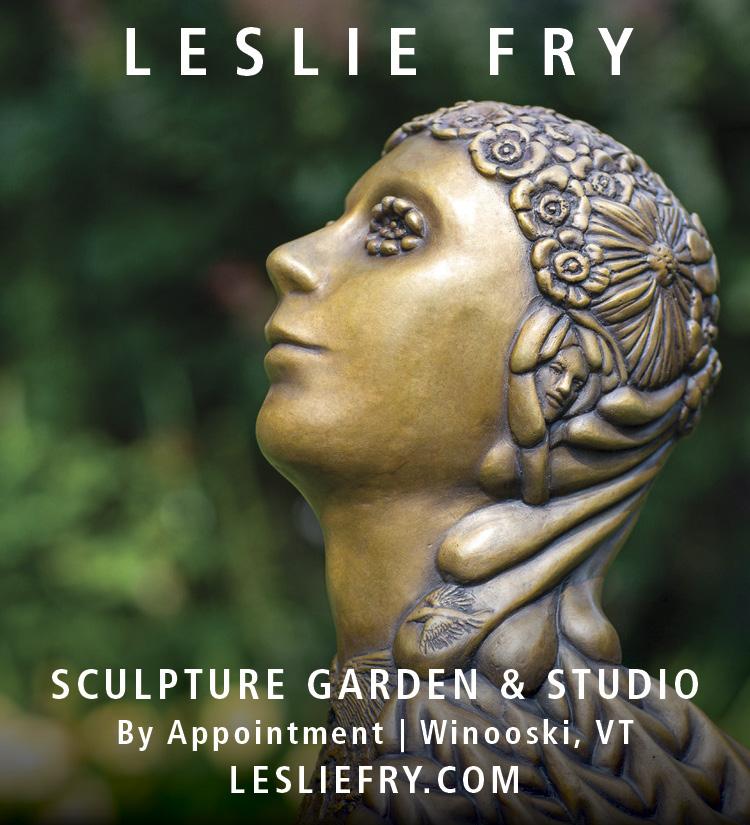
music, food trucks, pop-up shops and around twenty galleries bring extra life to the town during Gallery Walk on the first Friday of the month. On the main floor of the gallery, jewelry, pottery, blown glass, wrought iron, turned wooden bowls, scarves, pewter, chimes, puzzles, cards, candles and an exceptionally comfortable wooden rocker can be found. On the mezzanine, there is a selection of wood block prints, wire sculpture and more glass. Upstairs, there are eleven small galleries featuring oil, watercolor, pastel and acrylic paintings, sculpture, handmade furniture and a baby grand piano used for music during the Gallery Walk.
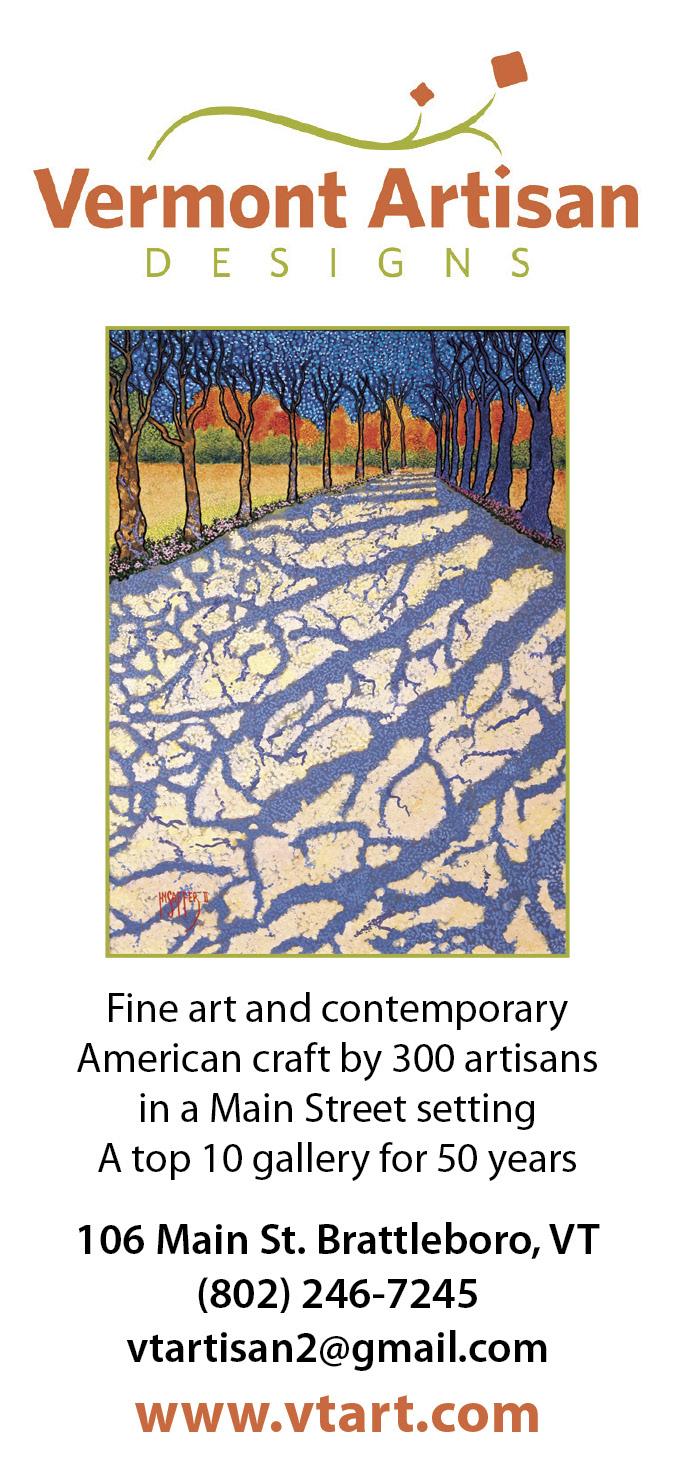
New England’s Premier Resource for Galleries, Openings and Events Around
Connecticut
Art Museum, University of Saint Joseph 1678 Asylum Ave., West Hartford, CT (860) 231-5399
usj.edu/artmuseum
Tu–Sa 11–4
Opening September 19: Painted Pages: Illuminated Manuscripts, 13th–18th Centuries highlights the golden age of hand-written and illuminated volumes, many of which included elaborate gold leaf decoration and intricate ornamentation. This exhibition is organized by the Reading Public Museum, Reading, Pennsylvania. At the University of Saint Joseph, the exhibition is supported in part by the Karen L. Chase ’97 Fund. Opening reception: Thursday, September 18, 5–7:30 p.m.
Fairfield University Art Museum
Fairfield University
200 Barlow Rd., Fairfield, CT (203) 254-4046
fairfield.edu/museum
Tu–Sa 11–4, Th until 8
Opening September 12: Walsh Gallery (Quick Center): Stitching Time: The Social Justice Collaboration Quilts Project and Give Me Life: CPA Prison Arts Program. These dual exhibitions feature the work of incarcerated (or formerly incarcerated artists): male quiltmakers in Louisiana State Penitentiary and women working in an array of media at York Correctional Institution in Niantic, CT. Opening September 19: Bellarmine Hall Galleries: Monuments: Commemoration and Controversy. Organized by The New York Historical, this exhibition explores monuments and their representations in public spaces as flashpoints of fierce debate over national identity, politics, and race that have raged for centuries.
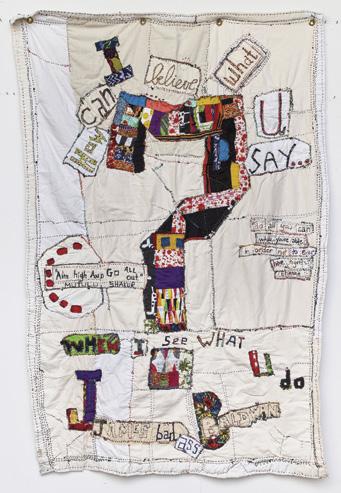
Kenny “Zulu” Whitmore, Etienne, Mutulu Shakur, and Maureen Kelleher (quilt design); Maureen Kelleher (quilting), James Baldwin: Quote #3, 2019, mixed cotton blends. Lent by Maureen Kelleher, © Maureen Kelleher. At Fairfield University Art Museum.
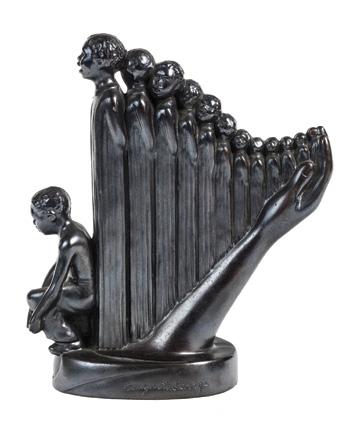
Augusta Savage, Lift Every Voice and Sing, ca. 1939, white metal cast with a black patina. The New York Historical, Coaching Club Acquisition Fund, 2019.90. Courtesy of The New York Historical. At Fairfield University Art Museum.
Florence Griswold Museum
96 Lyme St., Old Lyme, CT (860) 434-5542 x106 florencegriswoldmuseum.org
Opening September 27: Inside Out: Contexts for American Art. The Florence Griswold Museum is a unique institution rooted in the context of its site-specific environment. Inspired by this multi-sensory setting, Inside Out investigates the power of contextualizing selected artworks from the Museum’s collection, turning them “inside out” for viewers to engage with paintings, sculpture, prints, textiles, and photographs in creative ways. Works of art are placed in conversation with archival materials, period music, artmaking tools, and interactive activities.

The Glass House
199 Elm St., New Canaan, CT theglasshouse.org
Th–M 9–5
Ongoing: Structure, Light, Land features Kasten’s work from multiple series, including Architectural Sites, Collisions, and Progressions, as well as new iterations of digital projections, cyanotypes, and sculptures. With a striking interplay of light, color, and form, Kasten’s work infiltrates the grounds of The Glass House and responds to the site’s varied built environment and landscape. Advanced tickets required.
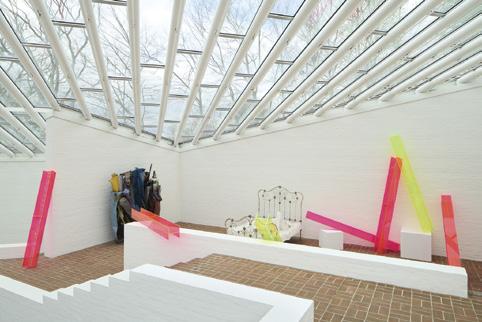
Greenwich Historical Society
47 Strickland Rd., Cos Cob, CT (203) 869-6899 info@greenwichhistory.org greenwichhistory.org
Greenwich Historical Society presents two concurrent exhibitions that celebrate the legacy of Cos Cob as the cradle of American Impressionism. Permanent Collections Gallery: Rediscovering the Cos Cob Art Colony: A Tribute to Susan G. Larkin, features the artwork that led Dr. Larkin to become the foremost
expert on American Impressionism in Connecticut as well as many other etchings, watercolors, and books by art colony authors from her personal collection. October 8–March 8: The Holley Boarding House: Inspiring American Impressionism. Josephine Holley and her daughter Constant Holley MacRae were skilled managers of the Holley boarding house which attracted artists, writers and others to their charming 18th century home on the Mianus River in Cos Cob. The picturesque setting inspired the creativity of their guests and led to the founding of the first Impressionist art colony in Connecticut.
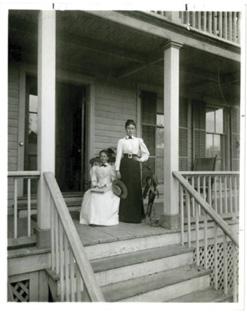
Lyman Allyn Art Museum
625 Williams St., New London, CT (860) 443-2545 lymanallyn.org
Tu–Sa 10 – 5, Su 1–5
Opening September 6: Albrecht Dürer: Master Prints features over forty woodblock prints and engravings that show the remarkable achievements of the German Renaissance master printmaker Albrecht Dürer (1471–1528). An extraordinary innovator who revolutionized printmaking in the late fifteenth and early sixteenth century, Dürer brought remarkable compositional complexity and a high level of naturalism to his works. Albrecht Durer: Master Prints is organized by the Reading Public Museum, Reading, Pennsylvania. Additional works from Connecticut College’s Wetmore Print Collection are also featured in the exhibition.

Albrecht Dürer (German, 1471–1528), Joachim and the Angel from The Life of the Virgin, 1504, ink on paper, Museum Purchase. Reading Public Museum, Reading, Pennsylvania, 1954.63.1. At Lyman Allyn Museum.
Yale University Art Gallery
1111 Chapel St., New Haven, CT (203) 432-0600
artgallery.yale.edu
Tu–F 10–5, Sa & Su 11–5
The Gallery’s encyclopedic holdings range from ancient times to the present day and represent cultures from around the globe. Opening September 12: Nusantara: Six Centuries of Indonesian Textiles. Through October 19: Romney: Brilliant Contrasts in Georgian England. Free and open to the public.

Man’s Formal Court Waistcloth (Dodot Bangun Tulak Alas-Alasan Pinarada Mas) (detail), Indonesia, Java, Kraton Surakarta, 1890, cotton and gold leaf; tritik, gluework. Yale University Art Gallery, Robert J. Holmgren and Anita E. Spertus Collection, Promised gift of Thomas Jaffe, B.A. 1971. At Yale University Art Gallery.
Blue Door Gallery
2 Southside Rd., York, ME (207) 332-2938
bluedoorgallery.art
T, W, F 9–5 Sa 9–12
September 13–November 9: Finding Joy, a solo exhibition by Marcia Crumley, whose work captures the emotional and visual beauty of the natural world. This vibrant collection reflects not only her personal journey through painting, but our shared pursuit of light, hope, and joy in uncertain times. Expect a luminous mix of night skies, seascapes, and color-saturated landscapes that celebrate the everyday wonder around us. Opening reception: September 13, 5–9 p.m. Free and open to the public.
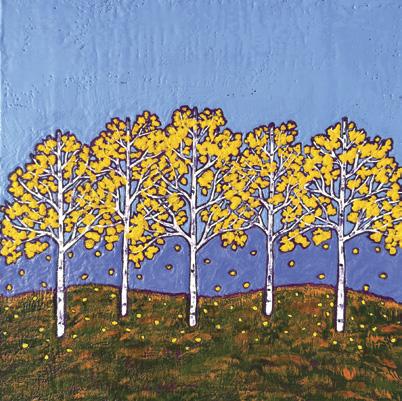
Mathias Fine Art
10 Mathias Dr., Trevett, ME (207) 633-7404
info@mathiasfineart.com mathiasfineart.com
W–Su 12–5 & by appointment, after September 14, by appointment only
Through September 14: The exhibition Bettinson’s Maine includes works from 1991–2008 when Brenda Bettinson developed her iconic style. Bettinson’s Ravensbrück Series is on view at the Holocaust and Human Rights Center in Augusta, Maine, through September 5. Check website for accompanying event dates.
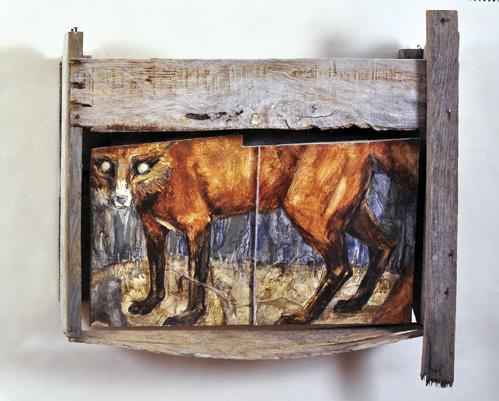
Moss Galleries
100 Fore St., Portland, ME (207) 804-0459
251 US-1, Falmouth, ME (207) 781-2620
liz@elizabethmossgalleries.com elizabethmossgalleries.com
Portland: Tu–Sa 10–5
Falmouth: Tu–Sa 10–5
Portland Gallery, opening September 5: Charlie Hewitt. Falmouth Gallery, through October 11: Geoffrey Dorfman & Brian Smith. Opening October 17: The Haunted: Contemporary Photography Conjured in New England
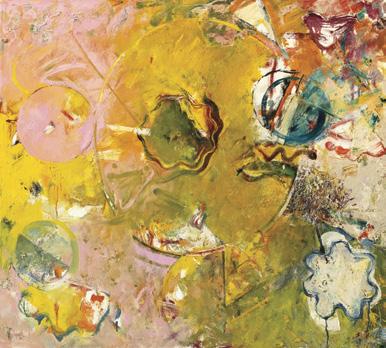
Ogunquit Museum of American Art
543 Shore Rd., Ogunquit, ME (207) 646-4909
ogunquitmuseum.org
Daily 10–5 (through November 16); First Friday of each month, 10–8
Through November 16: Gisela McDaniel: Inina; Where the Real Lies; Henry Strater’s Ogunquit; Hugh Hayden’s Gulf Stream; Jordan Bennet: A Love Letter: A Prayer Set upon the Sea. Free admission during First Fridays 5–8 p.m.
Openings and Events Around the Region
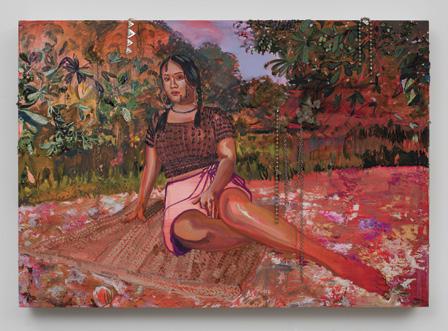
Gisela McDaniel, Na'rosa, 2025, oil on panel, seed bead, garment (sea glass) and jewelry made by subject-collaborator, pearl, shell from Guahan and Hawai’i, 119.4 x 152.4 x 14 cm, 47 x 60 x 5½". Courtesy of the artist and Pilar Corrias, London. Photo: Nicholas Knight. © Gisela McDaniel. At Ogunquit Museum of American Art.
Massachusetts Boston and Surrounding Areas
ABAA Boston Antiquarian Book Fair Hynes Convention Center 900 Boylston St., Boston MA abaa.org/bostonbookfair
F 4-8 ($25), Sa 12-7 (free), Su 11-4 (free) November 7-9: The Boston International Antiquarian Book Fair returns with 100+ booksellers from the U.S., Australia, Czech Republic, Denmark, France, Germany, Netherlands, Serbia, and the U.K. will exhibit and sell rare, collectible, and antique books, manuscripts, autographs, maps, atlases, modern first editions, photographs, fine and decorative prints, and more. Guest speakers Saturday and Sunday.
Arlington Commission for Arts & Culture info@artsarlington.org
artsarlington.org
Art in public places, no admission
Outside Robbins Library, visit Unseen/Unforgotten: Remembering Menotomy’s Ordinary Defenders, 1775, featuring cast cement pedestals by Christopher Frost. On the Minuteman Bikeway at Grove, Brattle and Forest streets, explore murals by Renee Majkut, Raksha Soni and Maria and Kathy Lobo. Online, enjoy People, Plants & Revolution, a multimedia tour with recorded stories exploring colonialism’s impact on Arlington’s 18th century ecosystem, and art by Suzanne Moseley and Liz Shepherd (www.PlantStories.us).
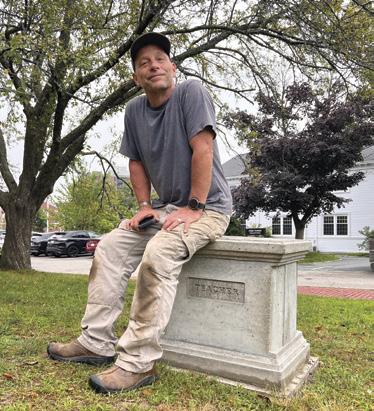
Armenian Museum of America
65 Main St., Watertown, MA (617) 926-2562
armenianmuseum.org
Th–Su 12–6
Ongoing in the Adele & Haig Der Manuelian Galleries: The Art of Disruption: The Art & Impact of Serj Tankian. World-renowned musician Serj Tankian is known globally as the lead singer and songwriter for the band System Of A Down. He is also a visionary poet, visual artist, and outspoken advocate for human rights. Inspired by his 2024 memoir, Down with the System, the exhibition immerses visitors in the dynamic intersections of music, painting, and protest that define Tankian’s work. This exhibition is curated by Ryann Casey. Sponsored by Carolyn Mugar and the Alan K. & Isabelle DerKazarian Foundation.

Atlantic Works Gallery
80 Border St., East Boston, MA contact@atlanticworks.org atlanticworks.org
F & Sa 2–6 or by appointment
September 6–27: Studio #213, paintings by Jeff Briggs and Katie Kimbrell. Opening reception: Saturday, September 6, 5–8 p.m. Third Thursday reception: September 18, 6–8 pm. October 3–25: Love in the Shadows, work by Charlene Liska, and Interwoven, work by Maryellen Cahill. Opening reception: Saturday, October 4, 6–9 p.m. Third Thursday reception: October 16, 6–9 p.m.

Artist Christopher Frost with Unseen/ Unforgotten. At Robbins Memorial Library.
Boston Sculptors Gallery
486 Harrison Ave., Boston, MA (617) 482-7781
bostonsculptors@gmail.com bostonsculptors.com
W–Su 11–5
Through September 28: Wen-Hao Tien, Flight Lessons and Ellen Schön, Loftings. First Friday,
September 5, 5–8:30 p.m. Reception and artists’ talks: Saturday, September 13, 2–5 p.m., talks at 3 p.m. Open Mic with Wen-Hao Tien: Saturday, September 20, 3–5 p.m. 3D Clay-Printing Demo with Ellen Schön: Sunday, September 21 at 2 p.m. Opening October 2: Sally Moore, Human/ Beast and Laura Evans, The Weight: how to move First Friday, October 4, 5–8:30 p.m. Reception and artists’ talks: Sunday, October 19, 2–5 p.m., talks at 3 p.m.


Wen-Hao Tien, Flight Lessons (detail), 2025, mixed media installation, dimensions variable. At Boston Sculptors Gallery.

Laura Evans, Staggering, 2025, mixed media, 18 x 13 x 12". Photo: Julia Featheringill. At Boston Sculptors Gallery.
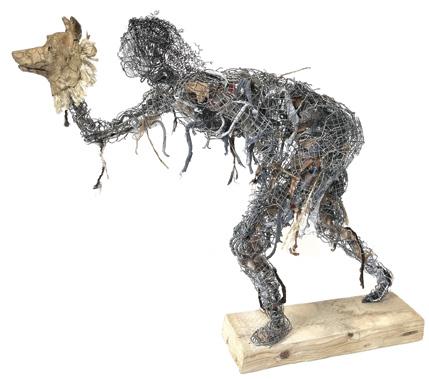
Sally Moore, Entrance, 2025, wire, fabric, papier mâché, 22 x 18 x 6". At Boston Sculptors Gallery.
Concord Art
37 Lexington Rd., Concord, MA (978) 369-2578
info@concordart.org concordart.org
Tu–Sa 10–4:30, Su 12–4
September 11–October 19, Main + Members gal-
leries: 26th Annual Frances N. Roddy Exhibition, juried by Sarah Montross. Reception: Thursday, September 11, 5:30 p.m. Opening October 23, Main Gallery: Motherhood as Muse, curated by Kathryn Geismar and Deborah Peeples. Members Gallery: Color Conversations, Laura Barr, Kay Hartung, Anne Johnstone. Reception: Thursday, October 23, 5:30 p.m.
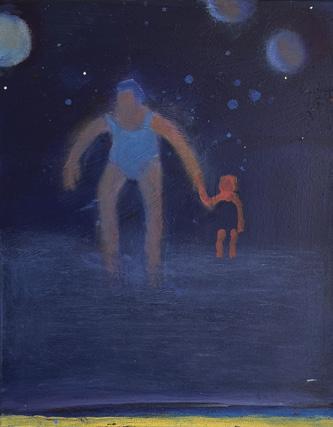
Danforth Art Museum at Framingham State University 14 Vernon St., Framingham, MA (508) 215-5110
danforthartmuseum@framingham.edu danforth.framingham.edu
Currently celebrating its 50th anniversary, the Museum has a permanent collection focusing on American art from the 19th century to the present day, rotating exhibitions of contemporary, regional artists, and a gallery focused on the artist Meta Vaux Warrick Fuller. Opening September 13: B. Lynch: Little Dramas; Nayana LaFond: Portraits in RED; Sonya Tanae Fort: I See You/Morabeza. See website for hours.

Davis Museum at Wellesley College
106 Central St., Wellesley, MA (781) 283-2051 thedavis.org
Tu, W, Th, F, Sa, Su 11-5
In exhibitions opening on September 19, the Davis Museum highlights the following artists as part of Wellesley College’s 150th anniversary celebrations: Kathryn Abarbanel, Ilse Bing, Suzanne Ciani, Genevieve Cohn, Claudia Joskowicz, Kathya Landeros, Phyllis McGibbon, Andrew Mowbray, Daniela Rivera, Katherine Ruffin, and David Teng Olsen. Free and open to the public.
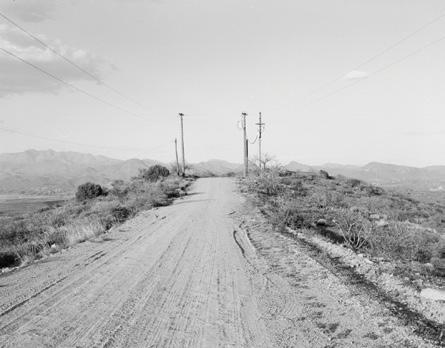
deCordova Sculpture Park and Museum
51 Sandy Pond Rd., Lincoln, MA (781) 259-8355
thetrustees.org/decordova
Tu–F 10–4, Sa & Su 10–5
Spanning the Sculpture Park’s front lawn and beyond, Nature Sanctuary explores relationships between the natural world and ideas of home across a landscape shared and shaped by people and art. Original commissions and loans from six artists—Venetia Dale, Kapwani Kiwanga, Joiri Minaya, Zohra Opoku, Kathy Ruttenberg, and Evelyn Rydz—link deCordova’s ecology, its past as a family home, and its integration with a land conservation organization. Ongoing: Nature Sanctuary

The Guild of Boston Artists
162 Newbury St., Boston, MA (617) 536-7660
bostonguild@gmail.com guildofbostonartists.org
Tu–Sa 10:30–5:30
Through September 27: Annual New England Regional Juried Exhibition featuring a juried selection of paintings, drawings and sculpture by New England realist artists. Award Winners Panel: Saturday, September 20, 2 p.m. Opening October 4: Beauty in the Stillness, a solo exhibition of pastels by Robin Frisella that reflects the artist’s fascination with the quiet elegance of still life. Opening reception: Saturday, October 4, 3–5 p.m. Artist demonstration: Saturday, October 25, 2 p.m.

Frisella, Grace & Simplicity, pastel, 20 x 20". At The Guild of Boston Artists.
Harvard Art Museums
32 Quincy St., Cambridge, MA (617) 495-9400
harvardartmuseums.org
Tu–Su 10–5
Opening September 12: Sketch, Shade, Smudge: Drawing from Gray to Black. Discover how simple tools can be powerful vehicles for artistic expression. Enjoy drawings by Jean-Auguste-Dominique Ingres, Edgar Degas, Georges Seurat, John Singer Sargent, and Odilon Redon, alongside 20th- and 21st-century artists such as Piet Mondrian, Lyonel Feininger, Diego Rivera, Richard Serra, John Wilson, Isabella Quintanilla, and Toyin Ojih Odutola, all of whom push their use of drawing media in new directions.
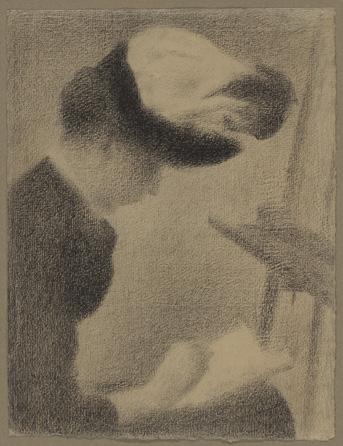
1906, 1951.70. At Harvard Art Museums.
Kingston Gallery
450 Harrison Ave., No. 43, Boston, MA (617) 423-4113 info@kingstongallery.com
W–Su 12–5 and by appointment
September 4–28, Main Gallery: Kurt Ankeny, Linda Cordner, Richard Dorff, Sharon Kaitz, Mario Kon, Virginia Mahoney: Six New Artists. Center Gallery: Jennifer Liston Munson: The Petrifying Gaze. Project Space Gallery: Randy Garber and Rachel Garber Cole: So Late So Soon. Opening reception: Friday, September 5, 5–8 p.m. October 2–November 2, Main and Center galleries: Mary Lang: Entangled. Project Space Gallery: Hilary Tolan: Waterland. Opening reception: Friday, October 3, 5–8 p.m.
Openings and Events Around the Region
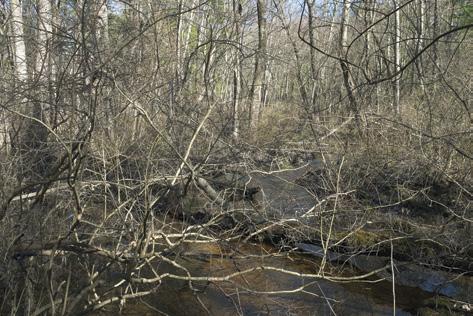
Milton Academy
Nesto Gallery, Art & Media Center Arts Commons Gallery, Kellner Performing Arts Center 170 Centre St., Milton, MA (617) 898-1798
milton.edu/arts/nesto-gallery
M–F 9–4
September 18–October 29: Tracy Penn, Ubiquitous: Microplastics in the Body. Opening reception: Thursday, September 18, 5:30–7 p.m. Penn presents an exhibition of sculptures and paintings created from upcycled plastic, about the ubiquitous presence of microplastics in the human body.
524B Harrison Ave., Boston, MA (617) 718-5600 contact@showupinc.org showupinc.org
Th–Sa 12–5, Su 11–4 & by appointment Through September 28: Submerged in Time by the Safarani Sisters reflects on celebration and memory. September 5–28: Secret Garden: BareFruit23, a pop-up exhibition by Marlon Forrester. Opening October 3: Between Two Worlds: Making Sense of Modern Life from Indigenous Perspectives. Curated by Nayana Lafond. Opening reception: Friday, October 3, 5–8 p.m.

Three Stones Gallery
32 Main St., Concord, MA (978) 371-1333
threestonesgallery.com
Tu–F 10–6, Sa & Su 10–5, M by appointment September 4–October 12: Eternal Equinox—Photo encaustics by Joan Kocak; vivid landscapes in oil by Jill Hoy; abstract works on paper by Daryl Burtnett; new works by represented artists. Reception: Saturday, September 20, 6–8 p.m. Opening October 15: Inner Sojourns—Elisa Adams’ sculptures delve into the mystical world of Tarot cards and invite the audience on a meditative experience; abstract mixed media by Athena Petra Tasiopoulos; and paintings by Avery S. Bramhall complete this intriguing show. Reception: Saturday, October 25, 6–8 p.m.
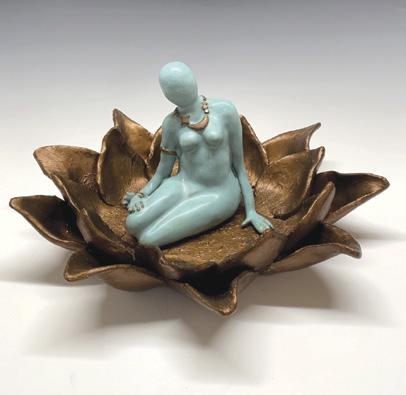
The Umbrella Arts Center
40 Stow St., Concord, MA (978) 371-0820
theumbrellaarts.org
M–Su 10–9
Through October 7: S3: The Umbrella Student Summer Showcase. Through October 18: Weaving an Address, outdoor exhibition at Brister’s Hill commemorating colonial and revolutionary Black inhabitants of Walden Woods as part of Concord250. Artists Ifé Franklin, Whitney Harris, Ekua Holmes, Perla Mabel, Marla McLeod, Anthony Peyton Young. Curator tour: September 13, 1 p.m. Opening September 12: Joy & Peace, abstract painting by Jill Goldman-Callahan and Christiane Corcelle. Reception: Thursday, September 18. Opening September 24: Voices of the Wild: A Tribute to New England’s Wildlife by Jennifer L. Anderson. Reception: Thursday, October 2.
Icon Museum and Study Center
203 Union St., Clinton, MA (978) 598-5000
iconmuseum.org
Th–Su 10–4, Free First Sunday of the month 10–4 Illuminating the art of the sacred icon. Opening October 17: Greek Gallery, a new permanent gallery showcasing Greek icons and artifacts created after the fall of Constantinople in 1453. This exhibition highlights innovative icono-
graphic styles and the cultural exchange that occurred across a broad diaspora, spanning from Byzantium to Venice to Crete. Ongoing: Heavenly Excess: Luxe Icons from Late Imperial Russia. Explore the alluring world of icons and religious objects adorned with decorative covers through the masterful use of enamel, silver, gold, pearls, and semi-precious stones, combined with intricate filigree and engraving.
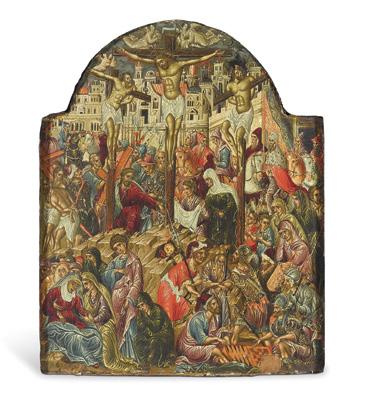
Century, egg tempera on wood. Crete. At Icon Museum and Study Center.
Iris and B. Gerald Cantor Art Gallery, College of the Holy Cross
Prior Performing Arts Center
1 College St., Worcester, MA (508) 793-3356
holycross.edu/cantorartgallery
M & T by appointment, W–F 12–5
Ongoing: The Vietnamese Áo Dài in a Time of War: Fashion, Citizenship, and Nationalism (1954–1975), exploring the role that Vietnam’s national costume—the áo dài—played within Vietnam and on the global stage during the Vietnam War and how clothing is used to assert cultural identity.
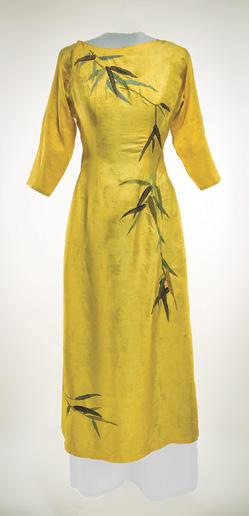
Maker unknown, áo dài, c. 1963, patterned silk damask with cotton/rayon embroidery thread. Courtesy of Mr. Olindo Matteo Borsoi, Mrs. Ngô Đình Lệ Quyên’s widower. At Iris and B. Gerald Cantor Art Gallery.
Gallery Sitka
2 Shaker Rd., D101, Shirley, MA (978) 425-6290
office@gallerysitka.com gallerysitka.com
Open by appointment
Gallery Sitka will be at booth E1 at the Boston Affordable Art Fair, October 23–26, at the SoWa Power Station at 550 Harrison Avenue in Boston.

CM Judge,
acrylic on canvas, 12 x 12". At Gallery Sitka’s Affordable Art Fair booth.
Norman Rockwell Museum
9 Glendale Rd./Rte. 183, Stockbridge, MA (413) 298-4100
NRM.org
Daily, except W, 10–5
Home of American Illustration. Ongoing: Illustrators of Light: Rockwell, Wyeth, and Parrish from the Edison Mazda Collection. Through November 2: Norman Rockwell: Illustrating Humor. Through October 26: I SPY! Walter Wick’s Hidden Wonders. Through October 26: Hidden Worlds and Wonders Outdoor Sculpture Exhibition. Guided gallery tours, virtual exhibition and field trips. More at NRM.org.
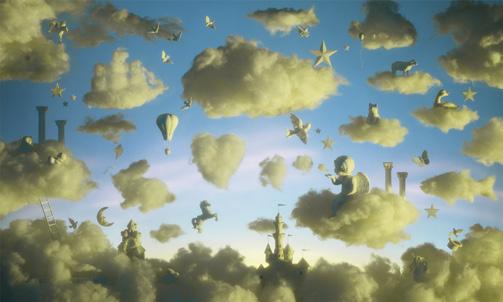
Walter Wick, Clouds from I SPY Fantasy, 2021, pigmented inkjet photograph, 30 x 50". New Britain Museum of American Art, Gift of Walter Wick and Linda
Springfield Museums
21 Edwards St., Springfield, MA (413) 263-6800
springfieldmuseums.org
Tu–Sa 10–5, Su 11–5
Through September 14: Van Gogh for All. Through September 14: Van Gogh’s Threads of Influence. Ongoing: Whiskers and Whimsy: Animals in Currier & Ives Prints. Ongoing: Comedy Wildlife Photography Awards. Opening September 5: Legacies of Surrealism/Markets, Foodways, and the Essence of Place: Works from the Museo de Arte de Ponce.

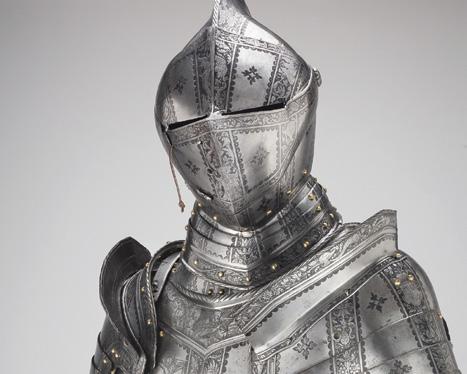
The John Woodman Higgins Armory Collection, 2014.80. At Worcester Art Museum.
University Museum of Contemporary Art
151 Presidents Drive, Amherst, Massachusetts (413) 545-1177
arts.umass.edu
Tu–F 11–4:30, Sa & Su 12–4
Opening September 12: Artist/Fabricator highlights fabric as a disruptive medium, emphasizing handcraft, tactility, and a rejection of industrialized production; Artistic Journey: Zea Mays Printmaking at 25 Years celebrates a local studio committed to experimentation and safer printmaking. Opening October 17: The Political Uses of Madness features a new series of paintings in response to the Pentagon Papers. Free and open to the public.
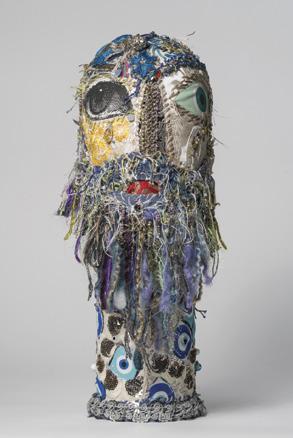
M. Sylvan Robinson, oracle with beard of keys, 2022, textile collage sculpture with hand-beading and embroidery on repurposed display form, 19 x 7 x 9". At University Museum of Contemporary Art.
Worcester Art Museum
55 Salisbury St., Worcester, MA (508) 799-4406
worcesterart.org
W–Su 10–4
Opening September 13: Lee Mingwei: Our Peaceable Kingdom. Experience the ongoing collaborative artwork that brings together more than 40 artists to address the question, “What is peace?”
Opening in November: New Arms and Armor Galleries. Uncover the real stories behind myths and legends, brought to life through over 1,000 objects from around the world. Reservations required, available starting October 22.
Yiddish Book Center
1021 West St., Amherst, MA (413) 256-4900
yiddishbookcenter.org
Su–F 10–4
Ongoing: The Art of 20th Century Yiddish Poster Design—bold, graphic works highlighting Yiddish theater, politics, and culture. Also on view: Yiddish: A Global Culture, a groundbreaking exhibition that tells the story of modern Yiddish creativity through personal stories and objects.

Cahoon Museum of American Art 4676 Falmouth Rd., Cotuit, MA (508) 428-7581
cahoonmuseum.org
Opening September 17: Taverns to Trades: American Folk Art Signs. A rich history of Cape Cod, the Islands, and the Southcoast region is brought back to life. The exhibition highlights the centuries-old artistry of tavern and trade signs known and loved by the region. These signs reflect the trades and travel destinations of their times and represent an array of woodworking, painting, gilding, and welding techniques from skilled craftspeople and artisans. Inspired by these historic examples, contemporary artists Jeff Dinardo of Cotuit and Pete Vogel from Nutmegger Workshop in Maine continue these traditions through woodworking, sign painting, and antiquing processes.
Openings and Events Around the Region

Oil,
Fuller Craft Museum
455 Oak St., Brockton, MA fullercraft.org
Tu–Su 10–5
Opening September 20: Nancy Callan and Katherine Gray: The Clown In Me Loves You. Ongoing: Soul of a Nation: Voices of Resilience in Ukrainian Folk Art. Ongoing: A Shared Legacy: Gifts from the Robyn and John Horn Collection. Ongoing: Cicely Carew: BeLOVEd. Ongoing: Waste Not, Want Not: Craft in the Anthropocene. Ongoing: Small Wonders: Beauty, Alchemy, and the Art of Enameling. The Museum’s wide-ranging exhibitions and outdoor sculpture showcase the finest contemporary craft in a spectacular organic modernist building and woodland setting. All are welcome.

Rustem Skybin, Egg, 2024, clay and glaze, Kyiv region, 6.5". At Fuller Craft Museum.
Highfield Hall & Gardens
56 Highfield Dr., Falmouth, MA (508) 495-1878
highfieldhall.org
Through October 26: Tu–F 10–4, Sa & Su 10–2
Through October 26: Trailblazers: Celebrating Contemporary Japanese Prints; and Ephemeral Grace: Botanicals by Deb Ehrens. Outdoor installation, ongoing: From Woods to Water: The Interrelationship of Living Things, by Roman Tybinko.

OGAWA Koichi, Blue Sphere No. 25, ed50, 2023, silkscreen. At Highfield Hall & Gardens.
Jeff Soderbergh Sustainable Furnishings & Fine Art Gallery
11b W. Main St., Wellfleet, MA (508) 214-0538
jeffsoderberghgallery.com
September 13–27: Join the Gallery in celebrating Retrospective, a show of the insightful and architecturally wondrous work of Duncan Johnson. Johnson is a contemporary assemblage artist known for his intricate, meticulously crafted assemblages created with scavenged wood and curated imagery. Come enjoy a body of work that spans three decades beginning in the early 90s to present day. Artist reception: Saturday, September 13, 3–7 p.m.


Fine Art Gallery.
AVA Gallery and Art Center
11 Bank St., Lebanon, NH (603) 448-3117
info@avagallery.org avagallery.org
Tu–Sa 11–5
Through September 27, main galleries: Solo exhibitions featuring new work from New Hampshire and Vermont artists: Misoo Bang, Mike Howat, Corrine Yonce, and Cierra Vigue.
October 10–November 15: Paintings by Patrick Dunfey and Esme Thompson; metal work by Barbara Garber; ceramic sculptural work by Alexander Pope and Don Williams.

Esme Thompson, Helianthus VII, acrylic on wood relief. At AVA Gallery and Art Center.
The Gallery at WREN
2011 Main St., Bethlehem, NH (603) 869-9736
hello@wrenworks.org
M–Sa 10–5, Su 11–4
September 5–October 31: Finding Home: Portraits and Memories of Immigrants, Becky Field. Reception: Friday, September 5. Artist talk: Saturday, September 6. A compelling photography exhibition showcasing the diverse journeys of immigrants across New Hampshire. Photography that captures the vibrant lives and stories of immigrants seeking safety, education, work, and freedom.

Becky Field, FieldWorkPhotos, An Afghan mother and her two girls wait for her husband to complete his citizenship ceremony, 2017, photograph.
At The Gallery at WREN.
Hood Museum of Art, Dartmouth
6 East Wheelock St., Hanover, NH
hood.museum@dartmouth.edu hoodmuseum.dartmouth.edu
W 11–5, Th & F 11–8, Sa 10–5
Free and open to all
Ongoing: Visual Kinship explores how photography defines, challenges, and reimagines the concept of family. Across diverse historical and contemporary works, the exhibition examines how images reflect and disrupt family structures shaped by colonialism, migration, transnational adoption, and queer intimacies. Opening September 6: Animal, Vegetable, Mineral: Making Colors in Europe, 1400–1800 examines artistic production in the early modern period through the lens of its distinctive colors; recipes for pigments, dyes, and glazes were
often closely guarded secrets and critical to the value of a work of art.
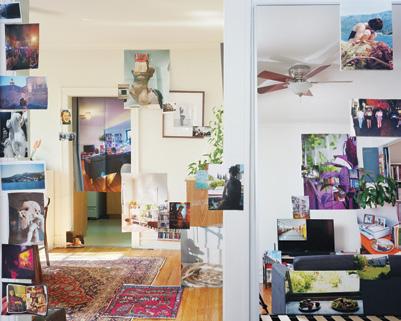
Guanyu Xu, RR-08212010-05012021, 2021, archival pigment print; Canson Platine paper. Purchased through the Elizabeth and David C. Lowenstein ’67 Fund; 2025.1.1. Image courtesy Yancey Richardson Gallery. © Guanyu Xu 徐冠宇. At Hood Museum of Art, Dartmouth.

Antonio Cicognara, Fragment of the Virgin Mary from an Adoration or Annunciation (detail), about 1480, tempera and gold leaf on a gesso ground on a wood panel. Bequest of the John T. Dallas Estate; P.962.30. At Hood Museum of Art, Dartmouth.
the lakes gallery at chi-lin since 1981 135 Eastman Rd., Laconia, NH (603) 556-9384
suzanne@thelakesgallery.com thelakesgallery.com
W–Sa 11–5, Su–Tu private viewing hours by appointment
A destination gallery, contemporary New England and Asian art in a 1780 farmhouse surrounded by Asian gardens. September 13–October 26: All Paths Home, Kelly Blake photography, Gay Freeborn oils, Nancy Freeborn clay, Cheryl Kimball short stories and Anne McMillan books. Opening reception: Thursday, September 18, 5–7 p.m. Poetry and short story readings along with workshops throughout exhibition.
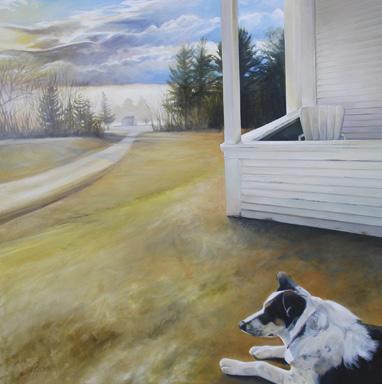
Lamont Gallery
Phillips Exeter Academy
26 Tan Ln., Exeter, NH (603) 777-3461
gallery@exeter.edu exeter.edu/lamontgallery Reservations Required
September 2–November 22: Strange Kin is a swarm of tiny critters (real and faux) that playfully inspect and reimagine the little giants that live among us. The five artists on view embrace their affection or comfort in entomology, by not only making work about insects but with them. Collectively, the work on view braids pure aesthetic joy with stinging commentary on environmental issues, species decline, and conservation.
Bannister Gallery at Rhode Island College
600 Mt. Pleasant Ave., Providence, RI (401) 456-9765
bannistergallery@ric.edu ric.edu/bannister
M–F 12–8 or by appointment
Through September 19: Rhode Island College 2-D Faculty Exhibition. This annual faculty exhibition offers an opportunity to view the artistic talent in residence. October 2–24: In Bannister’s Footsteps: A Contemporary Journey. The Bannister Community Art Project sponsors this exhibition, featuring contemporary artists Shawndavid Berry, Doug Cowan, Darrel Perkins, Ponnapa Prakkamakul, and Michael Talbot, to honor the legacy of Edward Mitchell Bannister.
Chazan Gallery at Wheeler
228 Angell St., Providence, RI (401) 528-2227
chazangallery.org info@chazangallery.org
M–F 3–6, Sa 10–4 and by appointment
September 18–October 8: poly-perspectives, Paul Myoda. Reception: Thursday, September 18, 5–8 p.m. The Wheeler School Alumni Art Show. Exhibiting artists: Judith Salomon ’71, Casey Blanchard ’71, Nellie Congdon ’15, Ruby Goldstein ’22, Sam Green ’06, Shoshana Lowe ’20. October 16-November 5. Reception: Thursday, October 16, 5–8 p.m.
Gallery Sitka at The Tasting Room
The Newport Wine Cellar 5 Merton Rd., Newport, RI (978) 425-6290 office@gallerysitka.com gallerysitka.com/gallery-sitka-newport Daily 12–6
Gallery Sitka will be hosting Cynthia Woehrle and Marton Clough through September. Kellie Weeks opens on Friday, October 10, from 4:30–6 p.m. Marli Thibodeau opens Friday, November 14, from 4:30–6 p.m. and NAWAMA joins Gallery Sitka opening Friday, December 12, from 4:30–6 p.m. for “La Fête”—a celebratory end to 2026!
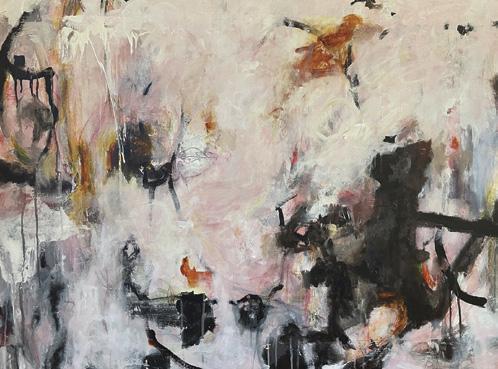
Newport Mansions
Rosecliff, 548 Bellevue Ave., Newport, RI (401) 847-1000 newportmansions.org Daily 10–3
Ongoing: Richard Morris: Hunt In A New Light. Richard Morris Hunt, the premier architect of the Gilded Age, is known for imposing works such as Marble House and The Breakers in Newport, R.I., yet this exhibition will take a more intimate look at his life, creativity and ideas. For the first time, the exhibition will bring together Hunt’s personal sketchbooks, scrapbooks, architectural and interior drawings and family objects, drawn from the Library of Congress, Smithsonian National Portrait Gallery, Vermont Historical Society, Bennington Museum (VT), the Preservation Society’s collections and more.
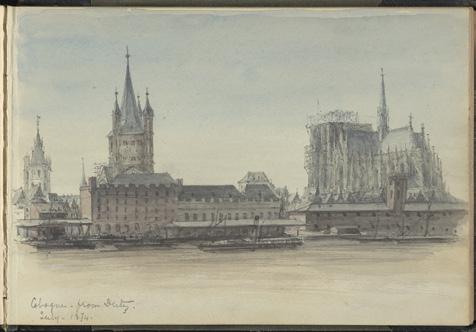
Richard Morris Hunt (American, 1827–1895), Richard Morris Hunt's sketchbook of a European trip in 1874, July to December 1874, graphite and watercolor on paper. Courtesy of the Hunt Collection in the AIA/AAF Collection, Prints and Photographs Division of the Library of Congress, Washington, D.C. At Newport Mansions.
Openings and Events Around the Region
Brattleboro Museum & Art Center
10 Vernon St., Brattleboro, VT (802) 257-0124
office@brattleboromuseum.org brattleboromuseum.org
W–Su 10-4
Ongoing: Making Space, a group exhibition featuring artwork by Beverly Acha, Emily Noelle Lambert, Mika Obayashi, Howardena Pindell, Michelle Samour, Deborra Stewart-Pettengill, and Lauren Watrous; Laura Chasman: Here Today, Gone Tomorrow, Founded on Artists’ Books: Franklin Furnace 50th Anniversary Tribute; GLASSTASTIC 2025; John Kenn Mortensen: Dream Homes; Jonathan Ryan Storm: Time Was a River, Too; and Mark Barry: Petals to Metal and Other Stories.

Howardena Pindell, Cosmos (#112), 2022, handmade abaca paper with embedded letterpress printed, punched, and intaglio printed paper dots. Courtesy of Garth Greenan Gallery, NY. At Brattleboro Museum & Art Center.
Burlington City Arts
135 Church St., Burlington, VT (802) 865-7166
burlingtoncityarts.org
W–F 12–5, Sa 12–8
Offering innovative contemporary art exhibitions in a historic firehouse on Burlington's Church Street Marketplace. Through September 14: Jacob Hashitmoto: a lowercase sky, an immersive installation comprised of hundreds of hand-crafted kites; and Animation as Art, showcasing short films from fine art animators. Opening September 26: Do We Say Goodbye?
Grief, Loss, and Mourning, featuring artists Peter Bruun, Jordan Douglas, Mariam Ghani, Lydia Kern, John Killacky, and Nirmal Raja, who challenge the finality of loss and explore grief as a shared yet deeply individual journey.

Lydia Kern, Double Sorrow Double Joy, 2023, mixed media. At Burlington City Arts.
Mad River Valley Arts
5031 Main St., #2 Village Square, Waitsfield, VT (802) 496-6682
info@madrivervalleyarts.org
Tu–Sa 1–5
Through October 31: Stardust. The Mad 802 Collective presents Stardust, an exhibition about The Quantum World. This multimedia installation looks at the behavior of photons, particles and mysterious patterns of quantum phenomena, inspiring us to think about the magic of the quantum fundamental basis to reality. Artists open up to their interpretation of the immaterial while engaging with the scales of the unimaginably tiny to the infinitely large. Reception: Wednesday, September 19, 5–7 p.m.

Mitchell-Giddings Fine Arts
181-183 Main St., Brattleboro, VT (802) 251-8290
info@mitchellgiddingsfinearts.com mitchellgiddingsfinearts.com
Th–Sa 11–5, Su 12–5
Through October 26: Dan Welden: Haystack Crescendo, a new suite of hybridized prints—neither pure print nor painting—black and white etchings upon which master printmaker Welden has applied acrylic, watercolor and crayon. Created during a residency at Haystack School of Crafts in Deer Isle, ME, using abandoned, corroded zinc printing plates, already partially etched by nature.

106 Main St., Brattleboro, VT (802) 246-7245 | (802) 257-7044 vtart.com
M–Sa 10–5, Su 12–5
Fine art and contemporary American craft. September 5–October 2: Color-focused abstract oil paintings by E. Joseph McCarthy and humorous artwork by Skip Morrow. October 3–November 6: The opening of a two-month juried show of work by the Pastel Society of Vermont.

One (1) insertion: $2.75 per word; two (2) to three (3) insertions: $2.50 per word; four (4) to six (6) insertions: $2.25 per word. Twenty (20)-word minimum.
Deadline: September 30, 2025 for the November/December 2025 issue. Email: advertising@artnewengland.com
Classified ads are also posted on artnewengland.com

Compassionately designed, hand-carved monuments by expert artisans.
Work with us to create the last piece of art you need to buy.
SCITUATE, RI
401.934.3105 | karinsprague.com
Meetings by appointment only

Artist and writer coaching • Arts consulting • Custom publishing • Web design • Digital production • Portfolio reviews • Workshops
Contact Rita Fucillo at rita@artnewengland.com or 857-366-8131
Art Now Management
Consultant with over 25 years of Art World Experience: an MBA in Marketing from NYU, a former gallery owner, a degree in Art History from Columbia University, and a graduate of MoMA. Expert career guidance. Experienced grant writer. Pragmatic and helpful. For more info please visit artnowmanagement.com; call (917) 446-1028 or email: ellen@artnowmanagement.com.
Professional photography, graphic design and website design. Location services with studio lighting for portfolio packages. kathychapman.com • email@kathychapman.com • Text (617) 480-5251.
Critique/Mentoring sessions available. Constructive, tangible feedback and support for artists working in any medium. Call Robert Siegelman at (617) 524-7737, or robert.siegelman@gmail.com.
CALL FOR ENTRY $10,000 IN PRIZES
Call open: July 15, 2025–Feb. 15, 2026
Notifications emailed: April 1, 2026
Exhibition dates: Sept. 8–Nov. 21, 2026
Location: 808 Gallery, Boston University
2026 NORTH AMERICAN PRINT BIENNIAL
2026 Juror: Esther Adler, Curator, Department of Drawings and Prints at The Museum of Modern Art
Open to artists residing in North America.
For more information and prospectus, visit: bostonprintmakers.org/ biennials/biennial-2026

CALL FOR SUBMISSIONS (Open: September 1, 2025–January 9, 2026): The Umbrella Arts Center’s 2026 Ceramics Biennial “Earthworks: Evolution” (April 29–June 28, 2026), juried by Lisa Orr. TheUmbrellaArts.org/Earthworks
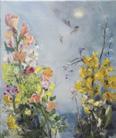


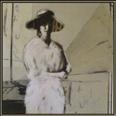




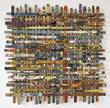
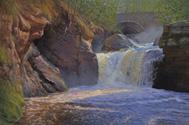
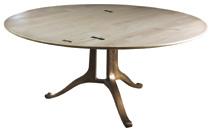
1. On July 28, 2025, at Newburyport Art in Newburyport, MA, in celebration of the exhibition Coming Home, artists discussed how Newburyport has influenced their creative passions in visual art, film, music and writing. Pictured: Belle Carver Struck with panelists Paul Wann, Michael Angelis, Kate Bolick, Nickole Beckwith, Paul-Emile Cendron, Camela Murphy, Sam Szabo, Gordon Przybyla and Edward “Teddy” Speck. Photo: Eric Wojnarowski.
2. On August 16, 2025, at the Backscatter opening reception at Overlap in Newport, RI. Pictured: Katherine Mitchell DiRico, Leah Piepgras and Jesse Kaminsky standing in front of Katherine Mitchell DiRico's site-specific installation, Understories, 2025. Photo courtesy of Alicia Renadette.
3. On August 8, 2025 at the Newport Wine Cellar & Gourmet’s Tasting Room series, Art | Wine | Newport, for the opening of Linda Cuccurullo’s photography exhibition. Cuccurullo specializes in cocktail and travel photography, and is currently globe-trotting, photographing the world’s most exclusive cocktails for her new book. Photo: Linda Cuccurullo.
4. On August 13, 2025, at the Boch Center Shubert Theatre, in Boston, MA, Boston teens took the stage for an original artistic showcase, the final performance of the Boch Center’s 2025 City Spotlights Leadership Program, a paid employment program designed to teach leadership skills using the arts. A Place to Dream, highlighted the themes of this year’s program—the complexities of immigration and advocating for protections, support, and respect of all immigrants—with original songs, choreography and poetry. Pictured: Amiah, 16, from Hyde Park, MA, sings an original song. Photo courtesy of Boch Center.
5. In August 15 , 2025, a crowd gathers at the the Annual Members’ Show opening reception at the Marion Art Center in Marion, MA. Photo courtesy of Marion Art Center.

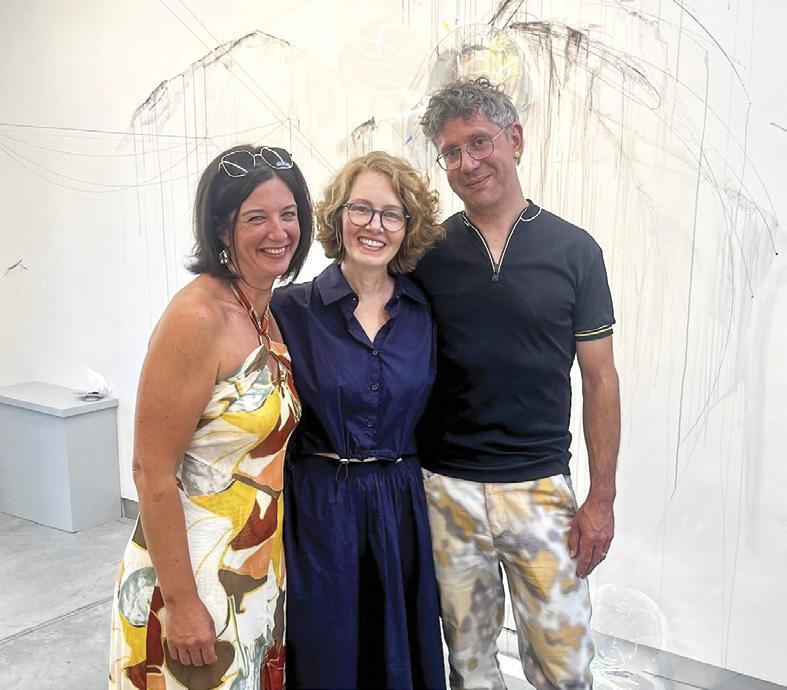
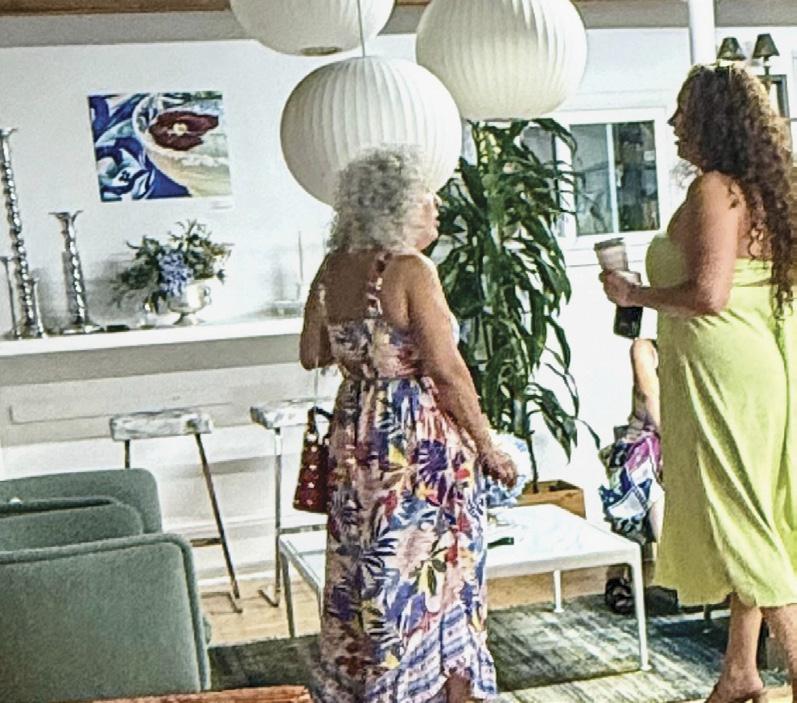




FIND US AT THE AFFORDABLE ART FAIR BOOTH E1
OCTOBER 23 - 26, 2025
SoWa Power Station, 550 Harrison Ave., Boston

Wood-Mode designers bring your vision to life through creativity and years of product and technical training. For more than 80 years, Wood-Mode has been developing products and training that inspire our designers, so they can inspire you.